



The 21st conference of the Disruption Network Lab “Borders of Fear” was held on the 27th, 28th, and 29th November 2020 in Berlin’s Kunstquartier Bethanien. Journalists, activists, advocates, and researchers shed light on abuses and human rights violations in the context of migration management policies. Keynote speeches, panel discussions and several workshops were held involving a total number of 18 speakers and bringing together hundreds of online viewers.
Drawing on insights from humanities, science and technology studies, participants analysed from different perspectives the spread of new forms of persecution and border control targeting people on the move and those seeking refuge. They reflected collectively on forms of social justice and discussed the politics of fear that crystalize the stigmatisation of migrants. By concretely addressing these issues the conference also investigated the deployment of technology and the role of media to consolidate a well-defined structure of power, and outlined the reasons behind the rise of borders and walls, factors that lead to cultural and physical violence, persecution, and human rights violations.
In her introductory statement Dr. Tatiana Bazzichelli, founder and director of the Distruption Network Lab, presented the programme of the conference meant to address the discourse of borders both in their material function, and in their defining role within a strategy of dehumanization and racialisations of individuals. Across the globe, an unprecedented number of people are on the move due to war, economic and environmental factors. Bazzichelli recalled the urgent need to discuss human-right-related topics such as segregation and pushbacks, refugee camps and militarization of frontiers, considering the new technological artilleries available for states, investigating at the same time how border policing and datafication of society are affecting the narrative around migrants and refugees in Europe and the in the West.
The four immediate key content takeaways of the first day were the will to prevent people from reaching countries where they can apply for refugee status or visa; the externalisation polices of border control; the illegal practice of pushbacks; and systematic human rights violations by authorities, extensively documented but difficult to prove in court.
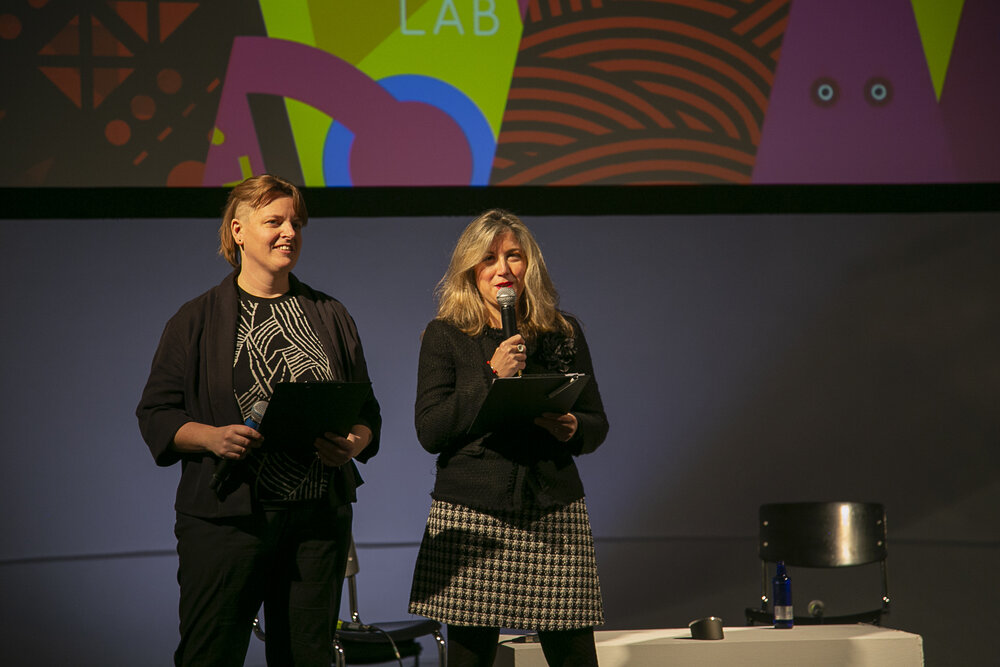
The conference opened with the short film by Josh Begley “Best of Luck with the Wall” – a voyage across the US-Mexico border – stitched together from 200,000 satellite images, and a talk by lawyer Renata Avila, who gave an overview of the physical and socio-economic barriers, which people migrating encounter whilst crossing South and Central America.
Avila took step from the current crises in South and Central America, to describe the dramatic migration through perilous regions, a result of an accumulation of factors like inequality, corruption, mafia, and violence. Avila pointed out that oligarchic systems from different countries appear to be interconnected in complicated architectures of international tax evasion, ruthless exploitation of resources, oppression, and the use of force. In those same places, people experience the most brutal inequality, poverty and social exclusion.
Since the ‘90s the regional free trade agreement meant open borders for products but not for people. In fact, it was an international policy with devastating effects on local economies and agriculture. People on the move in search for a better future somewhere else found closed borders and security forces attempting to block them from heading north towards Mexico and the U.S. border. In these years, the police forceful response to the migrants crossing borders have been widely praised by the governments in the region.
The fact of travelling alone is a red flag, especially for women, and the first wall people meet is in their own country. People on their way to the north experience every kind of injustice. Latin America has often been regarded as a region with deep ethnic and class conflicts. Abandoning possible stereotypical representations, we see that the bodies of the people on the move are at large sexualised and racialized for political reasons. Race, therefore, is another factor to consider, especially when we look at the journey of individuals on the move. Aside, languages in South America could also represent a barrier for those who travel without translators in a continent with dozens of indigenous languages.
Avila concluded her intervention mentioning the issue of digital colonialism and the relevance of geospatial data. Digital is no longer a separated space, she warned, but a hybrid one relevant for all individuals and whose rules are dictated by a small minority. People and places can be erased by those very few companies that can collect data, and –for example– draw and delete borders.
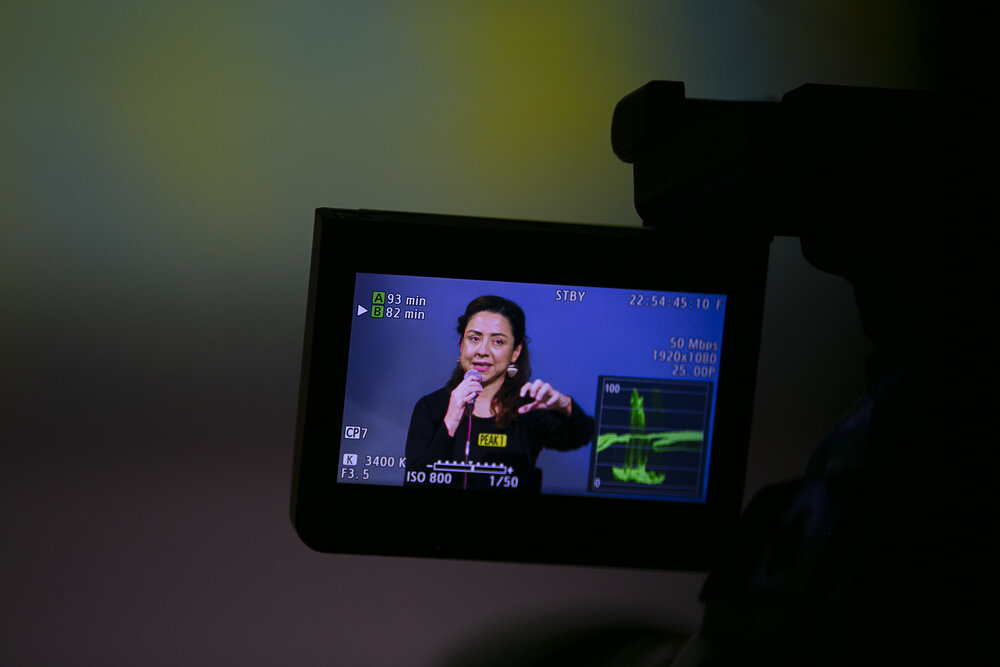
The panel on the first day titled “Migration, Failing Policies & Human Rights Violations,” was moderated by Roberto Perez-Rocha, director for the international anti-corruption conference series at Transparency International, and delivered by Philipp Schönberger and Franziska Schmidt, coordinators of the Refugee Law Clinic Berlin, together with investigative journalist and photographer Sally Hayden. The panellists referred to their direct experience and work, and reflected on how the EU migration policy is factually enforcing practices that cause violation of human rights, suffering, and desperation.
The Refugee Law Clinic Berlin e. V. is a student association at the Humboldt University of Berlin, providing free of charge and independent legal help for refugees and people on the move in Berlin and on the Greek island of Samos. The organisation also offers training on asylum and residence law in Berlin and runs the website ihaverights.eu, designed to allow access to justice to those in marginalised communities.
Through a legal counselling project on the Greek island of Samos, the collective helps people suffering from European illegal practices at the Union’s borders, providing the urgent need of effective ways to guarantee them access to justice and protection. As Schönberger and Schmidt recalled, refugees, and people on the move within the EU find several obstacles when it comes to the enforcement of their rights. For such a reason, they shall be guaranteed procedural counselling by the law to secure, among other services, a fair asylum procedure. However, the Clinic confirmed that such guarantees are not being completely fulfilled in Germany, nor at Europe’s borders, in Samos, Lesvos, Leros, Kos, or Kios.
The panellists explained how their presence on the island gives a chance to document that these camps of human suffering are actually a structural part of an EU migration policy aimed at deterring people from entering the Union, result of deliberate political decisions taken in Brussels and Berlin. Human rights violations occur before arriving on the island, as people are intercepted by the Greek coastguard or by the European Border and Coast Guard Agency (Frontex), and then pushed back to the Turkish border.
The camp in Samos, with a capacity of a maximum 648 people, is instead the home to 4,300 residents, with no water, no sanitary services, poisonous food, and no medical services. Even very serious cases documented to local health authorities remain unattended. The list of violations is endless and the complete lack of adequate protection for unaccompanied minors represents another big issue in this like in all others Greek hotspots, together with the precarity of vulnerable groups, whose risks increase with race, gender, and sexual identity.
The legal team from Berlin prepares applications to the EUCHR court and in these years has filed also 60 requests for urgent procedure due to the risk of irreparable harm, which were granted, ordering adequate accommodation and medical treatment for people in extreme danger.
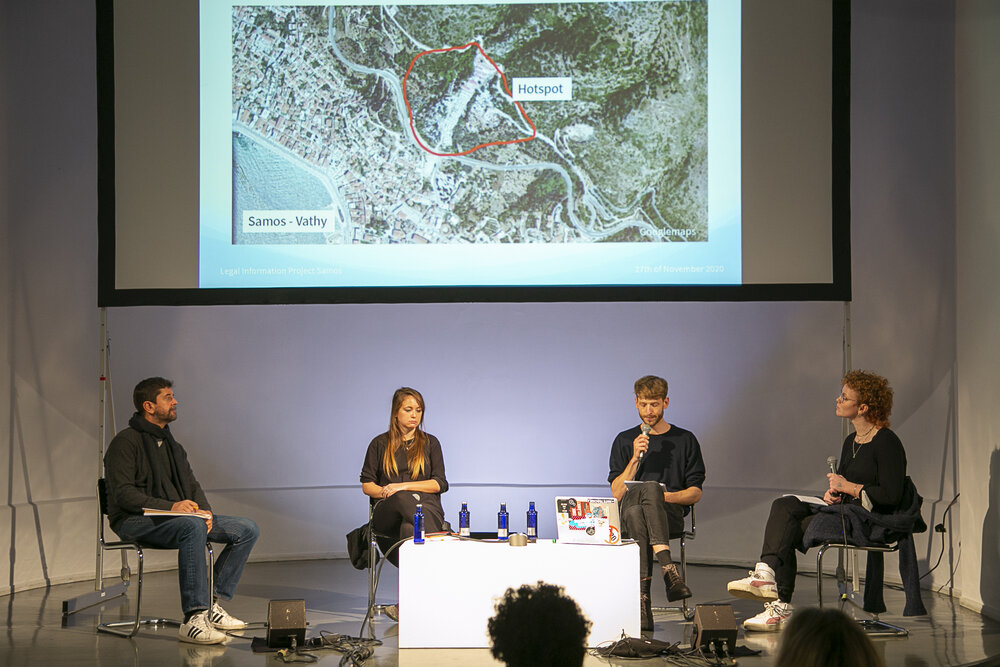
Many observers criticise that the sufferings in the Aegean and on the Greek islands is the result of precise political decisions. Agreed in March 2016, the EU-Turkey deal is a statement of cooperation that seeks to control the crossing of people from Turkey to the Greek islands. According to the deal, every person arriving without documents by boat or without official permission or passage to the Greek islands would be returned to Turkey. In exchange, EU Member States would take Syrian refugees from Turkey. NGOs and international human rights agencies denounce that Turkey, Greece, and the EU have completely failed on humanitarian grounds and dispute the wrong premise that Turkey is a safe country for refugees and asylum-seekers.
Journalist and photographer Sally Hayden looked at the EU-Turkey deal, defining it as a prototype for what would then happen in the central Mediterranean. Libya, a country at war with multiple governments, is the destination of people on move and refugees from all over Africa, willing to cross the Mediterranean Sea. As it is illegal to stop and push people back, for years now the EU has been financing the Libyan coastguard to intercept and pull them back. What follows is a period of arbitrary and endless detention.
Hayden writes about facts; she is not an activist. When she talks about Libya, she refers to objective events she can fact check, and individual stories she has personally collected. Her reports represent a country at war, unsafe not just for refugees and people on the move but for Libyans too. With her work, the journalist has extensively documented how refugees and migrants smuggled into Libya are subject to human trafficking, forced labour, sexual exploitation and tortures, trapped in an infernal circle of violence and death. She recalled her experience with the detainees in Abu Salim, where 500 hundred people suffer from illegal and brutal incarceration inside a centre affiliated with the government in Tripoli. In July 2020, during the conflict, one of these many prisons not far from the city was bombed. At least 53 illegally detained people were killed.
Hayden’s work provides a picture of the results of Europe’s management of the migration crises in the Mediterranean and Northern Africa. EU funds are employed for militarization of borders and externalisation of frontiers control. The political context, in which this occurs, is the cause of years and sometimes decades of lack of investment in reception and asylum systems in line with EU-State’s generic obligations to respect, protect and fulfil human rights.
All panellists called for the immediate intervention to evacuate camps and prisons that were the result of the EU migration policies, to allow migrant victims of abuses and refugees to seek justice and safety elsewhere.
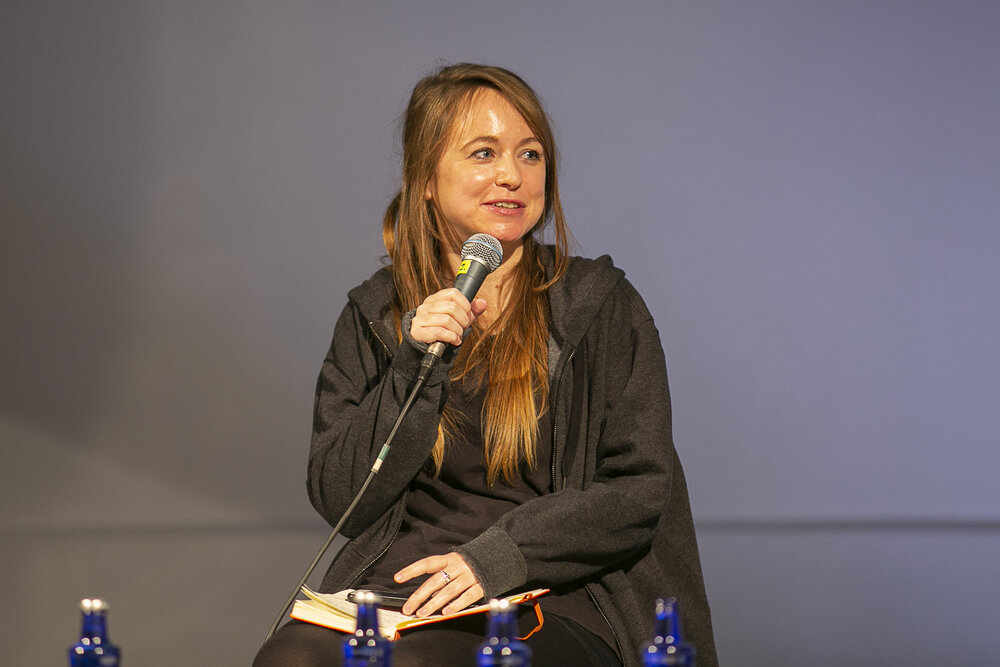
The evening closed with the panel discussion titled “Illegal Pushbacks and Border Violence” and moderated by Likhita Banerji, a human rights and technology researcher at Amnesty International. Banerji reminded the audience that in the first nine months of 2020 there had already been 40 pushbacks, illegal rejections of entry, and expulsions without individual assessment of protection needs, had been documented within Europe or at its external borders. Since these illegitimate practices are widespread, and in some countries systematic, these pushbacks cannot be defined as incidental actions. They appear, instead, to be institutionalised violations, well defined within national policies.
People who shall receive asylum or be rescued, are instead pushed back by police forces, who make sure that the material crossing of the borders remains undocumented. EU member States want to keep undocumented migrants, asylum seekers and refugees outside of their jurisdiction to avoid moral responsibilities and legal obligations. During the second panel of the day, Hanaa Hakiki, legal advisor at the ECCHR Migration Program, filmmaker and reporter Nicole Vögele, and Dimitra Andritsou, researcher at Forensic Architecture, had the chance to go in-depth and to consider the different aspects of these violations.
Hanaa Hakiki, in her intervention “Bringing pushbacks to justice” presented the difficulties that litigators experience in court to materially document pushbacks, which are indeed not meant to be proven. She defined pushbacks as a set of state measures, by which refugees and migrants are forced back over the border – generally shortly after having crossed it – without consideration of their individual circumstances and without any possibility for them to apply for asylum or to put forward arguments against the measures taken.
There are national and international laws that need to be considered in these cases, constituting binding legal obligations for all EU Member States. As a general principle, governments cannot enact disproportionate force, humiliating and degrading treatment or torture, and must facilitate the access to asylum, guarantee protection to people, and provide them access to individualised procedures in this sense.
Member States know that pushbacks have been illegal since a 2012 ECtHR judgment, known as the “Hirsi Jamaa Case,” which found that Italy had violated the law in forcing people back to Libya. However, the effective ban on direct returns led European countries to find other ways to avoid responsibility for those at sea or crossing their borders without documents, and concluded agreements with neighbouring countries, which are requested to prevent migrants from leaving their territories and paid to do so, by any means and without any human rights safeguards in place. By outsourcing rescue to the Libyan authorities, for example, pushbacks by EU countries turned into pullbacks by Libyan coastguard.
Land-pushbacks are still common practice. Hakiki explained that the European Centre for Constitutional and Human Rights (ECCHR) has worked with communities of undocumented migrants since 2014, considering potential legal interventions against the practice of pushbacks at EU borders, and assisting affected persons with individual legal proceedings. She presented three cases the ECCHR litigated in Court (N.D. and N.T. v. Spain; AA vs North Macedonia; SB vs. Croatia) proving that European countries illegally push people back, in violation of human rights laws. Despite the fact that this is still a common practice, it is very difficult to document these violations and have the authorities condemned.
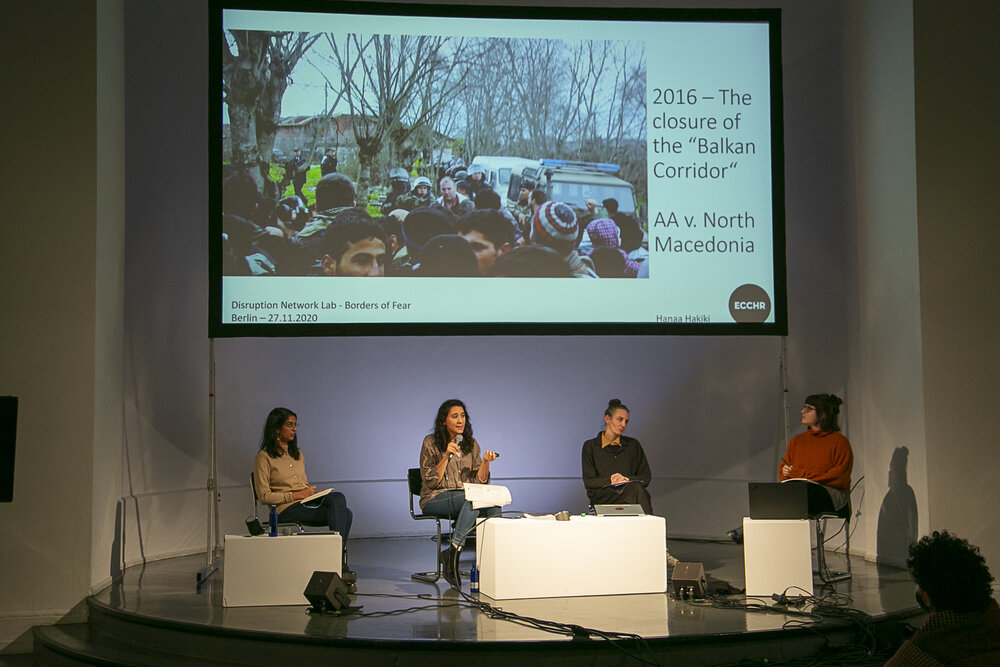
During the beginning of the Syrian conflict, in 2015, refugees were able to travel via Serbia and Hungary into Central and Northern Europe. A couple of years later the EU decided to close down again this so-called Balkan Route, with the result that more and more people found themselves stuck in Bosnia-Herzegovina, prevented from continuing onward to Europe’s territories. From there a person can try to enter the European Union dozens of times, and each time is stopped by Croatian security forces, beaten, and then dragged back across the border to Bosnia-Herzegovina.
After having seen the effects of these illegal practices and met victims of dozens of violent pushbacks in Sarajevo, in 2019 the reporter Nicole Vögele and her crew succeeded in filming a series of these cross-border expulsions from Croatia to Bosnia Herzegovina near the village of Gradina, in the municipality of Velika Kladuša. The reporter, one of the few who succeeded in documenting this practice, also interviewed those who had just been pushed back by the Interventna Policija officers. The response of the Bosnian authorities to her reportage was a complete denial of all accusations.
Vögele then presented footage taken at the EU external border in Croatia, in March 2020, showing masked men beat up refugees and illegally pushing them back to Bosnia. The journalist and her team found the original video, analysed its metadata, and interviewed the man captured on it. Once again, their work could prove that these practices are not isolated incidents.
The panel closed with the investigation by Forensic Architecture part of a broader project on cases of pushbacks across the Evros/Meriç river. Team member Dimitra Andritsou presented the organisation founded to investigate human rights violations using a range of techniques, flanking classical investigation methods including open-source investigation video analysis, spatial and architectural practice, and digital modelling.
Forensic Architecture works with and on behalf of communities affected by state and military violence, producing evidence for legal forums, human rights organisations, investigative reporters and media. A multidisciplinary research group – of architects, scholars, artists, software developers, investigative journalists, archaeologists, lawyers, and scientists – based at the University of London, works in partnership with international prosecutors, human rights organisations, political and environmental justice groups, and develops new evidentiary techniques to investigate violations of human rights around the world, armed conflicts, and environmental destruction.
The Evros/Meriç River is the only border between Greece and Turkey that is not sea. For years migrants and refugees trying to cross it to enter Europe have been reporting that unidentified and generally masked men catch, detain, beat, and push people back to Turkey. Mobile phones, documents, and the few personal things they travel with are confiscated or thrown into the river, not to leave any evidence of these violations behind. As Andridsou described, both Greek and EU authorities systematically deny any wrongdoing, refusing to investigate these reports. The river is part of a wider ecosystem of border defence and has been weaponised to deter and let die those who attempt to cross it.
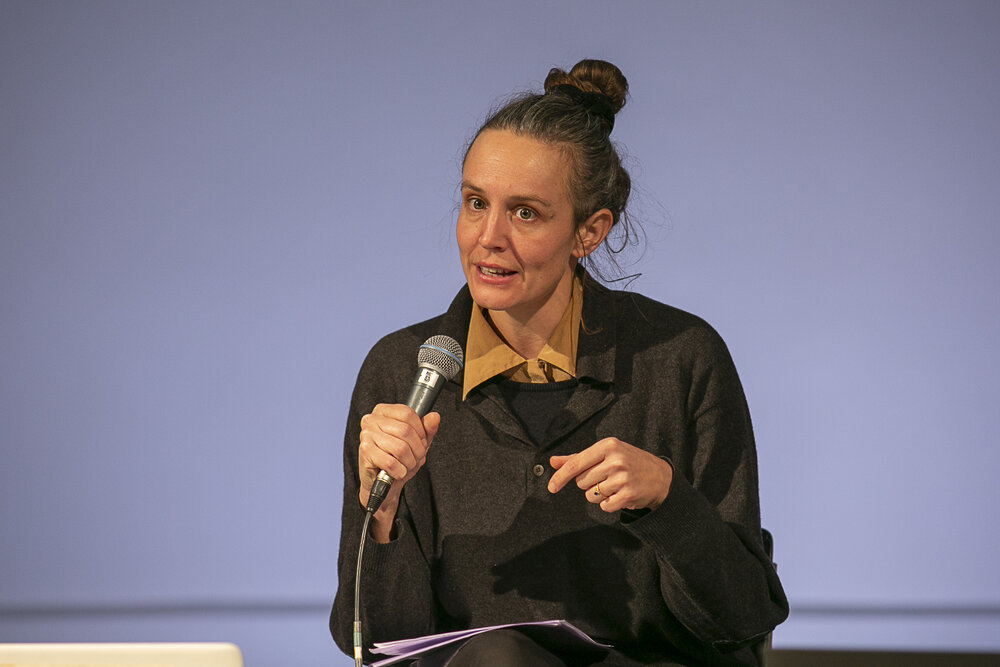
In December 2019, the German magazine Der Spiegel obtained rare videos filmed on a Turkish Border Guard’s mobile phone and on a surveillance, camera installed on the Turkish banks of the river, which apparently documented one of these many pushback operations. Forensic Architecture was commissioned to analyse the footages. A team of experts was then able to geolocate and timestamp the material and could confirm that the images were actually taken few hundred metres away from a Greek military watchtower in Greece.
Andritsou then presented the case of a group of three Turkish political asylum seekers, who entered Greek territory on 4 May 2019, always crossing the Evros/Meriç river. In this case a team of Forensic Architecture could cross-reference different evidence sources, such as new media, remote sensing, material analysis, and witness testimony and verify the group’s entry and their illegal detention in Greece. A pushback to Turkey on the 5 May 2019 led to their arrest and imprisonment by the Turkish authorities.
Ayşe Erdoğan, Kamil Yildirim, and Talip Niksar had been persecuted by the Turkish government on allegations of involvement in Fettulah Gulen’s movement. The group on the run had shared a video appealing for international protection against a possible forced return to Turkey and digitally recorded the journey via WhatsApp. All their text messages with location pins, photographs, videos and metadata prove their presence on Greek soil, prior to their arrest by the Turkish authorities. The investigation could verify that the three were in a Greek police station too, a fact that matches their statement about having repeatedly attempted to apply for asylum there. Their imprisonment is a direct result of the Greek authorities contravening the principle of non-refoulement.
Some keywords resonated throughout the first day of the conference, as a fil rouge connecting the speakers and debates held during the panels and commentaries by the public. Violence, arbitrariness and lawlessness are wilfully ignored –if not backed– by EU Member States, with authorities constantly trying to hide the truth. Thousands of people live under segregation, with no account or trace of being in custody of authorities free to do with them whatever they want.
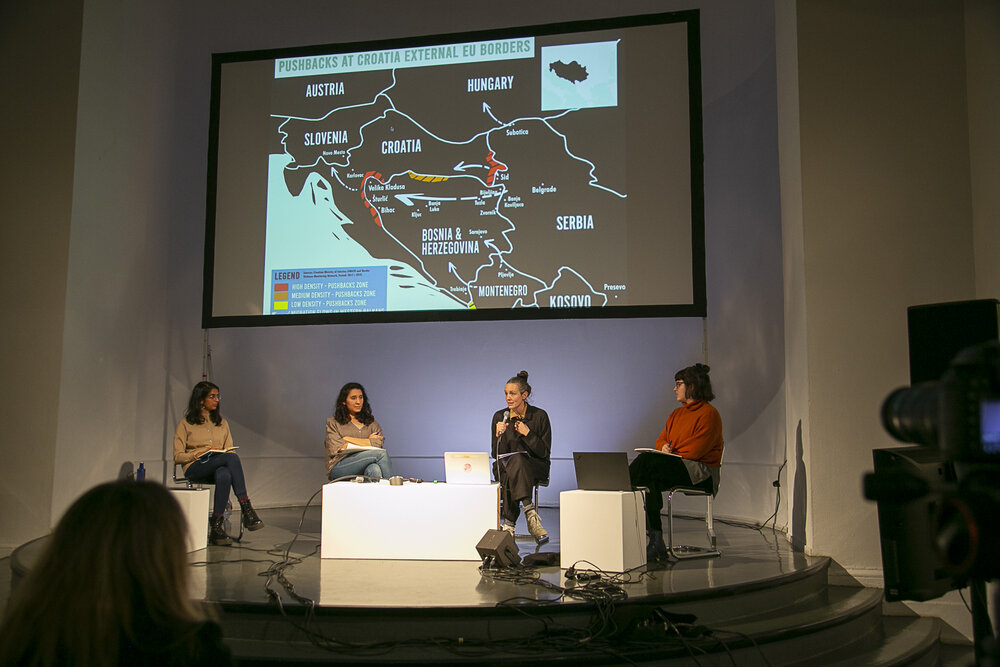
Technology has always been a part of border and immigration enforcement. However, over the last few years, as a response to increased migration into the European Union, governments and international organisations involved in migration management have been deploying new controversial tools, based on artificial intelligence and algorithms, conducting de facto technological experiments and research involving human subjects, refugees and people on the move. The second day of the conference opened with the video contribution by Petra Molnar, lawyer and researcher at the European Digital Rights, author of the recent report “Technological Testing Grounds” (2020) based on over 40 conversations with refugees and people on the move.
When considering AI, questions, answers, and predictions in its technological development reflect the political and socioeconomic point of view, consciously or unconsciously, of its creators. As discussed in the Disruption Network Lab conference “AI traps: automating discrimination” (2019)— risk analyses and predictive policing data are often corrupted by racist prejudice, leading to biased data collection which reinforces privileges of the groups that are politically more guaranteed. As a result, new technologies are merely replicating old divisions and conflicts. By instituting policies like facial recognition, for instance, we replicate deeply ingrained behaviours based on race and gender stereotypes, mediated by algorithms. Bias in AI is a systematic issue when it comes to tech, devices with obscure inner workings and the black box of deep learning algorithms.
There is a long list of harmful tech employed at the EU borders is long, ranging from Big Data predictions about population movements and self-phone tracking, to automated decision-making in immigration applications, AI lie detectors and risk-scoring at European borders, and now bio-surveillance and thermal cameras to contain the spread of the COVID-19. Molnar focused on the risks and the violations stemming from such experimentations on fragile individuals with no legal guarantees and protection. She criticised how no adequate governance mechanisms have been put in place, with no account for the very real impacts on people’s rights and lives. The researcher highlighted the need to recognise how uses of migration management technology perpetuate harms, exacerbate systemic discrimination, and render certain communities as technological testing grounds.
Once again, human bodies are commodified to extract data; thousands of individuals are part of tech-experiments without consideration of the complexity of human rights ramifications, and banalizing their material impact on human lives. This use of technology to manage and control migration is subject to almost no public scrutiny, since experimentations occur in spaces that are militarized and so impossible to access, with weak oversight, often driven by the private sector. Secrecy is often justified by emergency legislation, but the lack of a clear and transparent regulation of the technologies deployed in migration management appears to be deliberate, to allow for the creation of opaque zones of tech-experimentation.
Molnar underlined how such a high level of uncertainty concerning fundamental rights and constitutional guarantees would be unacceptable for EU citizens, who would have ways to oppose these liberticidal measures. However, migrants and refugees have notoriously no access to mechanisms of redress and oversight, particularly during the course of their migration journeys. It could seem secondary, but emergency legislation justifies the disapplication of laws protecting privacy and data too, like the GDPR.
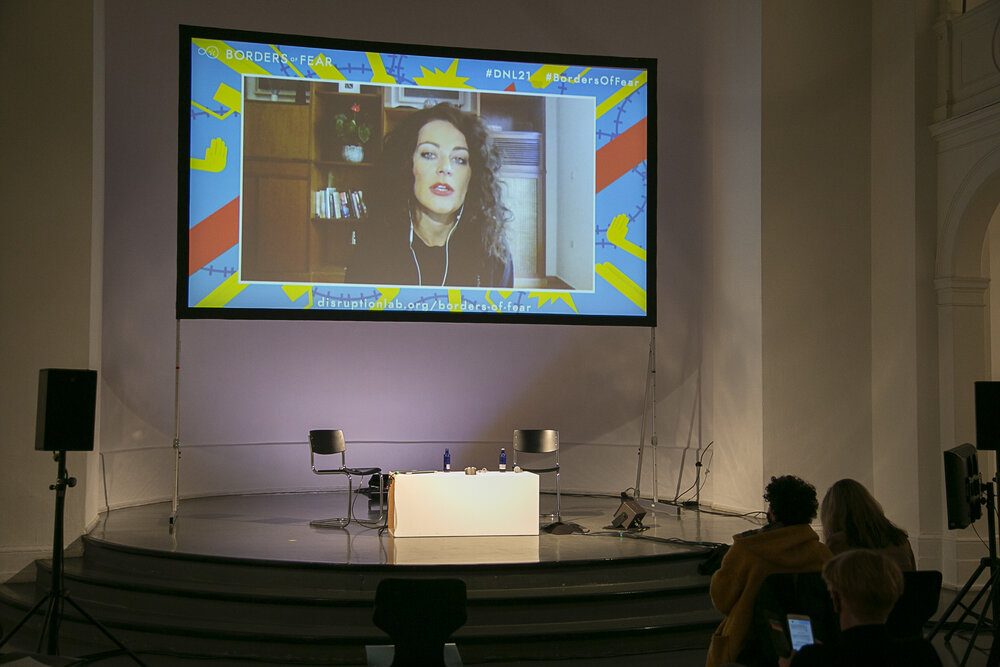
The following part of the conference focused on the journey through Sub-Saharan and Northern Africa, on the difficulties and the risks that migrants face whilst trying to reach Europe. In the conversation “The Journey of Refugees from Africa to Europe,” Yoseph Zemichael Afeworki, Eritrean student based in Luxemburg, talked of his experience with Ambre Schulz, Project Manager at Passerell, and reporter Sally Hayden. Afeworki recalled his dramatic journey and explained what happens to those like him, who cross militarized borders and the desert. The student described that migrants represent a very lucrative business, not just because they pay to cross the desert and the sea, but also because they are used as cheap labour, when not directly captured for ransom.
Once on the Libyan coast, people willing to reach Europe find themselves trapped in a cycle of waiting, attempts to cross the Mediterranean, pullbacks and consequent detention. Libya is a country at war, with two governments. The lack of official records and the instability make it difficult to establish the number of people on the move and refugees detained without trial for an indefinite period. Libyan law punishes illegal migration to and from its territory with prison; this without any account for individual’s potential protection needs. Once imprisoned in a Libyan detention centre for undocumented migrants, even common diseases can lead fast to death. Detainees are employed as forced labour for rich families, tortured, and sexually exploited. Tapes recording inhuman violence are sent to the families of the victims, who are asked to pay a ransom.
As Hayden and Afeworki described, the conditions in the buildings where migrants are held are atrocious. In some, hundreds of people live in darkness, unable to move or eat properly for several months. It is impossible to estimate how many individuals do not survive and die there. An estimated 3,000 people are currently detained there. The only hope for them is their immediate evacuation and the guarantee of humanitarian corridors from Libya –whose authorities are responsible for illegal and arbitrary detention, torture and other crimes– to Europe.
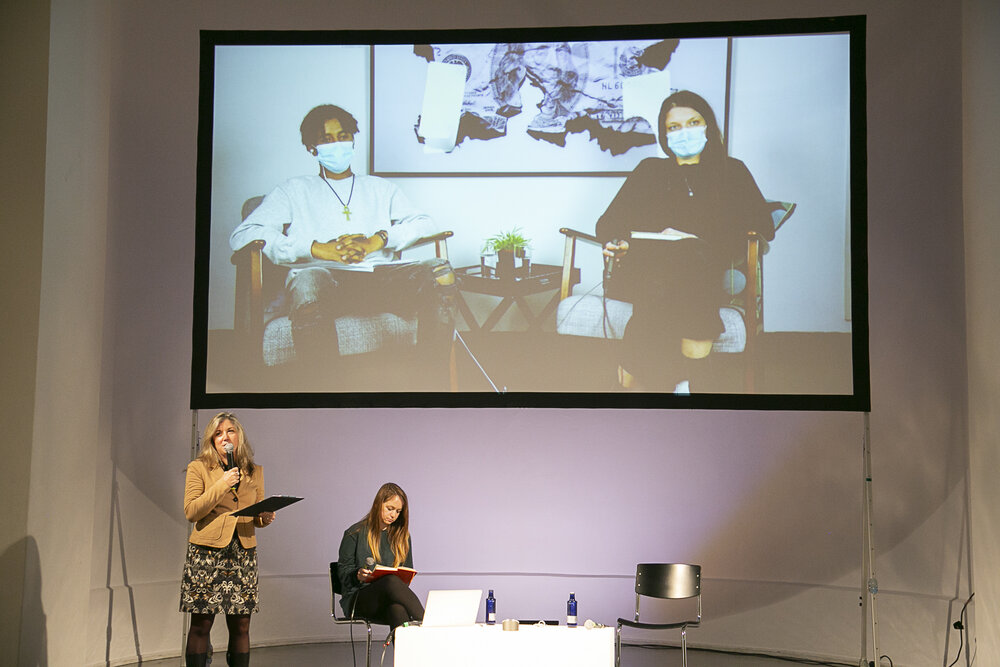
The second day closed with the panel “Politics & Technologies of Fear” moderated by Walid El-Houri, researcher, journalist and filmmaker. Gaia Giuliani from the University of Coimbra, Claudia Aradau, professor of International Politics at King’s College in London, and Joana Varon founder at Coding Rights, Tech and Human Rights Fellow at Harvard Carr Center.
Gaia Giuliani is a scholar, an anti-racist, and a feminist, whose intersectional work articulates the deconstruction of public discourses on the iconographies of whiteness and race, questioning in particular the white narrative imaginary behind security and borders militarization. In her last editorial effort, “Monsters, Catastrophes and the Anthropocene: A Postcolonial Critique” (2020), Giuliani investigated Western visual culture and imaginaries, deconstructing the concept of “risk” and “otherness” within the hegemonic mediascape.
Giuliani began her analyses focusing on the Mediterranean as a border turned into a biopolitical dispositive that defines people’s mobility –and particularly people’s mobility towards Europe– as a risky activity, a definition that draws from the panoply of images of gendered monstrosity that are proper of the European racist imaginary, to reinforce the European and Western “we”. A form of othering, the “we” produces fears through mediatized chronicles of monstrosity and catastrophe.
Giuliani sees the distorted narrative of racialized and gendered bodies on the move to Europe as essential to reinforce the identification of nowadays migrations with the image of a catastrophic horde of monsters, which is coming to depredate the wealthy and peaceful North. It´s a mechanism of “othering” through the use of language and images, which dehumanizes migrants and refugees in a process of mystification and monstrification, to sustain the picture of Europe as an innocent community at siege. Countries of origins are described as the place of barbarians, still now in post-colonial times, and people on the move are portrayed as having the ability to enact chaos in Europe, as if Europe were an imaginary self-reflexive space of whiteness, as it was conceived in colonial time: the bastion of rightfulness and progress.
As Giuliani explained, in this imaginary threat, migrants and refugees are represented as an ultimate threat of monsters and apocalypse, meant to undermine the identity of a whole continent. Millions of lives from the South become an indistinct mass of people. Figures of race that have been sedimented across centuries, stemming from colonial cultural archives, motivate the need to preserve a position of superiority and defend political, social, economic, and cultural privileges of the white bodies, whilst inflicting ferocity on all others.
This mediatized narrative of monsters and apocalypse generates white anxiety, because that mass of racialized people is reclaiming the right to escape, to search for a better life and make autonomous choices to flee the objective causes of unhappiness, suffering, and despair; because that mass of individuals strives to become part of the “we”. All mainstream media consider illegitimate their right to escape and the free initiative people take to cross borders, not just material ones but also the semiotic border that segregate them in the dimension of “the barbarians.” An unacceptable unchained and autonomous initiative that erases the barrier between the colonial then and the postcolonial now, unveiling the coloniality of our present, which represents migration flows as a crisis, although the only crisis undergoing is that of Europe.
On the other side, this same narrative often reduces people on the move and refugees to vulnerable, fragile individuals living in misery, preparing the terrain for their further exploitation as labour force, and to reproduce once again racialized power relations. Here the process of “othering” revivals the colonial picture of the poor dead child, functional to engender an idea of pity, which has nothing to do with the individual dignity. Either you exist as a poor individual in the misery –which the white society mercifully rescues– or as a part of the mass of criminals and rapists. However, these distinct visual representations belong to the same distorted narration, as epitomized in the cartoons published by Charlie Hebdo after the sexual assaults against women in Cologne on New Year’s Eve 2015.
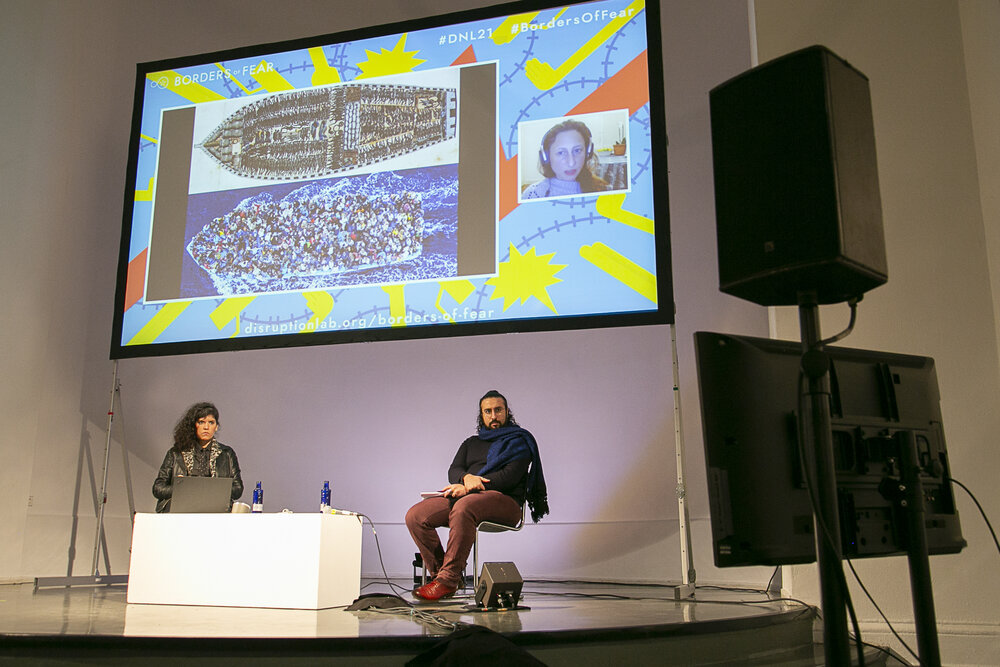
Borders have been rendered as testing ground right for high-risk experimental technologies, while refugees themselves have become testing subjects for these experiments. Governments and non-state actors are developing and deploying emerging digital technologies in ways that are uniquely experimental, dangerous and discriminatory in the border and immigration enforcement context. Taking step from the history of scientific experiments on racialized and gendered bodies, Claudia Aradau invited the audience to reconsider the metaphorical language of experiments that orients us to picture high-tech and high-risk technological developments. She includes instead also tech in terms of obsolete tools deployed to penalise individuals and recreate the asymmetries of the digital divide mirroring the injustice of the neoliberal system.
Aradau studies technologies and the power asymmetries in their deployment and development. She explained that borders have been used as very profitable laboratories for the surveillance industry and for techniques that would then be deployed widely in the Global North. From borders and prison systems –in which they initially appeared– these technologies are indeed becoming common in urban spaces modelled around the traps of the surveillance capitalism. The fact that they slowly enter our vocabularies and daily lives makes it difficult to define the impact they have. When we consider for example that inmates’ and migrants’ DNA is collected by a government, we soon realise that we are entering a more complex level of surveillance around our bodies, showing tangibly how privacy is a collective matter, as a DNA sequence can be used to track a multitude of individuals from the same genealogic group.
Whilst we see hyper-advanced tech on one side, on the other people on the move walk with nothing to cross a border, sometimes not even shoes, with their personal belongings inside plastic bags, and just a smartphone to orientate themselves, and communicate and ask for help. An asymmetry, which is –once again– being deployed to maintain what Aradau defined as matrix of domination: no surveillance on CO2 emissions and environmental issues due to industrial activities, no surveillance on exploitations of resources and human lives; no surveillance on the production of weapons, but massive deployment of hi-tech to target people on the move, crossing borders to reach and enter a fortress, which is not meant for them.
Aradau recalled that in theory, protocols ethics and demands for objectivity are necessary when it comes to scientific experiments. However, the introduction in official procedures of digital tech devices and software such as Skype, WhatsApp or MasterCard or a set of apps developed by either non-state or state actors, required neither laboratories nor the randomized custom trials that we usually associate with scientific experimentation. These heterogeneous techniques specifically intended to work everywhere and enforced without protocols, need to be understood under neoliberalism: they rely on pilot projects trials and cycles of funds and donors, whose goal is every time to move to a next step, to finance more experiments. Human-rights-centred tech is far away.
Thus, we see always more experiments carried out without protocols, from floating walls tech to stop migrants reaching the Greek shores, to debit cards used as surveillance devices. Creative experiments come also with the so-called refugees’ integration, conceived by small-scale injections of devices into their reality for limited periods, with the purpose of speculatively recompose rotten asymmetries of power and injustice. In Greece, as Aradau mentioned, the introduction of Skype in the process of the asylum application became an obstacle, with applicants continually experiencing debilitation through obsolete technology that doesn’t work or devices with limited access, disorientation through contradictory and outdated information.
There is also a factual aspect: old and slow computers, documents that have not been updated or have been updated at different times, and lack of personnel are justified by saying that resources are limited. A complete lack or shortage of funds, which is one other typical condition of neoliberalism, as we can see in Greece. In this, tech recomposes relations of precarity in a different guise.
Aradau concluded her contribution focusing on the technologies that are deployed by NGOs, completely or partially produced elsewhere, often by corporate actors who remain entangled in the experiments through their expertise and ownership. Digital platforms such as Facebook, Microsoft, Amazon, or Google not only shape relations between online users, she warned, but concerning people on the move and refugees too. Google and Facebook –for example– dominate the relations that underpin the production of refugee apps by humanitarian actors.
Google is at the centre of a sort of digital humanitarian ecosystem, not only because it can host searches or provide maps for the apps, but also because it simultaneously intercepts data flows so that it acts as a surplus data extractor. In addition, social networks reshape digital humanitarianism through data extractive relations and provide big part of the infrastructure for digital humanitarianism. Online humanitarianism becomes thus a particularly vulnerable site of data gathering and characterised by an overall lack of resources –similarly to the Greek state. As a result, humanitarian actors cannot tackle the depreciation messiness and obsolescence of their tech and apps.
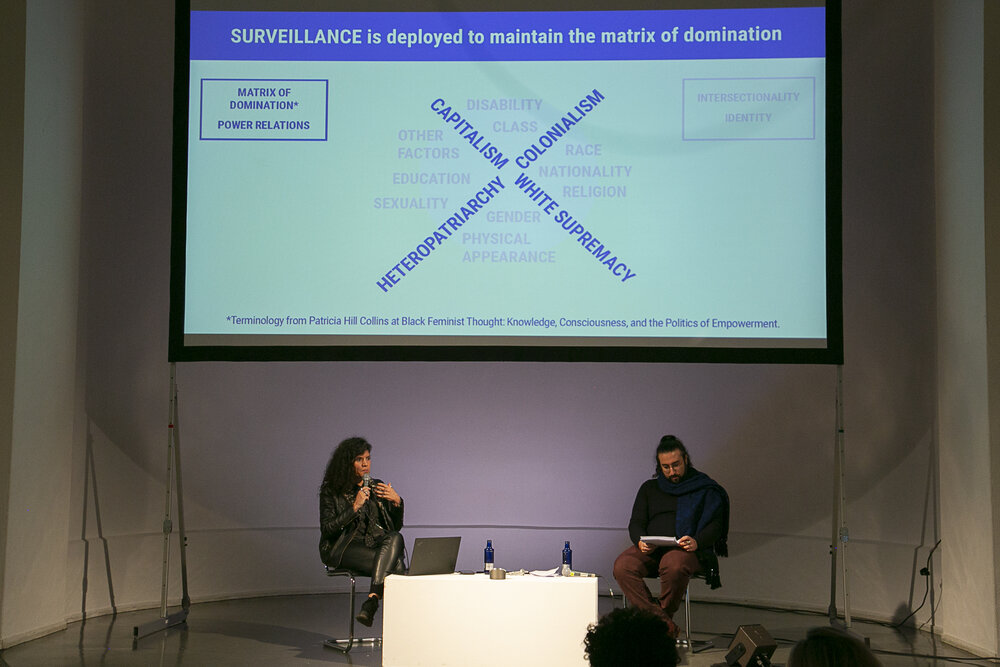
The last day of the conference concentrated on the urgent need to creating safe passages for migration, and pictured the efforts of those who try to ensure safer migration options and rescue migrants in distress during their journey. Lieke Ploeger, community director of the Disruption Network Lab, presented the panel discussion “Creating Safe Passages”, moderated by Michael Ruf, writer and director of documentary and theatre plays. Ruf´s productions include the “Asylum Dialogues” (2011) and the “Mediterranean Migration Monologues” (2019), which have been performed in numerous countries more than 800 times by a network of several hundred actors and musicians. This final session brought together speakers from the Migrant Media Network (MMN), the Migrant Offshore Aid Station (MOAS), and SeaWatch e.V. to discuss their efforts to ensure safer migration options, as well as share reliable information and create awareness around migration issues.
The talk was opened by Thomas Kalunge, Project Director of the Migrant Media Network, one of r0g_agency’s projects, together with #defyhatenow. Since 2017 the organisation has been working on information campaigns addressed to people in rural areas of Africa, to explain that there are possible alternatives for safer and informed decisions, when they choose to reach other countries, and what they may come across if they decide to migrate.
The MMN team organises roundtable discussions and talks on various topics affecting the communities they meet. They build a space in which young people take time to understand what migration is nowadays and to listen to those, who already personally experienced the worst and often less discussed consequences of the journey. To approach possible migrants the MMN worked on an information campaign on the ethical use of social media, which also helps people to learn how to evaluate and consume information shared online and recognise reliable sources.
The MMN works for open culture and critical social transformation, and provides young Africans with reliable information and training on migration issues, included digital rights. The organisation also promotes youth entrepreneurship “at home” as a way to build economic and social resilience, encouraging youth to create their own opportunities and work within their communities of origin. They engage on conversations on the dangers of irregular migration, discussing together rumours and lies, so that individuals can make informed choices. One very relevant thing people tend to underestimate, is that sometimes misinformation is spread directly by human smugglers, warned Kalunge.
The MMN also provides people from remote regions with offline tools that are available without an internet connection, and training advisors and facilitators who are then connected in a network. The HyracBox for example is a mobile, portable, RaspberryPi powered offline mini-server for these facilitators to use in remote or offline environments, where access to both power and Internet is challenging. With it, multiple users can access key MMN info materials.
An important aspect to mention is that the MMN does not try to tell people not to migrate. European government have outsourced borders and migration management, supporting measures to limit people mobility in North and Sub-Saharan Africa, and it is important to let people know that there are real dangers, visible and invisible barriers they will meet on their way.
Visa application processes –even for legitimate reasons of travel– are very strict for some countries, often without any information being shared, even with people who are legitimately moving for education, to work or get medical treatment. The ruling class that makes up the administrative bureaucracy and outlines its structures, knows that who controls time has power. Who can steal time from others, who can oblige others to waste time on legal quibbles and protocol matters, can suffocate the others’ existence in a mountain of paperwork.
Human smugglers then become the final resort. Kaluge explained also that, at the moment, the increased outsourcing of the European border security services to the Sahel and other northern Africa countries is leading to diversion of routes, increased dangerousness of the road, people trafficking, and human rights violations.
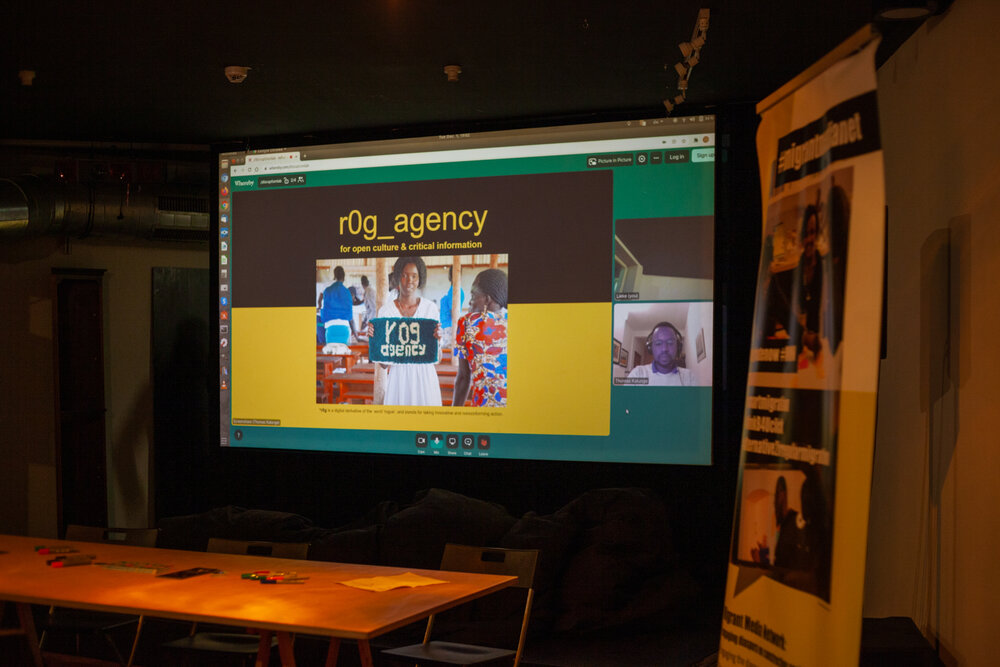
Closing the conference, Regina Catrambone presented the work that MOAS does around the world and the campaign for safe and legal routes that is urging governments and international organisations to implement regular pathways of migration that already exist. Mattea Weihe presented instead the work of SeaWatch e. V., an organisation which is also advocating for civil sea rescue, legal escape routes and a safe passage, and which is at sea to rescue migrants in distress.
The two panellists described the situation in the Central Mediterranean. Since the beginning of the year, over 500 migrants have drowned in the Mediterranean Sea (November 2020). While European countries continue to delegate their migration policy to the Libyan Coast Guard, rescue vessels from several civilian organisations have been blocked for weeks, witnessing the continuous massacre taking place just a few miles from European shores. With no common European rescue intervention at sea, the presence of NGO vessels is essential to save humans and rescue hundreds of people who undertake this dangerous journey to flee from war and poverty.
However, several EU governments and conservative and far right political parties criminalise search and rescues activities, stating that helping migrants at sea equals encouraging illegal immigration. A distorted representation legitimised, fuelled and weaponised in politics and across European society that has led to a terrible humanitarian crisis on Europe’s shores. Thus, organisations dedicated to rescuing vessels used by people on the move in the Mediterranean Sea see all safe havens systematically shut off to them. Despite having hundreds of rescued individuals on board, rescue ships wait days and weeks to be assigned a harbour. Uncertainty and fear of being taken back to Libya torment many of the people on board even after having been rescued. After they enter the port, the vessels are confiscated and cannot get back out to sea.
By doing so, Europe and EU Member States violate human rights, maritime laws, and their national democratic constitutions. The panel opened again the crucial question of humanitarian corridors, human-rights-based policy, and relocations. In the last years the transfer of border controls to foreign countries, has become the main instrument through which the EU seeks to stop migratory flows to Europe. This externalisation deploys modern tech, money and training of police authorities in third countries moving the EU-border far beyond the Union’ shores. This despite the abuses, suffering and human-rights violations; willingly ignoring that the majority of the 35 countries that the EU prioritises for border externalisation efforts are authoritarian, known for human rights abuses and with poor human development indicators (Expanding Fortress, 2018).
It cannot be the task of private organizations and volunteers to make up for the delay of the state. But without them no one would do it.
States are seeking to leave people on the move, refugees, and undocumented migrants beyond the duties and responsibilities enshrined in law. Most of the violations, and the harmful technological experimentation described throughout the conference targeting migrants and refugees, occurs outside of their sovereign responsibility. Considering that much of technological development occurs in fact in the so-called “black boxes,” by acting so these state-actors exclude the public from fully understanding how the technology operates.
The fact that the people on the move on the Greek islands, on the Balkan Route, in Libya, and those rescued in the Mediterranean have been sorely tested by their journeys, living conditions, and, in many cases, imprisoned, seems to be irrelevant. The EU deploys politics that make people who have already suffered violence, abuse, and incredibly long journeys in search of a better life, wait a long time for a safe port, for a visa, for a medical treatment.

All participants who joined the conference expressed the urgent need for action: Europe cannot continue to turn its gaze away from a humanitarian emergency that never ends and that needs formalised rescue operations at sea, open corridors, and designated authorities enacting an approach based on defending human rights. Sea rescue organisations and civil society collectives work to save lives, raise awareness and demand a new human rights-based migration and refugee policy; they shall not be impeded but supported.
The conference “Borders of Fear” presented experts, investigative journalists, scholars, and activists, who met to discuss wrongdoings in the context of migration and share effective strategies and community-based approaches to increase awareness on the issues related to the human-rights violations by governments. Here bottom-up approaches and methods that include local communities in the development of solutions appear to be fundamental. Projects that capacitate migrants, collectives, and groups marginalized by asymmetries of power to share knowledge, develop and exploit tools to combat systematic inequalities, injustices, and exploitation are to be enhanced. It is imperative to defeat the distorted narrative, which criminalises people on the move, international solidarity and sea rescue operations.
Racism, bigotry and panic are reflected in media coverage of undocumented migrants and refugees all over the world, and play an important role in the success of contemporary far-right parties in a number of countries. Therefore, it is necessary to enhance effective and alternative counter-narratives based on facts. For example, the “Africa Migration Report” (2020) shows that 94 per cent of African migration takes a regular form and that just 6 per cent of Africans on the move opt for unsafe and dangerous journeys. These people, like those from other troubled regions, leave their homes in search of a safer, better life in a different country, flee from armed conflicts and poverty. It is their right to do so. Instead of criminalising migration, it is necessary to search for the real causes of this suffering, war and social injustice, and wipe out the systems of power behind them.
Videos of the conference are also available on YouTube via:
For details of speakers and topics, please visit the event page here: https://www.disruptionlab.org/borders-of-fear
Upcoming programme:
The 23rd conference of the Disruption Network Lab curated by Tatiana Bazzichelli is titled “Behind the Mask: Whistleblowing During the Pandemic.“ It will take place on March 18-20, 2021. More info: https://www.disruptionlab.org/behind-the-mask
To follow the Disruption Network Lab sign up for the newsletter and get informed about its conferences, meetups, ongoing researches and projects.
The Disruption Network Lab is also on Twitter, Facebook and Instagram.
On September 25, 2020, the Disruption Network Lab opened its 20th conference “Data Cities: Smart Technologies, Tracking & Human Rights” curated by Tatiana Bazzichelli, founder and program director of the organisation, and Mauro Mondello, investigative journalist and filmmaker. The two-day-event was a journey inside smart-city visions of the future, reflecting on technologies that significantly impact billions of citizens’ lives and enshrine new unprecedented concentrations of power, characterising the era of surveillance capitalism. A digital future which is already here.
Smart urbanism relies on algorithms, data mining, analytics, machine learning and infrastructures, providing scientists and engineers with the capability of extracting value from the city and its people, whose lives and bodies are commodified. The adjective ‘smart’ represents a marketing gimmick used to boost brands and commercial products. When employed to designate metropolitan areas, it describes cities which are liveable, sustainable and efficient thanks to technology and the Internet.
The conference was held at Berlin’s Kunstquartier Bethanien and brought together researchers, activists and artists to discuss what kind of technologies are transforming metropolises and how. The Disruption Network Lab aimed at stimulating a concrete debate, devoid of the rhetoric of solutionism, in which participants could focus on the socio-political implications of algorithmic sovereignty and the negative consequences on fundamental rights of tracking, surveillance and AI. They shared the results of their latest work and proposed a critical approach, based on the motivation of transforming mere opposition into a concrete path for inspirational change.

The first part of the opening keynote “Reclaiming Data Cities: Fighting for the Future We Really Want” was delivered by Denis “Jaromil” Roio, ethical hacker, artist and activist. In his talk, moderated by Daniel Irrgang, research fellow at the Weizenbaum Institute for the Networked Society, Jaromil focused on algorithmic sovereignty and the incapacity to govern technological transformation which characterises our societies today.
Jaromil looked at increasing investments in AI, robots and machine learning, acknowledging that automated decision-making informed by algorithms has become a dominant reality extending to almost all aspects of life. From the code running on thousands of e-devices to the titanic ICTs-infrastructures connecting us, when we think about the technology surrounding us, we realise that we have no proper control over it. Even at home, we cannot fully know what the algorithms animating our own devices are adopted for, if they make us understand the world better or if they are instead designed to allow machines to study and extract data from us for the benefit of their creators. The same critical issues and doubts emerge with a large-scale implementation of tech within so-called “smart cities”, maximization of the “Internet of Things” born in the 1980s.
Personal data is a lucrative commodity and big data means profit, power, and insights, which is essential to all government agencies and tech firms. Jaromil announced a call-to-action for hackers and programmers, to get involved without compromise and play a key role in building urban projects which will safeguard the rights of those living in them, taking into consideration that by 2050, an estimated 70 per cent of the world’s population may well live in cities.
Jaromil observed that there is too often a tremendous difference between what we see when we look at a machine and what really happens inside it. Since the dawn of the first hacking communities, hackers preferred writing their own software and constructing their own machines. They were free to disassemble and reassemble them, having control over all the functions and direct access to the source code. This was also a way to be independent from the corporate world and authorities, which they mistrusted.
Today, users are mostly unaware of the potential of their own tech-devices, which are no longer oriented strictly towards serving them. They have no exposure to programming and think Computer Science and Informatics are way too difficult to learn, and so entrust themselves entirely to governments and tech firms. Jaromil works to simplify interface and programming language, so people can learn how to program and regain control over their tech. He supports minimalism in software design and a process of democratisation of programming languages which works against technocratic monopolies. His Think & Do Tank—Dyne.org—is a non-profit software house with expertise in social and technical innovation, gathering developers from all over the world. It integrates art, science and technology in brilliant community-oriented projects (D-CENT, DECODE, Commonfare, Devuan), promoting decentralisation and digital sovereignty to encourage empowerment for the people.
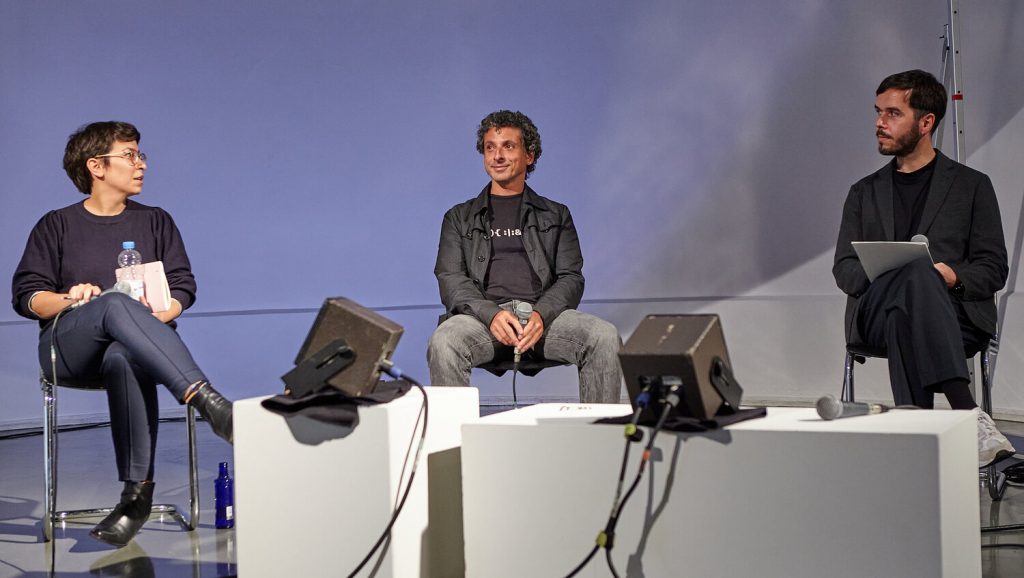
The second keynote speaker, Julia Koiber, managing director at SuperrrLab, addressed issues of technology for the common good, open data and transparency, and—like the previous speaker—reflected on uncontrolled technological transformation. Koiber noticed that the more people are mobilising to be decision-makers, rather than passive data providers, the more they see how difficult it is to ensure that publicly relevant data remains subject to transparent control and public ownership. In the EU several voices are pushing for solutions, including anonymised user data to be classified as ‘common good’ and therefore free from the control of tech companies.
Recalling the recent Canadian experience of Sidewalk Labs (Alphabet Inc.’s company for urban tech development), Koiber explained that in order to re-imagine the future of neighbourhoods and cities, it is necessary to involve local communities. The Google’s company had proposed rebuilding an area in east Toronto, turning it into its first smart city: an eco-friendly digitised and technological urban planning project, constantly collecting data to achieve perfect city living, and a prototype for Google’ similar developments worldwide. In pushing back against the plan and its vertical approach, the municipality of Toronto made clear that it was not ready to consider the project unless it was developed firmly under public control. The smart city development which never really started died out with the onset of the COVID-19 crisis. Its detractors argue that city dwellers were meant to be human sensors collecting data to test new tech-solutions and increase corporate profit. Data collected during the provision of public services and administrative data should be public; it belongs to the people, not to a black box company.
As Jaromil and Koiber discussed, in the main capitals of the world the debate on algorithmic sovereignty is open and initiatives such as the “Manifesto in favour of technological sovereignty and digital rights for cities,” written in Barcelona, reflect the belief that it will be crucial for cities to achieve full control and autonomy of their ICTs, which includes service infrastructures, websites, applications and data owned by the cities themselves and regulated by laws protecting the interests and fundamental rights of their citizens. Their implementation shall come within people-centric projects and a transparent participatory process.
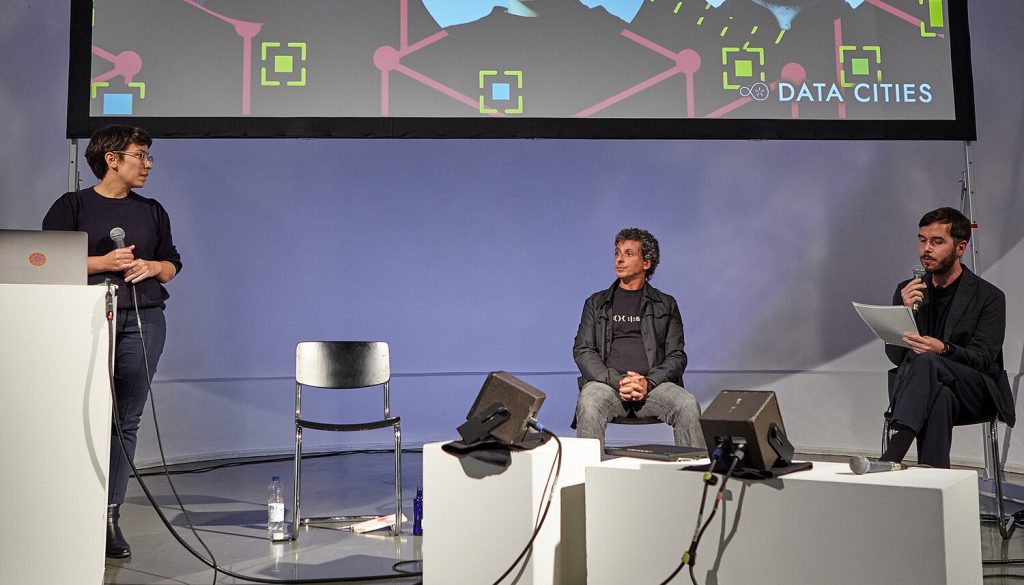
The work of the conference continued with the panel “Making Cities Smart for Us: Subverting Tracking & Surveillance,” a cross-section of projects by activists, researchers and artists digging into the false myth of safe and neutral technologies, proposing both counterstrategies and solutions to tackle issues introduced in the opening keynote.
Eva Blum-Dumontet, English researcher on privacy and social-economic rights, dedicated her work to the impact of tech on people, particularly those in vulnerable situations. She opened the talk with the observation that the term ‘smart city’ lacks of an official definition; it was coined by IBM’s marketing team in 2005 without a scientific basis. Since then, tech firms from all over the world have been developing projects to get into governments’ favour and to build urban areas that integrate boundless tech-solutions: security and surveillance, energy and mobility, construction and housing, water supply systems and so on.
As of today, thanks to smart cities, companies such as IBM, Cisco, Huawei, Microsoft and Siemens have found a way to generate the satisfaction of both governments and their suppliers, but do not seem to act in the public’s best interest. In their vision of smart urbanism people are only resources: like water, buildings and administrative services, they are something to extract value from.
Blum-Dumontet explained that when we refer to urban tech-development, we need to remember that cities are political spaces and that technology is not objective. Cities are a concentration of countless socio-economic obstacles that prevent many individuals from living a dignified life. Privilege, bias, racism and sexism are already integrated in our cities´ (tech-)infrastructures. The researcher acknowledged that it is very important to implement people-centric solutions, while keeping in mind that as of now our cities are neither inclusive nor built for all, with typical exclusion of, for instance, differently abled individuals, low-income residents and genderqueer people.

A sharp critique of the socio-economic systems causing injustice, exploitation and criminalisation, also lies at the core River Honer’s work. River is a web developer at Expedition Grundeinkommen and anti-capitalist tech activist, who wants to support citizens and activists in their struggle for radical transformation toward more just cities and societies without relying on solutions provided by governments and corporations.
Her work methodology includes critical mapping and geospatial analyses, in order to visualise and find solutions to structurally unjust distribution of services, access and opportunities in given geographic areas. Honer works with multidisciplinary teams on community-based data gathering, and turns information into geo-visualisation to address social issues and disrupt systems of discriminatory practices which target minorities and individuals. Examples of her work include LightPath, an app providing the safest well-lit walking route between two locations through various cities; Refuge Restroom, which displays safe restroom access for transgender, intersex, and gender nonconforming individuals who suffer violence and criminalisation in the city, and the recent COVID-19 tenant protection map.
Honer’s projects are developed to find practical solutions to systematic problems which underpin a ruthless political-economic structure. She works on tech that ignores or undermines the interests of capitalism and facilitates organisation for the public ownership of housing, utilities, transport, and means of production.
The Disruption Network Lab dedicated a workshop to her Avoid Control Project, a subversive tracking and alert system that Honer developed to collect the location of ticket controllers for the Berlin public transportation company BVG, whose methods are widely considered aggressive and discriminatory.
There are many cities in the world in which activist groups, non-governmental organisations and political parties advocate for a complete revocation of fares on public transport systems. The topic has been debated for many years in Berlin too; the BVG is a public for-profit company earning millions of euros annually on advertising alone, and in addition charges expensive flat fares for all travelers.
The panel discussion was concluded with Norway-based speakers Linda Kronman and Andreas Zingerle of the KairUs collective. The two artists explored topics such as vulnerabilities in Internet-of-Things-devices and corporatisation of city governance in smart cities, as well as giving life to citizen-sensitive-projects in which technology is used to reclaim control of our living environments. As Bazzichelli explained when presenting the project “Suspicious Behaviours” by Kronman, KairUs’s production constitutes an example of digital art eroding the assumptions of objective or neutral Artificial Intelligence, and shows that hidden biases and hidden human decisions influence the detection of suspicious behaviour within systems of surveillance, which determines the social impacts of technology.
The KairUs collective also presented a few of its other projects: “The Internet of Other People’s things” addresses technological transformation of cities and tries to develop new critical perspectives on technology and its impact on peoples’ lifestyles. Their video-installation “Panopticities” and the artistic project “Insecure by Design” (2018) visualise the harmful nature of surveillance capitalism from the unusual perspective of odd vulnerabilities which put controlled and controllers at risk, such as models of CCTV and IP cameras with default login credentials and insecure security systems which are easy to hack or have by default no password-protection at all.
Focusing on the reality of smart cities projects, the collective worked on “Summer Research Lab: U City Sogdo IDB”(2017), which looked at Asian smart urbanism and reminding the panellists that many cities like Singapore, Jakarta, Bangkok, Hanoi, Kuala Lump already heavily rely on tech. In Songdo City, South Korea, the Songdo International Business District (Songdo IBD), is a new “ubiquitous city” built from scratch, where AI can monitor the entire population’s needs and movements. At any moment, through chip-implant bracelets, it is possible to spot where someone is located, or observe people undetected using cameras covering the whole city. Sensors constantly gather information and all services are automatised. There are no discernible waste bins in the park or on street corners; everything seems under tech-control and in order. As the artists explained, this 10-year development project is estimated to cost in excess of 40 billion USD, making it one of the most expensive development projects ever undertaken.

The task of speculative architecture is to create narratives about how new technologies and networks influence and shape spaces and cultures, foreseeing possible futures and imagining how and where new forms of human activity could exist within cities changed by these new processes. Liam Young, film director, designer and speculative architect opened the keynote on the second conference day with his film “Worlds Less Travelled: Mega-Cities, AI & Critical Sci-Fi“. Through small glimpses, fragments and snapshots taken from a series of his films, he portrayed an alternative future of technology and automation in which everything is controlled by tech, where complexities and subcultures are flattened as a result of technology, and people have been relegated to the status of mere customers instead of citizens
Young employs the techniques of popular media, animation, games and doc-making to explore the architectural, urban and cultural implications of new technologies. His work is a means of visualising imaginary future worlds in order to help understand the one we are in now. Critical science fiction provides a counter-narrative to the ordinary way we have of representing time and society. Young speaks of aesthetics, individuals and relationships based on objects that listen and talk back, but which mostly communicate with other machines. He shows us alternative futures of urban architecture, where algorithms define the extant future, and where human scale is no longer the parameter used to measure space and relations.
Young’s production also focused on the Post-Anthropocene, an era in which technology and artificial intelligence order, shape and animate the world, marking the end of human-centered design and the appearance of new typologies of post-human architectures. Ours is a future of data centres, ITCs networks, buildings and infrastructures which are not for people; architectural spaces entirely empty of human lives, with fields managed by industrialised agriculture techniques and self-driving vehicles. Humans are few and isolated, living surrounded by an expanse of server stacks, mobile shelving systems, robotic cranes and vacuum cleaners. The Anthropocene, in which humans are the dominant force shaping the planet, is over.

The keynote, moderated by the journalist Lucia Conti, editor at “Il Mitte”and communication expert at UNIDO, moved from the corporate dystopia of Young, in which tech companies own cities and social network interactions are the only way people interrelate with reality, to the work of filmmaker Tonje Hessen Schei, director of the documentary film “iHuman”(2020). The documentary touches on how things are evolving from biometric surveillance to diversity in data, providing a closer look at how AI and algorithms are employed to influence elections, to structure online opinion manipulation, and to build systems of social control. In doing so, Hessen Schei depicts an unprecedented concentration of power in the hands of few individuals.
The movie also presents the latest developments in Artificial Intelligence and Artificial General Intelligence, the hypothetical intelligence of machines that can understand or learn any task that a human being can.
When considering AI, questions, answers and predictions in its technological development will always reflect the political and socioeconomic point of view, consciously or unconsciously, of its creators. For instance —as described in the Disruption Network Lab´s conference “AI Traps” (2019)—credit scores are historically correlated with racist segregated neighbourhoods. Risk analyses and predictive policing data are also corrupted by racist prejudice leading to biased data collection which reinforces privilege. As a result new technologies are merely replicating old divisions and conflicts. By instituting policies like facial recognition, for instance, we replicate deeply ingrained behaviours based on race and gender stereotypes and mediated by algorithms.
Automated systems are mostly trying to predict and identify a risk, which is defined according to cultural parameters reflecting the historical, social and political milieu, in order to give answers and make decisions which fit a certain point of view. What we are and where we are as a collective —as well as what we have achieved and what we still lack culturally— gets coded directly into software, and determines how those same decisions will be made in the future. Critical problems become obvious in case of neural networks and supervised learning.
Simply put, these are machines which know how to learn and networks which are trained to reproduce a given task by processing examples, making errors and forming probability-weighted associations. The machine learns from its mistakes and adjusts its weighted associations according to a learning rule and using error values. Repeated adjustments eventually allow the neural network to reproduce an output increasingly similar to the original task, until it reaches a precise reproduction. The fact is that algorithmic operations are often unpredictable and difficult to discern, with results that sometimes surprise even their creators. iHuman shows that this new kind of AI can be used to develop dangerous, uncontrollable autonomous weapons that ruthlessly accomplish their tasks with surgical efficiency.
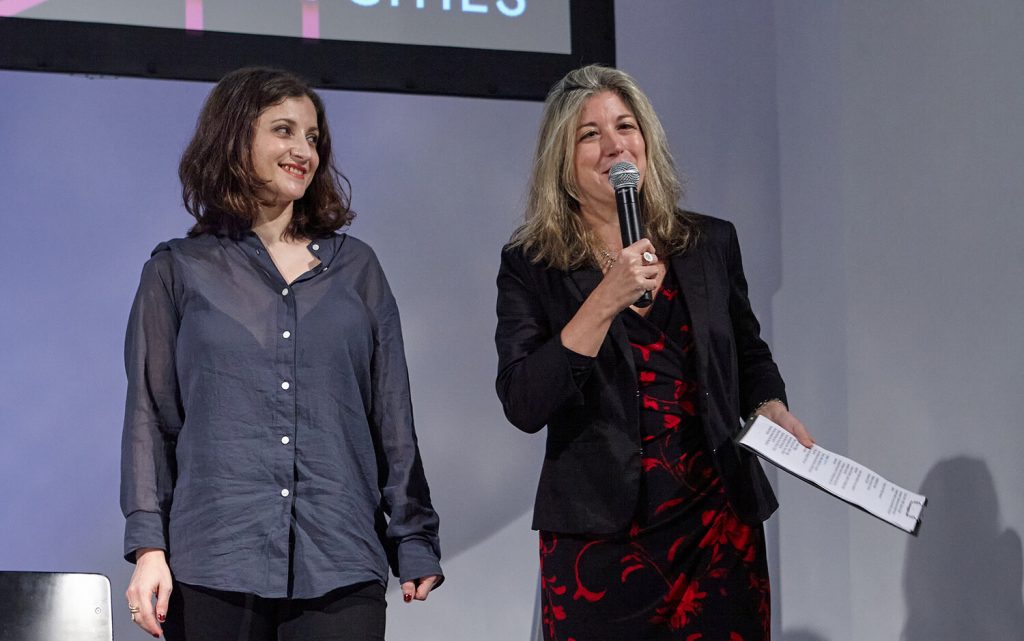
Conti moderated the dialogue between Hessen Schei, Young, and Anna Ramskogler-Witt, artistic director of the Human Rights Film Festival Berlin, digging deeper into aspects such as censorship, social control and surveillance. The panellists reflected on the fact that—far from being an objective construct and the result of logic and math—algorithms are the product of their developers’ socio-economic backgrounds and individual beliefs; they decide what type of data the algorithm will process and to what purpose.
All speakers expressed concern about the fact that the research and development of Artificial Intelligence is ruled by a few highly wealthy individuals and spoiled megalomaniacs from the Silicon Valley, capitalists using their billions to develop machines which are supposed to be ‘smarter’ than human beings. But smart in this context can be a synonym for brutal opportunism: some of the personalities and scientists immortalised in Hessen Schei´s work seem lost in the tiny difference between playing the roles of visionary leaders and those whose vision has started to deteriorate and distort things. Their visions, which encapsulate the technology for smart cities, appear to be far away from people-centric and based on human rights.
Not only big corporations but a whole new generation of start-ups are indeed fulfilling authoritarian practises through commercialising AI-technologies, automating biases based on skin colour and ethnicity, sexual orientation and identity. They are developing censored search engines and platforms for authoritarian governments and dictators, refining high-tech military weapons, and guaranteeing order and control.
The participants on stage made clear that, looking at surveillance technology and face recognition software, we see how existing ethical and legal criteria appear to be ineffective, and a lack of standards around their use and sharing just benefit their intrusive and discriminatory nature. Current ethical debates about the consequences of automation focus on the rights of individuals and marginalised groups. Algorithmic processes, however, generate a collective impact as well that can only be partially addressed at the level of individual rights— they are the result of a collective cultural legacy.
Nowadays, we see technologies of control executing their tasks in aggressive and violent ways. They monitor, track and process data with analytics against those who transgress or attempt to escape control, according to a certain idea of control that was thought them. This suggests, for example, that when start-ups and corporations establish goals and values within software regulating public services, they do not apply the principles developed over century-long battles for civil rights, but rely on technocratic motivations for total efficiency, control and productivity. The normalisation of such a corporatisation of the governance allows Cisco, IBM and many other major vendors of analytics and smart technologies to shape very delicate public sectors, such as police, defence, fire protection, or medical services, that should be provided customarily by a governmental entity, including all (infra)structures usually required to deliver such services. In this way their corporate tactics and goals become a structural part of public functions.

In the closing panel “Citizens for Digital Sovereignty: Shaping Inclusive & Resilient” moderated by Lieke Ploeger, community director of the Disruption Network Lab, political scientist Elizabeth Calderón Lüning reflected on the central role that municipal governments have to actively protect and foster societies of digital self-determination. In Berlin, networks of collectives, individuals and organisations work to find bottom-up solutions and achieve urban policies in order to protect residents, tenants and community spaces from waives of speculation and aggressive economic interests. Political and cultural engagement make the German capital a centre of flourishing debate, where new solutions and alternative innovative perspectives find fertile ground, from urban gardening to inclusion and solidarity. But when it comes to technological transformation and digital policy the responsibility cannot be left just at the individual level, and it looks like the city government is not leading the way in its passive reactions towards external trends and developments.
Calderón Lüning is currently researching in what spaces and under what premises civic participation and digital policy have been configured in Berlin, and how the municipal government is defining its role. In her work she found policy incoherence among several administrations, alongside a need for channels enabling citizens to participate and articulate as a collective. The lack of resources in the last decade for hiring and training public employees and for coordinating departmental policies is slowing down the process of digitalisation and centralisation of the different administrations.
The municipality’s smart city strategy, launched in 2015, has recently been updated and refinanced with 17 million euros. In 2019 the city Senate released the Berlin Digital Strategy for the coming years. To avoid the harmful consequences of a vertical approach by the administration towards its residents, activists, academics, hackers, people from civil society and many highly qualified scientists in the digital field came together to rethink and redesign an ecological, participatory and democratic city for the 21st century. The Berlin Digital City Alliance has been working since then to arrive at people and rights-centred digital policies and is structuring institutional round tables on these aspects, coordinated by civic actors.
Digital sovereignty is the power of a society to control technological progress, self-determining its way through digital transformation. It is also the geopolitical ownership and control of critical IT infrastructures, software and websites. When it comes to tech in public services, particularly essential public services, who owns the infrastructure and what is inside the black box are questions that administrations and policy makers should be able to answer, considering that every app or service used contains at least some type of artificial intelligence or smart learning automation based on a code, which has the potential to significantly affect citizens’ lives and to set standards that are relevant to their rights. Without open scrutiny, start-ups and corporations owning infrastructures and code have exceeded influence over delicate aspects regulating our society.

Rafael Heiber, geologist, researcher and co-founder of the Common Action Forum, focused on the urgent need to understand ways of living and moving in the new space of hybridisation that cities of the future will create. Taking a critical look at the role of technologies, he described how habitability and mobility will be fundamental in addressing the challenges posed by an urban planning that lies in a tech-substratum. As he explained, bodies are relevant inside smart environments because of their interactions, which are captured by sensors. Neoliberal capitalism has turned us into relentless energy consumers in our everyday lives, not because we move too much, but because we use technology to move and tech needs our movements.
Heiber considered the way automobiles have been influencing a whole economic and financial system for longer than a century. In his view they symbolise the way technology changes the world around itself and not just for the better. Cars have transformed mobility, urban environment, social interactions and the way we define spaces. After one hundred years, with pollution levels increasing, cities are still limited, enslaved, and dominated by cars. The geologist suggested that the implementation of smart cities and new technologies might end up in this same way.
Alexandre Monnin, head of Strategy and Design for the Anthropocene, closed the panel discussion questioning the feasibility of smart cities, focusing on the urge to avoid implementing unsustainable technologies, which proved to be a waste of resources. Monnin acknowledged that futuristic ideas of smart cities and solutionism will not tackle climate change and other urgent problems. Our society is profit-oriented and the more efficient it is, the more the system produces and the more people consume. Moreover, tech doesn´t always mean simplification. Taking as example the idea of dematerialisation, which is actually just a displacement of materiality, we see today for example how video rental shops have disappeared almost worldwide, replaced in part by the online platform Netflix, which represents 15 percent of internet traffic.
Monnin warned about the environmental impact of tech, not just the enormous amount of energy consumed and Co2 produced on a daily basis, but also the amount of e-waste growing due to planned obsolescence and consumerism. Plastics are now a growing environmental pollutant and constitute a geological indicator of the Anthropocene, a distinctive stratal component that next generations will see. Monnin defines as ‘negative commons’ the obsolete tech-infrastructures and facilities that will exist forever, like nuclear power plants, which he defines as “zombie technology”.
The French researcher concluded his contribution pointing out that humanity is facing unprecedented risks due to global warming, and—as far as it is possible to know—in the future we might even not live in cities. Monnin emphasized that people shall come together to prevent zombie-tech obsolescence from happening, like in Toronto, and he wishes that we could see more examples of civil opposition and resistance to tech which is unfit for our times. Smart cities are not revolutionising anything, they constitute business as usual and belong to the past, he argued, and concluded by appealing for more consideration of the risks related to institutionalisation of what he calls “corporate cosmology” which turns cities into profit-oriented firms with corporate goals and competitors, relying on the same infrastructures as corporations do.
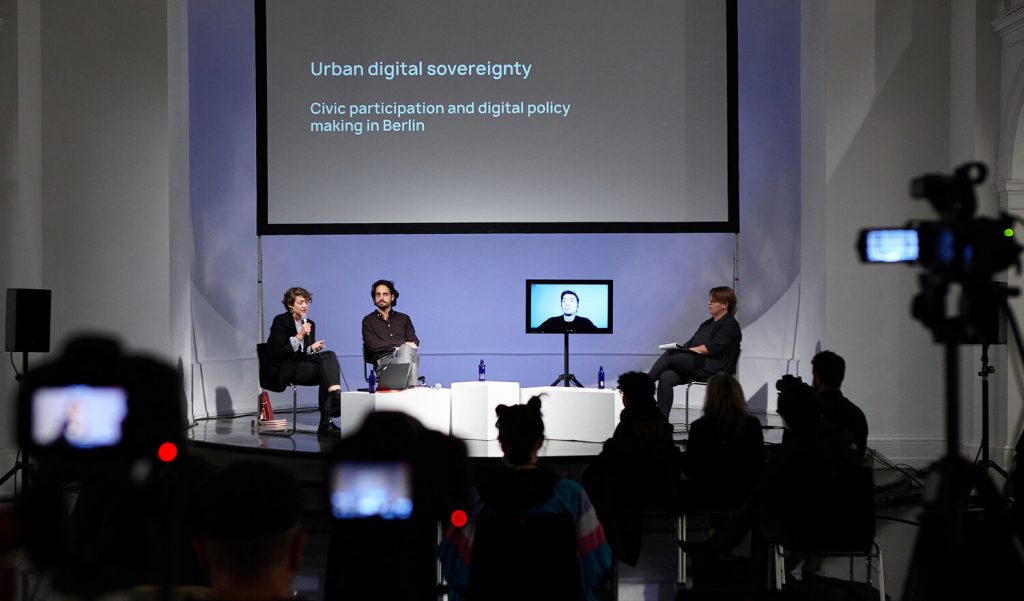
In its previous conference “Evicted by Greed,” the Disruption Network Lab focused on the financialisation of housing. Questions arose about how urban areas are designed and governed now and how they will look in the future if the process of speculation on peoples’ lives and privatisation of available common spaces is not reversed. Billions of people live in cities which are the products of privilege, private corporate interests and financial greed. This 20th conference focused on what happens if these same cities turn into highly digitised environments, molded by governments and billionaire elites, tech-engineers and programmers, who wish to have them functioning as platforms for surveillance and corporate intelligence, in which data is constantly used, stored and collected for purposes of profiling and control.
According to the UN, the future of the world’s population is urban. Today more than half the world’s people is living in urban areas (55 percent). By mid-century 68 percent of the world’s population will be living in cities, as opposed to the 30 percent in 1950. By 2050, the global urban population is projected to grow by 2.5 billion urban dwellers, with nearly 90 percent of the increase in Asia and Africa, as well as the appearance of dozens of megacities with a population of at least 10 million inhabitants on the international scene.
This conference presented the issue of algorithmic sovereignty and illustrated how powerful tech-firms work with governments—which are also authoritarian regimes and dictators— to build urban conglomerates based on technological control, optimisation and order. These corporations strive to appear as progressive think tanks offering sustainable green solutions but are in fact legitimising and empowering authoritarian surveillance, stealing data and causing a blurry mix of commercial and public interests.
Algorithms can be employed to label people based on political beliefs, sexual identity or ethnicity. As a result, authoritarian governments and elites are already exploiting this tech to repress political opponents, specific genders and ethnicities. In such a scenario no mass-surveillance or facial recognition tech is safe and attempts at building “good tech for common goods” might just continue to fail.
To defeat such an unprecedented concentration of power, we need to pressure governments at all levels to put horizontal dialogue, participation, transparency and a human-rights based approach at the centre of technological transformation. To this end, cities should open round tables for citizens and tech-developers, forums and public committees on algorithmic sovereignty in order to find strategies and local solutions. These will become matters of, quite literally, life and death.
Smart cities have already been built and more are at the planning and development stages, in countries such as China, Singapore, India, Saudi Arabia, Kazakhstan, Jordan, and Egypt. As Bazzichelli pointed out, the onset of the dramatic COVID-19 crisis has pushed social control one step further. We are witnessing increasing forms of monitoring via tracking devices, drone technologies and security infrastructures. Moreover, governments, banks and corporations think that this pandemic can be used to accelerate the introduction of technologies in cities, like 5G and Internet of Things.
There is nothing wrong with the old idea that we can use technology to build liveable, sustainable, and efficient cities. But it is hard to imagine this happening with technology provided by companies that exhibit an overall lack of concern for human rights violations.

Alongside the main conference sessions, several workshops enriched the programme. Videos of the conference are also available on YouTube.
For details on speakers and topics, please visit the event page here: https://www.disruptionlab.org/data-cities
The 21th conference of the Disruption Network Lab curated by Tatiana Bazzichelli
“BORDER OF FEARS” will take place on November 27-29, live from Studio 1, Kunstquartier Bethanien, Mariannenplatz 2, 10997 Berlin.
More info here
To follow the Disruption Network Lab sign up for its Newsletter to receive information about its conferences, projects and ongoing research.
The Disruption Network Lab is also on Twitter and Facebook.
On May 29, 2020, the Disruption Network Lab opened its 19th conference, “Evicted by Greed: Global Finance, Housing & Resistance”. The three-day-event was supposed to take place in Berlin in March, on the days of the global call for the Housing Action Days. Instead, it took place online due to ongoing safety concerns relating to the coronavirus pandemic.
Chaired by Tatiana Bazzichelli and Lieke Ploeger, programme and community director of the Disruption Network Lab, the interactive digital event brought together speakers and audience members from their homes from all over the world to investigate how speculative finance drives global and local housing crises. The topic of how aggressive speculative real-estate purchases by shell companies, anonymous entities, and corporations negatively impacts peoples’ lives formed the core conversation for the presentations, panel discussions, and interactive question and answer sessions. The conference served as a platform for sharing experiences and finding counter-strategies.
In her introductory statement, Bazzichelli took stock of the situation. As the pandemic appeared, it became clear worldwide that the “stay-at-home” order and campaigns were not considering people who cannot comply since they haven’t got any place to stay. Tenants, whose work and lives have been impacted, struggle to pay rent, bills, or other essentials, and in many cases had to leave their homes or have been threatened with forced eviction. People called on lawmakers at a national and local level to freeze rent requirements as part of their response to the pandemic, but very few measures have been put in place to protect them. However, scarce and unaffordable housing is neither a new, nor a local problem found in just a few places.
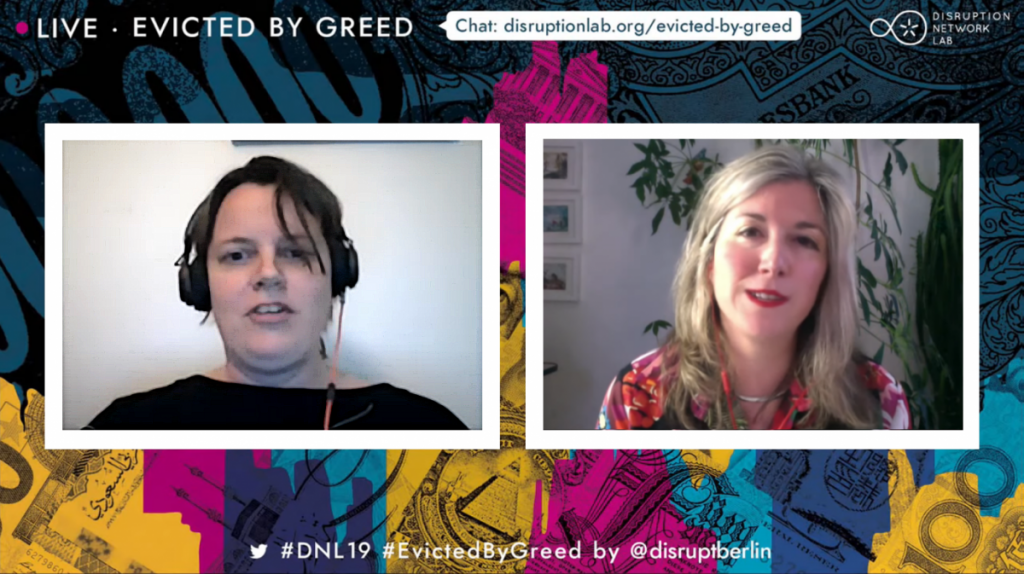
Christoph Trautvetter, public policy expert and German activist of
Netzwerk Steuergerechtigkeit (Network for Tax Justice) and Wem gehört
die Stadt (Who Owns the City) of the Rosa-Luxemburg Foundation, and Manuel Gabarre de Sus, Spanish lawyer and activist from the Observatory Against Economical Crime, delivered the opening keynote “Anonymous & Aggressive Investors: Who owns Berlin & Barcelona?” moderated by Eka Rostomashvili, advocacy and campaigns coordinator at Transparency International.
In the last decade waves of private equity real estate investments have reshaped the rental housing markets in cities like Berlin and Barcelona. Housing and real estate have been deformed by global capital markets and financial excess, treated as a commodity, a vehicle for predatory investment and wealth rather than a social good reflecting a human right. This led to evictions, discriminations in the housing sphere, and lack of access to basic housing-related services, all put in place by aggressive real estate investors.
Trautvetter is co-author of a recent study tracing the ownership of 400 companies owning real estate in Berlin. He explained that in the city, where about 85% of the population are renters, exploding house prices and rentals have been guaranteeing investors returns far beyond 10% per year after the financial crises of 2009. Here the emergence of corporate landlords changed the city. They are entities that own and operate rental housing on a massive scale, replacing the traditional “gentle old lady” landlord. At 17.5%, Berlin has a law proportion of direct investors renting out their properties.
Activists, politicians, and organisations of tenants are trying to fight unlawful evictions and speculative investments reshaping the German capital, but often face anonymity. Almost half of the city is in the hands of listed companies, professional investors, or indirect investors shielded by property management firms and lawyers that operate on their behalf. International private equity companies are one of the most obscure and greedy embodiments of policy failure in this context.
Gabarre de Sus focused on the problem of the opportunistic investment funds that appeared in Spain due to strong deregulation. After the global financial crisis of 2009, the rescue of the Spanish financial system ensured that hundreds of thousands of households were indirectly under public control. But the European Union and the Spanish Government decided in 2012 to sell these properties to opportunistic investors. Many say that if public ownership of these real estates had been maintained for social renting, the rent bubble of recent years would not have occurred. As a result, many vulture funds, particularly from the United States like Blackstone, Hayfin, TPG, and millionaires like the Mexican Carlos Slim, made huge profits. Since then, rent prizes have increased of more than the 50% in the main Spanish cities, more than 30 times faster than wages.
Whilst describing this process, Gabarre de Sus focused on the political and legal ties of big investment funds that invest in real estate. There are structures of political and economic interest that allow companies like Blackstone Group Inc. — one of the largest real estate private equity and investment management firms in the world declaring $140 billion of real estate assets under management, 25% of its total assets — to scale business models in which properties are bought, renovated, and then put back on the market at rents that tenants cannot afford. These actors are influential, with economic partners at international level, including banks from the world’s largest economies.
In many cases, real estate registers do not contain any information on beneficial owners or there is no way to link legal and beneficial owners, so that both authorities and citizens know very little about who owns their cities. EU legislation obliges information on real estate holders to be available to authorities and specifies that the general public shall receive access to beneficial ownership information of EU based companies. The problem is that such registers are usually maintained under self-disclosure principles based on data internally identified by the reporting entity. Access to data is often difficult and expensive. Once you get the information, it can take time to check it and find out contradictory data. Moreover, an articulated system of international shell companies, secrecy legislation, and strategic financial loopholes provides immunity and contributes to global inequality, consolidating the incessant shift of wealth from the poor to the rich.

In Berlin nearly half of the real estate investors remain anonymous and there is no certainty of how much dirty money hides behind their investments, which is something common to many places around the world. The current situation — revealed also by the Panama Papers investigation — shows that governments profit from illegal wealth from transnational money-laundering, hosting international criminal enterprises within their territories and capital cities, thus providing a grey area for illegal practices where false or inappropriate identification represents the other face of fraudulent records and corruption.
The panel “Foggy Properties & Golden Sands: Money Laundering in London & Dubai” moderated by Rima Sghaier, outreach and research fellow at the Hermes Centre for Transparency and Digital Human Rights, made clear how easy and common it is for global elites and organised criminality to open offshore companies, move assets, and buy real estate in big capital cities, with investments that integrate illegal funds into the financial system and legitimate economy.
Sam Leon, data investigations lead at Global Witness, referred to the relations between satellite fiscal havens such as the Virgin Islands, the Cayman, and the Channel Islands, and the City of London. These countries are linked through commercial and legal ties with high probabilities for dark money to flow through the UK’s Overseas territories and Crown Dependencies undetected.
The UK has a public land registry, but it is difficult to effectively scrutiny data. Companies are obliged to file good quality information, but many do not and authorities are not able to check it accurately. Britain is defined by detractors as the world’s greatest enabler of corporate tax avoidance. Considering real estate, Leon explained that tens of thousands of tenants in England and Wales are in the hands of unscrupulous owners, who hide behind anonymous companies and trusts.
One loophole real estate investors use is acquiring shares in a company that owns real estate, rather than the real estate itself; the property can be then sold by selling the shares in the company with no UK corporate tax. If the company is registered in a country that guarantees secrecy and free hands, no name appears. According Global Witness in England and Wales 87,000 properties with an estimated value of more than 1 billion pounds are owned by companies incorporated in secrecy jurisdictions, which keep secret the information about the real owners. Scotland suffers from the same problem, and in this context Scottish Limited Partnerships are a major concern too.
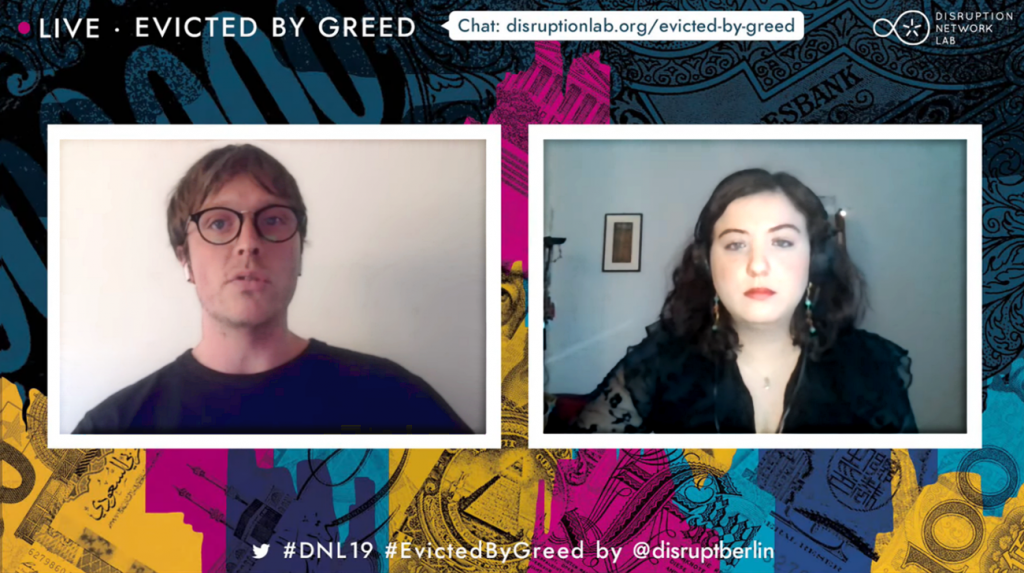
Companies avoid inheritance tax and capital gain tax, riding fiscal loopholes. The use of firms based in countries which are known tax havens to purchase property is being observed all around the world, with concerns about how much property is owned by unaccountable offshore entities.
The analyses of Leon introduced topics covered by the second panellist Karina Shedrofsky, who presented her work as head of OCCRP’s research team “Dubai’s Golden Sands.” Recently leaked datasets of property and residency details were obtained by the non-profit group C4ADS, and provided to the international investigative journalists of the OCCRP as part of the Global Anticorruption Consortium, in collaboration with Transparency International.
International criticism of governments and independent organisations pointed out that Dubai has become an open market for money laundering and a safe haven for the corrupt at a global level, due to the lack of controls along with very profitable conditions. The United Arab Emirates are accused of weakly regulating the financial sector, guaranteeing secrecy, and offering the world’s criminals a range of services. The country’s land registry is not open to the public and a lack of enforcement and oversight in the property sector is ideal to stash vast amounts of dirty money.
Shedrofsky pointed out that Dubai is an absolute monarchy ruled as a business. Several transnational investigations show that its laws seem to be a facilitator for international money laundering, corruption, and other financial crimes.
The emirate has been attracting secretive real estate purchases by foreign companies and individuals for years. Construction and real estate sector represents 20% of the country’s gross domestic product (2016). In the country it is possible to move money with very little regulatory scrutiny, cash-based transactions are incentivised, and the volume of gold trafficked accounts for around 25% of global trade, with almost no questions about its origins. Wealthy investors are offered a property investment visa by an investment in real estate of minimum $272,000 dollars, and get the benefits of light financial regulation, anonymity, and banking secrecy.
Shedrofsky explained how researchers from 8 countries worked on thousands of spreadsheets maintained by real estate professionals, in an accurate cross-border investigation that led to the publication of a hundred names of wealthy people, who have invested millions in Dubai. The non-official records from the years 2014-2016 provided more than 129,000 owner’s data, which the team organised per country and verified, revealing only information that could be proven beyond doubt. A website hosting an interactive map with the detected properties is online, and anyone can check it (occrp.org/en/goldensands/).
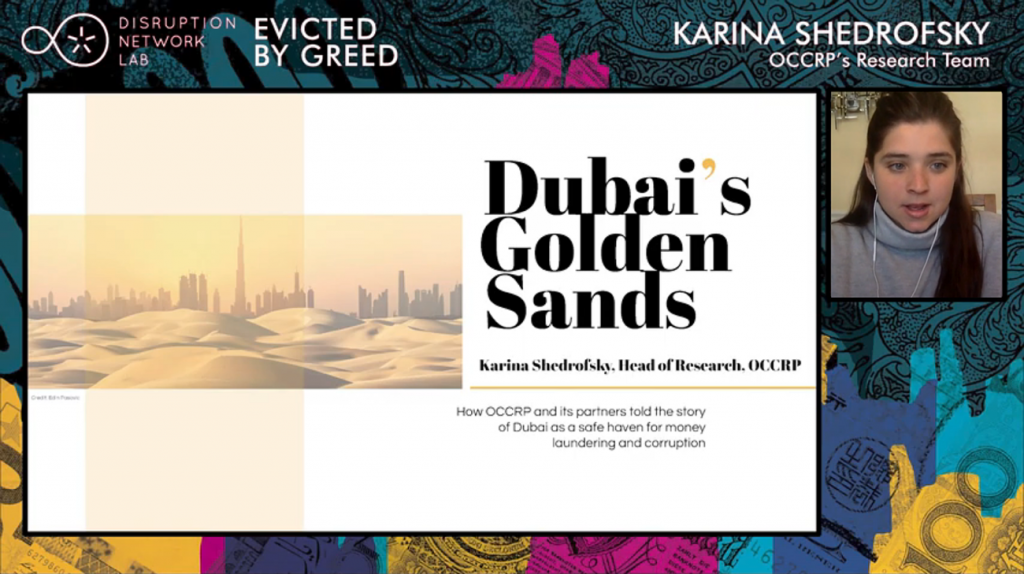
The first day of the conference closed with filmmaker and journalist Fredrik Gertten and Leilani Farha, former UN Special Rapporteur on the right to housing, in a live conversation moderated by Tatiana Bazzichelli. Gertten’s latest documentary investigates the factors that push people out from their own city, turning it into an unaffordable place that is more and more difficult to live in due to the extreme difference between housing prices and wage development.
From New York to Barcelona “Push: The Film” narrates how corporations and financial elites are speculating on people’s lives. Renters worldwide are drowning in a sea of self-doubt, with feelings of inadequacy and fears, because they think they are unable to keep up with life. But the documentary shows that this condition is the consequence of a system intended to harm, marginalise, and discriminate them. Even if residents should be able to afford to live in their own cities, this process inexorably condemns them to move away.
The work of the speakers on the first day of the conference reinforced the idea that crowd-based and data-driven research projects, together with independent and cross-border investigations, can allow a glimpse behind the curtain of the real estate market. Anonymity and secrecy in juxtaposition to openness and transparency, obtained through collective mobilisation, collecting, sharing, and analysing data.
A depressingly similar pattern emerges in countries all over the world. Housing has been financialised and turned into an investment vehicle, which has caused an oversupply of luxury estates and empty buildings in many cities, and a chronic shortage of adequate housing for the least advantaged, for the working class, and often for the middle class too. A process often encouraged by governments.
In this context, “financialisation” refers to tendencies within the economic system characterised by the expansion and proliferation of financial markets penetrating into a range of both economic and social sectors, and consequently affecting human rights related goods — such as housing, pensions and healthcare — making huge profits out of basic needs and human sufferings.
With regard to the financialisation of housing, not just banks, corporations, and big investment funds play this ruthless game. Fraudsters, money launderers, and organised crime are very active internationally, and look for weak financial systems and a moment of crisis to speculate on the property market.

Ela Kagel, digital strategist and founder of Supermarkt Berlin, discussed collective solutions to tackle housing, social, and economic injustices with the sociologist Volkan Sayman, promoter of the campaign “Expropriate Deutsche Wohnen & Co!”. This movement is an example of how residents can involve themselves to determine and achieve their own objectives, acting on their rights to create a space for their perspectives and needs within an urban context.
After a majority of citizens were found to be in favour of the initiative in early 2019, a city-wide referendum could be now called on the expropriation of private housing companies with more than 3,000 housing units. Local political parties have not managed to find agreement yet and, as a result, the effects of the referendum in Berlin are likely to be minor if people do not keep on supporting it. The expropriation would put 240,000 flats under public control.
As outlined, investors from the international capital market made huge purchases in Berlin’s residential and commercial real estate: the company Deutsche Wohnen alone owns 111,500 apartments in the city. Together with Vonovia, BlackRock, Akelius, Blackstone, Carlyle, Optimum Evolution, and others, these companies own almost one fourth of the city. In the early 2000s Berlin’s government sold many public housing units and areas to these companies, instead of offering them to residents as development project to focus on local communities and their needs. The Expropriate Deutsche Wohnen & Co! community has forced large real estate companies and politicians from all parties to address the issue and successfully raised awareness among Berliners who engaged in it.
In Berlin exasperated renters successfully came together and organised themselves in several ways. They are also appealing to the local council to stop the sale of their homes, and the “Rent Price Cap,” a new policy in force since 2020, has frozen rents on around 1.4 million homes in the German capital. The “Mietendeckel” is supposed to last for 5 years. Twelve constitutional complaints have already been filed against it.
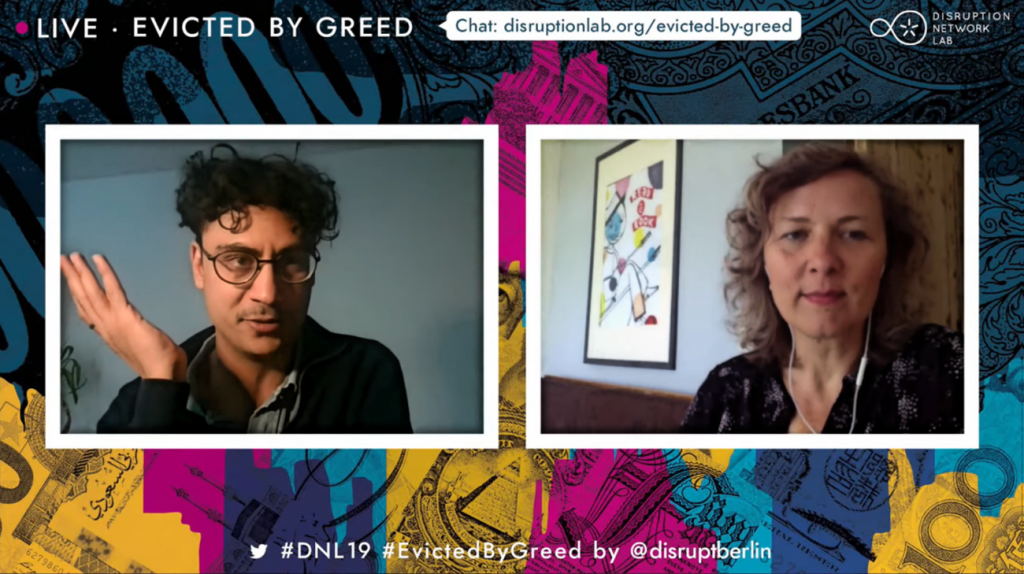
The keynote on the second day “The Human Rights Solution: Tackling the housing crisis” focused on the work of Leilani Farha, UN former Special Rapporteur on adequate housing, in conversation with Justus von Daniels, Editor-in-Chief of CORRECTIV, non-profit newsroom for investigative journalism. Opening the keynote Von Daniels presented the German crowdsourced project he runs — Who owns the city? — which is based on community-powered investigations collecting data to gain a better understanding of the German housing market.
Farha recalled that international human rights law recognizes everyone’s right to an adequate housing and living conditions. Global real estate today represents nearly 60% of the value of all global assets; with housing comprising nearly 75%. That´s more than twice the world’s total gross domestic product. The aspect to consider is that such a vast amount of wealth seems to have left governments accountable to real estate investors rather than to their international human rights obligations.
Farha criticised Blackstone Group Inc. and its subsidiaries for a practice she also confirms has become common throughout the industry in many countries around the world. These companies are targeting multi-family residences in neighbourhoods deemed to be “undervalued,” so a building or several buildings from an area of poor and low-income tenants. The former UN rapporteur described how Blackstone purchases a building, undertakes repairs or renovation, and then increases the rent driving existing tenants out, and replacing them with higher income ones.
As the speakers pointed out, there has been little attention given to the impact of financialisation on housing, which has caused displacement and evictions, changing urban areas forever. Until the massive financial deregulation of the 1980s, housing was built and paid for locally. Governments, local savings, and loan institutions were supposed to provide the bulk of financing for housing up. Due to an ideological shift, determined by the impact of the dominance on financial markets of big investment funds, banks and corporations, housing is increasingly intertwined with flows of global capital. Housing markets are now more responsive to these flows than to local conditions becoming a global industry.
With roots in the 2008 financial crisis, the recent massive wave of investments by international corporations, banks, and big investment funds completed the shift from housing as a place to build a home, to housing as an investment, with devastating consequences for millions of people. The current real-estate cycle started in 2009 and led to significant price increases for residential property in many cities all over the world. Among several factors, the proliferation of predatory equity funds sifting through the world searching for undervalued investment opportunities and finding them in housing.
The global goal is to guarantee everybody legal security and protection against unlawful forced evictions, harassment and other threats, to make sure that personal or household financial costs associated with housing do not threaten or compromise the attainment and satisfaction of other basic needs. We see instead that the needs of disadvantaged and marginalized groups are not taken into account at all. In urban areas public spaces and social facilities disappear together with the expression of cultural identities and ways of life of the original residents.

Statistics show that many of the less advantaged are renters, not owners. And rents have increased even faster than housing prices in many metropolitan areas. Some call for more expansion at the urban peripheries with sustainable and modern public housing projects and better infrastructures. Others call for empowering neighbourhoods and local communities to reverse the financialisation process and to improve the conditions of the areas, that are most affected by this process, building more housing for themselves, and distributing those empty ones.
The conclusive panel on the second day was moderated by Iva Čukić, cofounder of the urban development organisation Ministry of Space, set up to occupy abandoned and neglected urban spaces and fill them with projects, workplaces, housing, or alternative art galleries, to enhance everyone’s right to the city. The panel brought into dialogue different modalities of fighting property speculation, and sharing tactics of resistance in the political and media landscape, and presented concrete alternatives for the urban territory.
The first panelist to speak, Marco Clausen, is the co-founder of the Prinzessinnengarten in Berlin, an island of collective gardening in Moritzplatz. The garden represents an open space to share and develop new forms of urban life, where to practice ideas of social-ecological positive transformation, in the context of privatisation and financialisation of real estate in the city.
In the 2000s Berlin was still a city with vast empty areas, dismissed military facilities and many old empty buildings. In the last 20 years over 3,000 sites in Berlin owned by public housing societies have been privatised. The garden started as a temporary project in 2009 and has been struggling since 2012 against private investors and speculation. Back then activists mobilised 30,000 people to stop the selling process to an investor, and obtained a new contract until 2018. The area around the garden was first in the hands of a Goldmann Sachs fund, and later to Deutsche Wohnen. A small group fought for two years to keep the garden a collective project, managing to prolong the contract for another six years and receiving public funding to rebuild the garden as an open learning and cultural centre.
Always in Berlin, another group of activists has been mobilising to fight the Amazon tower, that is to be completed in 2023 in the area of Berlin-Friedrichshain. Yonatan Miller, tech-worker and activist from the coalition “Berlin vs. Amazon,” talked about the movement that opposes the big tech company’s project, that will reshape the area and impact many people’s lives. On one side, over the last five years Berlin has already seen the fastest increase in housing prices globally, on the other big tech corporations are known for getting into real-estate market and make things worse for local residents, gentrifying the area. Miler discussed the challenges of the activists, presenting their strategy for the struggle ahead to replicate the success story of New York’s ousting of Amazon in 2019.
The panel proceeded with the StealThisPoster collective and their online archive “stealthisposter.org” maintained by artists and activists part of a network formed around the right to housing movements of London and Rome. The group presented the practice of subvertising, the artistic hacking of corporate and political advertisements to make counter-statements by disrupting lucrative communication of induced desires and needs and parodying of them. Inside urban areas subvertising (portmanteau of subvert and advertise) is an act of reappropriation of those public spaces that have been turned into a vehicle for intrusive and harmful commercial communications.
StealThisPoster recently supported with various guerrilla actions a community fighting against the eviction of the “Lucha y Siesta,” a space of social housing and the first inhabited by an all-female squat in Rome. Their evocative pictures of Roman monuments lit at night by the words “on sale” became viral and helped the cause. However, the existence of this independent legendary social space is still at risk. Lucha Y Siesta was put on auction by the city council of Rome on April 7 this year. The short film premiere “StealThisPoster: Artivism & the Struggle of Lucha Y Siesta” that StealThisPoster created in occasion of Evicted By Greed, focuses on this experience and introduces the practice of subvertising.
A video contribute by Penny Travlou from the University of Edinburgh concluded the panel. Travlou talked about the housing crisis in Athens and the local activists of the AARG collective, Action Against Regeneration & Gentrification, born to fight against eviction, financial speculation, and to support the rights of the refugees.
Alongside the main conference sessions, a workshop on the third day enriched the programme.
The virtual tour “Visiting the Invisible” by Christoph Trautvetter discovers the anonymous and aggressive real estate investors of Berlin, drawing on the findings of the project “Wem gehört die Stadt” of the Rosa-Luxemburg Stiftung, and including further recent studies from other collectives.

The conference “Evicted by Greed” presented experts working on anti-corruption, investigative journalists, artists and activists, who met to share effective strategies and community-based approaches to increase awareness on the issues related to the financialisation of housing and its negative effects. Here bottom-up approaches and methods that include local communities in the development of solutions appear to be fundamental. Projects that capacitate collectives, minorities, and marginalized groups to develop and exploit tools to combat systematic inequalities, injustices, and speculation are to be enhanced.
Ghostly shell companies and real estate speculators evict real people from their homes. It is not possible to state that all of these companies are acting illegally, or indeed avoiding paying taxes by being based in tax havens, but it is proven that opaque offshore firms are routinely used by criminals for systemic tax evasion, to buy property as a means to launder or stash dirty money, as well as to dodge taxes.
Open registers and open debate about these issues are very important, and not just for possible judicial outcomes. It is important to find out who the owners of real estates are and give a name to the landlords. Sometimes they might not be speculation oriented individuals and might not be aware of the consequences of their investments, but have delegated ruthless intermediates, lawyers, and investment consultants. There could be hundreds of workers who invested in a pension found without knowing that their profit is based on aggressive speculation.
Equal and non-discriminatory access to public spaces and adequate housing is not possible without an appropriate and effective regulation. The researches, the projects and the investigations presented in this conference are all worthwhile experiences with proven benefits, but ultimately, they may not be enough to alter the structural forces in play. The pandemic has shown that speculators all over the world wait for moments of crisis to purchase new real estates for a lower price, taking advantage of the financial difficulties that many people are experiencing. A growing number of property investors are preparing for what they believe could be a once-in-a generation opportunity to buy distressed real-estate assets at bargain prices. The system facilitates the concentration of real states in the hands of big international landlords and governments remain inert.
The solution cannot be found in one simple formula, or by asking people to buy real estate and become direct investors and new owners, in a deregulated system based on speculation, where most of the individuals struggle to make a living. The global economic system is based on banks holding massive amounts of loans to companies based in tax havens, speculative real estate investments and a small economic elite that makes and escapes rules, defending financial deregulations and feeding social injustice.
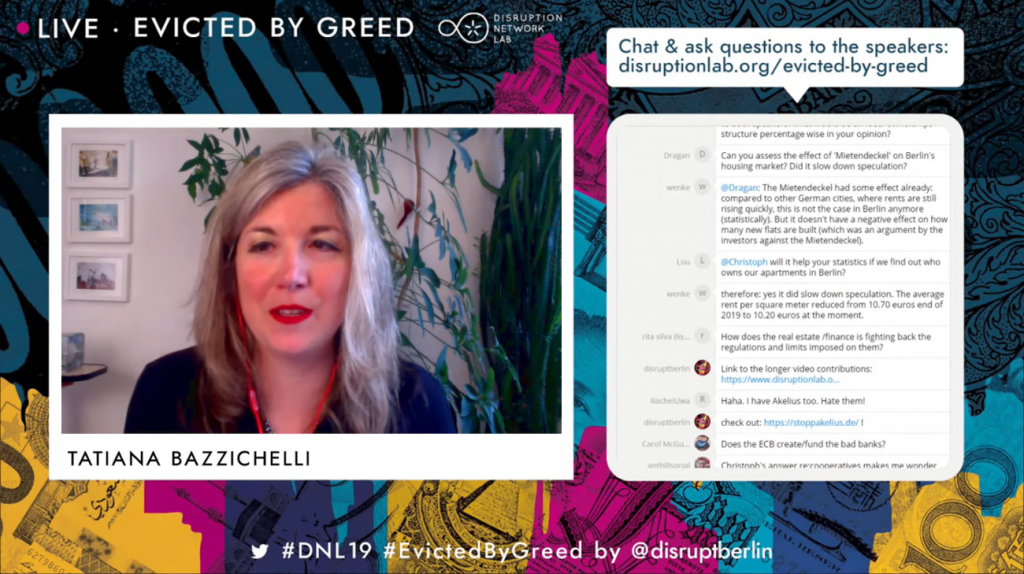
Videos of the conference are also available on YouTube.
In-depth video contributes by the speakers recorded before the conference are available here: https://www.disruptionlab.org/evicted-videos
For details of speakers and topics, please visit the event page here: https://www.disruptionlab.org/evicted-by-greed
The 20th conference of the Disruption Network Lab curated by Tatiana
Bazzichelli & Mauro Mondello is DATA CITIES: SMART TECHNOLOGIES,
TRACKING & HUMAN RIGHTS. It will take place on September 25-27 at Studio 1, Kunstquartier Bethanien, Mariannenplatz 2, 10997 Berlin. More info: https://www.disruptionlab.org/data-cities
To follow the Disruption Network Lab sign up for its Newsletter and get informed about its conferences, ongoing researches and projects.
The Disruption Network Lab is also on Twitter and Facebook.
On the 20th of September, Tatiana Bazzichelli and Lieke Ploeger opened the 17th conference of the Disruption Network Lab with CITIZENS OF EVIDENCE to explore the investigative impact of grassroots communities and citizens engaged to expose injustice, corruption, and power asymmetries.
Citizen investigations use publicly available data and sources to autonomously verify facts. More and more often ordinary people and journalists work together to provide a counter-narrative to the deliberate disinformation spread by news outlets of political influence, corporations, and dark money think-tanks. However, journalists and citizens reporting on matters in the public interest are targeted because of the role they play in ensuring an informed society. The work of independent investigation is often delegitimised by public authorities and denigrated in a wave of generalisations against ‘the elites’ and media objectivity, actually designed to undermine independent information and stifle criticism. It appears to be a global process that aims at blurring progressively the boundary between what is fake and what is real, growing to such a level that traditional mainstream media and governments seem incapable of protecting society from a tide of disinformation.
An increasingly Orwellian campaign for the purpose discredit upon them has been built for years against citizens and activists opposing the project of a controversial high-speed rail line for freight trains between Italy and France, which is considered useless and harmful. The Disruption Network Lab conference opened with the keynote GHOSTS IN THE WOODS AND UNCANNY ENTITIES: On How to Cover the Italian «NO TAV» Movement by Wu Ming 1, who spent three years among the people of the Susa Valley opposing this mega-infrastructural project.

As the moderator, author, and filmmaker Alexandra Weltz-Rombach explained, Wu Ming is a pseudonym for a group of Italian authors formed in Bologna after the experience of the Luther Blissett project. For almost 20 years the literary collective has been writing essays, meta-historical novels, and creative narrative, using often the techniques of investigative journalism. Today it is widely appreciated for its capability to deconstruct and analyse complex aspects of social and political life, challenging long-existing paradigms and traditions and synthesizing the views of different minds, to build an alternative narration on facts, inspiring unconventional critical process. Wu Ming 1 explored the Susa Valley and the woods occupied by police and wire fences, experiencing the struggle of a community in its territories, to write a history-as-novel take on the most enduring and radical environmental protest in contemporary Italy, known as No-TAV (TAV stands for Treno Alta Velocità – High Speed Train). To do so, he walked, mapped the territory, and ‘evoked ghosts’. The history of a country can be described by the history of its borders and the Susa Valley is a borderland in the mountains. Probably where Hannibal walked with his army to cross the Alps, since the early 90s it has been projected another huge tunnel inside the mountains, in a long-standing tradition of railroad-tunnels built sacrificing lives and health.
To understand the No-TAV struggle we can go back in time. To when the TAV-railway was first projected, and contextually the opposition of local communities started. But also, back in time to all the conflicts that have been fought on these mountains, which are “full of ghosts” as the author said. Wu Ming 1 explained that in literature and popular tradition, a ghost appears when there is an unresolved story, a wasted life that ended badly. Borderlands are the places where the most of ghosts are to be found. In the Susa Valley, ghosts are suppressed memories of wars and of social conflicts that shaped the territory.
Wu Ming published several works on environmental and climatic issues and wrote a lot about mountains too. Almost 78% of Italian territory is covered by mountains or hills. Their iconic representation has been at time twisted by nationalism, militarism and machismo. The Alps were “sacred borders of the fatherland” – nature to conquer, a symbol of virility and power in fascist propaganda. Today those mountains are an obstacle to economic growth; a growth that might put at risk the whole Susa Valley. Thus, instead of tackling legitimate concerns, project Stakeholders have been seeking for 20 years to delegitimize those leveling the charges against the high-speed railway, despite the masses of evidence to support their claims, using intimidation and violence against them. But the no-TAV collectives’ claims have always been proven to be right, and the project has been declining in size over time. However, the fight within the Valley is still on and the TAV-project is far from being archived.

The panel on the first day, EXPOSING ABUSES: Citizens Recording Human Rights Violations from the US to The Gambia, introduced by Michael Hornsby of Transparency International, opened with a presentation by Melissa Segura, journalist of BuzzFeed News from the US. She documented allegations proving that the Chicago police officer Reynaldo Guevara had framed dozens of innocent people for murder. The reporter put a light on forgotten judiciary cases, giving voice to families and communities affected by injustices, hit by a profound brokenness that she experienced herself when her nephew was framed and arrested years before.
A group of black and Latino mothers, aunts, and sisters knew that their beloved were innocent, but no officials wanted to take up their cause. Segura met these women after they had been fighting for decades in search of justice. They began when the journalist was at her elementary school: “at the time they had already gathered in a team, collecting data and writing spreadsheets on Lotus” she recalled. They had no chance to be heard, no PR, no lobby, no support from media were available to them. Segura realized soon that the story she had to cover wasn´t just the conviction of a 19-year-old-boy sentenced in 1999 with 110 years of prison for a murder he did not commit. It was also about the community of women that were fighting for justice, it was about their lives.
She learnt soon that her sources were able to cover their own stories much better than how she could, showing her new paths to the truth. The journalist dedicated time to building a trusting relationship with them, giving full reassurance that their story would be fairly reported. After an intense three-year investigation, she succeeded in wearing down a key witness to testify, cracking the wall of impunity. This process, she said, “did not expose the harm of people, but tried to connect to it.”
Reynaldo Guevara has been beating up people, framing them, extorting false confessions and false witnesses for years. Since publishing Segura’s articles, seven innocent men have been freed, and dozens more convictions are under review.
In the context of the major movements that draw attention on issues such as injustice and police violence targeting specific communities and minorities in the US, policy and data analyst Samuel Sinyangwe decided to join the work of justice activist groups formed after the 2014 police shooting of Michael Brown in Ferguson, Missouri. He is now part of the Police Scorecard project, and of the Campaign Zero independent platform he co-founded, designed to facilitate and guarantee the collection of data on these violations. Sinyangwe explained that, as of today, the US government has implemented neither collections of data on police misconducts, violence and killings, nor public database of disciplined police officers. In his view, US law enforcement agencies have failed to provide even basic information about the lives they have taken, in a country where at least three people are killed by police every day and black people are 3 times more probable to end up victims of brutal use of force by the police.
The independent observatory built by Sinyangwe seems to be quite effective. It is described as the most comprehensive accounting of people killed by police since 2013 in the US. A report from the US Bureau of Justice Statistics estimated that approximately 1,200 people were killed by police between June 2015 and May 2016. The database identified 1.179 people killed by police over this same time period. These estimates suggest that it was able to capture 98% of the total number of police killings that occurred. Sinyangwe hopes these data will be used to provide greater transparency and accountability for police departments as part of the ongoing campaign to end police violence in black and Latino communities, leading to a change of policies.
With data able to map the situation in the US, it has also been possible to make comparisons and drew analyses. The Campaign Zero researches show that there is a whole false narrative about criminality rates, based on numbers that just mirror a system based on different federal policies regarding police forces, and that levels of violent crime in US cities do not determine rates of police violence.
According to data, cities with the same density of population have very different rates of violence, and very different rules regulating the activity of police agents. Starting from this, Sinyangwe and his team decided to look for different policy documents from different police department. These policies determine how and when a local policeman is authorized to use force. With a closer look, the Campaign Zero team could easily determine that there is no federal standard. Some documents live a grey area, others discourage the use of force, and particularly of deadly force, limiting it to the most dangerous scenarios after all lesser means of use of force have failed. Some seem to openly encourage it instead.

The group listed eight types of restrictions in the use of force to be found in these policies, consisting of escalators that aim at excluding, as far as possible, the use of violence. Comparisons show that a combination of these restrictions, when put in place, can produce a large reduction in police violence. Policies combining restrictions predicted indeed significantly lower rate of deathly force.
Data about unarmed people killed by police in major American cities show that black people are three times more likely to be killed by police than white people (2013-2018). Movements such as Black Lives Matter started also because of this. Another problem is that it is extremely difficult to hold US police members accountable.
Sinyangwe underlined how it is necessary to research the components that predict police violence, and that can help hold officers accountable, to be sure that they are enforced by police departments.
Police union contracts – for example – can be considered an obstacle on the way to accountability and transparency. It is extremely rare to have a policeman convicted for a crime in the US. It is a systematic fact and it cannot be reduced just to the individuals, who are acting using brutal and deathful force. It is a matter of lack of training, lack of policies enhancing non-violent solutions, but there is also legislation that protects policemen from legal consequences. It is not easy even to sue a US policeman, as they are shielded by qualified immunity and often by confidential police records, limiting how officers are investigated and disciplined. As of today, this makes impossible to identify and punish misbehaviours, abuses, and responsibilities in most cases. According to Mapping Police Violence, a research collaborative collecting comprehensive data on police killings to quantify the impact of US police violence in communities that Sinyangwe set up, 99% of cases in 2015 have not resulted in any officer involved being convicted for a crime.
The Campaign Zero platform is designed to be a tool able to enhance participation, foster accountability and transparency. It is an instrument to prevent killings and it calls for the adoption of a comprehensive package of urgent policy solutions – informed by data, research and human rights principles – that can change the way police serve communities.
The last panellist of the day was the participatory video facilitator from the UK, Gareth Benest, who presented the “Giving Voice to Victims of Grand Corruption in The Gambia” participatory video project. It is an initiative implemented on behalf of Transparency International in reaction to “The Great Gambia Heist” investigations by OCCRP (Organized Crime and Corruption Reporting Project) revealed in March 2019, which allowed those affected by grand corruption to share their stories and present their truths in carefully edited video messages, and to give voice to those Gambians who are deprived from access to basic health, education, agriculture, and portable drinking water.
In Gambia, a truth and reconciliation commission has begun to investigate rights abuses during the 22-year-long dictatorship of Yahya Jammeh ended in 2017. OCCRP has exposed for the first time how the corrupted dictator and his associates plundered nearly 1 billion US$ of timber resources and Gambia’s public funds. Thousands of documents dated between 2011 and 2016, including government correspondence, contracts, and legal documents, bank records, internal investigations able to define in detail the level of corruption and impunity of the Gambian system.
After the end of Jammeh’s rule, authorities have declared they will shed light on corruption, extrajudicial killings, torture, and other human rights violations. It is an important process of reconciliation, but still the voices of the marginalized and rural citizens are not heard. ‘Giving Voice to Victims of Grand Corruption in The Gambia’ was meant to facilitate a process with Gambian community members to express their perspectives on local problems and ideas, translating them into a film.
Benest explained how such a project is supposed to enable these communities to focus on the issues they are affected by and move towards changing their circumstances.
The participatory video is a technique that has been used to fight injustice in different contexts for many years. Benest recalled recent projects involving a community displaced by diamond-mining, young people excluded from poverty eradication strategies, widows made landless by customary leaders, and island residents threatened with forced evictions by land grabbers. In his work, the facilitator encourages equal participation and rotation of rules within the team. Participants control every aspect of the video making, from the process to the final result. Self-directed and self-organised videos become a communication tool that allows participant to build a dialogue for positive change.

The second day of the Disruption Network Lab conference opened with the keynote speech of Matthew Caruana Galizia, WHAT INDEPENDENT INVESTIGATORS DON’T USUALLY DISCLOSE, in which he addressed issues freelancers investigating high-level corruption face in silence and isolation, often with tragic consequences. The journalist, in conversation with Crina Boros, talked about the background of his mother, the Maltese reporter and blogger Daphne Caruana Galizia, who was killed on the 16th of October 2017, outlining the risks and the outcomes of her dangerous and brave work.
Her murder had been planned in detail for a long time. Killers were arrested, but the mandators haven’t been identified yet, and the criminal investigation is not moving forward. Daphne Galizia’s family is pushing the issue internationally and within Malta, knowing that without doing something this case would just disappear from news headlines without solution. Anti-corruption investigative journalists are arrested, threatened, and killed everywhere. People just vanish, and no justice is done.
For the 15 years before her death, Daphne Caruana Galizia had been appearing in 65 court cases filed against her. Her bank account was frozen; she was a victim of media campaigns against her; and she was sued by politicians, businessmen, and other journalists too. Her son recalled when he was nine that their dog was found slaughtered, then the front door of their house was burnt down. Later on, one of their dogs was shot, and another poisoned. Threats and violence continued until their whole house was set on fire. No investigation was ever effectively put in place to find out the perpetrators of these crimes, though the journalist and her family had always pressed charges against unknown.
It is hard to be confronted with the pain and memories of personal events on a stage in front of an audience, but the issue of justice is too urgent. Even if talking about her gets more and more difficult every time, Matthew is travelling the world to keep fighting and demand justice for his mother.
Matthew had spent the last years working with his mother. The International corruption revealed by the Panama Papers – on which they were investigating – was not cause of resignations and public assumption of responsibility in Malta. Involved politicians and news outlets attacked with all available means independent journalists covering the cases. The pressure on Daphne intensified in such a way, that she was sued 30 times just in the last year before her death. In those moments she kept repeating to his son Matthew that, no matter how hopeless the situation, there is an urgency to strive to make corruption and responsibilities publicly known. The Maltese blogger was not naive, she was well aware that there was the risk of getting killed, as it happened to Anna Stepanowna Politkowskaja and many colleagues all over the world. But she did not give in.
Reviewing his mother’s life, Matthew mentioned a further aspect to consider: Daphne had to use much of her time and money to defend herself inside trials against her, which were long and very expensive. She had passion and abilities. She was so talented that she could publish a magazine about food, architecture, and design – on which she spent just a couple of days a month – to earn money enough to carry on with her independent investigation work, and pay for her legal defence.
When there is a whole system against you, you need very good lawyers, you need expertise, you need money to pay for it. The Maltese blogger spent a whole career overcoming the obstacles of a corrupted system and she self-sustained economically, making sacrifices. Although all this, still, his son Matthew and her family are convinced that the solution must come through the judicial way, using available legal instruments, and making pressure on EU institutions at the highest levels. That is why Matthew Caruana Galizia asks everybody for commitment in a demand of radical change. Malta is part of the European Union, as he keeps on repeating.

Someone has been trying to silence Daphne for years before her murder. They must have gotten to the conclusion that the only way to shut her up was an assassination, for the purpose to cancel her stories with her, as her son Matthew sadly commented. To avoid this happening, several newspapers and investigative organisations joined the «Daphne Project» a global consortium of 18 international media including Reuters, The Guardian, and Le Monde, to continue the work of the Maltese journalist. They are led by the group Forbidden Stories, whose mission is to continue the work of silenced journalists. They stand together because they think that even if you kill a journalist like Caruana Galizia, her investigations cannot be buried with her. Thanks to the Daphne Project, and the courage and determination of Daphne Caruana Galizia’s family, her investigation lives on.
Matthew stressed the fact that it’s not about the future of one politician, or of a specific criminal group. It is about the future of Malta and the EU. Journalists who defend democracy are alone when they face the repercussions of what they do. It is necessary to make sure that when there are outcomes due to effective journalism, a society trained to react and self-organise can pick up the investigative work, defend independent investigation, and ask for political accountability within a public discussion. In Malta, nothing of this ever happened, and Daphne became more isolated.
Grassroot citizens organisations are fundamental to boost activism inside local communities and demand for justice. In cases like Daphne’s, no one is going to do it if not organised citizens, together with independent journalists and organisations. Many killed journalists had neither a family nor an organisation that could fight on for them. Maltese Police seem to have never developed professional skills to effectively work on this kind of criminal cases, and the few results from recent years were from the FBI in the USA. Criminals within a system that guarantees impunity can easily develop better skills.
Moreover, in Malta, investigations have a very poor rate of success and in Daphne’s case, we just know how she was murdered. But the political atmosphere, in which this murder matured, has been untouched for these last two years, and the journalist’s family is worried the official inquiry that just started in the country is neither independent nor impartial. Members of the Board of Inquiry, they claim, have conflicts of interests at different levels, either because they were part of previous investigations or because they have ties to subjects who may be investigated now.

In the last panel of the conference, as Bazzichelli explained, the discussion focused on the connection between grassroots investigations and data analysis, and how it is possible to make sensitive data accessible without restriction and open them to the public, facilitating the publication of large datasets.
M C McGrath and Brennan Novak, introduced by moderator Shannon Cunningham, presented a tool designed to enable the publishing of data in searchable archives and the sorting through large datasets. The group builds free software to collect and analyse open data from a variety of sources. They work with investigative journalists and human rights organisations to turn that into useful, actionable knowledge. Their Transparency Toolkit is accessible to activists and citizen journalists, as well as those who lack resources or technical skills. Until a few years ago only big media organisations with particularly good technical resources could set up such instrumentation. The two IT experts decided to increase the use and the impact of open information, considering participation as a key factor to reduce the difficulties caused by relying only on media outlets or single journalists to cover complex facts or analyse large datasets.
As M C McGrath and Novak explained, Transparency Toolkit uses open data “to watch the watchers” and to hold powerful individuals and groups accountable. At the moment, their primary focus is investigating surveillance and human rights abuses, like in the case of the Hacking Team leaks in July 2015.
Hacking Team is an Italian company specialising in surveillance software and in very effective Trojans able to slip into computers and smartphones, allowing a secret and total surveillance. Four years ago, 400 GB of their data was anonymously published online, showing how the IT company had been working for authoritarian governments with questionable human rights records, to ensure they can use such software to spy on activists, journalists, and political opponents, in countries like Morocco, Dubai, Ethiopia, Mexico and Sudan. Transparency Toolkit mirrored the full Hacking Team dataset to make it more available to journalists and security researchers investigating these issues. It released a searchable archive of 200GB of emails categorized by companies, countries, events, and other subjects discussed.
Other important projects from the Transparency Toolkit team are the Surveillance Industry Index (SII) developed together with Privacy International (a searchable archive featuring over 1500 brochures about surveillance technology, data on over 520 surveillance companies, and nearly 500 reported exports of surveillance technologies), the Snowden Document Search (the first comprehensive database of Snowden documents initiated which aims to preserve its historical impact), and ICWATCH – a platform born to collect and analyse resumes of people working in the intelligence community, contractors, the military, and intelligence. These resumes are useful for uncovering new surveillance programs, learning more about known codewords, identifying which companies help with which surveillance programs, examining trends in the intelligence community, and more. ICWATCH provides a collection of over 100,000 of these resumes from LinkedIn, Indeed, and other public sources, and now searchable with a search engine called LookingGlass.
The last part of this panel was than dedicated to the Dictator Alert project, a website that tracks the planes of authoritarian regimes all over the world. Available networks censor the information about planes of intelligence, military, authorities, and heads of state. This project, run by Emmanuel Freudenthal and François Pilet with support from OCCRP, began as an open-source computer program to identify planes belonging to dictators flying over Geneva. The program mined data from a network of antennas used by plane spotters and shared its alerts via Twitter. Today, Dictator Alert uses data from ADSB-Exchange, as well as several antennas installed by the team of researchers themselves. The details of each plane captured by the antennas are compared with a list of aircrafts registered or regularly used by authoritarian regimes. When a match is found, a message is published on the website.
Freudenthal presented the methodology of acquiring information behind Dictator Alert. Some people in the audience disagreed with the panellists, arguing that a reductive definition for ‘dictator’ might questionably influence the outcomes of the project, considering that some elected leaders from countries listed as democracies are also responsible for crimes, secrets, and human rights violations. The investigative journalist responded by explaining that Dictator Alert is orientated using the Democracy Index published by The Economist. The Index appeared first in 2006, categorising countries as full democracies, flawed democracies, hybrid regimes, and authoritarian regimes, based on 60 indicators grouped in different categories, measuring pluralism, civil liberties, and political culture.
The Disruption Network Lab organised the workshop Berlin’s Sky, An Afternoon Investigation on the day following the 17th Conference. Participants gathered in the former Berliner airport Tempelhofer Feld to conduct guided research using antennas and laptops to track the sky and spot anomalies above the city.

The conference closed with the investigation by Forensic Architecture – Horizontal Verification and the Socialised Production of Evidence. Team member Robert Trafford presented the organisation founded to investigate human rights violations using a range of techniques, flanking classical investigation methods including open-source investigation video analysis, spatial and architectural practice, and digital modelling. They work with and on behalf of communities who have been affected by state and military violence, producing evidence for legal forums, human rights organisations, investigative reporters and media, as well as for arts and cultural institutions.
In Trafford´s analyses, conflict, violence, and human rights violations have become heavily mediatised and because of the “open source revolution” and smartphones, facts are often documented and relayed to the world by fragments of video material. Media sometimes report about these facts in ways which seem to make them less clear, instead of allowing better understanding. Forensic Architecture is in part a set of technical and theoretical tools for unpacking those mediatised facts, to access the truth which often exists behind and between the fragments of files that are released or leaked, to prove human rights violations. It relies on the prevalence of open source video material and tries to put an order in the fake-news and post-truth communication, offering a new model for collectively and collaboratively constructing truths. Trafford pointed out how people today, who seem to be widely rejecting the idea of institutions that they might previously have trusted to assemble facts and information, are still able to accomplish this delicate task. Often truth seems to be created elsewhere, possibly behind a wall of closed sources. The Internet and the consequent open-source revolution exploded the stability of that classic system of information, and those institutions are no longer providing truths around which people are willing or able to orient themselves. For better or worse, the vertical has been supplanted by the horizontal, Trafford said.
As those institutions falter, there is a certain breed of political actors – largely from populist and far-right parties – that have been gaining mediatic and institutional power all over the world for the last five years, encouraging the public to believe that our societies are soaked in misinformation, and that there is no possibility of reaching out and acquiring reliable facts we can all agree on and orient ourselves with.
More and more often, online and offline, we read of individuals saying that we should not trust traditional news outlets or institutions that encourage us to believe that they can guarantee independent and free information. It is under this cover of equivocation and uncertainties that the human rights violations of the 21st century are being carried out and subsequently concealed.

Forensic Architecture’s challenge is to expose this misrepresentation of things, and to offer a kind of counter truth to official versions of relevant facts. Its researchers collect little grains, clues they find inside videos, pictures, and articles that try to organise in certain ways, reassembling them into an independent analysis. By using different perspectives into ongoing practice in which the development of facts and evidence is socialized, the project encourages open and horizontal verification.
The moderator of this last session of the conference, Laurie Treffers, mentioned the idea of counter forensics. By integrating and working across different forms of knowledge, and across different institutions and disciplines – which may at times appear like they have nothing in common or that they speak in entirely different registers – horizontal verification is about unifying those for reasons of mutual protection, mutual security, and mutual reinforcement.
Trafford gave examples of Forensic Architecture’s work, such as working closely with the Gaza-based Al Mezan Center for Human Rights, the Tel Aviv-based Gisha Legal Center for Freedom of Movement, and the Adalah Legal Center for Arab Minority Rights in Haifa, when they examined the environmental and legal implications of the Israeli practice of aerial spraying of herbicides along the Gaza border.
To this end, the investigation sought to define if and how airborne herbicides travel into Gaza; how far into its territories they entered; what concentration of herbicide and what damage to the farmland on the Gazan side of the border can be calculated. The analysis of several first-hand videos, collected in the field, revealed that aerial spraying by commercial crop-dusters flying on the Israeli side of the border generally mobilises the wind to carry the chemicals into the Gaza Strip at damaging concentrations. This is a constant primary effect.
The videos used for the investigations supported the testimonies of farmers that, prior to spraying, the Israeli military uses the smoke from a burning tire to confirm the westerly direction of the wind, thereby carrying the herbicides from Israel into Gaza.
Forensic Architecture modelled the Israeli flight paths and geo-located them, compared metadata and video material, and engaged fluid dynamics experts from the University of London to look at what the potential distribution of those chemicals would be from the heights that the plane was flying, in the wind conditions that could be calculated. The investigation proves that each spray leaves behind a unique destructive signature.
“Along with the regular bulldozing and flattening of residential and farmland, aerial herbicide spraying is one part of a slow process of ‘desertification’, that has transformed a once lush and agriculturally active border zone into parched ground, cleared of vegetation,” Trafford said.
Analyses of the evidence derived from vegetation on the ground, civilian testimony, and the environmental elements mobilized in the spraying event showed that the Israeli practice of aerial fumigation at times when the wind is blowing into Gaza causes damage to farmland hundreds of meters inside the fields.

Once again, the Disruption Network Lab created a forum for discussion, to define the role of citizens in making a change in the information sphere, highlighting local and international stories, tools, and tactics for social change built on courageous grassroots reporting and investigations. The Disruption Network Lab invited guests to challenge laws that effectively criminalise journalism and whistleblowing. The conference went beyond the usual dichotomy between journalists and activists, official media and independent media, and opened up a dialogue among different expertise to discuss and present opportunities of collaboration to report misinformation, corruption, abuse, power asymmetries, and injustice.
CITIZENS OF EVIDENCE presented experts working on anti-corruption, investigative journalism, data policy, political activism, open source intelligence, video storytelling, whistleblowing, and truth-telling, who shared community-based stories to increase awareness on sensitive subjects. Bottom-up approaches and methods that include the community in the development of solutions appear to be fundamental. Projects that capacitate collectives, minorities, and marginalized communities, to develop and exploit tools to systematic combat inequalities, injustices, and impunity are to be enhanced.
Moreover, on the 29th of October, the CPJ published the 2019 Global Impunity Index, putting a spotlight on countries where journalists are slain and their killers go free. During the 10-year index period, 318 journalists were murdered for their work worldwide and no perpetrators have been successfully prosecuted in 86% of those cases. Last year, CPJ recorded complete impunity in 85% of cases. Historically, this number has been closer to 90%. All participants at the conference expressed their concern about this situation.
It is important to doubt and require a double-check over relevant news, as governments and private corporations have proved too often, that they prefer secret and manipulation to transparency and accountability. It is also important to verify constantly if media outlets, or a single journalist, are actually independent. But this shall not be used to weaken independent information and undermine the principles of particular constitutional importance regarded as ‘higher law’ on which it is based. Journalists and citizen reporters are already alone in their work.

CITIZENS OF EVIDENCE was curated by Tatiana Bazzichelli, developed in cooperation with Transparency International. It was the third in Disruption Network Lab’s 2019 series ‘The Art of Exposing Injustice’. Videos of the conference are also available on YouTube. For details of speakers and topics, please visit the event page here: https://www.disruptionlab.org/citizens-of-evidence.
To follow the Disruption Network Lab, sign up for its newsletter with information on conferences, ongoing researches, and projects. You may also find the organisation on Twitter and Facebook.
The next Disruption Network Lab event ‘ACTIVATION – COLLECTIVE STRATEGIES TO EXPOSE INJUSTICE’ is planned for November 30th, in Kunstquartier Bethanien Berlin. More info here: https://www.disruptionlab.org/activation
Image Credit:
Elena Veronese for Disruption Network Lab
Featured Image:
Graphic courtesy of Disruption Network Lab
3 October 2019 – 5 January 2020, Daily. Free Entry
The roar of an airplane is a familiar sound for many parts of west London, home to one of the busiest airports in the world and the subject of a new exhibition, Air Matters at Watermans Arts Centre in Brentford, just a few miles away from Heathrow.
Echoing the experience of hearing an aircraft in action, sound itself plays an integral part in the show and leads with The Substitute (2019) by Hermione Spriggs and Laura Cooper. Through overhead speakers outside the main entrance, visitors are greeted by an authoritative voice musing on the fate of local flocks in an airspace strictly controlled by humans and their contraptions, intermittently reciting names of affected birds like a tribute, and ultimately urging listeners to “work with nature” which sets a critical tone.
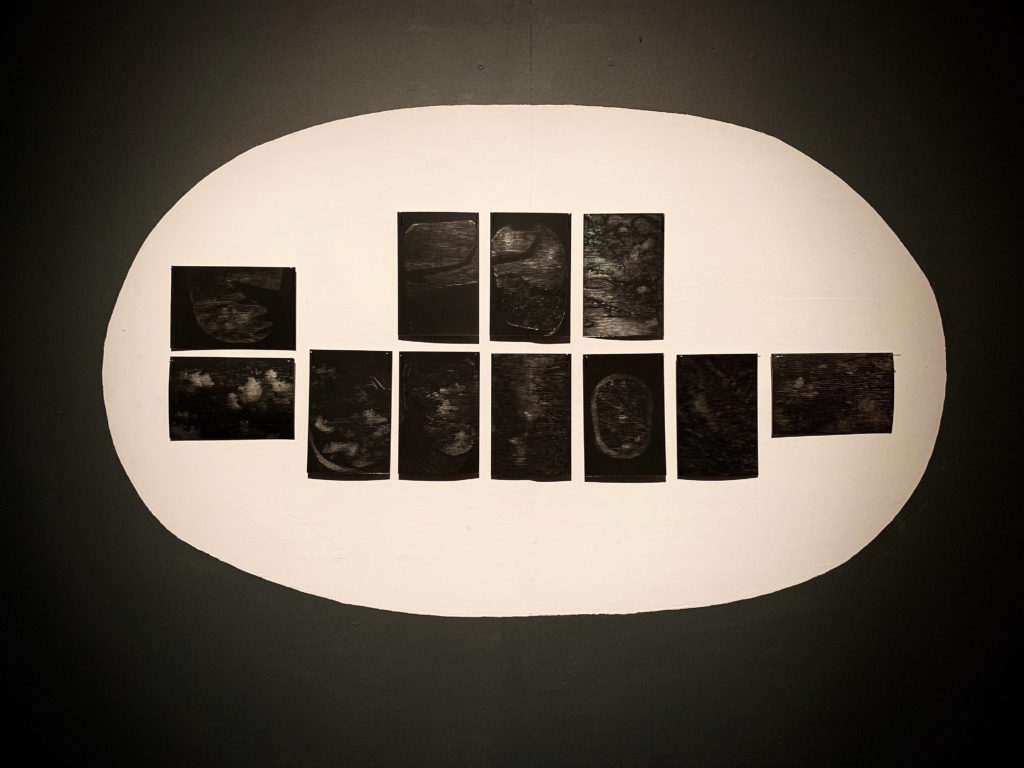
The audio installation is reminiscent of public announcements at airports, a strategy that continues into the foyer with Frequency (2019) by Louise K Wilson. It features intimate anecdotes of air travel through resonance devices on a skylight roof where planes might fly by at any moment. Speaking softly akin to ASMR, one person wonders about the destinations of travellers, while another recalls vivid memories of flights that seem traumatic, bouncing back and forth between excitement and anxiety.
The theme reaches its crescendo inside the gallery, with a mixture of ambient sounds reverberating across the space from Ascending Composition I (For Planes) (2019) by Kate Carr, an atmospheric concoction of incidental noises recorded around Heathrow including birds, markets, and trains on tracks. With pocket-sized media players attached to deconstructed speakers on strings of fabric, the installation documents an intervention that already took place when the work itself flew up on balloons blasting whispers from the ground, a small but meaningful gesture challenging the sonic waves of jumbo jets that dominate the surrounding sky and soundscape.

This act of defiance flows into Skyport (2019) by Magz Hall, a mixed media installation with a set of frequency scanners emitting an unsettling static. The title refers to a pirate radio station based along a Heathrow flightpath in the 1970s, illustrated with archival images and texts from an attempt to reclaim airwaves colonised by traffic control and engine noise. The work emulates this spirit with an LCD screen broadcasting airport channels as visual wavelengths, the contents of which are protected as classified information in UK law, consequently questioning ownership, access, and authority over radio frequencies.
The symphony of sounds become unavoidable throughout, and there is a possibility that it might grow vexing for some, perhaps more so for the people that work here who may not have a choice but to hear it again and again. Yet, as irksome as that might be, it is a crucial part of what makes this show effective. The audible pieces collectively transform the spaces into simulations of airport lounges and peripheral towns, simultaneously mimicking and counteracting oppressive noises from airplanes and terminals that have become inevitable in contemporary life, irrespective of its value and/or harm.
Beyond aural tendencies, the exhibition reaches further by considering scale and movement. The sheer volume of Capsule (2019) by Nick Ferguson is an imposing presence in the gallery with a wooden sculpture modelled after the wheel bay of a Boeing 777, floating a few inches off the ground and hovering over visitors. Shown alongside printed images of microscopic substances found in a real plane, it orchestrates a juxtaposition between the enormity of a flying machine and the imperceptible residue it accumulates, revealing traces from the many places it has been including sand, spores, and bacteria.
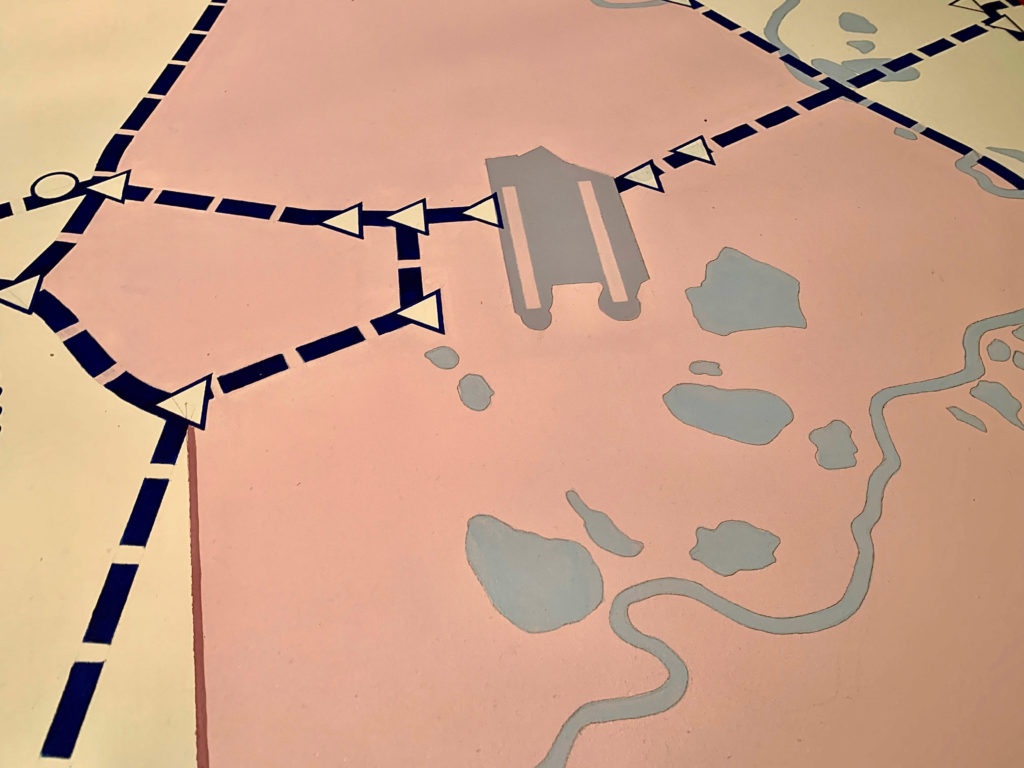
A map nearby, Heathrow (Volumetric Airspace Structures) (2019) by Matthew Flintham, takes the viewer back to west London with a bird’s eye view of the airport complex. Presented on a table that might be used for urban planning, military operation, or board games, it illustrates the topography of the area highlighting a vast infrastructure beneath large sections of controlled airspace, seemingly encroaching on everything else which becomes almost invisible or insignificant.
Navigating the show functions as an exercise of remembrance in many ways, bringing to mind a number of issues that have been at the forefront of public discourse in recent years: from the role of aviation on climate change, to its impact on local communities and ecosystems around airports. And it comes, as if on cue, at a period of heightened environmental concern, propelled most prominently by the Extinction Rebellion movement and climate activist Greta Thunberg, ringing the alarm on the perils of flying.
The controversial Heathrow Airport Expansion also comes through in this context, caught between government plans for future economic growth, and the ongoing resistance from neighbouring residents with campaigns like Stop Heathrow Expansion, No Third Runway Coalition, and Heathrow Association for the Control of Aircraft Noise.
It conjures up conflicting perspectives that unpack a classic dilemma for a society in flux. On one hand, the flight industry is evidently harmful because of its pollution to the planet and the unfair toll on local hosts. Yet, on the other, it is part of a system that facilitates international trade, freedom of movement, and cultural exchanges, each one increasingly more accessible to broader people beyond a privileged few who will always have it. And while it has serious problems that must be addressed, some of which are rightly pointed out here, a world without it entirely is at risk of descent into tribalism and isolationism.
With so much at stake at this particular time and place, the exhibition feels important for its worthwhile attempt in raising these pertinent questions through art, successfully using Heathrow as a case study for matters that undoubtedly have wider implications.
Like the rumble of a plane and many works in this show, the politics of flying will become inescapable as air travel is projected to almost double in size by 2036, despite recent backlash from flight shaming, the rise of staycation, and a spotlight on frequent flyers. The solutions to its unintended consequences are not as straightforward as it might seem, and will likely require a nuanced approach combining systemic changes, paradigm shifts, technological developments, and personal adjustments, all of which cannot come soon enough.
Air Matters: Learning From Heathrow is at Watermans Arts Centre until 5 January 2020. Curated by Nicholas Ferguson in collaboration with Klio Krajewska. Supported by Arts Council England, Forma, London Borough of Hounslow, Kingston School of Art, and Richmond University.
Featured main image: Kate Carr. Image 11. NF. Ascending Composition 1 (For planes). Mixed media, 2019. Included in Air Matters: Learning from Heathrow. 3 October – 5 January 2019.
On June the 16th Tatiana Bazzichelli and Lieke Ploeger presented a new Disruption Network Lab conference entitled “AI TRAPS” to scrutinize Artificial Intelligence and automatic discrimination. The conference touched several topics from biometric surveillance to diversity in data, giving a closer look at how AI and algorithms reinforce prejudices and biases of its human creators and societies, to find solutions and countermeasures.
A focus on facial recognition technologies opened the first panel “THE TRACKED & THE INVISIBLE: From Biometric Surveillance to Diversity in Data Science” discussing how massive sets of images have been used by academic, commercial, defence and intelligence agencies around the world for their research and development. The artist and researcher Adam Harvey addressed this tech as the focal point of an emerging authoritarian logic, based on probabilistic determinations and the assumption that identities are static and reality is made through absolute norms. The artist considered two recent reports about the UK and China showing how this technology is yet unreliable and dangerous. According to data released under the UK´s Freedom of Information Law, 98% of “matches” made by the English Met police using facial recognition were mistakes. Meanwhile, over 200 million cameras are active in China and – although only 15% are supposed to be technically implemented for effective face recognition – Chinese authorities are deploying a new system of this tech to racial profile, track and control the Uighurs Muslim minority.
Big companies like Google and Facebook hold a collection of billions of images, most of which are available inside search engines (63%), on Flickr (25%) and on IMdB (11 %). Biometric companies around the world are implementing facial recognition algorithms on the pictures of common people, collected in unsuspected places like dating-apps and social media, to be used for private profit purposes and governmental mass-surveillance. They end up mostly in China (37%), US (34%), UK (21%) and Australia (4%), as Harvey reported.
Metis Senior Data Scientist Sophie Searcy, technical expert who has also extensively researched on the subject of diversity in tech, contributed to the discussion on such a crucial issue underlying the design and implementation of AI, enforcing the description of a technology that tends to be defective, unable to contextualise and consider the complexity of the reality it interacts with. This generates a lot of false predictions and mistakes. To maximise their results and reduce mistakes tech companies and research institutions that develop algorithms for AI use the Stochastic Gradient Descent (SGD) technique. This enables to pick a few samples selected randomly from a dataset instead of analysing the whole of it for each iteration, saving a considerable amount of time. As Searcy explained during the talk with the panel moderator, Adriana Groh, this technique needs huge amount of data and tech companies are therefore becoming increasingly hungry for them.
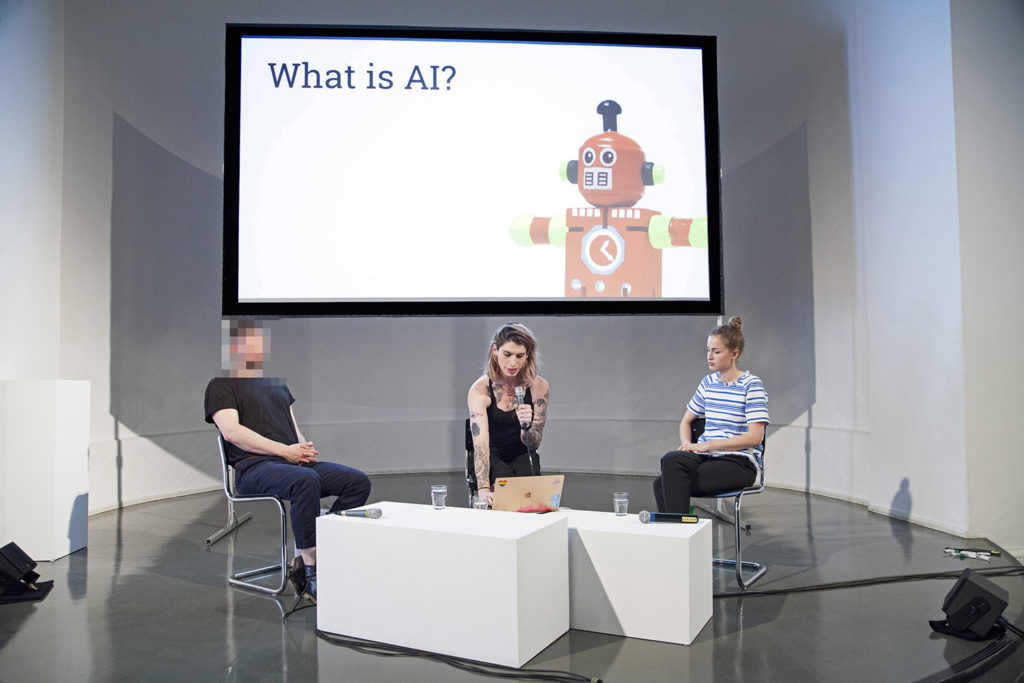
In order to have a closer look at the relation between governments and AI-tech, the researcher and writer Crofton Black presented the study conducted with Cansu Safak at The Bureau of Investigative Journalism on the UK government’s use of big data. They used publicly available data to build a picture of companies, services and projects in the area of AI and machine learning, to map what IT systems the British government has been buying. To do so they interviewed experts and academics, analysed official transparency data and scraped governmental websites. Transparency and accountability over the way in which public money is spent are a requirement for public administrations and they relied on this principle, filing dozens of requests under the Freedom of Information Act to public authorities to get audit trails. Thus they mapped an ecosystem of the corporate nexus between UK public sector and corporate entities. More than 1,800 IT companies, from big ones like BEA System and IBM to small ones within a constellation of start-ups.
As Black explained in the talk with the moderator of the keynote Daniel Eriksson, Transparency International Head of Technology, this investigation faced systemic problems with disclosure from authorities, that do not keep transparent and accessible records. Indeed just 25% of the UK-government departments provided some form of info. Therefore details of the assignments are still unknown, but it is at least possible to list the services those companies deploying AI and machine learning can offer governments: connect data and identify links between people, objects, locations; set up automated alerts in the context of border and immigration control, spotting out changes in data and events of interest; work on passports application programs, implementing the risk-based approaches to passports application assessments; work on identity verification services using smartphones, gathering real time biometric authentications. These are just few examples.
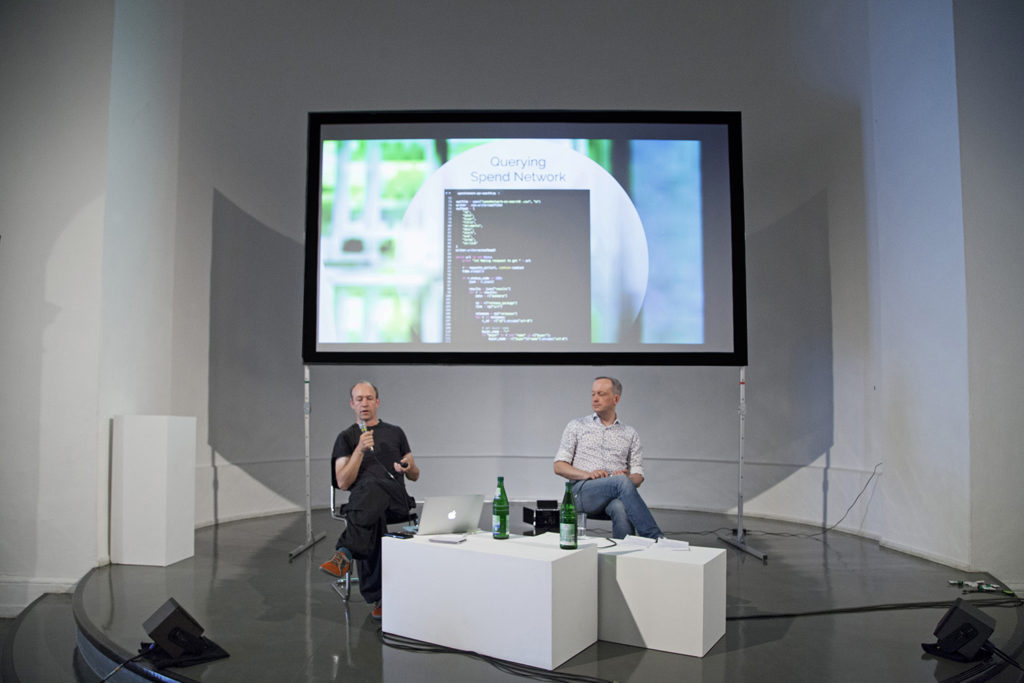
Maya Indira Ganesh opened the panel “AI FOR THE PEOPLE: AI Bias, Ethics & the Common Good” questioning how tech and research have historically been almost always developed and conducted on prejudiced parameters, falsifying results and distorting reality. For instance, data about women’s heart attacks hadn´t been taken in consideration for decades, until doctors and scientists determined that ECG-machines calibrated on the data collected from early ´60s could neither predict heart attacks in women, nor give reliable data for therapeutic purposes, because they were trained only on male population. Just from 2007 ECG-machines were recalibrated on parameters based on data collected from female individuals. It is not possible to calculate the impact this gender inequality had on the development of modern cardiovascular medicine and on the lives of millions of women.
As the issue of algorithmic bias in tech and specifically in AI grows, all big tech firms and research institutions are writing ethics charters and establishing ethics boards sponsoring research in these topics. Detractors often refer to it as ethics-washing, which Ganesh finds a trick to mask ethics and morality as something definable in universal terms or scale: though it cannot be computed by machines, corporations need us to believe that ethics is something measurable. The researcher suggested that in such a way the abstraction and the complexity of the machine get easy to process as ethics becomes the interface used to obfuscate what is going on inside the black box and represent its abstractions. “But these abstractions are us and our way to build relations” she objected.
Ganesh wonders consequently according to what principle it shall be acceptable to train a facial recognition system, basing it on video of transgender people, as it happened in the alarming “Robust transgender face recognition” research, based on data from people undergoing hormone replacement therapy, Youtube videos, diaries and time-lapse documentation of the transition process. The HRT Transgender Dataset used to train AI to recognize transgender people worsens the harassment and the targeting that trans-people already experience daily, targeting and harming them as a group. However, it was partly financed by FBI and US-Army, confirming that law enforcement and national security agencies appear to be very interested in these kinds of datasets and look for private companies and researchers able to provide it.
In this same panel professor of Data Science and Public Policy Slava Jankin reflected on how machine learning can be used for common good in the public sector. As it was objected during the discussion moderated by Nicole Shephard, Researcher on Gender, Technology and Politics of Data, the “common good” isn’t easy to define, and like ethics it is not universally given. It could be identified with those goods that are relevant to guarantee and determine the respect of human rights and their practice. The project that Jankin presented was developed inside the Essex Centre for Data analytics in a synergic effort of developers, researches, universities and local authorities. Together, they tried to build an AI able to predict within reliability where children lacking school readiness are more likely to be found geographically, to support them in their transition and gaining competencies, considering social, economic and environmental conditions.
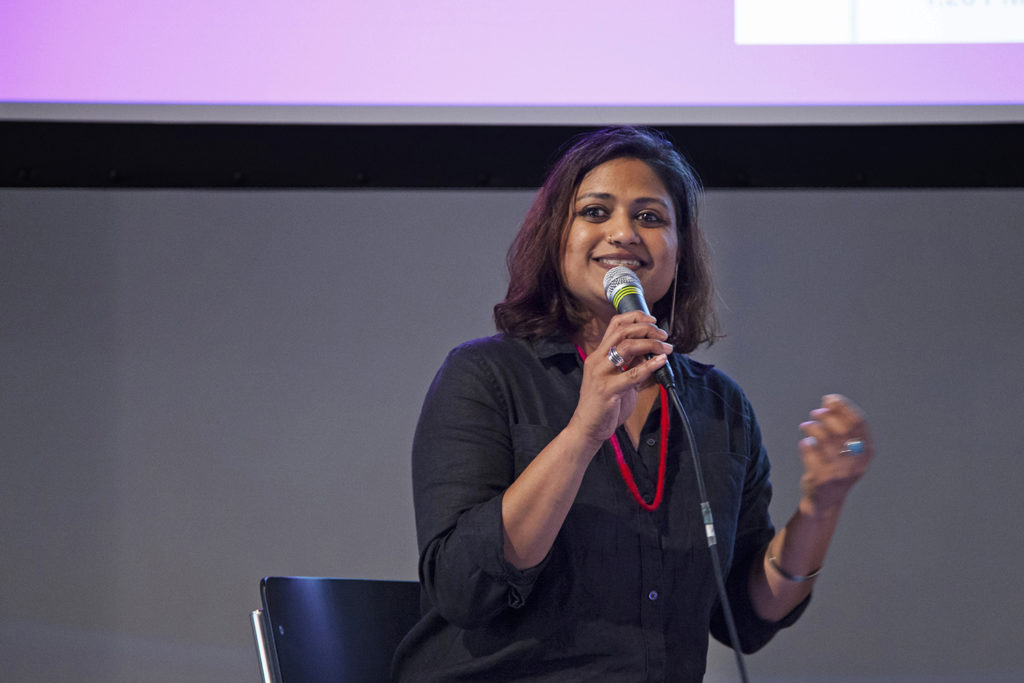
The first keynote of the conference was the researcher and activist Charlotte Webb, who presented her project Feminist Internet in the talk “WHAT IS A FEMINIST AI?”
<<There is not just one possible internet and there is not just one possible feminism, but only possible feminisms and possible internets>>. Starting from this assumption Webb talked about Feminist Human Computer Interaction, a discipline born to improve understandings about how gender identities and relations shape the design and use of interactive technologies. Her Feminist Internet is a no profit organisation funded to make internet a more equal space for women and other marginalized groups. Its approach combines art, design, critical thinking, creative technology development and feminism, seeking to build more responsible and bias-free AI able to empower people considering the causes of marginalization and discrimination. In her words, a feminist AI is not an algorithm and is not a system built to evangelize about a certain political or ideological cause. It is a tool that aims at recognizing differences without minimizing them for the sake of universality, meeting human needs with the awareness of the entire ecosystem in which it sits.
Tech adapts plastically to pre-existing discriminations and gender stereotypes. In a recent UN report, the ‘female’ obsequiousness and the servility expressed by digital assistants like Alexa, the Google Assistant, are defined as example of gender biases coded into tech products, since they are often projected as young women. They are programmed to be submissive and accept abuses. As stated by Feldman (2016) by encouraging consumers to understand the objects that serve them as women, technologists abet the prejudice by which women are considered objects. With her projects, Webb pushes to create alternatives that educate to shift this systemic problem – rather than complying with market demands – first considering that there is a diversity crisis in the AI sector and in the Silicon Valley. Between 2.5 and 4% of Google, Facebook and Microsoft employees are black, whilst there are no public data on transgender workers within these companies. Moreover, as Webb pointed out, just 22% of the people building AI right now are female, only 18% of authors at major AI-conferences are women, whilst over 80% of AI-professors are men. Considering companies with decisive impact on society women comprise only 15% of AI research staff at Facebook and 10% in Google.
Women, people of colour, minorities, LGBTQ and marginalized groups are substantially not deciding about designing and implementing AI and algorithms. They are excluded from the processes of coding and programming. As a result the work of engineers and designers is not inherently neutral and the automated systems that they build reflect their perspectives, preferences, priorities and eventually their bias.

Washington Tech Policy Advisor Mutale Nkonde focused on this issue in her keynote “RACIAL DISCRIMINATION IN THE AGE OF AI.” She opened her dissertation reporting that Google´s facial intelligence team is composed by 893 people, and just one is a black woman, an intern. Questions, answers and predictions in their technological work will always reflect a political and socioeconomic point of view, consciously or unconsciously. A lot of the tech-people confronted with this wide-ranging problem seem to undermine it, showing colour-blindness tendencies about what impacts their tech have on minorities and specifically black people. Historically credit scores are correlated with racist segregated neighbourhoods and risk analyses and predictive policing data are corrupted by racist prejudice, leading to biased data collection reinforcing privileges. Without a conscious effort to address racism in technology, new technologies will replicate old divisions and conflicts. By instituting policies like facial recognition we just replicate rooted behaviours based on racial lines and gender stereotypes mediated by algorithms. Nkonde warns that civil liberties need an update for the era of AI, advancing racial literacy in Tech.
In a talk with the moderator, the writer Rhianna Ilube, the keynote Nkonde recalled that in New York´s poor and black neighbourhood with historically high crime and violence rates, Brownsville, a private landlord in social housing wanted to exchange keys for facial recognition software, so that either people accept surveillance, or they lose their homes. The finding echoes wider concerns about the lack of awareness of racism. Nkonde thinks that white people must be able to cope with the inconvenience of talking about race, with the countervailing pressures and their lack of cultural preparation, or simply the risk to get it wrong. Acting ethically isn´t easy if you do not work on it and many big tech companies just like to crow about their diversity and inclusion efforts, disclosing diversity goals and offering courses that reduce bias. However, there is a high level of racial discrimination in tech sector and specifically in the Silicon Valley, at best colour-blindness – said Nkonde – since many believe that racial classification does not limit a person’s opportunities within the society, ignoring that there are instead economic and social obstacles that prevent full individual development and participation, limiting freedom and equality, excluding marginalized and disadvantaged groups from the political, economic, and social organization. Nkonde concluded her keynote stressing that we need to empower minorities, providing tools that allow overcoming autonomously socio-economic obstacles, to fully participate in society. It is about sharing power, taking in consideration the unconscious biases of people, for example starting from those designing the technology.
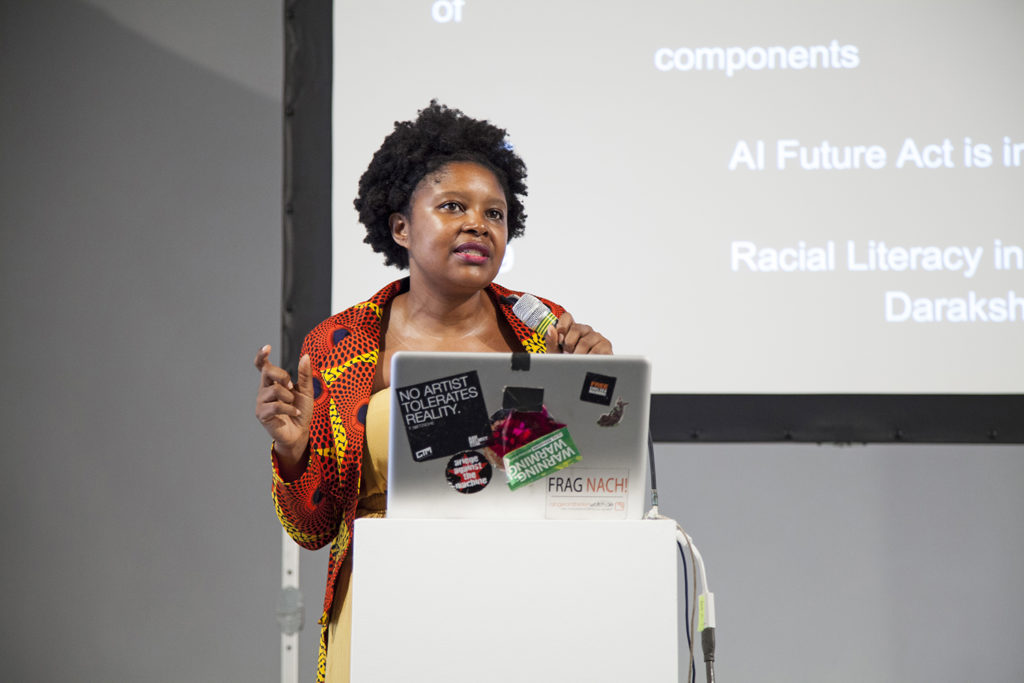
The closing panel “ON THE POLITICS OF AI: Fighting Injustice & Automatic Supremacism” discussed the effect of a tool shown to be not neutral, but just the product of the prevailing social economical model.
Dia Kayyali, Leader of the Tech and Advocacy program at WITNESS, described how AI is facilitating white supremacy, nationalism, racism and transphobia, recalling the dramatic case of the Rohingya persecution in Myanmar and the oppressive Chinese social score and surveillance systems. Pointing out critical aspects the researcher reported the case of the Youtube anti-extremism-algorithm, which removed thousands of videos documenting atrocities in Syria in an effort to purge hate speech and propaganda from its platform. The algorithm was trained to automatically flag and eliminate content that potentially breached its guidelines and ended up cancelling documents relevant to prosecute war crimes. Once again, the absence of the ability to contextualize leads to severe risks in the way machines operate and make decisions. Likewise, applying general parameters without considering specificities and the complex concept of identity, Facebook imposed in 2015 new policies and arbitrarily exposed drag queens, trans people and other users at risk, who were not using their legal names for safety and privacy reasons, including domestic violence and stalking.
Researcher on gender, tech and (counter) power Os Keyes considered that AI is not the problem, but the symptom. The problem are the structures creating AI. We live in an environment where few highly wealthy people and companies are ruling all. We have bias in AI and tech because their development is driven by exactly those same individuals. To fix AI we have to change requirements and expectations around it; we can fight to have AI based on explainability and transparency, but eventually if we strive to fix AI and do not look at the wider picture, in 10 years the same debate over another technology will arise. Keyes considered that since its very beginning AI-tech was discriminatory, racialized and gendered, because society is capitalist, racist, homo-transphobic and misogynistic. The question to pose is how we start building spaces that are prefigurative and constructed on values that we want a wider society to embrace.
As the funder and curator of the Disruption Network Lab Tatiana Bazzichelli pointed out during the moderation of this panel, the problem of bias in algorithms is related to several major “bias traps” that algorithm-based prediction systems fail to win. The fact that AI is political – not just because of the question of what is to be done with it, but because of the political tendencies of the technology itself – is the real aspect to discuss.
In his analysis of the political effects of AI, Dan McQuillan, Lecturer in Creative and Social Computing from the London University, underlined that while the reform of AI is endlessly discussed, there seems to be no attempt to seriously question whether we should be using it at all. We need to think collectively about ways out, learning from and with each other rather than relying on machine learning. Countering thoughtlessness of AI with practices of solidarity, self-management and collective care is what he suggests because bringing the perspective of marginalised groups at the core of AI practice, it is possible to build a new society within the old, based on social autonomy.
What McQuillan calls the AI realism appears to be close to the far-right perspective, as it trivialises complexity and naturalises inequalities. The character of learning through AI implicates indeed reductive simplifications, and simplifying social problems to matters of exclusion is the politics of populist and Fascist right. McQuillan suggests taking some guidance from the feminist and decolonial technology studies that have cast doubt on our ideas about objectivity and neutrality. An antifascist AI, he explains, shall involve some kinds of people’s councils, to put the perspective of marginalised groups at the core of AI practice and to transform machine learning into a form of critical pedagogy.
Pic 7: Dia Kayyali, Os Keyes, Dan McQuillan and Tatiana Bazzichelli during the panel “ON THE POLITICS OF AI: Fighting Injustice & Automatic Supremacism”
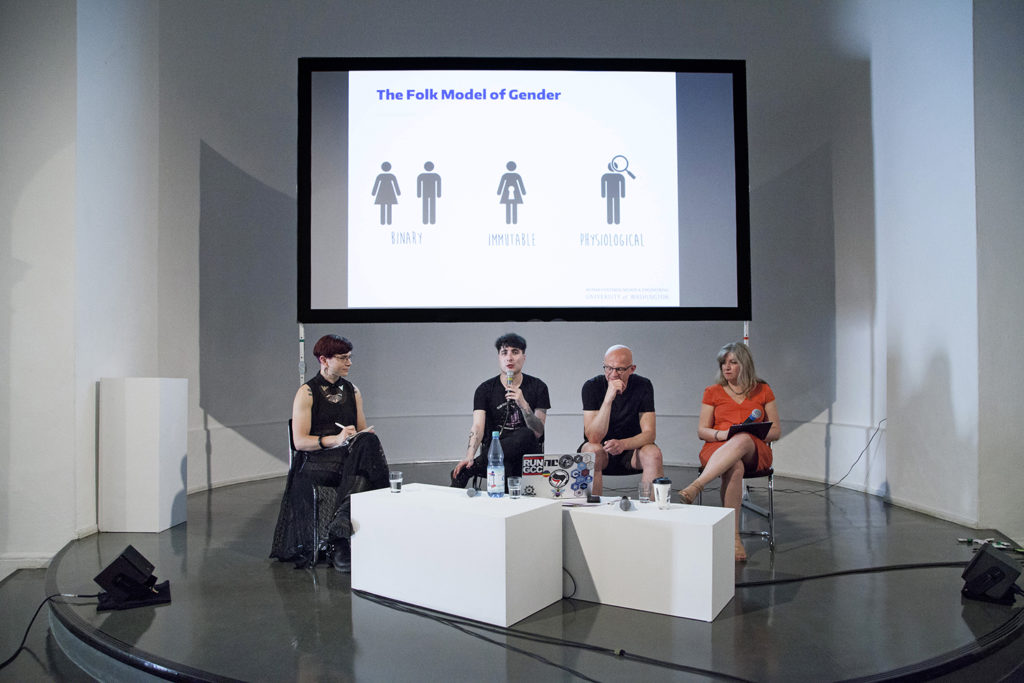
We see increasing investment on AI, machine learning and robots. Automated decision-making informed by algorithms is already a predominant reality, whose range of applications has broadened to almost all aspects of life. Current ethical debates about the consequences of automation focus on the rights of individuals and marginalized groups. However, algorithmic processes generate a collective impact too, that can only be addressed partially at the level of individual rights, as it is the result of a collective cultural legacy. A society that is soaked in racial and sexual discriminations will replicate them inside technology.
Moreover, when referring to surveillance technology and face recognition software, existing ethical and legal criteria appear to be ineffective and a lack of standards around their use and sharing just benefit its intrusive and discriminatory nature.
Whilst building alternatives we need to consider inclusion and diversity: If more brown and black people would be involved in the building and making of these systems, there would be less bias. But this is not enough. Automated systems are mostly trying to identify and predict risk, and risk is defined according to cultural parameters that reflect the historical, social and political milieu, to give answers able to fit a certain point of view and make decisions. What we are and where we are as a collective, what we have achieved and what we still lack culturally is what is put in software to make those same decisions in the future. In such a context a diverse team within a discriminatory conflictual society might find ways to flash the problem of bias away, but it will get somewhere else.
The truth is that automated discrimination, racism and sexism are integrated in tech-infrastructures. New generation of start-ups are fulfilling authoritarian needs, commercialising AI-technologies, automating biases based on skin colour and ethnicity, sexual orientation and identity. They develop censored search engine and platforms for authoritarian governments and dictators, refine high-tech military weapons training them using facial recognition on millions of people without their knowledge. Governments and corporations are developing technology in ways that threaten civil liberties and human rights. It is not hard to imagine the impact of the implementation of tools for robotic gender recognition, within countries were non-white, non-male and non-binary individuals are discriminated. Bathrooms and changing rooms that open just by AI gender-detection, or cars that start the engine just if a man is driving, are to be expected. Those not gender conforming, who do not fit traditional gender structures, will end up being systematically blocked and discriminated.
Open source, transparency and diversity alone will not defeat colour-blinded attitudes, reactionary backlashes, monopolies, other-directed homologation and cultural oppression by design. As it was discussed in the conference, using algorithms to label people based on sexual identity or ethnicity has become easy and common. If you build a technology able to catalogue people by ethnicity or sexual identity, someone will exploit it to repress genders or ethnicities, China shows.
In this sense, no better facial recognition is possible, no mass-surveillance tech is safe and attempts at building good tech will continue to fail. To tackle bias, discrimination and harm in AI we have to integrate research on and development of technology with all of the humanities and social sciences, deciding to consciously create a society where everybody could participate to the organisation of our common future.
Curated by Tatiana Bazzichelli and developed in cooperation with Transparency International, this Disruption Network Lab-conference was the second of the 2019 series The Art of Exposing Injustice.
More info, all its speakers and thematic could be found here: https://www.disruptionlab.org/ai-traps
The videos of the conference are on Youtube and the Disruption Network Lab is also on Twitter and Facebook.
To follow the Disruption Network Lab sign up for its Newsletter and get informed about its conferences, ongoing researches and projects. The next Disruption Network Lab event “Citizen of evidence” is planned for September 20-21 in Kunstquartier Bethanien Berlin. Make sure you don´t miss it!
Photocredits: Maria Silvano for Disruption Network Lab
The leaking of the Panama Papers in 2015 (and later the Bahamas and the Paradise Papers), have exposed the extent to which part of the richest world elite has a consolidated habit of avoiding paying taxes. The leaks from the Panamanian global law firm Mossack-Fonseca have uncovered the illegal assets and murky fiscal dealings of hundreds of powerful individuals and corporations, providing detailed information on their bank accounts and shell companies.
Two years after the release of the Panama Papers, the 15th conference of the Disruption Network Lab “DARK HAVENS: Confronting Hidden Money and Power” was held in Berlin Kunstquartier Bethanien, by Disruption Network Lab Berlin, April 5-6 2019. It brought together the researchers and individuals who were part of global investigations, taking severe personal risks to expose the hidden money and power structures. This time, the Disruption Network has focused on the issues of secrecy, financial corruption and tax havens to identify informational, political, technological and artistic countermeasures to such topics.
Tax evasion is a colossal and complicated issue. Several unexpected countries that offer comparatively low corporate tax-rates and protect bank secrecy can indeed be included within a broader definition for tax haven. Many receive information for abroad assets and income but do not share with outside authorities information about what happens domestically, to such an extent that the Caymans and Bahamas are somehow far less permissive than states such as Delaware and Nevada in the US, where shell companies are very easy to open and bank secrecy is essential.
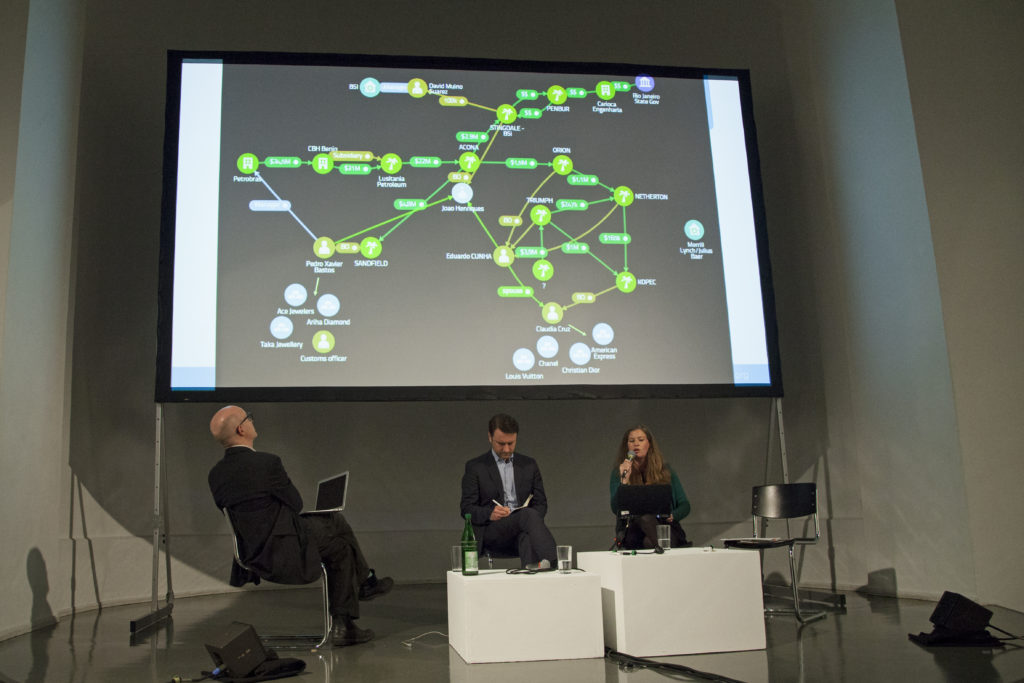
Author and researcher Nicholas Shaxson opened the conference by describing an articulated system that contributes to global inequalities and shifts of wealth from poor to rich. Transparency Internationals Senior Policy Advisor Maìra Martini described the role of banks in cross-border corruption cases, presenting schemes connecting shell companies, multiple offshore bank accounts and money laundering. The panel moderated by Simon Shuster discussed why, despite the global outrage caused by the Papers, the practice of billionaires and corporations stashing their cash in tax havens is still common.
Mossack-Fonseca was indeed just one of the many providers in the off-shore industry of Panama. And Panama is just one of the many tax havens, where complacent governments guarantee international investors that they will neither regulate nor prosecute their conducts, nor share information about their activities.
EU Institutions turn a blind eye to billions of euro’s worth of wealth that disappear not always out of sight of local tax authorities across Europe. The MEPs recently stated that seven member states (Belgium, Cyprus, Hungary, Ireland, Luxembourg, Malta and the Netherlands) “display traits of a tax haven and facilitate aggressive tax planning”. Obviously, tax avoidance is not related just to exotic illegal corporate offshore activities.
The leaks confirmed that several British satellite havens (E.g. Virgin Islands, Cayman, and the Channel Islands) and the City of London are closely linked through commercial and legal ties, with high chances for dark money to flow through the UK’s overseas territories and crown dependencies undetected. As many participants to the conference pointed out, Brexit can just worsen this situation.
The political and economic ramifications of the leeks suggest that such a system is hard to disrupt, since it guarantees the very rich and powerful elite of the world will withhold power. 50% of the wealth held in tax havens belongs to households with more than USD 50 million in net wealth: just ultra-high-net-worth individuals can afford activities in said tax havens as they carry very high fees, although the fees are substantially less than paying taxes owed.
Reporters Ryan Gallagher and Friedrich Lindenberg from the Organized Crime and Corruption Reporting Project (OCCRP) discussed the ethics of massive data leaks, security and secrecy in juxtaposition to openness and transparency, as well as source protection and collective mobilization in the analysis of the material.
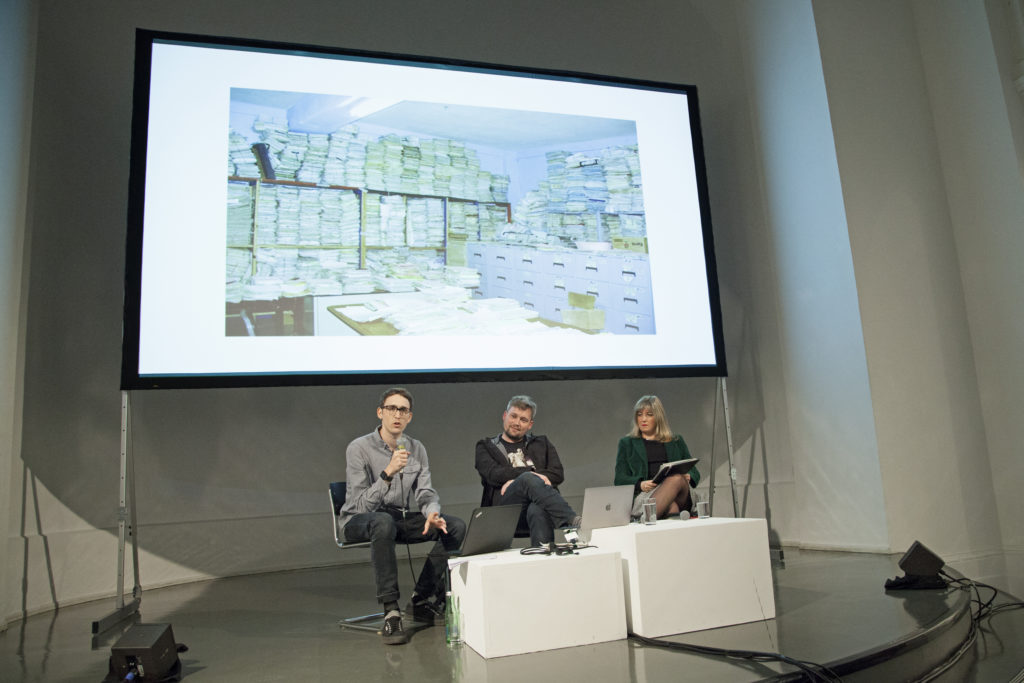
Considering the amount of leaked data (16.8 million financial confidential electronic documents about offshore investments in three years), a collective mobilization is necessary to analyse them all and uncover injustices. By these means people can force companies and privates to end their systematic tax evasion that lies at the heart of the global economic system.
How can we then try to find a road in there? It is important to share information, also creatively, with tools like “The Offshore Tour Operator” a GPS prototype presented during the conference, that guides the walk of the user through the database of the Panama Papers, in search of the physical traces of the offshore banking within the city landscape. A group of twenty people could actually see the tool in action, guided throughout Berlin by two members of RYBN.ORG, the Paris-based collective founded in 1999 that created this project.
Projects and online platforms like this could be part of the solution. They are open to individuals, tax experts and reporters too, not just law enforcement officials and activists and we all shall enhance access and participation.
In 2018, the net wealth of 26 billionaires was the same as the poorest 3.8 billion people of the world (Oxfam). An extreme disparity-rate accelerating year by year, that considers just official capitals and investments, whilst there is a whole universe of dark money stored in tax havens impossible to calculate. The impact of such a private corruption affects public fundamental services like hospitals and schools and is devastating. It’s an inequality comparable to that of Versailles before the French Revolution, as the documentary “Panama Papers,” that had its German Premiere during the Disruption Network Lab conference suggests.
The documentary shows how millions of files were leaked by anonymous whistle-blower John Doe to journalists of the Süddeutsche Zeitung, Frederik Obermaier and Bastian Obermayer, who shared them with the Washington-based International Consortium of Investigative Journalists (ICIJ) and coordinated a worldwide investigation, setting up an incredible enterprise.
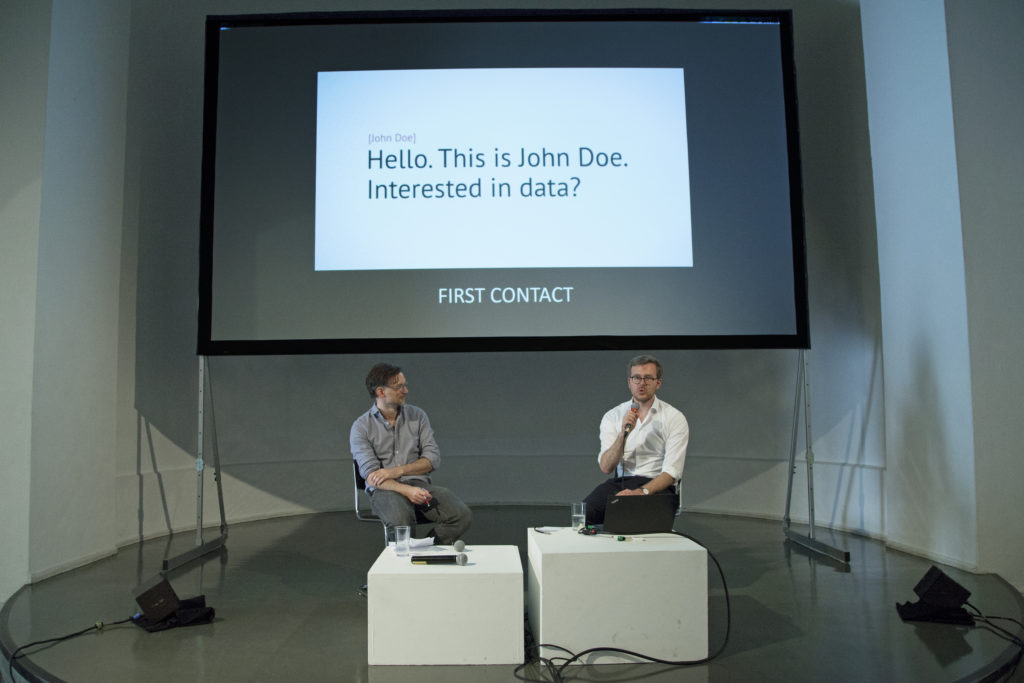
Obermaier described his choice of opening the information to other colleagues as the only possible way of analysing the information, considering that a single person would need 32 years to get through 1.4 Terabyte of leaked data. The efforts of 376 journalists from 76 countries working in secret for two years until the simultaneous publication in April 2016, was awarded with the Pulitzer Prize.
Following the Papers release more than thousands official investigations started and dozens criminal cases have been initiated. Such an activity has brought more than USD 1.2 billion back onshore as governments around the world have recouped money in fines and back taxes (UK 253 million, Germany 150 million). Participation works!
However, whistleblowers and investigative journalists working on tax avoidance and international frauds are criminalised and killed. Obermaier reported that 17% of the countries involved in the Papers has seen backlash against journalists who covered the investigation, instead of offering them effective legal protections.
To reverse this trend, the conference focused on the personal impact of investigative journalism and whistleblowing for those who expose offshore corruption and tax havens. The stories of women suffering the consequences of their anti-corruption activities were presented in a panel moderated by Michael Hornsby, communications officer at Transparency International.
The video “Daphne Caruana Galizia. Anti-Corruption Award Winner 2018” directed by David Velduque, opened the discussion with an interview of Paul Caruana Galizia, son of Daphne, talking about the journalist from Malta assassinated in 2017 after she uncovered a thread of hidden connections linking major multinational deals and global money-laundering operations to the heart of Malta’s government.
Exposing injustice caused consequences to the Turkish journalist Pelin Ünker, who – as she narrated – was sentenced to 13 months for writing about the dodgy dealings of the former Turkish prime minister Binali Yildirim and his sons who were found to be stashing cash in a Maltese shell company (Update: one month after the conference, on the 6th of May, Pelin Ünker’s prison sentence was overturned by an appeal court, although she still has to pay a fine).
The experience of Stéphanie Gibaud, a whistleblower from France, who revealed tax evasion and fraud by the investment bank UBS, and Khadija Ismayilova, Azerbaijani investigative journalist and radio host well known for her reports on corruption in Azerbaijan, completed the panel. Due to a a travel ban, this last one could just take part to the Disruption Network Lab-conference with a video, by which she described her case made of trumped up accusations, imprisonment, 3.5 years in probation and a 2-year ban on professional activity. As she narrated, she has been spied and blackmailed by her Government for years, and she is still not free.
The importance of collaborative networks of investigative journalists was something that all those taking part in the conference mentioned. Thanks to organisations like OCCRP, that connects 45 non-profit investigative centers in 34 countries, journalists and activists con work together to turn the tables on corruption and build greater accountability through exposing the abuse of power at the expense of the people.
Transparency could be articulated on open platforms for data sharing and technological tools able to ensure access to relevant information, control and participation, fostering accountability. Documents are still available and the still have a lot to say: a collective mobilization could support the work of investigative journalists and oblige authorities to act.
Estimates report that offshore financial wealth is worth USD 7.6 trillion, the 8% of global household financial wealth (Zucman, 2015) others indicate though that super-rich might hold up to USD 32 trillion in offshore havens, excluding non-financial assets as real estate, gold and other undetectable investments (Henry, 2016). Our economic systems are hostage of these numbers. Banks hold massive amounts of loans in tax-haven-based businesses, a small economic elite makes and escapes rules, undermining democracies via financial deregulations, feeding social injustice.
Financial secrecy is a key facilitator of money laundering, corruption and financial crimes. For too long it’s been clear that corporations simply shift profits to places where taxes are low, whilst ultrawealthy households hide dark money in a handful of tax shelters to avoid paying their fair share. What is then the opportunity connected with the preservation of bank secrecy, considering that it just increases inequalities and violations of human and social rights?
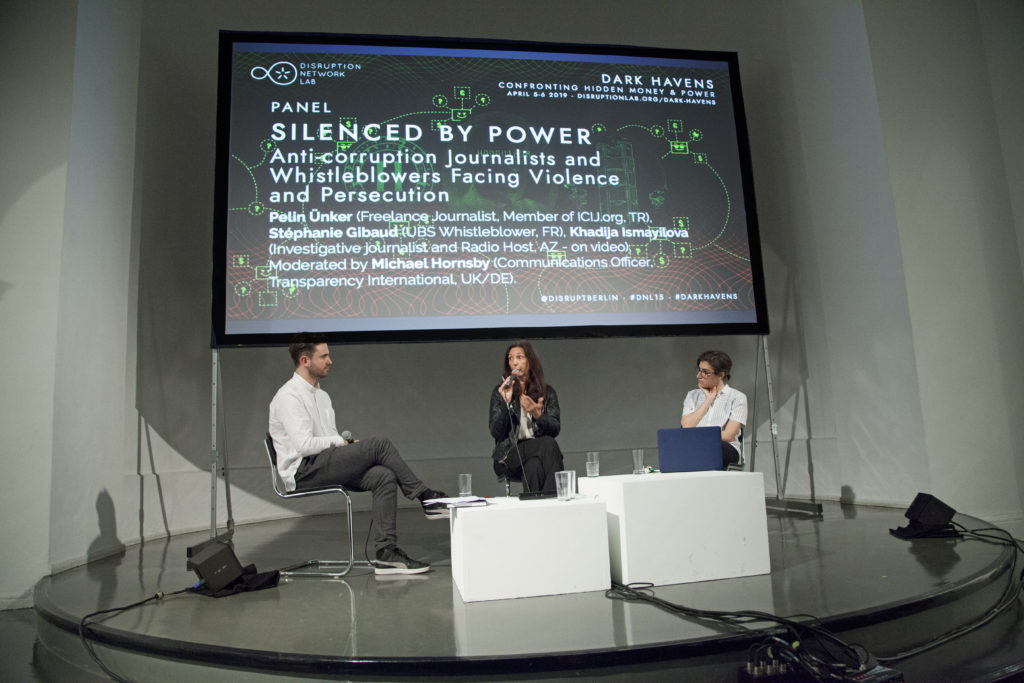
Curated by Tatiana Bazzichelli and developed in cooperation with the Berlin-based International Secretariat of Transparency International, this Disruption Network Lab-conference was the first of the 2019 series “The Art of Exposing Injustice”.
Info about the 15th Disruption Network Lab conference, all its speakers and thematic is available here: https://www.disruptionlab.org/dark-havens
The videos of the conference are on Youtube.
To follow the Disruption Network Lab sign up for its Newsletter and get informed about its conferences, ongoing researches and projects. The next Disruption Network Lab event is planned for June. Make sure you don´t miss it!
The Disruption Network Lab is also on Twitter and Facebook.
Photocredits: Maria Silvano for Disruption Network Lab
In 2019 we celebrate the 150th anniversary of Finsbury Park, and we time travel through its past and future with the launch of our Citizen Sci-fi programme and methodology. Dominant sci-fi franchises of our time, from Black Mirror to Westworld, have captured popular attention by showing us their apocalyptic visions of futures made desperate by systems of dominance and despair.
What is African-American author, Octavia E. Butler’s prescription for despair? Sci-fi and persistence. Sci-fi as a tool for getting us off the beaten-track and onto more fertile ground, and persistent striving for more just societies.The 2015 book Octavia’s Brood honoured her work, with an anthology of sci-fi writings from US social justice movements and this inspired us to try a new artistic response to the histories and possible futures of Finsbury Park.
Furtherfield’s Citizen Sci-Fi methodology combines citizen science and citizen journalism by crowdsourcing the imagination of local park users and community groups to create new visions and models of stewardship for public, urban green space. By connecting these with international communities of artists, techies and thinkers we are co-curating labs, workshops, exhibitions and Summer Fairs as a way to grow a new breed of shared culture.
Each artwork in the forthcoming exhibition invites audience participation – either in it’s creation or in the development of a parallel ‘people’s’ work – turning every idea into a portal to countless more thoughts and visions of the past and future of urban green spaces and beyond.
So where do we start? Last year we invited artists, academics and technologists to join us in forming a rebel alliance to fight for our futures across territories of political, cultural and environmental injustice. This year both our editorial and our exhibition programme are inspired by this alliance and the discoveries we are making together.
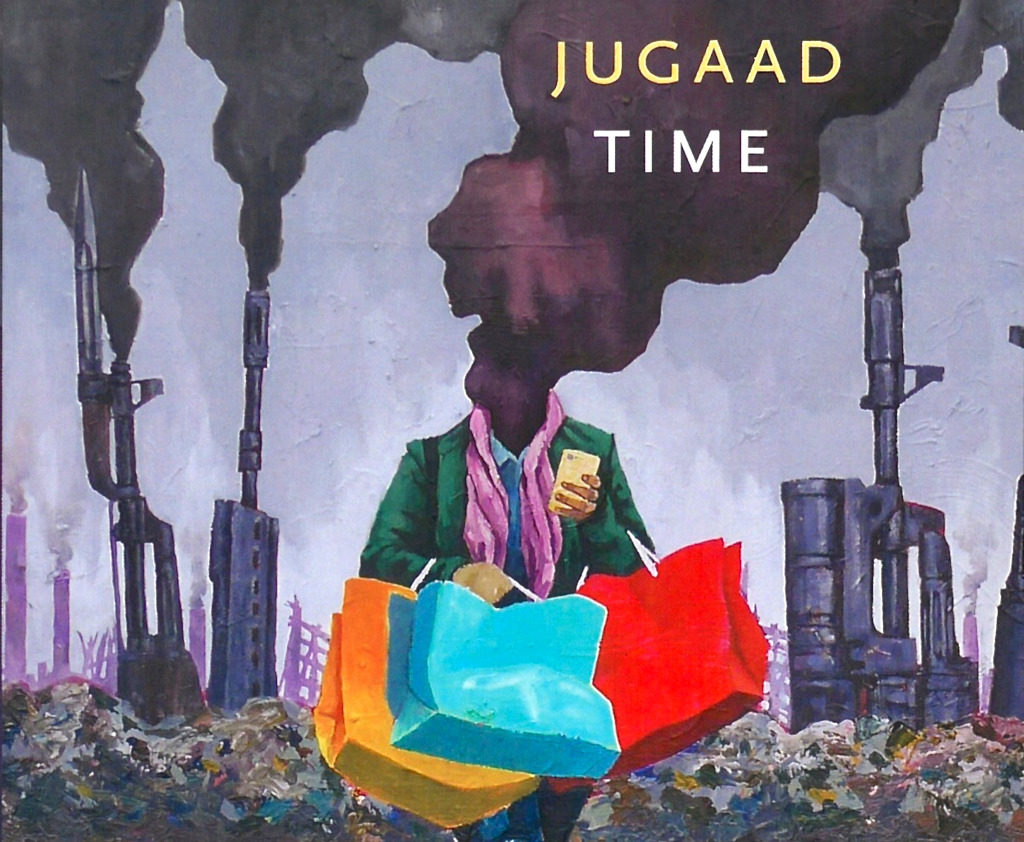
To kick off this year’s Time Portals programme at Furtherfield, in April we will host the launch and discussion around Jugaad Time, Amit Rai’s forthcoming book. This reflects on the postcolonial politics of what in India is called ‘jugaad’, or ‘work around’ and its disruption of the neoliberal capture of this subaltern practice as ‘frugal innovation’. Paul March-Russell’s essay Sci-Fi and Social Justice: An Overview delves into the radical roots and implications of Mary Shelley’s Frankenstein (1818). This is a topic close to our hearts given our own recent exhibitions Monsters of the Machine and Children of Prometheus, inspired by the same book. Meanwhile we’ve been hosting workshops with local residents exploring our visions for Finsbury Park 150 years into the future. To get a flavour of these activities Matt Watkins’ has produced an account of his experience of the Futurescapes workshop at Furtherfield Commons in December 2018.
In May we will open the Time Portals exhibition which features several new commissions. These include Circle of Blackness by Elsa James. Through local historical research James will devise a composite character to embody the story of a black woman from the locality 150 years ago and 150 years in the future. James will perform a monologue that will be recorded and produced by hybrid reality technologist Carl Smith and broadcast as a hologram inside the Furtherfield Gallery throughout the summer. While Futures Machine by Rachel Jacobs is an Interactive machine designed and built through public workshops to respond to environmental change – recording the past and making predictions for the future while inspiring new rituals for our troubled times. Once built, the machine occupies Furtherfield Gallery, inviting visitors to play with it.
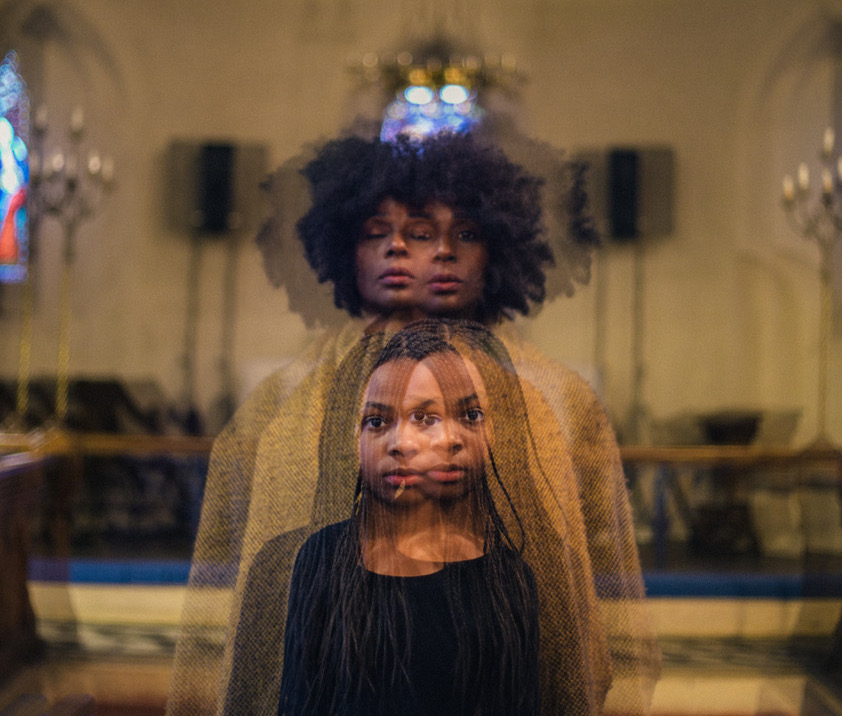
Time Portals opens on May 9th (2019) with other time traveling works by Thomson and Craighead, Anna Dumitriu and Alex May, Antonio Roberts and Studio Hyte. Visitors will be invited to participate in an act of radical imagination, responding with images, texts and actions that engage circular time, long time, linear time and lateral time in space towards a collective vision of Finsbury Park in 2169.
From April onwards, a world of activities, workshops with local families and their enriching noises, reviews, interviews and an array of experiences will unfold. Together we dismiss the dystopian nightmares and invite communities to join us in one of London’s first “People’s Parks” to revisit and recreate the future on our own terms together.
Marc Garrett will be interviewing Elsa James, about her artwork Circle of Blackness, and Amit Rai about his book Jugaad Time. Both will soon be featured on the Furtherfield web site.
“À la recherche de l’information perdue” was a performance that Cornelia Sollfrank contributed to the ‘Post-Cyber Feminist International’ event at the Institute of Contemporary Arts in London.1 The event in November 2017 marked the twentieth anniversary of the First Cyberfeminist International (documenta X, Kassel, Germany, 1997) organized by the Old Boys Network, paying homage to its productive format and legacy. In her own words, Sollfrank set out to offer an “one-hour lecture performance that makes a (techno-)feminist comment on the entanglements of gender, technology and information politics,” with the rationale that “with the technological landscape vastly changed since the first Cyberfeminist International, we are living in a time well beyond the imagined future of the early cyberfeminists. Expanding upon this particular genealogy, this convening purposefully constellates thinkers to consider a new vision for “post-cyberfeminism” that is substantive and developed, without being exclusionary of contestation.”
I was surprised at the invitation of the charismatic woman I came to know as “Coco” to attend her performance. My surprise, which I bet is going to surprise Coco in turn, was due to two reasons. I had published two academic papers on WikiLeaks (2012, 2014 with Robinson), later included in a monograph charting on digital activism from 1994-2014 (2015), and at the time I was working on another paper on ‘Leaktivism and its Discontents’ examining the DCLeaks, CIA Vault7Leaks and DNCLeaks (2018). Although I took a critical view of the ideological and organizational conflicts within WikiLeaks as an organization internally, and examined the impact of that organization externally on academic debates in three disciplines between 2010-2012, and followed the leaks religiously in my scholarship, I had not written or commented on the rape allegations against Julian Assange.2 The related legal requirements, however, were what forced him to be stranded in the Ecuadorian Embassy from the 12th of June 2012 to the time of writing in 2018, in the first place. On March 6th, 2016, I was one of the signatories urging Swedish and UK Permanent Representatives to the United Nations in Geneva, to respect the United Nations’ decision to free Julian Assange. Moreover, as my work almost in its entirety has not focused on gender aspects of technology, or gender studies (apart from say examining ethno-patriarchal racist ideologies in anti-migrant discourses on digital networks in 2010-2013 for the Project, see et al. 2018),3 I felt rather intrigued by the invitation to the event, and its technofeminist context and agenda. If Coco was brave enough to invite me to watch her performance and trust me to comment on it, considering both my research (see references), and critical but supportive stance to Julian Assange’s quest for freedom, then I had to also be brave enough to take up the challenge!
As academics we are encouraged not to write in the first person. In fact, “do not use the first person in your scholarship” is served up in higher education establishments around the world, bar in certain sub-disciplines who take a certain pride in reflecting on the situated knower and their reflective positionality. In my own scholarship, I have used the first person sparingly. Here, in this text however, I feel obliged to do so, as I watched an artist perform and I would like to convey the thoughts aroused in the internal empire; and also understand whether and if so, how it has transformed me. After all, that is what art is for, right?
Sollfrank’s performance consists of her reading a text, overlaid by electronic sounds, and the projection of changing images behind her. There are nine images: orange font capital letters on a black and white pixel background: INFORMATION, ORGANISATION, ZEROS+ONES, BINARY WORLDS, PURE DIFFERENCE, CYBERFEMINISM, GENDER+TECHNOLOGY, NAKED INFORMATION, TRANPARENCY. The first image background is a very close zoom in to a black-and-white image and each image background zooms out to the final one. Only the last two images reveal the subject of the image: the photograph of the ripped condom used by Julian Assange during sexual intercourse with one of the women that subsequently accused him of rape, table by the Swedish police and published in their report. This was the final image of her lecture below.
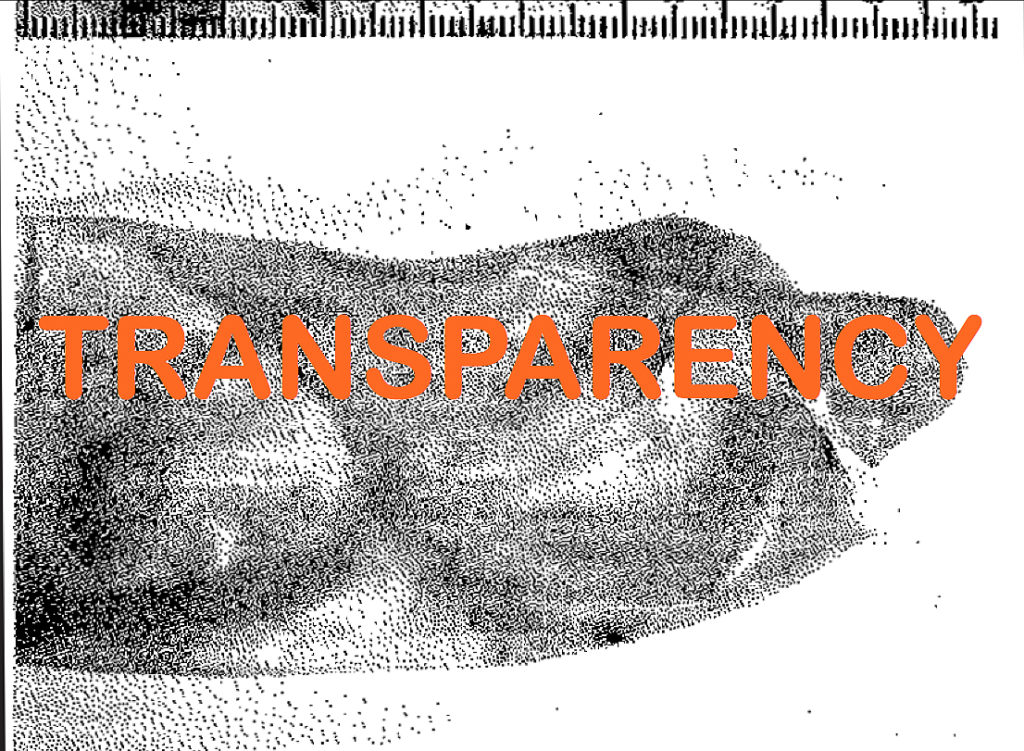
The structure of the lecture is an assemblage really of separate elements she uses to launch her critique. In introducing her performance, she asks:
“On the road to freedom, one has to make sacrifices; but what remains when the way gets swampy and forks into affective structures? Rape can be performed in many ways.
So, what is missing? What are we looking for?
Has it been lost at all? Maybe it just multiplied, and stayed a much as it has gone away? Who knows?
We all create reality collectively and long ago have become zombies of transparency.”
Here, already I am baffled by the sentence “Rape can be performed in many ways.” I hadn’t thought about the “performativity” of rape. I make a mental note of this. Who “performs” during a rape? Can you perform before, during, or after a rape? What are the “many ways” a rape can be performed? This thought grabs me immediately at the start of her performance. But I relieve myself of it, thinking I got to be self-policing: this is the kind of thought that gets you into hot water: she must mean either literally the various categories of rape in Sweden, or this is some kind of allegory on reactive affect, discursive violence, a form of sexual misconduct, or again literally the case of broken trust found in a broken condom? I don’t have time to think, as Sollfrank swiftly moves on to the first section “INFORMATION,” where she talks about theoretical approaches to information: structure, knowledge, signal, message, meaning, process. In the sentence,“Julian Assange is accused of rape,” the information is coded in words and letters, the meaning of that structure is conveyed and at the pragmatic level, the receiver finds value in that information depending on whether he/she is interested in this person, his organization, what he represents, subjectively decoding this information to create meaning. The next piece of the puzzle is, of course, “ORGANISATION.” Sollfrank quotes the WikiLeaks organisation mantra: “One of our most important activities is to publish original source material alongside our news stories so readers and historians alike can see evidence of the truth.” Assange faced criticism for his centralised style of leadership in the organisation, which caused people to leave it. And obviously his political aims are somewhat inconclusive. Here, in this part of the lecture, I recognise my own writing, when Sollfrank says: “Maybe, the man and his organisation are an empty signifier, filled ideologically to reflect the discursive mood of anyone.” I had made that argument in ‘WikiLeaks Affects’ (2012), analyzing the diverse actors who supported Assange and the public feelings of him as a traitor or hero, the overflow of affective structures and the acceleration offered by digital networks (digital materialisation of the revolutionary virtual that may or not happen in the real).
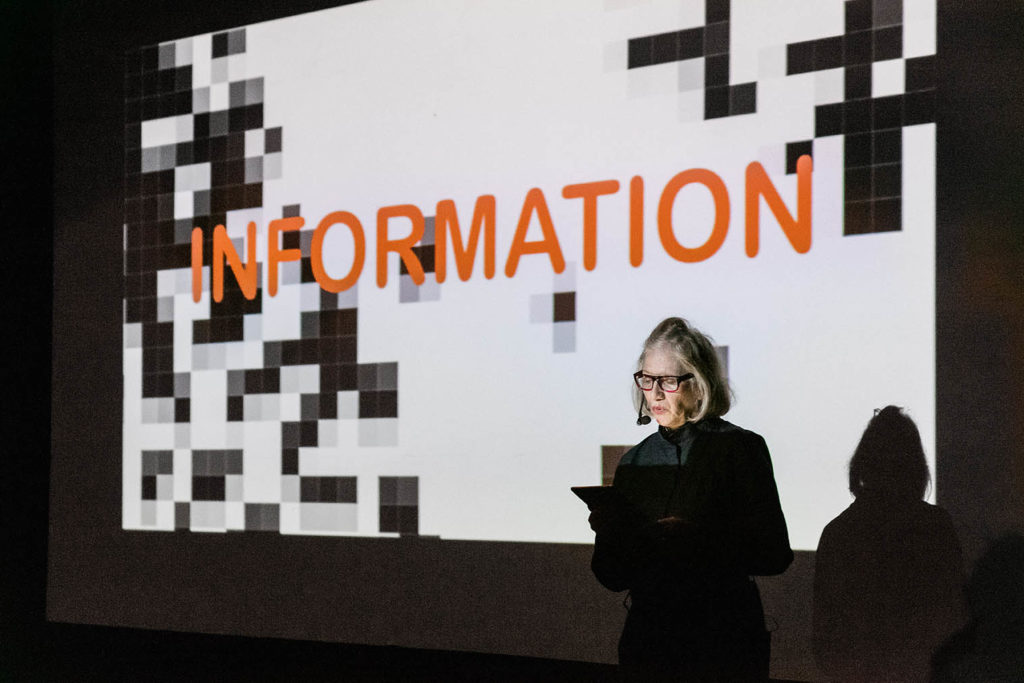
But Sollfrank extends this argument by asking: “Why do they all express their particular feelings, even though these are uniformly rooted in their own individual causes and systems of belief?” Yes, what is at stake when Assange’s organisation jump-scaled globally after the release of the Collateral Damage video in 2010? Would the strong tradition of the women-protective Swedish state have taken on the same exact legal process for someone less than Assange? Letting him leave for the UK, after a police station visit, but then after the leaks occurred, recall him for further questioning? The saga between the Swedish government and Assange,culminated in Swedish prosecutors dropping their investigation into Assange, bringing to an end a seven-year legal standoff on May 19, 2017.4 In February 2018, a judge, nevertheless, upheld the warrant for his arrest. On 28 March 2018, Ecuador cut Assange’s Internet connection at its London embassy refuge “in order to prevent any potential harm,” caused by his social media posts denouncing the arrest of a Catalonian separatist leader, which Ecuador officials claimed “to put at risk” Ecuador’s relations with European countries. Assange might well be an obnoxious bastard to whom rape charges might be thrown at and dropped, but he becomes a target for Sollfrank for another reason…
This is where the performance goes SURREAL. Of the ONE and ZERO, Sollfrank makes beautiful poetry of this, in her “BINARY WORLDS” section:
“The man is the ONE, and ONE is everything. And the female has nothing you can see. Woman functions as a hole, a gap, a space, a nothing that is not the same, identical, identifiable, … a fault, a flaw, a lack, an absence outside the system of representations and auto-representations. Lacan lays down the law and leaves no doubt when he syas: ‘There is woman only as excluded by the nature of things. She is not “all,” “not whole,” “not-one,” and whatever she knows can only be described as “not-knowledge.” There is no such thing as THE woman, where the definite article stands for the universal. She has no place like home, nothing of her own, other than the place of the Other which,” writes Lacan, “I designate with a capital O.”
And it remains up to us, the audience, to make the association she would never express herself: the ONE mal god, is it him?
In “PURE DIFFERENCE,” Sollfrank finally gets irritated herself! “ONE, the definite, upright line; and ZERO the diagram or nothing at all: penis and vagina, thing and hole; a perfect match… Now the only thing that counts is whether there is something to see, and there seems to be something missing with the Zero. What makes the <woman> in this respect? …Why not admit that we are as blind for the invisible sexual difference as between a Zero and a ONE, because we always have to see pictures and that means something else?”
“CYBERFEMINISM” is brought in to help answer some of the questions here, but its focus has been how to use technology to fight “Big Daddy Mainframe,” technology as a way to dissolve sex and gender. The cyberfeminist techno-utopian expectations did not digitally or otherwise materialise, and Sollfrank asks: “What is between your legs NOW? Zeroes and ones? Liberated data? Digital slime? The warm machine still awaits your intention, but never forget the flesh.” What Sollfrank goes on to declare in “GENDER & TECHNOLOGY” is that “Big Daddy rules supreme.” That is my least favorite part of the lecture. Yes, engrained spheres of masculinity are still ubiquitous within all techno-cultures, and Sollfrank offers the GamerGate example with men harassing women, trolling, doxxing, cyberstalking, intimidation and policing experienced by women and queers are real. Indeed.
But here’s also where the binary lures to manifest itself. Extending Assange’s obnoxious techno-geek persona accused of rape and making him the master signifier of patriarchy reproduced in digital networks and especially technoculture would in turn reproduce exactly the same that fills the empty signifier Assange with the baggage of their own beliefs. Watch out and not fall into the same trap here, although it might be beautiful just to fall.
Sollfrank’s contribution here is really not on Assange’s signifier as a male God of ONE the personification of toxic masculinity, it is more her critique of his ideology of TRANSPARENCY, in the last section of her performance.
The inconvenient question remains, what information at which moment and from whom? If it is not related to a political goal, transparency becomes an end in itself – an ideology, and we: its zombies. With transparency as the new imperative: How do we distinguish … between accountability, surveillances and privacy invasion? Liberating public data and protecting private ones? All data are made of similar substance and follow the same logic; who might be able to stop the flow, once it is flowing? Who would want to interrupt the continuum, to crack and leak and disrupt the flow – of capital? No way!
The performance finishes with “Naked information is incapable of generating a myth, I live off that which others do not know about me. And will I ever know myself? In contrast to calculating, thinking is not self-transparent. There is nothing more intransparent than the subject to herself – no matter how much data I have and share. Information is just information, only once you know what you are looking for, the search can begin.”
Sollfrank’s performance approached information from all the sides she started with: structure, knowledge, signal, message, meaning, process. I had to reflect on why I never wrote about the Swedish case in all the scholarship I developed on WikiLeaks over the years. I felt Assange is an easy target to be used as a prop to talk about sexism reproduced in digital networks, techno-patriarchy and cyberfeminism, filling him in as an empty signifier to whatever the pet subject and the ideological discursive purpose happens to be. And yet, I think here Sollfrank does something brilliant, bringing a picture of the ripped condom as a background to her red-font words. Because she is connecting meanings to structures, material, affective, digital and interrogating trust, extending to the trust that a condom should not be ripped, interrogating the winner takes all justification register of transparency as an ideology, surveillance as the normal, and the end of secrecy, the quest of truth at all costs, even disrupting democracy, even the neoliberal capitalist kind. When there is no true self, even in itself, the search for lost information can be the point or utterly pointless, the same way as ZERO and ONE. This is what Sollfrank I think transformed with her art in my (post-cyberfeminist?) soul machinery.
Link to most recent performance at the hacker convention 35c3 in Leipzig:
1 https://www.ica.art/whats-on/season/post-cyber-feminist-international
2 https://diem25.org/urging-sweden-and-the-uk-to-free-julian-assange
4 https://www.theguardian.com/media/2015/oct/12/timeline-julian-assange-and-swedens-prosecutors
Associate Professor in Media and Communication at the University of Leicester. Her work contributes to theorising cyberconflict, and exploring the potential of ICTs and network forms of organization for social movements, resistance and open knowledge production.
artist, researcher and university lecturer, living in Berlin (Germany). Recurring subjects in her artistic and academic work in and about digital cultures are artistic infrastructures, new forms of (political) self-organization, authorship and intellectual property, techno-feminist practice and theory. She was co-founder of the collectives women-and-technology, – Innen and old boys network, and currently is research associate at the University of the Arts in Zürich for the project ‘Creating Commons.’ Her recent book Die schönen Kriegerinnen. Technofeministische Praxis im 21.Jahrhundert was published in August 2018 with transversal texts, Vienna. For more information, pls visit: artwarez.org
On the 7th September, the Disruption Network Lab opened its 14th conference in Berlin entitled “INFILTRATION: Challenging Supremacism“. The two-day-event was a journey inside right wing extremism and supremacist ideology to provoke direct change, second appointment of the Misinformation Ecosystems series that began in May. In the Kunstquartier Bethanien journalists, activists, researchers, and infiltrators had the chance to discuss the increasing presence of movements that want to oppose immigration, multiculturalism and political correctness, sharing their experiences and proposing a constructive critical approach, based on the motivation of understanding the current debates in society as well as transforming mere opposition into a concrete path for inspirational change.
“How can you hate me when you don’t even know me?” With this question Daryl Davis tried to crumble the wall of ignorance and fear that he believes to be the basis of racial hatred. This 65 year-old author, activist and blues man, who played for decades with Chuck Barry, Jerry Lee Lewis and B.B. King, has spent 35 years studying race relations and befriending members of the Ku Klux Klan to turn them away from racism. In the context of increased supremacist ideologies and right-wing extremism, the Disruption Network Lab invited Davis to speak about racism and his interactions with individuals holding racist beliefs.
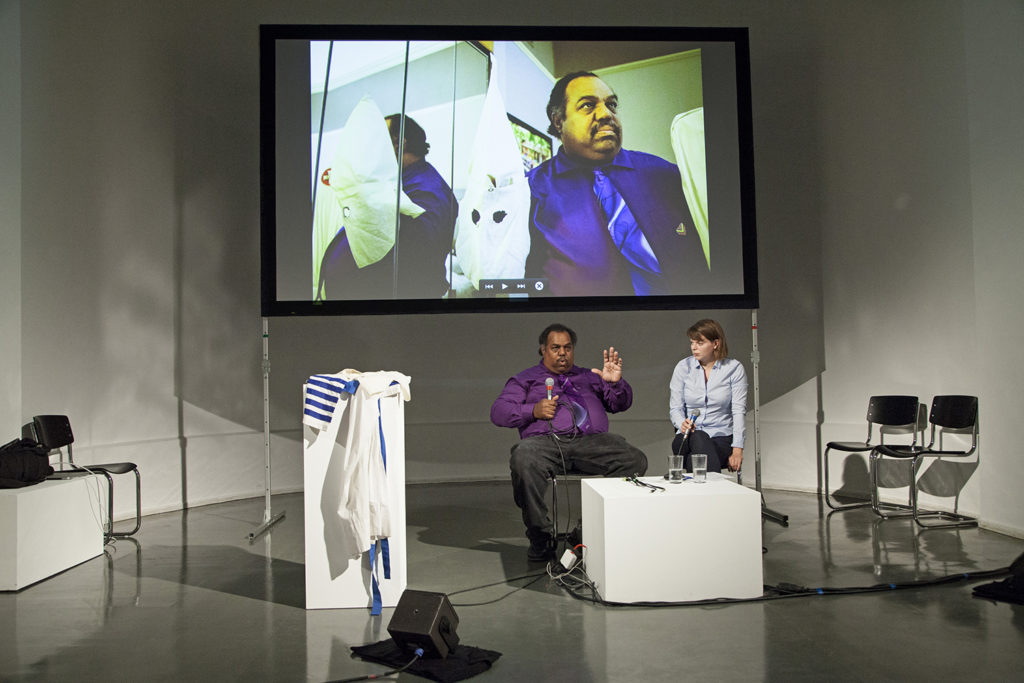
Growing up, Davis lived a privileged life as the son of a U.S. Foreign Service officer, travelling around the world and studying in an international context surrounded by children of other Foreign Service workers. His first shocking encounter with racism occurred when he was 10 years old in a 1968 Massachusetts. He was marching in a parade carrying the US- flag in front of his scouting group as people yelled racial epithets and threw rocks and bottles at him. His parents later explained that those people were targeting just him because of the color of his skin. Someone who knew absolutely nothing about his person and his life wanted to inflict pain upon him for no other reason than that. Because of this hateful reaction from so many white spectators along the route, Davis started wondering the fatidic question.
Ignorance causes fear and obviously the theses of supremacists and racist groups are built on these two components. Many years ago Davis decided to sit with them and listen to their point of view, contradicting their falsehoods using dialogue. Davis is convinced that if we do not fight ignorance it will escalate to destruction, “ignorance breeds fear; fear breeds hatred; hatred breeds destruction” as he previously stated. So, when someone says he thinks white people are superior, Daryl faces them and answers: “we are equal.” On this basis, Davis befriended hundreds of KKK-members and convinced them to rethink their choices. According to the media, he has persuaded more than two hundred of them to throw away their hoods and robes, their stereotypes and beliefs. His activity became national news as he befriended the KKK-member Roger Kelly and CNN broadcasted a story on their unusual relationship. When they first met, Kelly was “Maryland’s Grand Dragon”. Kelly didn’t know Davis was a black man and agreed to meet him. During their first meeting he spewed a lot of stereotypes, but – as Davis narrates – by the end of the evening they could agree on a few topics. The Grand Dragon told Davis they would never agree on racial issues; he said his Klan views on race and segregation were “cemented.” They continued to meet and converse about difficult and controversial matters for a long period: Kelly would attend Davis’s house and Davis would go to KKK-rallies. It took a few years but Kelly’s cemented beliefs got weaker, until he decided to quit the Klan and run for local elections. He had meanwhile become “Imperial Wizard” – which means national leader of the Klan.
During his key note Davis explained that his search for the answer to his question began one night in 1983. After having played in a country music bar a white man approached him and offered him a drink. The man later told him that it was the first time he had ever sat down and had a drink with a black man because he was a member of the Ku Klux Klan. Davis thought at first that the man was joking, but he wasn’t. The bluesman decided to talk to him, focusing on the fact that “they are just human beings,” he says “I respect these people when they sit, talk and listen. It’s just about difference of opinion. If you talk with them you can find things in common.” Someone might disagree with Daryl Davis that Fascism, Racism, Supremacism cannot be considered opinions, that they are crimes and that normalizing their cult is dangerous. But Davis prefers dialogue to posturing and fights. Davis believes in addressing ignorance through communication and education, to ease fear and prevent destruction. His efforts at dialogue are represented by his collection of hoods and robes from former Klan members he has befriended over time. Davis thinks that society should give these people a chance to express their views publicly to challenge them and force them to actively listen to someone else, dialoguing, to passively learn something. Many of them are anti-Semitic, neo-Nazi, Holocaust-denial and racist white supremacist, but he sees them mostly as victims of ignorance, fearing something that they just do not know. For these reasons he talks with them trying to overcome their prejudices. “Always keep the lines of communication with your antagonist open, because when you’re talking, you’re not fighting.”
Davis offers an extreme example of breaking down stereotypes to change the minds of white supremacists. It can be deeply understood only in the context of his US-American background and cultural formation. His keynote speech tended to get soaked in clichés, enriched by several “I am proud of my country” and “my country is great.” Maybe it is just a way to subtract right winged racists the monopoly over the patriotic discourse, through a moderate and gentle approach, to disrupt their one-way narrative, that conflates patriotism with rabid nationalism, showing them that he has traits in common with them. All in all his underlying convincement is that racism comes from a lack of personal knowledge of the African American experience and history, for example in music, and from a lack of personal relationships of a certain part of the white community with human beings that are not white. He thinks that by befriending ignorant racists they could relent, change their minds, have a change of heart and learn how to respect others. Davis is conscious about the fact that such an uncommon approach can be considered, at least, controversial. Many disapprove of it, pointing out that he is offering them a prominent stage in the national and international spotlight.
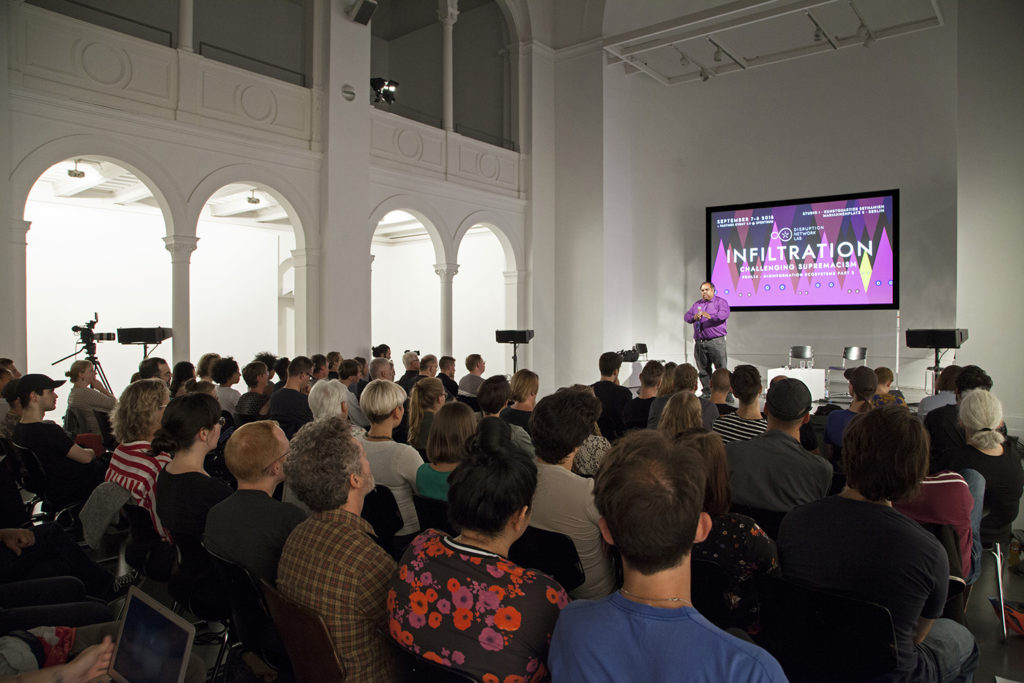
Davis´ activity can also be dangerous. In the past thirty years he has been attacked because of what he does. However, he is not afraid of the Klan or of racist groups. He has cultural tools to face dialectics, he has a strong identity and doesn´t want to fight against someone´s else idea of identity. On the contrary he is convinced that people of all backgrounds shall come together, getting along without losing their sense of identity or individualistic dimension, as no one shall be forced to accept an idea. Matt Ornstein has directed a documentary about Daryl Davis, that the Disruption Network Lab decided to screen during the third day of this 14th Conference. Entitled “Accidental Courtesy: Daryl Davis, Race and America.”
In Germany, individuals and organizations have been mobilizing to prevent the access of neo-Nazi to public platforms and media to spread Negationism and racist propaganda, in a collective lucid reasoning. Dialoguing with neo-Nazis, allowing them to exhibit symbols and to represent reactionary bigotry and hatred as something normal is not accepted by many people in Germany and the audience of the Conference showed reservations about Davis ‘words. Davis replied that his approach pays back. To those who tell him that he is giving racist and violent groups a platform to be normalized and to be part of the public discourse, he reminds them that most of those KKK-members that he approached decided afterwards to quit the group. It took him courage and dedication, he went to KKK-rallies, listened to their hymns, watched them set on fire giant wooden crosses during liturgical rites, witnessing moments of collective frenzy, delirium and hatred.
The documentary shows the efforts to dialogue with representatives from the movement Black Lives Matter too, that sadly ended up in a moment of misunderstanding and dramatic confrontation. Davis and Black Lives Matter have met again and have found a way to work together, going the same way approaching the issue of racism and discrimination with two alternative techniques, that are not mutually exclusive. However, Davis approach is markedly distant from this grassroots movement that organizes demonstrations and protests.
The audience of the 14th DNL Conference challenged Daryl Davis as his approach “we are all human beings” looks fragile in days of uncertainties, when extreme right movements are gaining consensus upon lies and discrimination. Inevitably, the debate after Davis ‘speech focused on the cultural shift represented by Donald Trump´s election and what came after that on a global scale. Davis said that in his opinion what is happening works as a bucket of cold water, that wakes people up and makes them engage and fight for change, reacting with indignation. Davis explained that in his opinion the #MeToo campaign came out as a positive consequence to Donald Trump´s election. “Obama was not elected by black people, who are all in all 12% of the US-population. Things change if we dialogue together, creating the bases for that change. In this way we can accomplish things that just few decades ago were thought to be unachievable.”
The panel of September the 7th represented a cross-section of the research being conducted by journalists, researchers and artists currently working on extreme-right movements and alt-right narrative. By accessing mainstream parties and connecting to moderate-leaning voters, right wing extremists have managed to exercise a significant influence on social and political discourse with an impact that is increasingly visible in Europe. The speakers on this first day of the Conference reported about their experiences with a focus on what is happening in their countries of origin: Sweden, Germany and Slovenia. Interconnecting three methodologies of provoking critical reflection within right-wing political groups, the panel reflected on possible strategies of cultural and political change that go beyond mere opposition.
Recalling all this, the moderator Christina Lee, Head of Ambassador Program and Hostwriter, introduced Mattias Gardell, first panelist of the day, Swedish Professor of comparative religion at Uppsala University, who dedicated part of his studies to religious extremism and religious racism, addressing groups such as the Nation of Islam and its connections to the KKK and other American racist activists, to focus than on the rise of neo-Paganism and its meaning for the radical right. Among his publications, a book on his encounters with Petter Mangs, “the most effective and successful racist serial killer” Sweden has ever encountered, as he writes, and recent analyses of the “lonely wolf” tactic of militant action and groups from the extreme right and the radical Islamism, that are operating under the radar, to avoid being detected and blocked by authorities.
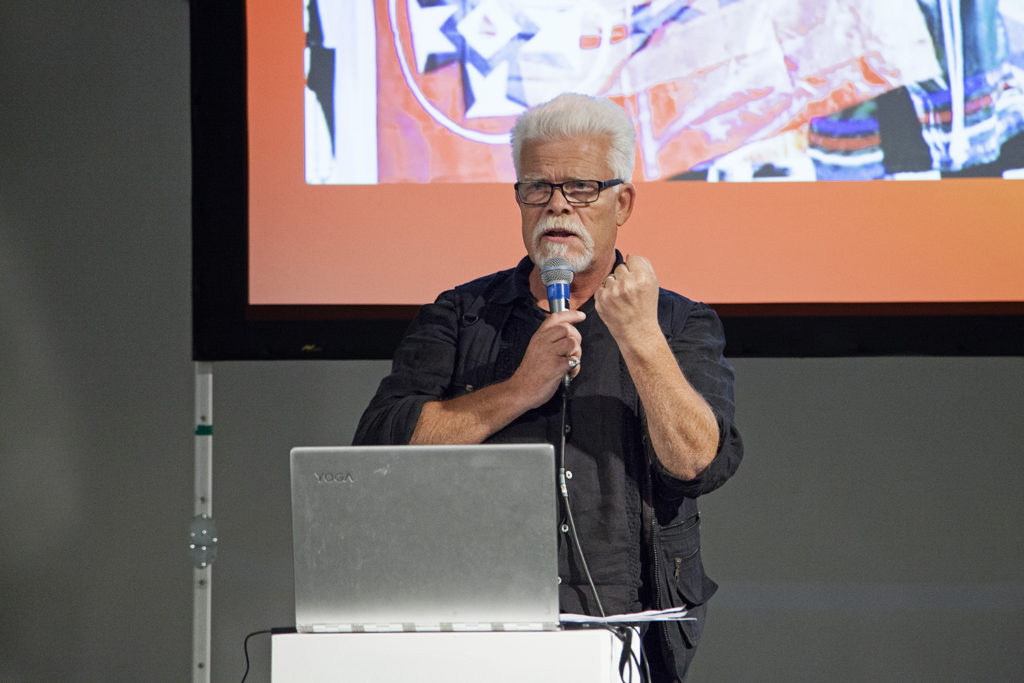
At the time of the Conference, parliamentary elections were about to take place in Sweden. The country was then set for political uncertainty after a tight vote where the far right and other small parties made gains at the expense of traditional big parties. Gardell reported that in Sweden the political and social climate of intolerance has risen. More than half of the mosques have been assaulted or set on fire and minorities are continuously under threat. During his speech he focused on how new radical nationalist parties and movements are investing in narratives built on positive images of love and community, nostalgic sentiments and promises to return the once good society and its original harmony. They are nationalist and ‘identitarian’ groups (as they call themselves), from different nations and united under their belief in separation on the base of national identities. They often portray themselves as common citizens, worried about the vanishing of their country and identity due to a program of multicultural globalism that aims at substituting national identities and people by means of a white genocide: a constant sense of paranoia, that Gardell also perceives in a country like Sweden, where the economy is flourishing, and inequalities hit mostly migrants and non-white population.
These groups work to spread the idea of a “white nostalgia”, a rhetorical discourse based on their efforts to reiterate a rosy, but hazy period, when life was better for the white native population of a certain territory. They ambiguously evoke a moment in history, that has probably never existed, at which national identities were free from external contaminations and people were wealthy sovereign citizens. This propaganda emerges into a multi-faced production in music, film and visual arts. It is not the “angry white men” image alone that can contain such a new fragmented and liquid reality; in fact, explained Gardell, the opposite is true. They often offer a narrative, that appears to be built on love rather than on hate. Love for their nation, love for their hypothetical race, for their selected groups and communities. It is not an imaginary love, it is a deep true feeling that they feel and upon which they construct their sense of collectivity.
Gardell underlined the importance of studying every-day-Fascism, focusing on its essence made up of ordinary individuals that like football, accompany children to school, listen to music and therefore have things in common with their neighbors and colleagues to whom they might appear as moderate people. “You can’t defeat national socialism with garlic. You have to face the fact that Fascism has been supported by millions of ordinary people who considered themselves to be good and decent citizens” he said. It is necessary to unveil the false representation of a political view, evoked through posters of blonde children and pictures of smiling women, that are designed to embody a bright future and a safe homeland. It is necessary to oppose the program of selective love and restricted solidarity that extreme right and nationalist groups promote. Therefore, says Gardell, we need to challenge those representations of love for nation, homeland and family built on a language that is impressive-sounding but not meaningful or sincere at all. And not just because “white nostalgia” is a fictional invention, but – more important – because on the collective and public sphere, love and solidarity are meaningful only if they are universal and express the value of equality unless they are just synonyms for privilege from which just few people can benefit.
At the moment, ultra-nationalist and radical right parties assembling the new political scene, appear to be able to influence traditional parties and vast parts of the population using love as a political weapon, affecting the social and political landscape in many countries, succeeding in making those traditional parties copy their agenda. Their recurrent themes exploit desire for individual social retribution, the tradition of a misogynic masculinity, the enhancement of self-government tendencies and isolation in opposition to openness and solidarity. A rhetoric that exploits the presence of nonwhite minorities and economic instability of this late capitalism, creating hateful propaganda. An intense online activity of manipulation supports the point of view of these ultra-nationalists. As the DNL Conference “Hate News” (May 2018) showed, online facts can become irrelevant against a torrent of abuse, memes and hate.
Online and offline, right extremists can easily find supporters in isolated realities, in the countryside or in close web-communities. Consequently, it is important to act locally and be focused, disrupting their ability to contaminate small groups. Young people are still intrigued by the gruesome and brutal part of the black metal scene, by the fringes of anarcho-fascists and by hooligans, feeding into an international network of neo-Nazi black labels and groups. But there are now also presentable faces, new political formations with attractive slogans supported by glossy music bands and influencers that are building a narrative of love. Mattias Gardell concluded his intervention saying that these groups are currently on the rise throughout Europe, whilst a storm of Fascism is coming again, widely, to hurt exposed individuals and communities, as it is already doing. He is disillusioned and reminded the audience of the Disruption Network Lab that it is necessary to focus and act to defeat it, knowing that it will cause blood.
The analyses of Mattias Gardell introduced topics covered by the second panelist of the day Richard Gebhardt, political scientist and journalist, who gave an insight into Hooliganism based on his direct researches from the last four years in Germany and England, where the Football Lad’s Alliance established itself as a complex reality. He focused on the reasons that pushed this violent collective to become a political movement, connected in Germany to the foundation of Pegida (Patriotic Europeans Against the Islamisation of the West), and the increasing popularity of the parliamentary party AfD (Alternative for Germany), which is today – according to opinion polls and surveys – the second biggest political formation in Germany.
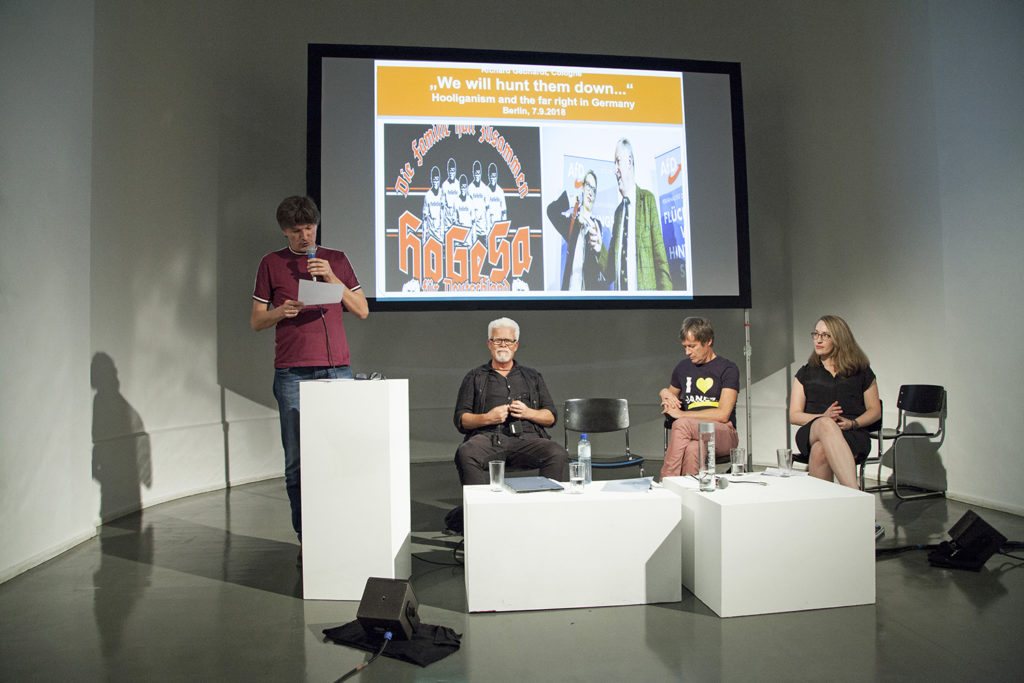
Gebhardt’s intervention began indeed with a quotation by the leader of the alt-right party Alternative for Germany: “We will hunt them down.” The parliament member was suggesting that the new members of parliament from his political formation would use their new powers to hold Angela Merkel’s government to account for its refugee policies “to reclaim their country and people.”
At the time of the Conference only a few days had passed since right-wing extremist thugs and neo-Nazis organized an assault on foreigners in the German city of Chemnitz on the 26th and 27th of August, in reaction to a murder that happened a few days before. It was a shocking moment for many Germans. However, in the following days politicians and members of the German government have tried to downplay the events, showing that big moderate parties tend to favor a certain kind of narration. Far-right violence in Germany has indeed seen a sharp rise in the last period. In this context the guest talked about the group “Hooligans gegen Salafisten” also known as HoGeSa (Hooligans against Salafists) and its origins.
On October 26, 2014, in Cologne the HoGeSa organized its first rally against Salafism. The number of participants can be ultimately estimated around 4.000 people, violent hooligans, who threw stones, bottles and firecrackers. They gathered in Cologne Central Station, with several speakers and live music, and to later march through the streets of Cologne. Xenophobic and neo-Nazi slogans were frequent, and so was the Hitler salute. During the riots dozens of police officers were injured and several police cars were damaged. Police were surprised by the inclination to excessive and unpredictable use of force. In that year thousands of refugees were traveling to Germany from conflict-ridden Middle Eastern countries and the HoGeSa was already targeting them.
In the days immediately after the demonstration, leading German politicians and prominent jurists sought to give a lighter representation of the events. The first official comments to the HoGeSa demonstration were not referring to it as a neo-Nazi demonstration, stressing the fact that hooligans are “for the most part politically indifferent” and that “they are not political but antisocial. They meet just to fight and drink.” The motto “Fußball ist Fußball und Politik bleibt Politik“ (football is football, politics stays politics) was repeated often but did not sound convincing at all. The Hooligans gegen Salafisten represented undeniably a new network of neo-Nazis, that had joined forces with football hooligans, nationalists and other right-wing extremists. Thousands of football supporters appeared to have left their football clubs of choice behind in favor of uniting against a common enemy: Islam. They chose their name HoGeSa hoping to receive popular support by recalling the fight against Islamist extremists.
Nonetheless, not every hooligan is a neo-Nazi. Press reported that in Hannover, for example, hooligans and ultras distanced themselves from the demonstration of HoGeSa and non-fascist football Ultras and that groups in Aachen, Dortmund, Duisburg, Braunschweig and Düsseldorf say they have been threatened, chased down and beaten by these Nazi-hooligans. Gebhardt suggested to the audience of the Conference a book, “Among the Thugs” by Bill Buford, to better understand the dynamics behind hooliganism. The book follows the adventures of Bill, an American writer in England, as he explores the world of soccer hooligans and “the lads”. Setting himself the task of defining why young men in England riot and pillage in the name of sports fandom, Bill travels deep into a culture of violence both horrific and hilarious.
Gebhardt portrayed these extreme right-wing rioters from HoGeSa as men, claiming to be equally distant from conservative and progressive parties, who want to be seen just as football supporters that are not carrying any ideological content, neither that of the Left nor of the Right. However, the nonpolitical hooligan is a myth: they are the heirs of a fascist tradition based on prevarication, arrogance and violence, that plays with the aestheticization of fighting and war, the glorification of militarism and pseudo-heroism. They are not worried citizens, they are thugs “ready for a civil war.” They claim to speak for the silent majority of their community, defending their country and their people. The work of Gebhardt can be seen in a documentary “Inside HoGeSa” (2018) and in his articles online.
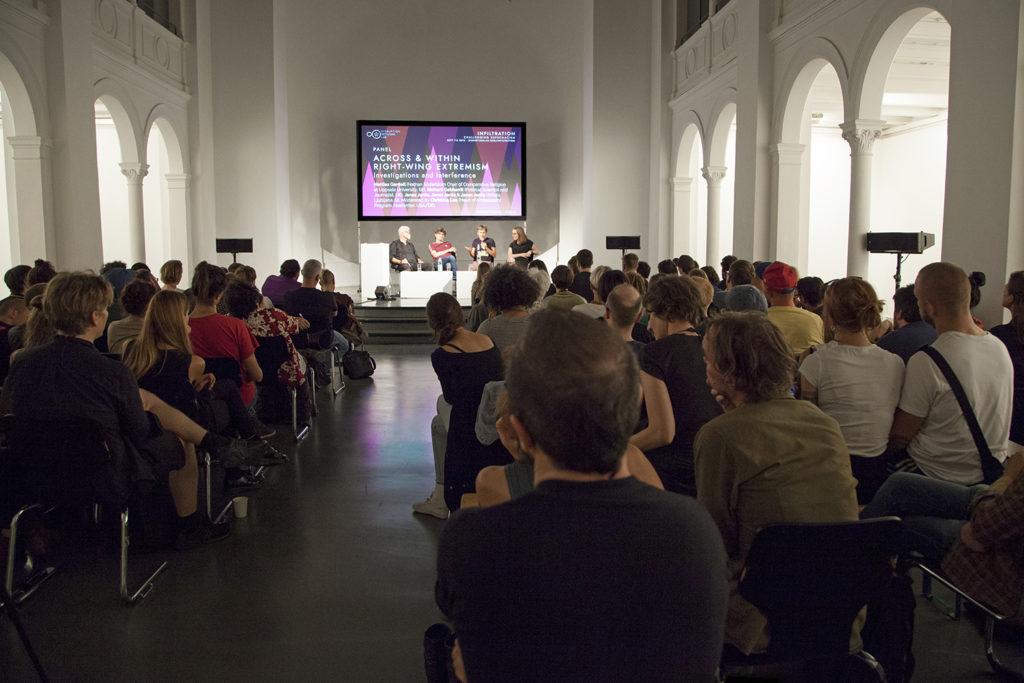
The last guest of Friday’s Conference was a member of the project ”Janez Janša, Janez Janša and Janez Janša,” who run for office in Slovenia at the last 2018 elections, confronting the leader of the conservative Slovenian Democratic Party (SDS), and former Prime Minister, Janez Janša. “Old names, new faces” was their motto.
In 2007 three artists decided to legally change their name to Janez Janša and joined the right conservative Slovenian Democratic Party (SDS, which was originally a moderate political formation). Janez Janša is also the name of the former President of Slovenia. All of a sudden, there were at least four Janez Janšas in the country: the three artists and the politician famous for his aggressiveness and contentiousness with the opposition and anyone who dares to criticize his choices. At the time President Janša made a public statement about the artists and pro-government media started to comment on their name change criticising their “politicized art”. The activity inside the SDS of the artists served to explore the bureaucratic and political systems of their home country. Their work of investigation is instead much more complex. It reveals how the perceptual influence of a name can interfere with social dynamics. Both on a collective and subjective dimension, they researched the meaning of identity and sectioned how their private life was affected by such name change. They proved that names are just a convention, an instrument, but with a relevant role. Janša remembered as an example that the Slovenian Democratic Party, despite this name, turned into a radical, right and conservative party between 2000 and 2005. Nowadays it is engaged in anti-migrant rhetoric and populist right-wing propaganda.
The artist illustrated how, in the last decade, the Janšas responded with art, cleverness and culture to campaigns of hate and propaganda, an approach that is the base for their political interventions. Their experience was the subject of the documentary from 2012, “My Name Is Janez Janša” and is internationally known. Artists and academics are still pondering about the meaning of the Janez Janšas experience, political critique, art work, activism, provocation or never-ending joke.
During the conclusive debate all panellists agreed that the world they have been in touch with and that they described in the Conference is mostly a world of men. Women are generally present as an accompaniment and/or an accessory. It is certainly a characteristic of Fascism, described in literature and art, as designated in the book “Male Fantasy” by Klaus Theweleit, where the author talks about the fantasies that preoccupied a group of men who played a crucial role in the rise of Nazism. Proto-fascists seeking out and reconstructing their images of women. Another aspect that all three guests agreed on, is the fact that individuals are massively not voting or taking part in public life, since they are increasingly distrustful of traditional media and politicians. European moderate politicians have on the other side the responsibility of a systematic dismantlement of social rights, they justified and supported an unequal economic system of wealth distribution for too many years. Now, scandals and arrogance in public and institutional life do not seem to affect the popularity of extreme right parties, that are ridiculing the excess of fair play and the interests of those moderate politicians.
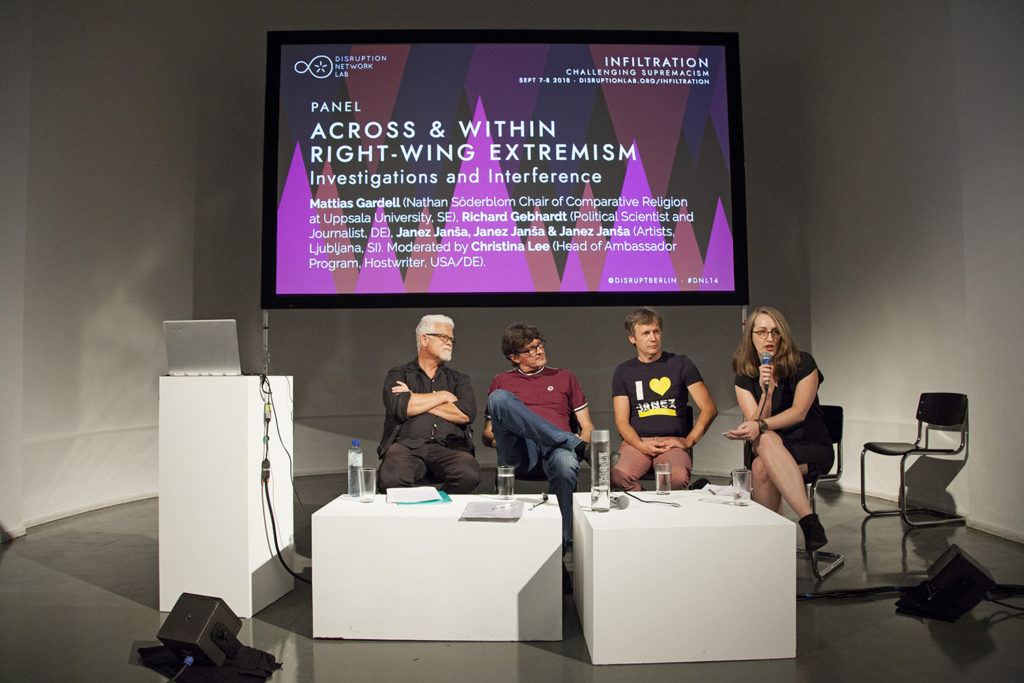
Focusing on new strategies to directly provoke change, the Conference on the 8th of September began with a performative conversation between Stewart Home (artist, filmmaker, writer, and activist from London), and Florian Cramer, (reader in 21st Century Visual Culture at Willem de Kooning Academy in Rotterdam), moderated by Tatiana Bazzichelli, artistic director of the Disruption Network Lab. The universe of the extreme-right seems to have embraced a path of transgression, arrogance and nonconformity, employed to suggest that its members are holders of a new alternative approach in cultural, political and social criticism. What comes out from such a wave of counterculture is an articulated patchwork that flirts with violence, discrimination and authoritarism.
Bazzichelli asked the audience to question the nowadays extreme right self-definition of their political offer as an “alternative,” considering that the issue of transgression and counterculture has been widely developed by academic and artistic Left, and that experimentation, theorisation and political antagonism have been growing together in the left-leaning universe. In such a perspective, “working on something alternative” – explained Bazzichelli – is supposed to be synonymous with creating a strong criticism of media and society, through political engagement, art and intellectual efforts. An alternative that could enhance a positive, constructive contribution in the collective socio-economic discourse. Today, words like “infowar” and “alternative” tend instead to be associated with a far-right countercultural chaotic production. On this basis, Bazzichelli introduced the lecture by Stewart Home and Florian Cramer, that investigated if and to which extent it is possible to affirm that ideas and values driven from the Left are now reclaimed and distorted in an extreme-right alternative narrative.
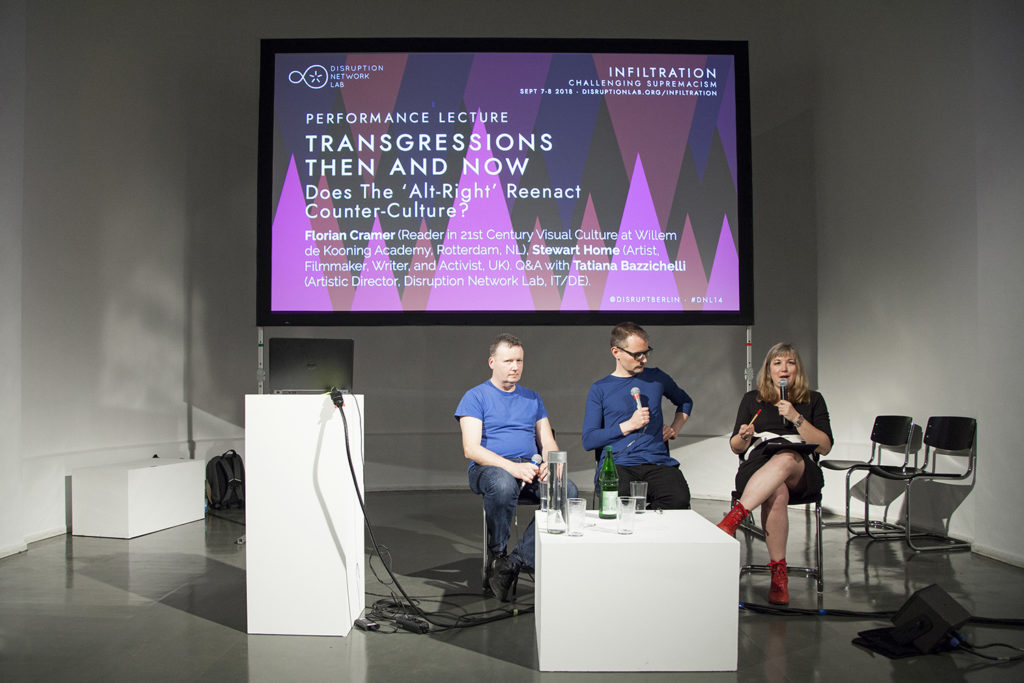
In an historical excursus on art, literature and subcultures, the two speakers focused on the 1970s-1990s counter-cultural currents that used radical performance, viral communication and media hoaxes and examined the degree to which they may be seen as playbooks for the info warfare of the contemporary extreme right. With their presentation they suggested that it is improper to state that the alt-right has now occupied established leftist countercultural territories. There have been several examples of a parallel development and interpenetration of very opposite points of view over time. Tommaso Marinetti, father of Futurism and its Manifesto about “War, the World’s Only Hygiene,” mixing anarchist rebellion and violent reaction became then a fervent supporter of the Italian Fascism, that glorified the new futuristic approach. However, Futurism means also sound poetry, since discordant sound had a vital role in Futurist art and politics; an experience that developed into the noise movement with an influence that reached post-industrial musicians and further.
Cramer remembered that Futurism represents also an avant-garde and counterculture from the 1900s, that had similarities with Dadaism. In fact, though Dadaism was anti-war and antibourgeois, they shared a spirit of mockery and provocative performances, mixing distant genres and a massive use of communication, experimental media and magazines. Always considering the beginning of the 20th Century, the lecturers recalled the production of the painter Hugo Höppener Fidus, expression of the Life Reform Movement, linked both to the left- and the right-leaning political views, that strongly influenced Hitler and Nazism, showing roots of an alternative counterculture that went both into the political extreme right and left.
In the 1970s and 1980s, in subcultural production and artistic performances it was frequent the use of fascist symbols as provocation and transgression, for example in the punk scene, which ranged notoriously from left wing to right wing views as pseudo-fascist camp in post-punk culture turn into actual Fascism. A conscious ambiguity, part of experimentation, that – particularly in the U.S. – meant also leaving space to things that were in contrast to each other. In the context of US underground culture, the speakers mentioned publications like those from Re/Search “Pranks!” on the subject of pranks, obscure music and films, industrial culture, and many other experimental topics. Pranks were intended as a way of visionary media manipulation and reality hacking. Among the contributors, you could find artists from the industrial movement, like the controversial Peter Sotos and Boyde Rice, who became today established part of right-winged countercultural movement.
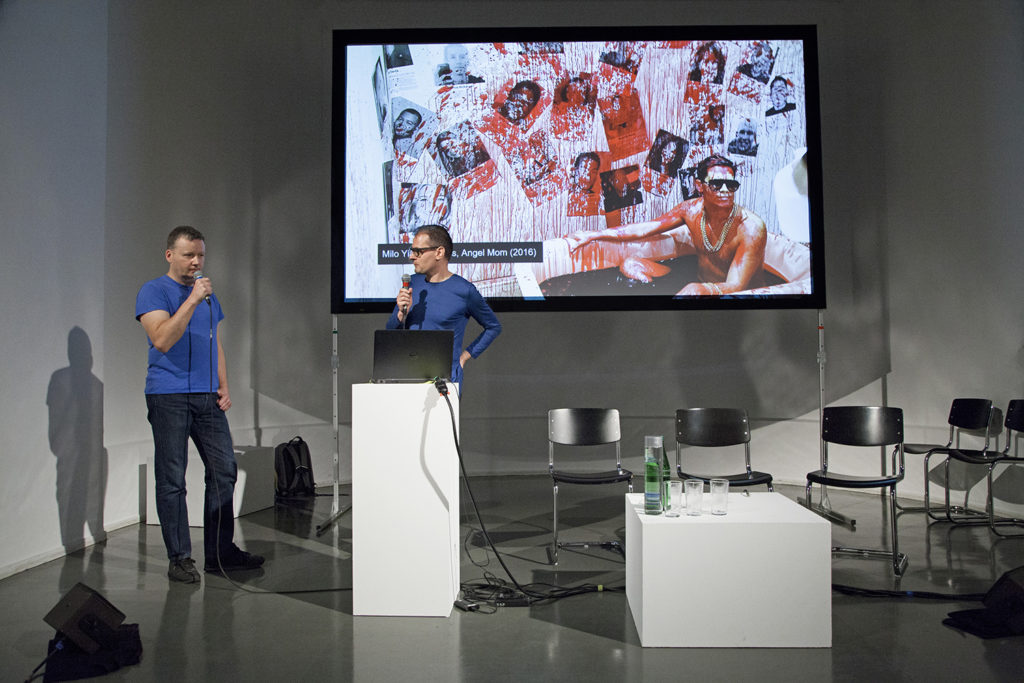
Talking about the present, Cramer and Home also mentioned Casa Pound, a neofascist-squat and political formation from Rome, that adopted the experience described by the anarchist writer Hakim Bey of the “temporary autonomous zones,” that redefined the psychogeographical nooks of autonomy – as well as appropriated the name of Ezra Pound, a member of the early modernist poetry movement.
All this suggests that the so-called alt-right has probably not hijacked counterculture, by for example deploying tactics of subversive humour and transgression or through cultural appropriation, since there is a whole history of grey zones and presence of both extreme right and left in avant-garde and in countercultures, and there were overlooked fascist undertones in the various libertarian ideologies that flourished in the underground. Home and Cramer reminded their common experience in the Luther Blissett project, based on a collective pseudonym used by several artists, performers, activists and squatter collectives in the nineties. The possibility to perform anonymously under a pseudonym gave birth to a mixed production, with undefined borders, in few cases expression of reactionary drives. An experience that we can easily reconnect to the development of 4chan, the English-language imageboard very important for the early stage of Anonymous, that today is very popular among the members of the Alt–Right scene,
Cramer illustrated so how Libertarianism can sometimes flip into a reactionary ideology. The same can be for Anarchism (with the Anarcho-Capitalism) and Cyberlibertarianism, just like for the subcultures. In the Chaos Computer Club – explained Cramer – there is a strong cyberlibertarian component, but we might find also grey zones where a minority of extreme-right can find ways to express itself. Spores of extreme-right and fascist-anarchical degeneration can so be found in the activities of political and art collectives from the Left and, in this sense, it looks necessary to expose their presence in relation to those grey areas, that could become a context for spreading ambiguous points of view within cultural production.
Marinetti, Pound, Heidegger, have a general relevance that cannot be denied. Home and Cramer underlined that, at the moment, nothing of what we see internationally in the extreme-right panorama can be considered culturally relevant. The alt-right is not re-enacting counterculture. This “alternative” of the extreme right consist mostly of a cluster of media outlets producing hate and propaganda, within a revisionist narrative. It picks up an old rhetoric about heroic rebellion, arrogance, overbearing masculinity, mythization of war and the use of violence, in most cases using new definitions for old concepts. Home and Cramer concluded that there is no intrinsic value in being transgressive, and transgression alone cannot be enough to gain any kind of attribute of quality. Because transgression is just a tool. Artists and activists cannot stop experimenting and using the tool of transgression to criticise society, building alternatives and being alternative. The moderate approach in an era of political correctness is a way to enchain the Left; moreover people have the right to hate their condition, hate their job and the inequalities that affect their lives. This feeling is legitimately generated by a critical thinking.
The panel of the second day of the conference reflected on the practice of political, journalistic and activist infiltration as a way of better understanding extremist groups. The moderator explained how from one side infiltration maps extremist groups from the inside, and from the other, it analyses how extremist groups are building their networks, becoming widespread in online and offline. The aim is to explore such groups from within, analysing the reason for people to join them, as well as understanding their inner dynamics.
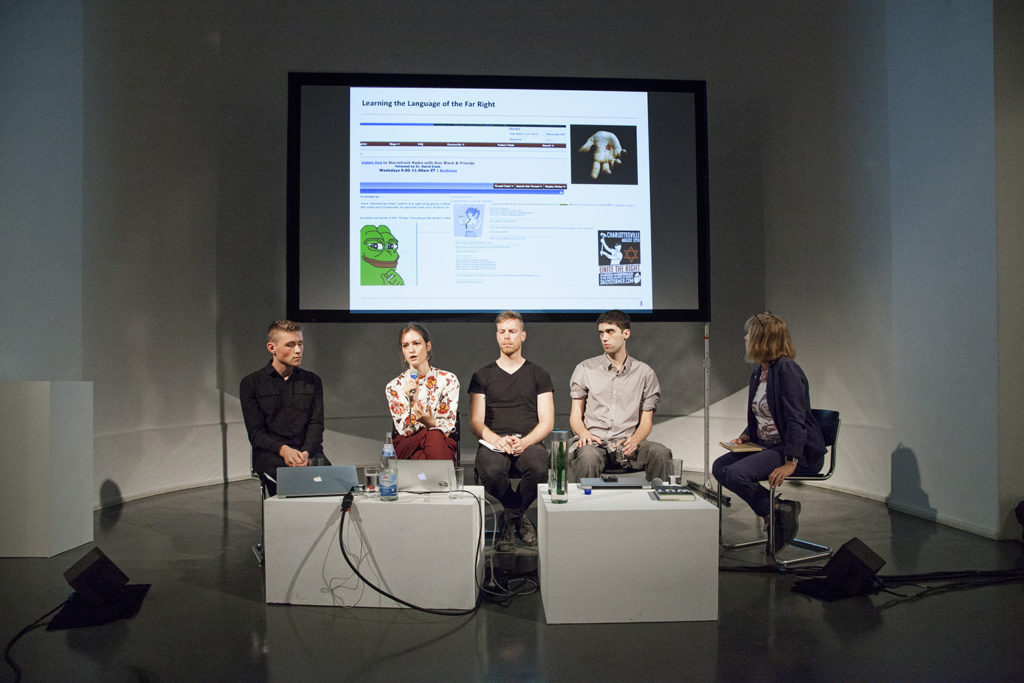
Rebecca Pates, Political Anthropologist from the University of Leipzig, moderated the discussion and introduced the four guests, commenting that a number of different things can be done when infiltrating. The activities and the achievements can differ, and so the technique, from total concealment in infiltration to openness about it. Pates suggested that from the inside it is possible to understand for example the reason why young people are attracted by groups that from the outside look so angry and violent, and it could be defined the sense of comradeship and belonging that convinces individuals to participate into these movements.
Julia Ebner is a Research Fellow at the Institute for Strategic Dialogue (ISD) and author of the bestselling book The Rage: The Vicious Circle of Islamist and Far-Right Extremism. She opened the panel explaining how, after the terroristic attacks from right extremists in Europe and in the US, she decided to get a better understanding of the world of the far-right and their narrative. She infiltrated both online and offline, undercover, with fake identities and avatar accounts, changing her appearance. Her goal was to get into groups that are very different ideologically one from the other, like the neo-Nazi, the old conservative fascist movements and the counter Jihad movement. During her speech she described how she built up a new identity and made connections necessary to her purpose.
To get in touch with active members she used some social media and crowdsourcing platforms available for the extreme-right, such as “Gab”, the alt-right equivalent of twitter, “Wasp love”, a place to date “reformed Christians, confederate, home-schooled, white nationalists, alt-right and sovereign singles.” She was asked to send a full account of her genetic ancestry to be accepted or to share a picture of her skin colour. She had voice chat interviews to enquire about her ideological background or sexual orientation. Ebner entered an alternative universe of disinformation ecosystems and accessed subcultures that interact in parallel as a part of a same bigger network. When she was asked to justify fresh profiles, that she just created, she could benefit from the fact that many far-right users are removed and banned for what they post. She started frequenting all the different tech platforms considered a safe environment for far-right extremism, where they could very openly cultivate antisemitic and conspiracy theories, anti-left rhetoric, coordinate doxing and harassment activities. In 2016 the writer and researcher joined undercover the English Defence League and went to a rally of theirs against what they would call Muslim grooming gangs. A year later she was then recruited into the movement Generation Identity or Identitäre Bewegung, always as part of the new European alt-right (alternative right) and was invited to join them in public and private meetings, like a secret meeting in an Airbnb location in Brixton. In that occasion she was sitting among 20 white nationalists discussing their strategies to launch a British branch of their group, with a manifest focus on optics and media strategy briefings, to learn how to deal with tough questions from journalists about anti-Semitism and racism. They discussed about their political background and their selection procedures in order to achieve a good branding and quality in their membership. The obsession of appearing as decent citizens in public was and is very important in rallies like Charleville. Reports attest indeed that far right groups were concerned about how to dress and even told some people, not particularly good looking, that they could not join the event as they would not make a good impression. Events like Chemnitz, Charlottesville’s “rally to unite the right” or the experience of Defend Europe – an illegal far right ship that sought to hamper the rescue of refugees in the Mediterranean in 2016 – represent a cross-border collaboration between movements that until few years ago were not communicating. These events bring them together on the basis of their lowest common denominator for the sake of having a bigger impact.
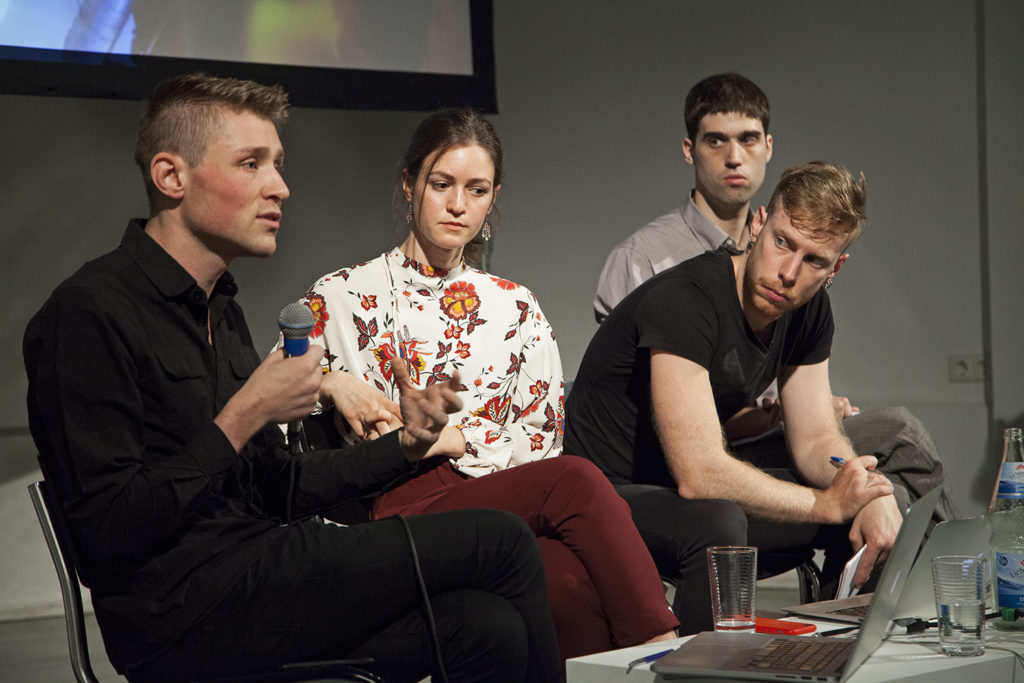
After Ebner wrote an article for the Guardian and for the Independent she got backlash from the far-right and the English Defence League. Its founder, Tommy Robinson, ended up storming into her office with a cameraman, filming the whole confrontation and live streaming it to Rebel Media, a far-right news outlet in Canada. The influencer has 300.000 followers and these channels are very popular too. They gave immediate resonance to the aggression and set off a long chain reaction among other far-right and alt-right news platforms, globally. Her whole life got under attention, they used all available data to publicly discredit her. The researcher realised how much it is possible to do with online data to intimidate political opponents or people who criticize. Ebner and her colleagues experienced the hate campaign machine. She noticed that women are more attacked and threats, symptom of the wide anti-feminist and mesogenic culture. It seemed to her that the whole universe was against her activity of infiltration and that she had no supporters. Many different groups and networks were creating a distorted representation of her engagement, and this pushed her to embark on a research project about the interconnectedness of the variegated far-right media galaxy.
With other colleagues Ebner analysed about 5.000 pieces of content, accomplishing a lot of linguistic analysis, and studying interactions with social media monitoring tools. Thanks to this work the researcher can describe the mainstreaming strategies of the extreme right and how its members try to create compelling and persuasive countercultural campaigns using humour, satire and transgression and co-opting Pop Culture. An attitude common with the fundamental Islamism is they are creating content that has appeal on young people on the Internet but they are also concentrated on the traditional media, to make sure that they pick up on their provocations or fake news. They trigger media to report on them by staging online complaints that would go viral. Ebner has also started a project in collaboration with the organisation #ichbinhier e.V., discovering that this technique of coordinated interactions often creates the illusion that they represent the majority of the users. The research shows something different: 50% of the interactions or of the hateful comments below news articles, that they analysed, came from just 5% of all active accounts. A small but very loud minority of people that is now dominating the whole discourse amplified by bots or a media outlet sometimes also Russian ones, staging online psychological operations, jokes and meme to hide extreme right hatred campaigns behind humour-images.
Memetic warfare and gamification are two very relevant aspects, as frequent as quotations from the movies Matrix and Fight Club, with the rhetoric of the red pilling to see the truth. Most of the accounts active in this activity were coordinating posts and hashtags so that their content could get prioritised in the feeds and create viral campaigns, striving to dominate the whole social media discourse. They have very clear hierarchies, which could be ascribed to the gaming dimension too. Hateful comments and negative interactions appear in a flow, getting soon in the top section due to a high degree of coordination. Generation Identity is known for sharing content according to the tactics of the so-called media guerrilla warfare manual, based on a very militarised language, that describes actions, goals and sniper-missions to target and intimidate political opponents exploiting media. All comes in a very gamified way, as they talk about a virtual battlefield and electronic items, where a good performance allows to grow of level. During the German elections in 2017 members and followers of Reconquista Germanica (an extreme-right channel running on the Discord platform) were quite successful in spreading extreme-right topics and making politicians and media pick up on them. Some of their hashtags were often listed in the top 5 trends in the two weeks before the vote. In the meantime, they were evaluating and analysing their activity, celebrating successful “generals” or “soldiers” that were promoted into higher levels. Ebner expressed her concerns as this reflects in in real-world practice what they would do if they manage to establish their own vision and get in power. Since Trump was elected we’ve seen a growing ecosystem that repeats itself, where extreme-right is certainly reappearing. It is indeed possible to spot similar tactics and vocabulary among several European far-right groups, in the campaigns of Italian, German, French, Swedish and Dutch elections. She underlined how important it is to understand far-right extremism better and the relationship between Islamist and far-right extremism, as they have a lot in common and are reinforcing each other.
Anti-racist activist and “Hope Not Hate” researcher Patrik Hermansson reflected on the meaning of radical right-wing practices today bringing his direct story as undercover activist inside the international Alt-Right, and published in The International Alternative Right Report. Starting in the fall of 2016 he joined a London based organisation and then travelled through many other related groups, living a dual life. He described his year of infiltration inside an international secret formation called London Forum, for which you need to be vetted, background checked and have someone who lets you in. Hermansson works as a researcher for Hope Not Hate, an organisation established to offer a more positive and engaged way of doing anti-Fascism. This 26-year-old man has been “Erik”, a fascist who came to London inspired by Brexit and to get away from the liberal prejudice of Swedish universities. He entered and investigated the Forum, discovered members, techniques and goals, until he witnessed the terrible violence in Charlottesville, Virginia. To do so, Hermansson had to become a Swedish teacher of a member and was quickly driven into the world of the extreme right. From former Tory Party members to famous alt-right influencers, he met people in different countries and different social context. It was a safe space of anonymity, that you do not find on Social media.
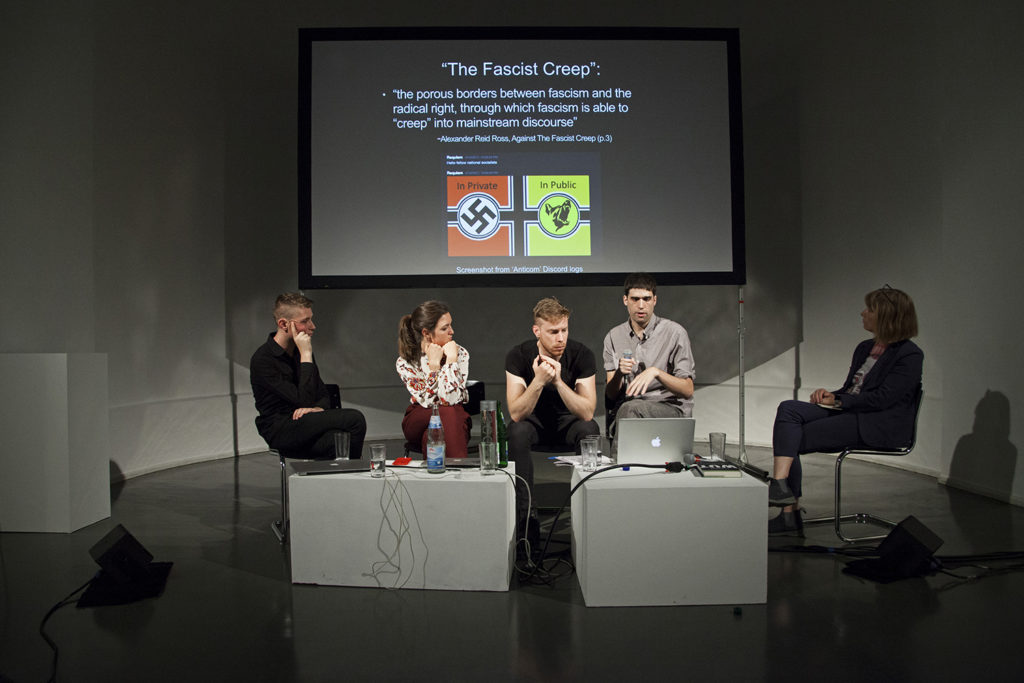
Hermansson described to the audience of the Conference the social aspects animating the group, where members can feel part of a community, make new friends even overcoming political differences until they have anything else outside. Conspiracy theories have a relevant role too. Holocaust denial, addressed as “the biggest PR event in history”, or the chemistry rails, are important part of their theorization. They feel part of a group that is bound together by secrets that allow you to see behind the curtain and make you understand more than the rest of the population. Hermansson pointed out that the activity of infiltrate is a difficult and immoral business. It exploits people’s trust. It is justified by the need to expose techniques of recruitment, data, but we should not romanticize, not to go too far not to be ruthless. Hermansson infiltrated for a purpose, to get a closer image of right extremism and decided to expose the top players of the organisation, musicians and influencers. The most effective part of the activity, he said, was the sabotage. Infiltration makes people point fingers, paranoia spread in the movement and things broke apart. Hermansson explained that it was a conscious decision: the anti-fascist part of the research. The London Forum is not active anymore, people left it showing that the method of exposure is quite effective. He found out that his activity raised the cost of their recruiting process, which is now much tighter.
The panel was concluded by a member of the Unicorn Riot collective, “a decentralized non-profit media organization of artists and journalists, dictated to exposing root causes of dynamic social and environmental issues through amplifying stories and exploring sustainable alternatives in the globalized world.” The investigative journalist Christopher Schiano presented his work of analysing and publishing of leaked messages from white supremacist, neo-Nazi and various alt-right fascist groups in the US – followed by an introduction of the DiscordLeaks platform by the developer Heartsucker, who is working as an affiliated volunteer for the Unicorn Riot. The guests talked about how Unicorn Riot has obtained hundreds of thousands of messages from white supremacist and neo-Nazi Discord chat servers after the events in Charlottesville, and decided to organise and open a far-right activity centre to allow public scrutiny through data journalism.
Discord is a voice-over-Internet Protocol (VoIP) application for video gaming communities, offering text, image, video and audio communication between users in a chat channel. The US non-profit media organisation with its Discord Leaks has exposed hundreds of thousands of chats from alt-right and far-right servers received. Parker was receiving screenshots of real-time communications between alt-right activists involved in planning the Charlottesville rally and got a “general orders” document, along with audio recordings of a planning meeting ahead of the rally. The screenshots kept then coming throughout the following days.
As reported by the Washington Post, Discord allowed the organizers and participants of the rally to convene in private, invite-only threads shrouded in anonymity – with usernames such as “kristall.night” and “WhiteTrash.” On a Discord server called “Charlottesville 2.0,” they planned everything from car pools, dress code and lodging in Charlottesville to how one might improvise weapons in case of a fight. Some suggested using flag poles as a makeshift spear or club. Many of these things took place. The collective received also internal logs, which enabled them to better see the scope of plans for the Unite the Right rally. Since its founding, Unicorn Riot has gained relevance among people looking for alternative news sources, principally covering protests with an on-the-ground perspective that many mainstream outlets miss. Unicorn Riot was for example among the first media outlets to get to the rally in Charlottesville and cover it. Through their investigation they explained how the far right tries to recruit new member via Discord, or they unveiled the attempts of extremists to look like ordinary Trump’ supporters, building a victim narrative to insinuate the idea that they are targeted citizens. Some of them are supporting the police and members of the police force have been exposed for leaking information to far-right members. They exposed the movement Anticom, anti-communist action, active mostly in shitposting, and the group Patriot Front, whose members unite under the motto “we are Americans and we are Fascists.”
At the end of the three the panellists reasoned on the importance of infiltration, as a means to study the extreme right and expose their networks and members, their strategies and tactics. It can also be helpful to try to predict what these groups are about to do, foreseeing their next step. It means getting in touch with them, entering their circles based on comradeship and exchange of personal experiences. Ebner commented that the use of lies and distortion is the cost of it, wondering, however, about what the cost of inaction is instead. Hermansson reported about the effects of infiltration in terms of the desensitisation he went through, taking part in conversations without reacting. The same desensitisation process can be described in the memetic warfare.
As part of the Disruption Network Lab thematic series “Misinformation Ecosystems” (2018), this 3-days-conference concluded the 2018 programme of the Disruption Network Lab. The series began with a focus on hate-news, manipulators, trolls and influencers, that investigated online opinion manipulation and strategic hate speech in the frame of a growing international misinformation ecosystem, and their impact on civil rights. HATE NEWS focused on the issue of opinion manipulation, from the interconnections of traditional and online media to behavioural profiling within the Cambridge Analytica debate. This second conference took the process further by pointing to specific researches and investigations that illustrated how a process has clearly set in motion, whereas radical right is currently working on an international level, building cross-national connections and establishing global cooperation.
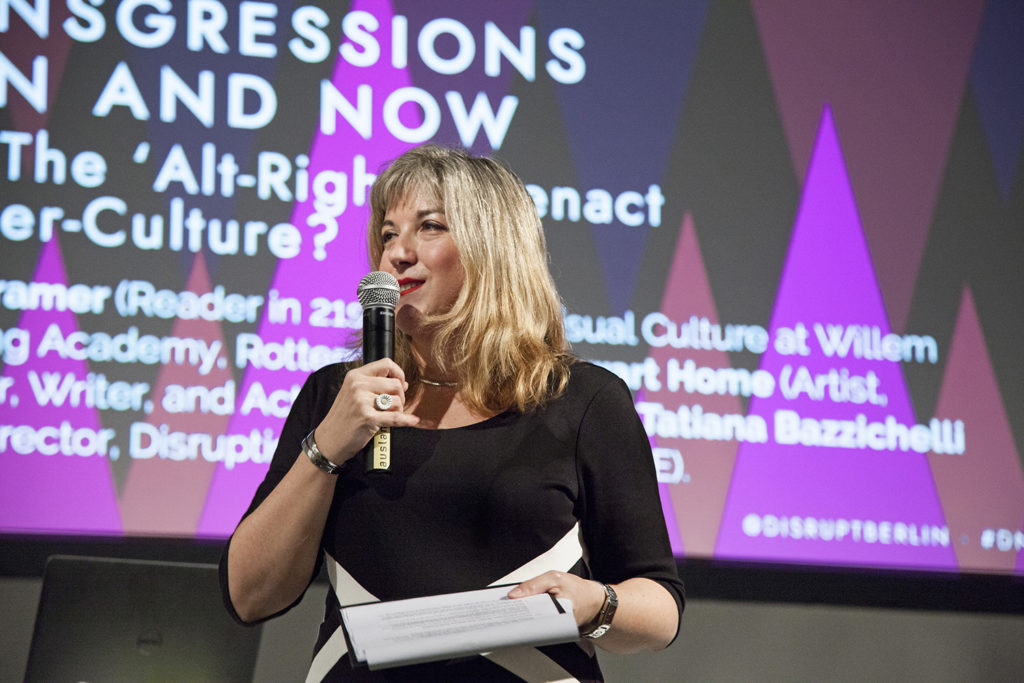
Not just Steve Bannon and a galaxy of media outlet and online platforms are pushing for a new authoritarian turnaround, based on discrimination and ultra-nationalism, having factual impact on political systems. On a grassroot level, there are local networks and formations able to unite different realities and backgrounds, melt together under new trendy labels, slogans and influencers. A new scene that is carefully designed to be appealing to moderate-leaning electorate, where you can find hooligans, hipsters, neo-Nazi and politicians dressed in suits and ties, all striving to appear like conscious citizens and decent members of society, part of a new generation of activists. However, beyond the facade, the majority of far-right groups shows to be against an open, multicultural society as well as against inter-religious and inter-cultural togetherness. They play with economic uncertainties, fear, anger and resentment to spread hate, attack opponents and discriminate minorities, often through a meme-driven alt-right humour, designed to cover with dark hilarity their racist propaganda and fascist drives. Jokes are used by public figures and influencers to promote misogyny, homophobia, a distorted idea of masculinity, racism and justify unacceptable statements. Too often mainstream media and newspapers pick up staged news from such misinformation ecosystems, enforcing a revisionist narrative built on manipulated facts and interactions, arrogance and violence.
Conspiratorial and paranoid thinking acts like a catalyst, provoking participation and fascinating individuals, who want to become warriors and custodians of knowledge. Alongside the image of the angry white man, there is a whole narrative of love and solidarity for their chosen group, the community they decide to protect, identified on utilitarian basis.
Despite of what is represented in media, many speakers at the conference pointed out that there is neither something alternative nor innovative in what they are offering. However, mainstream parties and media tend to follow their reactionary narrative, enforcing the idea that it is competitive. The guests of the Disruption Network Lab came from Africa, Europe, North and South America and exposed an intertwined scenario of transnationalism of the radical right. The direct engagement of activists, that decide to infiltrate, together with the work of researchers, journalists and artists, allowed for a clearer image of what is going on at a global as well as local scale, to understand how it is possible to interrupt this process working actively within the civil society. Sabotage and exposure are instruments useful to disrupt and unveil strategies aimed at sending the world back of a hundred years of human rights achievements. Thanks to Tatiana Bazzichelli and the Disruption Network Lab team, who offered a stage to learn about constructive practices that can be activated in order to change the course of things.
–
INFILTRATION: Challenging Supremacism
SEE VIDEO DOCUMENTATION OF THE CONFERENCE
SEE PHOTOS FROM THE CONFERENCE
On the day of the General Data Protection Law (GDPR) going into effect in Europe, on the 25th of May, the Disruption Network Lab opened its 13th conference in Berlin entitled “HATE NEWS: Manipulators, Trolls & Influencers”. The two-day event looked into the consequences of online opinion manipulation and strategic hate speech. It investigated the technological responses to these phenomena in the context of the battle for civil rights.
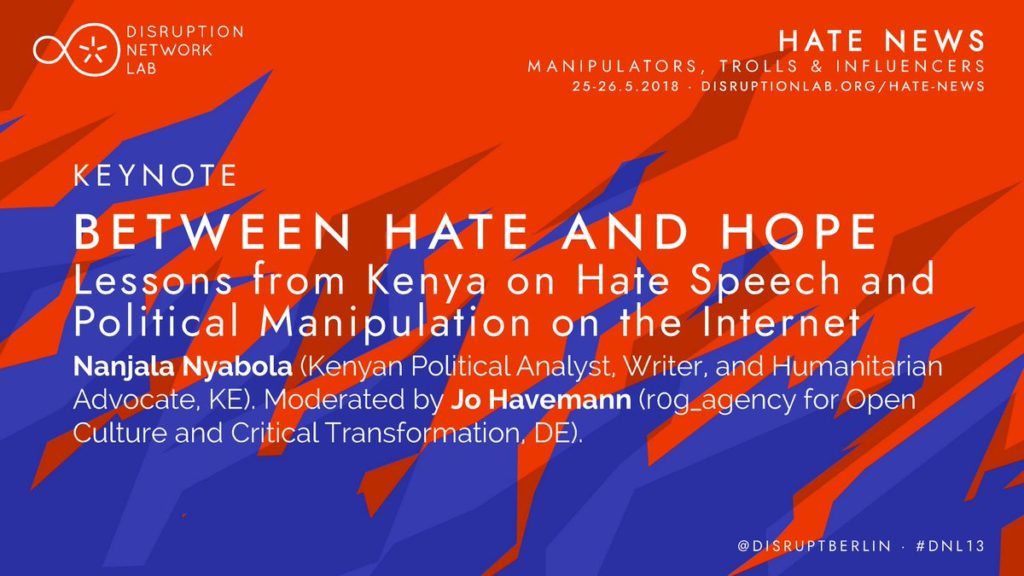
The conference began with Jo Havemann presenting #DefyHateNow, a campaign by r0g_agency for open culture and critical transformation, a community peace-building initiative aimed at combating online hate speech and mitigating incitement to offline violence in South Sudan. More than ten years ago, the bulk of African countries’ online ecosystems consisted of just a few millions of users, whilst today’s landscape is far different. This project started as a response to how social media was used to feed the conflicts that exploded in the country in 2013 and 2016. It calls to mobilize individuals and communities for civic action against hate speech and social media incitement to violence in South Sudan. Its latest initiative is the music video #Thinkbe4uclick, a new awareness campaign specifically targeted at young people.
In Africa, hate campaigns and manipulation techniques have been causing serious consequences for much longer than a decade. The work of #DefyHateNow counters a global challenge with local solutions, suggesting that what is perceived in Europe and the US as a new problem should instead be considered in its global dimension. This same point of view was suggested by the keynote speaker of the day, Nanjala Nyabola, writer and political analyst based in Nairobi. Focusing on social media and politics in the digital age, the writer described Kenya´s recent history as widely instructive, warning that manipulation and rumours can not only twist or influence election results but drive conflicts feeding violence too.
The reliance on rumours and fake news was the principal reason that caused the horrifying escalation of violence following the Kenyan 2007 general election. More than 1,000 people were killed and 650,000 displaced in a crisis triggered by accusations of election fraud. The violence that followed unfolded fast, with police use of brutal force against non-violent protesters causing most of the fatalities. The outbreak of violence was largely blamed on ethnic clashes inflamed by hate speech. It consisted of revenge attacks for massacres supposedly carried out against ethnic groups in remote areas of the country. Unverified rumours about facts that had not taken place. Misinformation and hate were broadcast over local vernacular radio stations and with SMS campaigns, inciting the use of violence, animating different groups against one another.
The general election in 2013 was relatively peaceful. However, ethnic tensions continued to grow across the whole country and ethnic driven political intolerance appeared increasingly on social media, used mainly by young Kenyans. Online manipulation and disinformation proliferated on social media again before and after the 2017 general election campaign.
Nyabola explained that nowadays the media industry in Kenya is more lucrative than in most other African regions, which could be considered a positive aspect, suggesting that within Kenya the press is free. Instead a majority media companies depend heavily on government advertising revenue, which in turn is used as leverage by authorities to censor antagonistic coverage. It should be no wonder Kenyans appear to be more reliant on rumours now than in 2007. People are increasingly distrustful of traditional media. The high risk of manipulation by media campaigns and a duopoly de facto on the distribution of news, has led to the use of social media as the principle reliable source of information. It is still too early to have a clear image of the 2017 election in terms of interferences affecting its results, but Nyabola directly experienced how misinformation and manipulation present in social media was a contributing factor feeding ethnic angst.
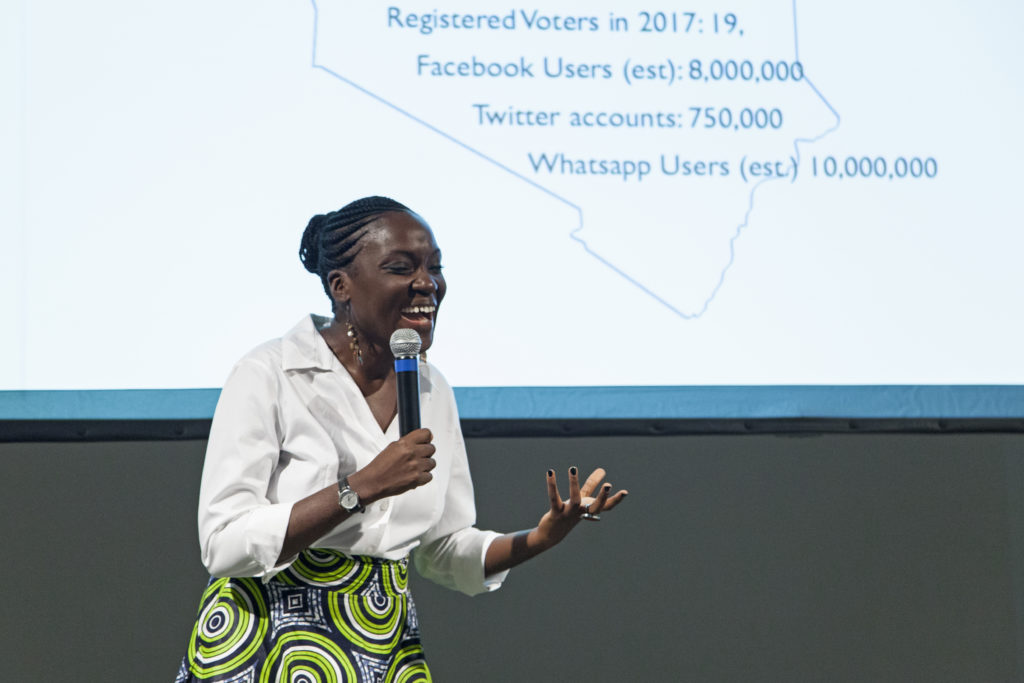
Rafiki, the innovative Kenyan film presented at the Cannes Film Festival, is now the subject of controversy over censorship due to its lesbian storyline. Nyabola is one of the African voices expressing the intention to support the movie’s distribution. “As something new and unexpected, this movie might make certain people within the country feel uncomfortable,” she said, “but it cannot be considered a vehicle for hate, promoting homosexuality in violation of moral values.” It is essential not to confuse actual hate speech with something labelled as hate speech to discredit it. Hate speech is intended to offend, insult, intimidate, or threaten an individual or group based on an attribute, such as sexual orientation, religion, colour, gender, or disability. The writer from Nairobi reminded the audience that when we talk about hate speech, it is important to focus on how it makes people feel and what it wants to accomplish. We should always consider that we regulate hate speech since it creates a condition in which social, political and economic violence is fed, affecting how we think about groups and individuals (and not just because it is offensive).
Nyabola indicated few key factors that she considers able to increase the consequences of hate speech and manipulation on social media. Firstly, information travels fast and can remain insulated. Whilst Twitter is a highly public space where content and comments flow freely, Facebook is a platform where you connect just with a smaller group of people, mostly friends, and WhatsApp is based on groups limited to a small number of contacts. The smaller the interaction sphere is, the harder it is for fact-checkers to see when and where rumours and hate speech go viral. It is difficult to find and stop them and their impact can be calculated just once they have already spread quickly and widely. Challenges which distinguish offline hate speech and manipulation from online ones are also related to the way information moves today among people supporting each other without a counterpart and without anyone being held to account.
Nowadays Kenya boasts an increasingly technological population, though not all rural areas have as yet been able to benefit from the country being one of the most connected ones in sub-Saharan Africa. In this context, reports indicate that since 2013 the British consulting firm Cambridge Analytica had been working in the country to interfere with elections, organizing conventions, orchestrating campaigns to sway the electorate away from specific candidates. It shall be no surprise that the reach of Cambridge Analytica extended well beyond United Kingdom and USA. In her speech, Nyabola expressed her frustration as she sees that western media focus their attention on developing countries just when they fear a threat of violence coming from there, ignoring that the rest of the world is also a place for innovation and decision making too.
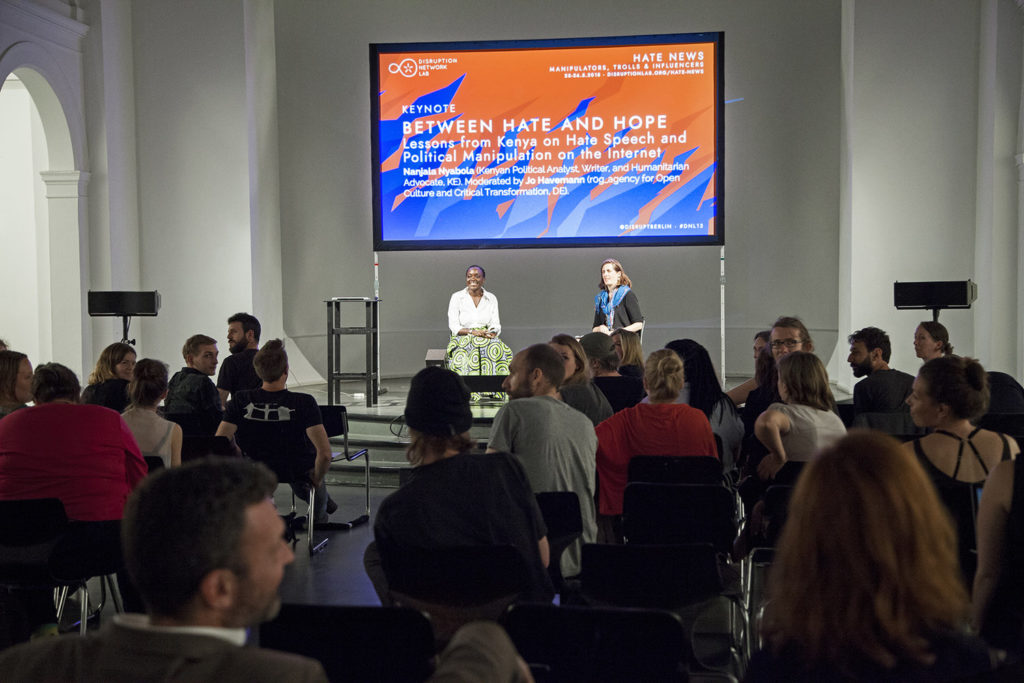
Kenya has one of the highest rates of Internet penetration in Africa with millions of active Kenyan Facebook and Twitter accounts. People using social media are a growing minority and they are learning how to defeat misinformation and manipulation. For them social media can become an instrument for social change. In the period of last year’s election none of the main networks covered news related to female candidates until the campaigns circulating on social media could no longer be ignored. These platforms are now a formidable tool in Kenya used to mobilize civil society to accomplish social, gender and economic equality. This positive look is hindered along the way by the reality of control and manipulation.
Most of the countries globally currently have no effective legal regulation to safeguard their citizens online. The GDPR legislation now in force in the EU obliges publishers and companies to comply with stricter rules within a geographic area when it comes to privacy and data harvesting. In Africa, national institutions are instead weaker, and self-regulation is often left in the hands of private companies. Therefore, citizens are even more vulnerable to manipulation and strategic hate speech. In Kenya, which still doesn’t have an effective data protection law, users have been subject to targeted manipulation. “The effects of such a polluted ecosystem of misinformation has affected and changed personal relationships and lives for good,” said the writer.
On social media, without regulations and control, hatred and discriminations can produce devastating consequences. Kenya is just one of the many countries experiencing this. Hate speech blasted on Facebook at the start of the Rohingya crisis in Myanmar. Nyabola criticized that, as in many other cases, the problem was there for all, but the company was not able to combat the spread of ethnic based discrimination and hate speech.
Moving from the interconnections of traditional and online media in Kenyan misinformation ecosystem, the second part of the day focused on privacy implications of behavioural profiling on social media, covering the controversy about Cambridge Analytica. The Friday’s panel opened with the analyses of David Carroll, best known as the professor who filed a lawsuit against Cambridge Analytica in the UK to gain a better understanding of what data the company had collected about him and to what purpose. When he got access to his voter file from the 2016 U.S. election, he realized the company had been secretly profiling him. Carroll was the first person to receive and publish his file, finding out that Cambridge Analytica held personal data on the vast majority of registered voters in the US. He then requested the precise details on how these were obtained, processed and used. After the British consulting firm refused to disclose, he decided to pursue a court case instead.
As Carroll is a U.S. citizen, Cambridge Analytica took for granted that he had neither recourse under federal U.S. legislation, nor under UK data protection legislation. They were wrong. The legal challenge in British court case that centred on Cambridge Analytica’s compliance with the UK Data Protection Act of 1998 could be applied because Carroll’s data was processed in the United Kingdom. The company filed for bankruptcy not long after it was revealed that it used the data of 87 million Facebook users to profile and manipulate them, likely in contravention of UK law. Professor Carroll could never imagine that his activity would demolish the company.
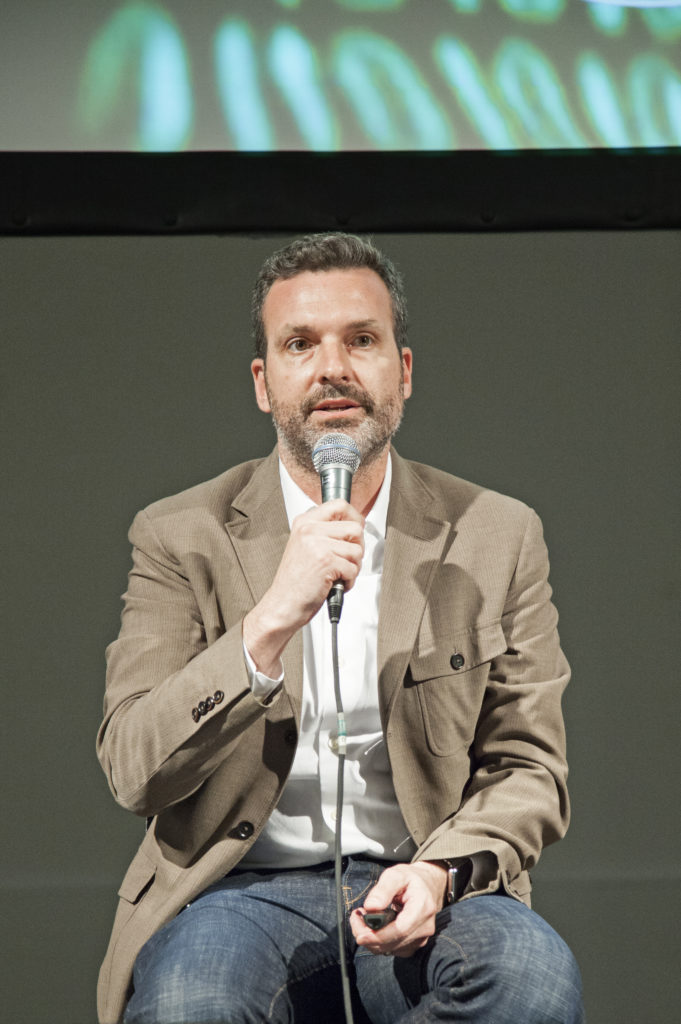
Cambridge Analytica, working with an election management firm called SCL Group, appears to have been a propaganda machine master, able to manipulate voters through the combination of psychometric data. It exploited Facebook likes and interactions above all. Its technique disguised attempts at political manipulation since they were integrated in the online environment.
Carroll talked about how technology and data were used to influence elections and popular voting for the first time in countries like USA and UK, whereas for a much longer time international campaign promoters were hired to act on an international scale. In Carroll’s opinion Cambridge Analytica was an ‘oil spill’ moment. It was an epiphany, a sudden deep understanding of what was happening on a broader scale. It made people aware of the threat to their privacy and the fact that many other companies harvest data.
Since 2012 Facebook and Google have been assigning a DoubleClick ID to users, attaching it to their accounts, de-anonymizing and tracking every action. It is an Ad-tracker that gives companies and advertisers the power to measure impressions and interactions with their campaigns. It also allows third-party platforms to set retargeting ads after users visit external websites, integrated with cookies, accomplishing targeted profiling at different levels. This is how the AdTech industry system works. Carroll gave a wide description of how insidious such a technique can be. When a user downloads an app to his smartphone to help with sport and staying healthy, it will not be a secret that what was downloaded is the product of a health insurance or a bank, to collect data of potential customers, to profile and acquire knowledge about individuals and groups. Ordinary users have no idea about what is hidden under the surface of their apps. Thousands of companies are synchronizing and exchanging their data, collected in a plethora of ways, and used to shape the messages that they see, building up a tailor-made propaganda that would not be recognizable, for example, as a political aid. This mechanism works in several ways and for different purposes: to sell a product, to sell a brand or to sell a politician.
In this context, Professor Carroll welcomed the New European GDPR legislation to improve the veracity of the information on the internet to create a safer environment. In his dissertation, Carroll explained that the way AdTech industry relates to our data now contaminates the quality of our lives, as singles and communities, affecting our private sphere and our choices. GDPR hopefully giving consumers more ownership over their data, constitutes a relevant risk for companies that don’t take steps to comply. In his analyses the U.S. professor pointed out how companies want users to believe that they are seriously committed to protecting privacy and that they can solve all conflicts between advertising and data protection. Carroll claimed though that they are merely consolidating their power to an unprecedented rate. Users have never been as exposed as they are today.
Media companies emphasize the idea that they are able to collect people’s data for good purposes and that – so far – it cannot be proved this activity is harmful. The truth is that these companies cannot even monitor effectively the Ads appearing on their platforms. A well-known case is the one of YouTube, accused of showing advertisements from multinational companies like Mercedes on channels promoting Nazis and jihad propaganda, who were monetizing from these ads.
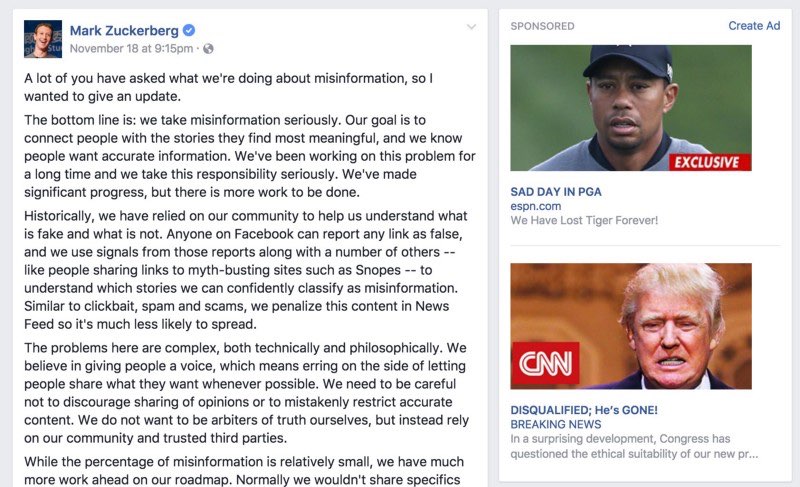
Carroll then focused on the industry of online advertisement and what he called “the fraud of the AdTech industry.” Economic data and results from this sector are unreliable and manipulated, as there are thousands of computers loading ads and making real money communicating to each other. This generates nowadays a market able to cheat the whole economy about 11 billion dollar a year. It consists of bots and easy clicks tailor-made for a user. The industries enabled this to happen and digital advertising ecosystem has evolved leading to an unsafe and colluded environment.
Alphabet and Facebook dominate the advertising business and are responsible for the use of most trackers. Publishers as well as AdTech platforms have the ability to link person-based identifiers by way of login and profile info.
Social scientists demonstrated that a few Facebook likes can be enough to reveal and accurately predict individual choices and ideas. Basic digital records are so used to automatically estimate a wide range of personal attributes and traits that are supposed to be part of a private sphere, like sexual orientation, religious beliefs, or political belonging. This new potential made politicians excited and they asked external companies to harvest data in order to generate a predictive model to exploit. Cambridge Analytica’s audience-targeting methodology was for several years “export-controlled by the British government”. It was classified as weapon by the House of Commons, at a weapons-grade communications tactics. It is comprehensible then that companies using this tech can easily sell their ability to influence voters and change the course of elections, polarizing the people using social networks.
The goal of such a manipulation and profiling is not to persuade everybody, but to increase the likelihood that specific individuals will react positively and engage with certain content, becoming part of the mechanism and feeding it. It is something that is supposed to work not for all but just for some of the members of a community. To find that small vulnerable slice of the U.S. population, for example, Cambridge Analytica had to profile a huge part of the electorate. By doing this it apparently succeeded in determining the final results, guiding and determining human behaviours and choices.
Bernd Fix, hacker veteran of the Chaos Computer Club in Germany, entered the panel conversation describing the development from the original principle of contemporary cybernetics, in order to contextualize the uncontrollable deviated system of Cambridge Analytica. He represented the cybernetic model as a control theory, by which a monitor compares what is happening into a system with a standard value representing what should be happening. When necessary, a controller adjusts the system’s behaviour accordingly to again reach that standard expected by the monitor. In his dissertation, Fix explained how this model, widely applied in interdisciplinary studies and fields, failed as things got more complex and it could not handle a huge amount of data in the form of cybernetics. Its evolution is called Machine Learning (or Artificial Intelligence), which is based on the training of a model (algorithm) to massive data sets to make predictions. Traditional IT has made way for the intelligence-based business model, which is now dominating the scene.
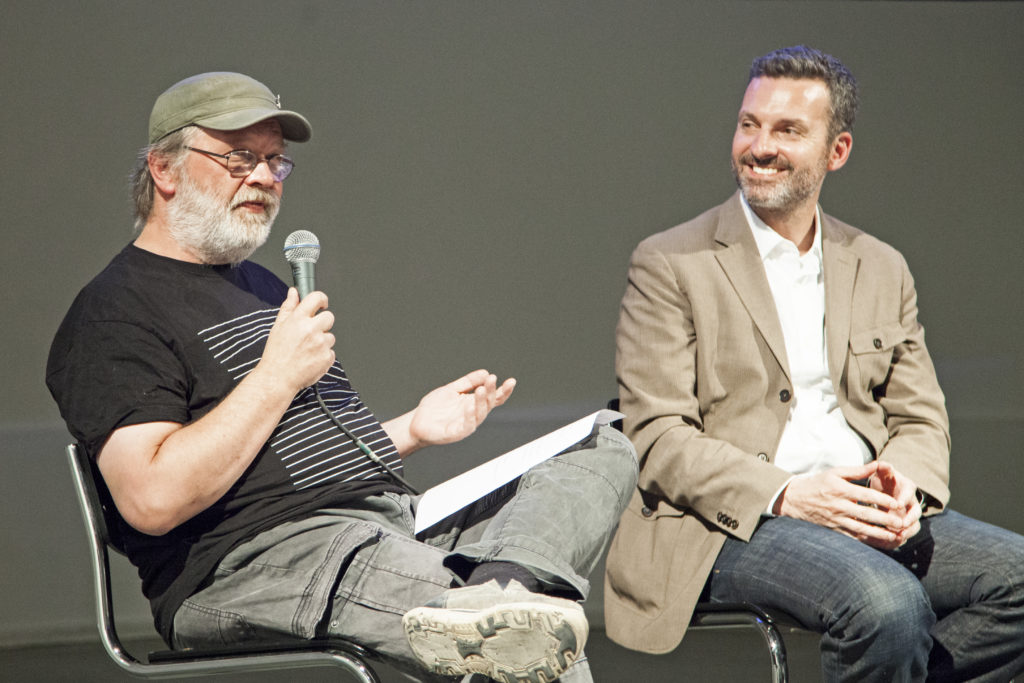
Machine learning can prognosticate with high accuracy what it is asked to, but – as the hacker explained – it is not possible to determine how the algorithm achieved the result. Nowadays most of our online environment works through algorithms that are programmed to fulfil their master’s interests, whereas big companies collect and analyse data to maximize their profit. All the services they provide, apparently for free, cost users their privacy. Thanks to the predictive model, they can create needs which convinces users to do something by subtle manipulating their perspective. Most of the responsibilities are on AdTech and social media companies, as they support a business model that is eroding privacy, rights and information. The challenge is now to make people understand that these companies do not act in their interest and that they are just stealing data from them to build up a psychometric profile to exploit.
The hacker reported eventually the scaring case of China’s platform “social credit,” designed to cover every aspect of online and offline existence and wanted by the national authorities. It is supposed to monitor each person and catalogue eventual “infractions and misbehaviours” using an algorithm to integrate them into a single score that rates the subjective fidelity into accepted social standards. A complex kind of ultimate social control, still in its prototype stages, but that could become part of our global future where socio-political regulation and control are governed by cybernetic regulatory circuits. Fix is not convinced that regulation can be the solution: to him, binding private actors and authorities to specific restriction as a way to hold them accountable is useless if people are not aware of what is going on. Most people around us are plugged into this dimension where the bargain of data seems to be irrelevant and the Big Three – Google, Facebook and Amazon – are allowed to self-determine the level of privacy. People are too often happy consumers who want companies to know their lives.
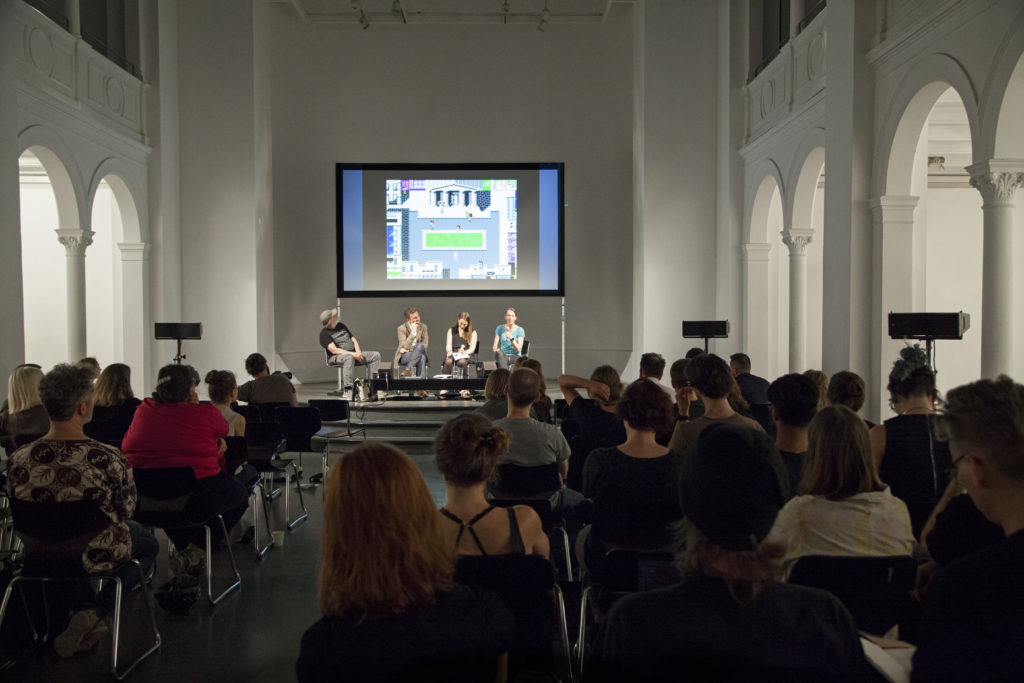
The last panellist of the afternoon was the artist and researcher Marloes de Valk, who co-developed a video game for old 1986 Nintendo consoles, which challenges the player to unveil, recognize and deconstruct techniques used to manipulate public opinion. The player faces the Propaganda Machine, level after level, to save the planet.
“Acid rains are natural phenomena”, “passive smoke doesn’t affect the health,” “greenhouse´s effects are irrelevant.” Such affirmations are a scientific aberration nowadays, but in the ‘80s there were private groups and corporations struggling to make them look like legitimate theorizations. The artist from Nederland analysed yesterday´s and today’s media landscape and, basing her research on precise misinformation campaigns, she succeeded in defying how propaganda has become more direct, maintaining all its old characteristics. De Valk looked, for example, for old documents from the American Tobacco Institute, for U.S. corporations‘leaked documents and also official articles from the press of the ´80s.
What remains is a dark-humoured game whose purpose is that of helping people to orientate inside the world of misinformation and deviated interests that affects our lives today. Where profit and lobbyism can be hidden behind a pseudoscientific point of view or be the reason rumours are spread around. The artist and researcher explained that what you find in the game represents the effects of late capitalism, where self-regulation together with complacent governments, that do not protect their citizens, shape a world where there is not room for transparency and accountability.
In the game, players get in contact with basic strategies of propaganda like “aggressively disseminate the facts you manufactured” or “seek allies: create connections, also secret ones”. The device used to play, from the same period of the misinformation campaigns, is an instrument that reminds with a bit of nostalgia where we started, but also where we are going. Things did not change from the ‘80s and corporations still try to sell us their ready-made opinion, to make more money and concentrate more power.
New international corporations like Facebook have refined their methods of propaganda and are able to create induced needs thus altering the representation of reality. We need to learn how to interact with such a polluted dimension. De Valk asked the audience to consider official statements like “we want to foster and facilitate free and open democratic debate and promote positive change in the world” (Twitter) and “we create technology that gives people the power to build community and bring the world closer together” (Facebook). There is a whole narrative built to emphasize their social relevance. By contextualising them within recent international events, it is possible to broad the understanding of what these companies want and how they manipulate people to obtain it.
What is the relation between deliberate spread of hate online and political manipulation?
As part of the Disruption Network Lab thematic series “Misinformation Ecosystems” the second day of the Conference investigated the ideology and reasons behind hate speech, focusing on stories of people who have been trapped and affected by hate campaigns, violence, and sexual assault both online and offline. The keynote event was introduced by Renata Avila, international lawyer from Guatemala and a digital rights advocate. Speaker was Andrea Noel, journalist from Mexico, “one of the most dangerous countries in the world for reporters and writers, with high rates of violence against women” as Avila remembered.
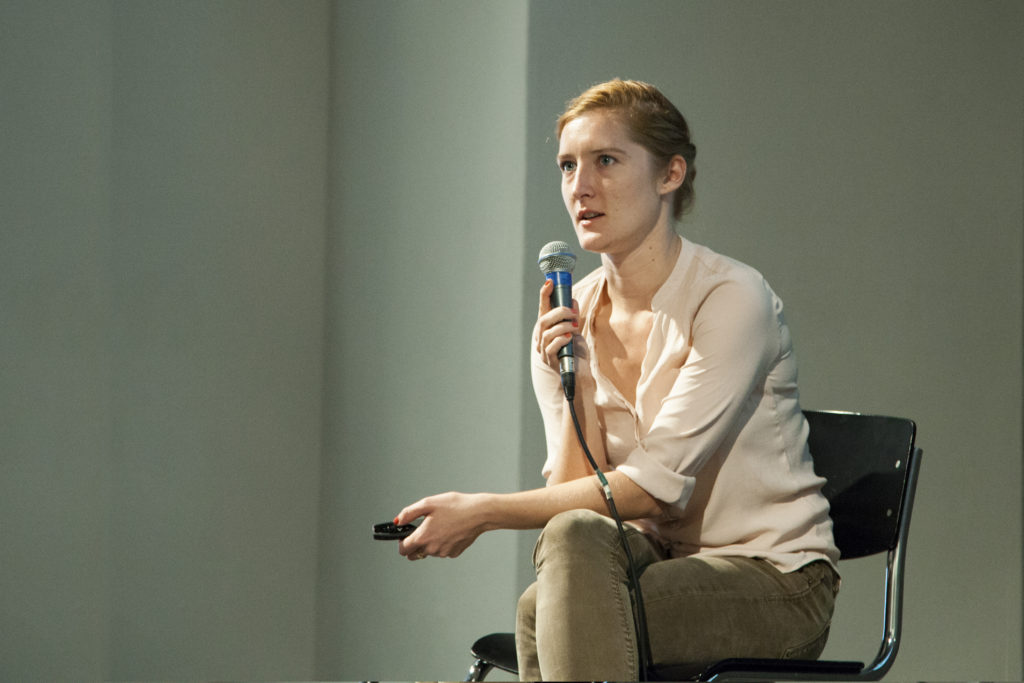
Noel has spent the last two years studying hate speech, fake news, bots, trolls and influencers. She decided to use her personal experience to focus on the correlation between misinformation and business, criminal organizations and politics. On March 8, 2016 it was International Women’s Day, and when Noel became a victim of a sexual assault. Whilst she was walking down the street in La Condesa (Mexico City) a man ran after her, suddenly lifted up her dress, and pulled her underwear down. It all lasted about 3 seconds.
As the journalist posted on twitter the surveillance footage of the assault commenting: “If anyone recognizes this idiot please identify him,” she spent the rest of the evening and the following morning facing trolls, who supported the attacker. In one day her name became trend topic on twitter on a national level, in a few days the assault was international news. She became so subject of haters and target of a misogynistic and sexist campaign too, which forced her to move abroad as the threat became concrete and her private address was disclosed. Trolls targeted her with the purpose of intimidating her, sending rape and death threats, pictures of decapitated heads, machetes and guns.
In Mexico women are murdered, abused and raped daily. They are victims of family members, husbands, authorities, criminals and strangers. Trolls are since ever active online promoting offensive hashtags, such as #MujerGolpeadaMujerFeliz, which translates as ‘a beaten woman is a happy woman’. It is a spectrum of the machismo culture affecting also many Latin American countries and the epidemic of gender-based violence and sexual assault.
Facts can be irrelevant against a torrent of abuse and hate toward journalists. Noel also received hundreds of messages telling her that there was a group of famous pranksters named “master trolls” that used to assault people on the streets in that same way, to make clicks and money out of it. Noel found out that they became best known for pulling down people’s pants and underwear in public, and that this brought them directly to popular tv shows. A profitable and growing business.
The journalist decided to face her trolls one by one and later realized that they were mostly part of an organized activity, not from a TV show but from a political group targeting her, a fact that made everything way more intricate. In two years she “got to know her trolls” as she said, and she studied their ecosystem. The description of the whole story is available on podcast Reply All.
Moving from her story, Noel focused in her second part of dissertation on the relation linking together trolls, criminal organizations, political and social manipulation. She described how, by using algorithms, bots and trolls, it is possible to generate political and election related postings on Facebook and Twitter that go viral. Manipulation comes also by weaponizing memes to propel hate speech and denigration, creating false campaigns to distract public attention from real news like corruption and atrocious cartel crimes.
Marginal voices and fake news can be spread by inflating the number of retweets and shares. Hashtags and trends are part of orchestrated system, where publishers and social media are not held in account for the fraud. Automated or semi-automated accounts, which manipulate public opinion by boosting the popularity of online posts and amplifying rumours. There is a universe of humans acting like bots, controlling hundreds of fake accounts.
Noel is particularly critical against Twitter. Its legal team expressed their engagement facing this “new major problem and novel threats”. The journalist hypothesized that the company had been well aware of the issue since 2010 but decided not to intervene to weed out organized groups manipulating its environment. Moreover, they knew that organized campaigns of discredit can water down the impact of real grassroot spontaneous protests and movements.
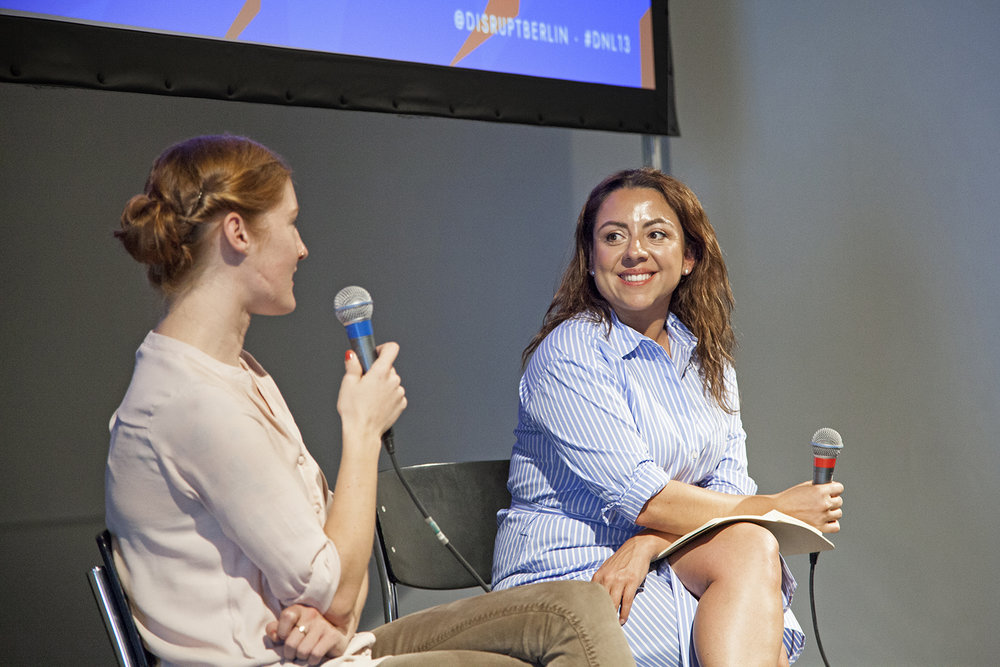
These manipulation techniques are responsible for digitally swaying the 2016 election toward the candidate Peña Nieto, organizing an army of thousands of bots to artificially generate trends on Twitter. Trends on this social media move up and down based on the number of tweets in a topic or hashtag related to the speed of sharing or retweeting. Trolls and bots can easily control the trending topic mechanism with their intense spamming activity.
Noel reported that false stories are shared via WhatsApp too, they are difficult to track and the most challenging to debunk. Her portrayal of social media and information market is not different from the description on the first day of the Conference by the writer Najala Nyabola.
To see the future of social media manipulation in politics we need to look at Mexico. All parties in Mexico have used bots to promote their own campaigns, journalists and opponents are overwhelmed with meaningless spam and denigrating hashtags. Offline, media landscape across Mexico is not free and organised crime has been using propaganda and manipulation to further its own aims. President Peña Nieto’s administration spent hundreds of millions of dollars on advertising, making media dependent and colluded. This system suppresses investigative articles and intimidates reporters.
The next general election is scheduled for July 1st. Andrea Noel warned that manipulation, trolls and bots are already irreversibly polluting the debate, in a country where more than 100 candidates have already been murdered (at the time of the Conference) and a history of corruption makes media and authorities unreliable in the eyes of people.
As a response, universities and NGOs formed an anti-fake news initiative called “Verificado” a platform that encourages people to forward stories found on social media using the hashtag #QuieroQueVerifiquen, ‘I want you to verify this’. The researchers of this project answer with fact-checking and publish their findings online. When asked, Noel expressed appreciation for the efforts of organizations and civil society. However, she is becoming increasingly disillusioned. She can see no immediate prospect of finding solutions able to slow or halt the impact of misinformation and hate speech online. In her opinion projects like Verificado can be easily hijacked. On the other side genuine social media campaigns are still an effective tool in the hands of civil society but the lack of trust in media fed by corruption often undermines all efforts to mobilize society, leading the public to routinely dismiss initiative to fight injustice.
When asked about the possibility to shut down social networks as a solution, Noel could not say she did not think of it. A first step could be to oblige media like Twitter and Facebook to guarantee users a safe environment where the economic interest comes after the need of a hate speech and manipulation free environment. The way they operate confirms they are content platforms and as such media entities they lack of transparency and accountability. These companies shirk their obligation for publishing responsibly. They should be held to account when they spin lies and allow groups to act unethically or against target single or communities.
The program of the second day continued with the presentation of the documentary The Cleaners, by Hans Block and Moritz Riesewieck, a project started in 2013 and in the cinemas at the time of the Conference. Initially, the authors wanted to learn more about the removal of pedo-pornographic content and sexualised images of children on Facebook. Social networks have largely pledged to work harder to identify and remove illegal, offensive and improper content, to limit violations and deny hate speech. But how does it work? Who decides what shall be cancelled and on what basis? These questions arose frequently during the first part of the Hate News conference and the German authors could answer it in relation to the social media Facebook, subject of their documentary.
The choice about what shall and what shall not belong the internet is a subjective one. Content moderators, who censor postings and content on platforms like Facebook, have indeed a controversial and central role. Their work is subject to almost no open scrutiny. However, it shapes attitudes and trends of both individuals and social groups, impacting the public discourse and the cultural dialectic. When a social network decides to censor content and delate videos about the effects of drone bombings, since by showing civilian victims Daesh builds its propaganda, it makes a choice that affects the narration of events and the perception of facts.
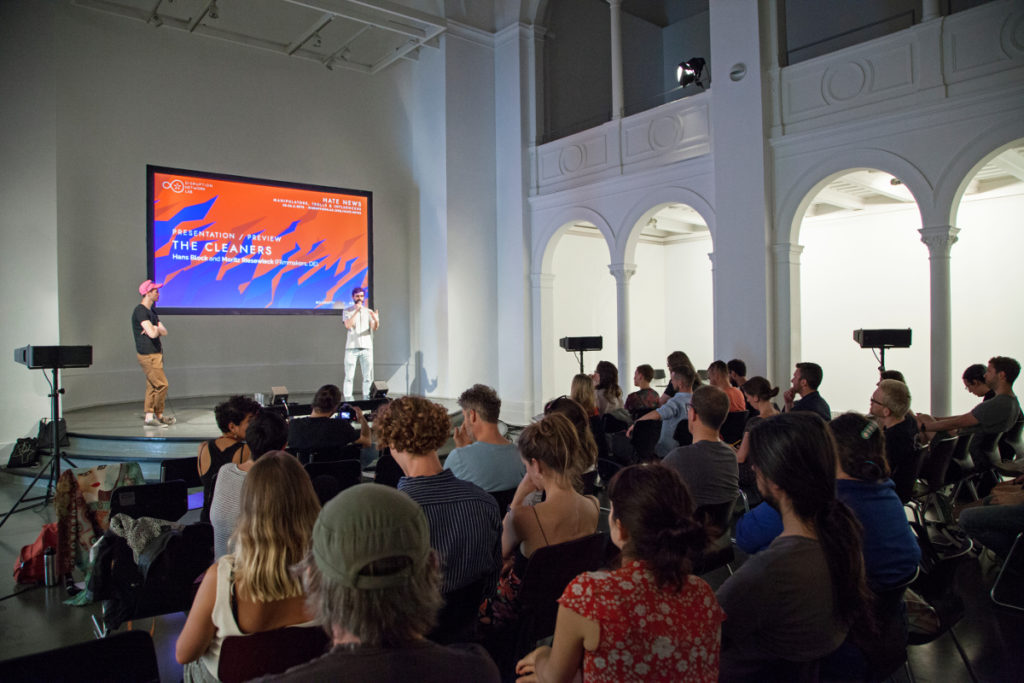
Investigating how the social media platform Facebook polices online content, and the direct impact of these decisions on the users’ interactions, Block and Riesewieck ended up in the Manila, where Facebook boasts its biggest department for content moderation, with more than 10,000 contractors. The Cleaners shows how this platform sees its responsibilities, both toward people moderating and censoring the content and its users. Based on interviews with Philippine content moderators at work, the documentary contributes to the debate about the public responsibilities of social media and online platforms for publishing, from political manipulation and propaganda to data protection.
Humans are still the first line of content moderation and they suffer horrible consequences and traumas for they see daily the worst of the web. Companies like Facebook have developed algorithms and artificial-intelligence tools able to work as a first level, but the most of this technology cannot substitute human capabilities. Certain content moderators describe themselves as custodians of moral values, as their work turns into decisions that can shape social media and consequently society. There are indeed countries where people consider Facebook as the Internet, ignoring that the world wide web is much more than that social media.
The authors go beyond, showing that Manila cleaners are influenced by their cultural background and social believes. They build a parallel between Philippines’ Catholicism and discourse about universal enslavement of humans to God and sacrifice, photographed in the years of the government of Rodrigo Duterte, controversial president who is leading a war against drugs and moral corruption, made of extrajudicial killings and a violent, abusive approach.
Despite denials by the company, cleaners in Manila also moderate Europeans’ posts and they are trained for that. A single world, a historical reference, together with a picture can make all the difference between an innocent joke and hate speech. Whilst memes can be used as weapons, for example by the alt-right groups or by reactionary movements against gender equality, cleaners have just few seconds to decide between removing and keeping a content, checking more than 35,000 images per day. The authors of the documentary explained how it is almost impossible for them to contextualize content. As a result, there is almost no control over their work, as a team leader can just proof 3% of what a cleaner does.
The last panel closing the conference on the second day was moderated by the curator, artist and writer Margarita Tsomou. American independent online harassment researcher Caroline Sinders focused her dissertation on online protests and political campaigns in the frame of the hate speech discourse. She recalled recent events able to pollute the public debate by creating chaotic and misleading messages to enhance a reactionary anti-progressive culture. Misogyny thrives on social media and hatred of women and entrenched prejudice against them are everywhere in the Internet. Fake online campaigns are often subtly orchestrated targeting women.
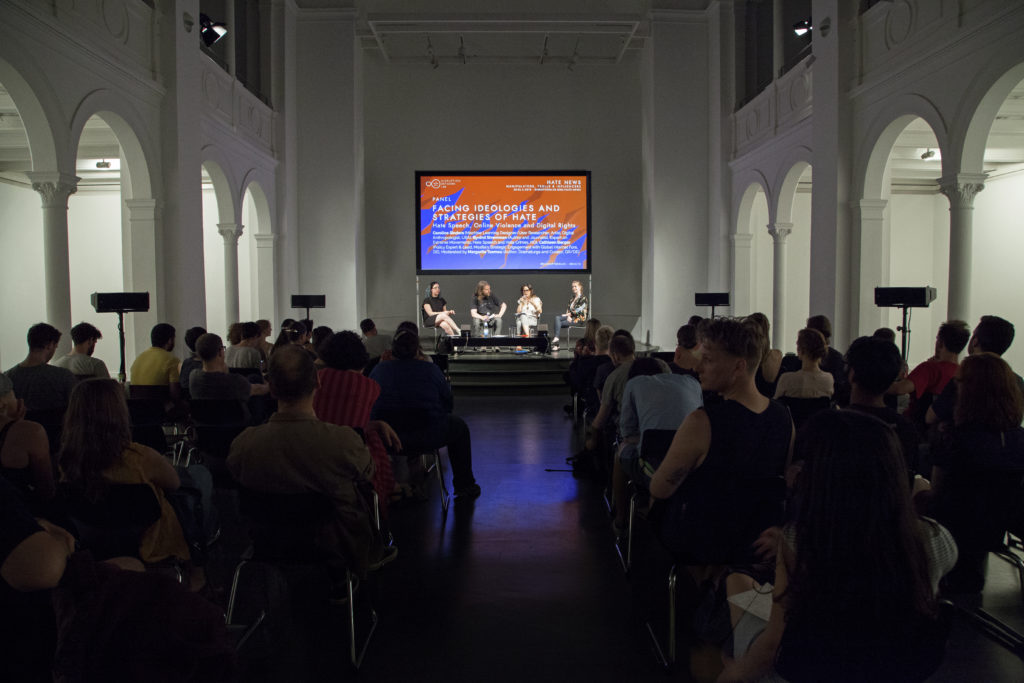
In 2014 on social networks appeared an organised action associated with the hashtag #EndFathersDay, presented as a feminist political campaign to eradicate the celebration of Father’s Day as a “celebration of patriarchy and oppression”. That campaign had nothing to do with feminism and grassroots movements, it was a harassment campaign against women, a fake with manipulated images and hundreds of trolls to feed a sentiment of hatred and hostility against activists for civil rights and equality.
It is not the only case of its genre. The #Gamergate campaign, that in 2014 targeted several women from the video game industry (on Twitter, Reddit, 4chan, and 8chan) falls into this context. The campaign was not immediately perceived as a harassment instrument due to attempts of making it appear as a movement against political correctness and bad journalistic ethics. It was though a misogynistic reactionary campaign against female game developers, that soon revealed its true face as right-wing sexist backlash. Under this hashtag women were indeed victims of doxing, threats of rape and death.
Sinders explained that in the last several years we have seen a shift from a sectorial market to a global dimension where we are all potentially identifiable as gamers. Video games and gaming culture are now mainstream. People are continuously connected to all kind of devices that enable the global gaming industry to generate more than 100 billion dollar every year. The Gamergate controversy reopened the debate that gaming is a world for (white) males, pointing out how the video game industry has a diversity problem, as sexism, racial and gender discrimination in video game culture appear to be a constant factor.
A relevant aspect of the controversy is related to how trolls organised and tried to reframe the narrative of the harassment campaign. Instead of a misogynistic and violent action, they claimed it was about journalistic integrity and candid reviewing, thus denouncing a collusion between the press and feminists and social critics. Most of the trolls and supporters were anonymous, ensuring that the campaign be defined merely by the harassment they have committed against women and as a reaction to what they reported as the increasing influence of feminism on video game culture.
Sinders concluded her speech explaining that organised actions and campaigns like those described above are structured on precise tactics and harassment techniques that have already entered in our vocabulary. Words like doxing, swatting, sealioning and dogpiling are neologisms that describe strategies of hate speech and harassment nowadays common.
The Norwegian journalist Øyvind Strømmen, author and managing editor of Hate Speech International, has extensively researched and written about how extreme right movements and religious fundamentalism are able to build an effective communication online and use the web as an infrastructure to strategically enhance their activities. He joined the panel explaining that despite his intense international activity, he has never been subjected to harassment and death threats like his female colleagues, whilst he finds daily-organised activities to sow hatred and intolerance to repress women.
Cathleen Berger, former International cyber policy coordination staff at the German Foreign Office and currently lead of Mozilla’s strategic engagement with global Internet fora, closed the conference with an analyses of the new German NetzDG legislation, defined by media as an extreme example of efforts by governments to make social media liable for what circulates on their pages. The law was adopted at the end of 2017 to combat illegal and harmful content on social media platforms. It is defined also as anti-hate-speech law as it was written in the historical context of the refugees’ mass migration to Europe and the new neo-nazi propaganda from political formations like the Alternative for Germany (AfD). At the time, fake news and racist material were shared online on several mainstream channels for the first time, with relevant impact on public opinion.
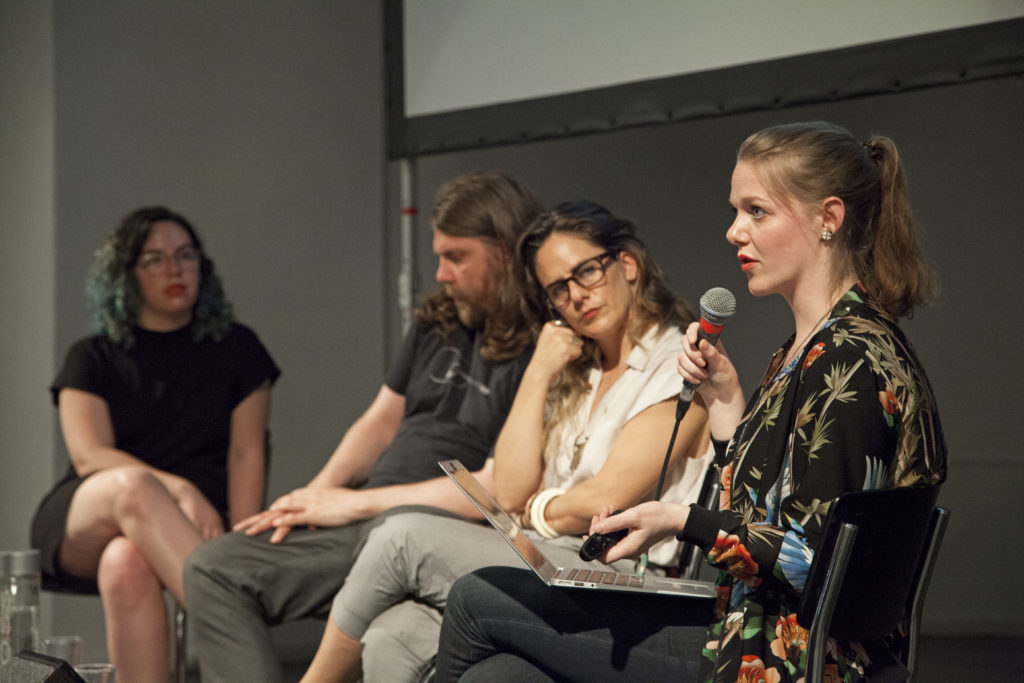
The new German law requires social media companies to provide users with a wide-ranging complaints structure to make sure that discriminatory and illegal posts can quickly be reported. It is left to social media platforms to decide if a certain reported content represents a promotion of or an incitement to terrorism, child abuse, hate or discrimination of any kind.
The law forces social media to act quickly too. Under NetzDG, social media platforms with more than 2 million users in Germany have 24 hours to remove posts reported by users for being illegal. Facebook, Twitter and YouTube seem to be the law’s main focus. Failure to comply with the law carries a fine up to € 50 million.
The German government’s Network Enforcement Act has been criticised for its risks of controversial inadvertent censorship, limiting legitimate expressions of opinion and free speech. Once again private companies, that are neither judges nor any kind of public authority, have the power to decide whether reported content is in fact unlawful.
All credit is due to Tatiana Bazzichelli and the Disruption Network Lab, who provided once again a forum for discussion and exchange of information that provokes awareness on matters of particular concern from the different perspectives of the guests – especially women – able to photograph with their international activities and their researches several topical issues.
This 13th Conference (https://www.disruptionlab.org/hate-news/) was a valid opportunity to discuss and rationalise the need for civil society to remain globally vigilant against new forms of hate speech, manipulation and censorship. Ideological reasons behind hate speech and online manipulation are on the table and the framing is clear enough to hold online media and publishing companies accountable for the spread of frauds, falsehood and discrimination within their networks.
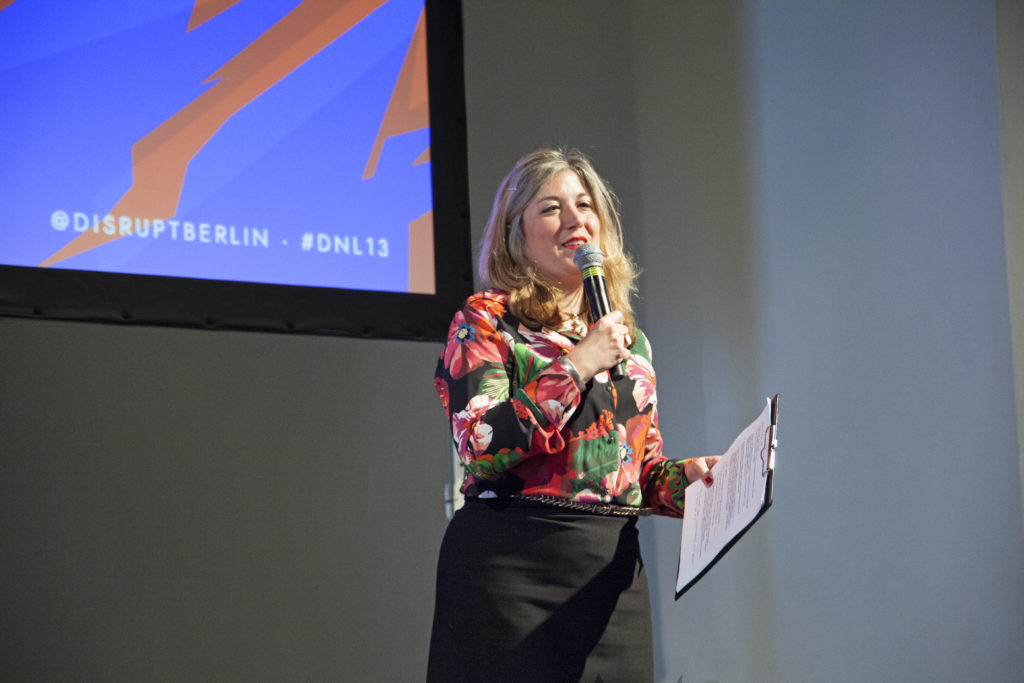
Companies like Facebook and Twitter have demonstrated their inability to recognise real threats and appear to be thinking of profit and control without considering the repercussions that their choices have. However, we are delegating them the power to define what is legal and what is not. Their power of censorship shapes society, interfering with fundamental rights and freedoms, feeding conflicts and polarization. This legal response to hate speech and manipulation in the context of the battle for privacy and civil rights is completely inadequate.
Propaganda and hate speech have historically been tools used in all countries to influence decision making and to manipulate and scare public opinion. Forms of intrusive persuasion that use rumours or manipulation to influence people’s choices, beliefs and behaviours are now occupying the web too. Individuals should be able to give due value to their online interactions, focusing on the risks that they run when they click on something. There is too little awareness of how companies, aggressive trolls, criminals, private groups and advertisers subtly manipulate online environment for political and economic interest.
Such a corrupted online ecosystem – where almost nothing of what we meet can be trusted and where individuals and communities are exposed to private interest – generates often hate campaigns targeting women and minorities, normalising crimes, reactionary gender stereotyping and deplorable cultural customs. As all speakers suggested, Cyber-ethnography can be a worthwhile tool as an online research method to study communities and cultures created through computer-mediated social interaction. It could be helpful to study local online exchanges and find local solutions. By researching available data from its microcosmos, it is possible to prevent ethnic, socioeconomic, and political conflicts linked to the online activity of manipulators, destructive trolls and influential groups, to disrupt the insularity of closed media and unveil the economic and political interest behind them.
HATE NEWS: Manipulators, Trolls & Influencers
May 25-26, 2018 – Kunstquartier Bethanien, Berlin
disruptionlab.org/hate-news/
Info about the 13th Disruption Network Lab Conference, its speakers and thematic is available online here:
https://www.disruptionlab.org/hate-news
To follow the Disruption Network Lab sign up for its Newsletter and get informed about its Conferences, ongoing researches and projects. The next Disruption Network Lab event is planned for September. Make sure you don´t miss it!
The Disruption Network Lab is also on Twitter and Facebook
Photocredits: Maria Silvano for Disruption Network Lab
Our times are characterized by the accelerating collapse and redrawing of multiple borders: between nation states, personal identities, and the responsibilities we have for each other. Also between the old distinctions, work and pleasure.
Some leaders as part of the new world order, tell us through their political actions and their fashion accessories, that they “Just Don’t Care”. This “political art-form”[note]Rebecca Solnit: Not Caring is a Political Art Form: On Melania Trump and the Politics of Disconnection lithub.com/rebecca-solnit-not-caring-is-a-political-art-form/[/note] of not caring permits an insidious spread of hatred online and on the ground. In recent times, the digital condition has lent it’s networks and platforms to this poisonous, rhetorical hyperbole, turning against immigrants, and others who do not fit into the framework of a western world, oligarch orientated vision. Mass extraction and manipulation of social data has facilitated the circulation of fake news and the production of fear, anxiety and uncertainty. Together these fuel the machine of structural violence adding to the already challenging conditions created by Austerity policies, growing debt and poverty.
In the face of these outlandish difficulties our digital tools and networks – taken up with a spirit of cultural comradeship. More inspiring narratives are emerging from across disciplines and backgrounds, to experiment with new solidarity-generating approaches that critique and build platforms, infrastructures and networks, offering new possibilities for reassessing and re-forming citizenship and rights.
The exhibition and labs for Playbour – Work, Pleasure, Survival, have created new contexts for collaboration. Artists (from the local area and internationally), game designers and architects, come together with researchers from psychology and neuroscience addressing the data driven gamification of life and everything.
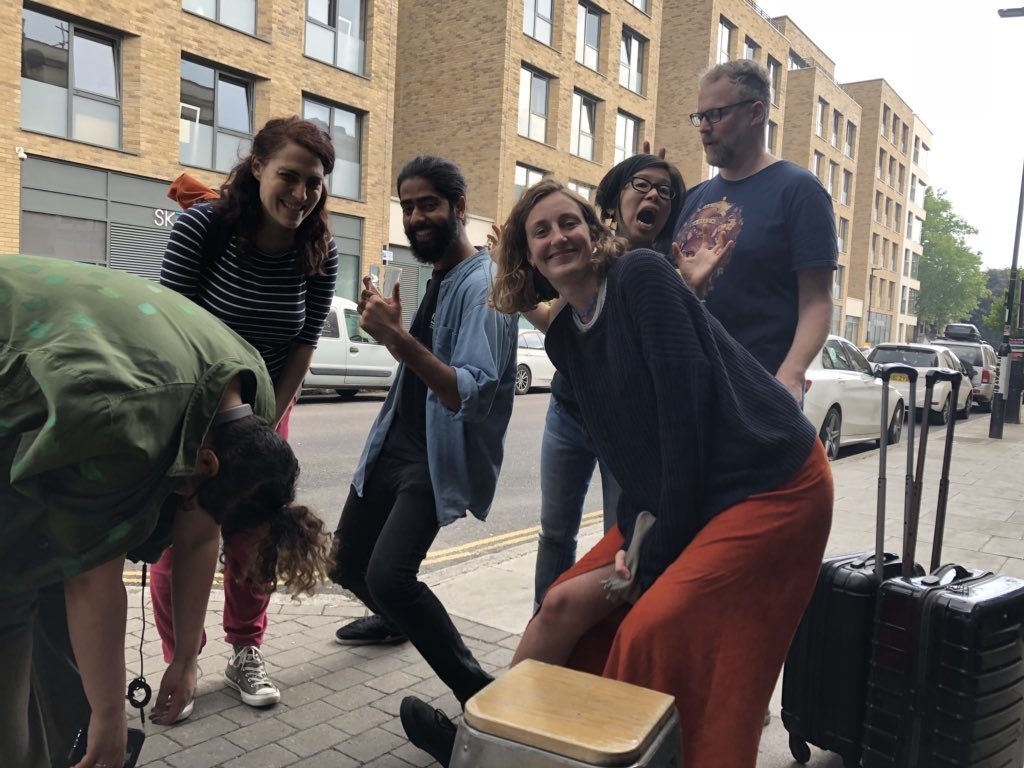
In her interview, the curator Dani Admiss discusses how they reassess the power relationships of the gallery, park users and the local authorities, asking who owns the cultural infrastructure and public amenities – and so create a polemic to open up questions of public value. The exhibition is open every weekend through 14 July to 19 August 2018.
The artists featured in Transnationalisms exhibition curated by James Bridle address the effect on our bodies, our environment, and our political practices of unstable borders.
“They register shifts in geography as disturbances in the blood and the electromagnetic spectrum. They draw new maps and propose new hybrid forms of expression and identity.”[note]Transnationalisms. Aksioma – Institute for Contemporary Art, Ljubljana, Slovenia.
aksioma.org/transnationalisms/[/note]

“Thiru Seelan, a Tamil refugee who arrived in the UK in 2010 following detention in Sri Lanka during which he was tortured for his political affiliations, dances on an East London rooftop. His movements are recorded by a heat sensitive camera more conventionally often used to monitor borders and crossing points, where bodies are identified through their thermal signature.”[note]Regine Debatty. We Make Money Not Art. Democracy, locative, politics, Transnationalisms – Bodies, Borders, and Technology. Part 1. The exhibition. May 14, 2018. we-make-money-not-art.com/transnationalisms-bodies-borders-and-technology-part-1-the-exhibition/[/note]
The show opens at Furtherfield from September 14th to October 26th 2018, touring as part of State Machines the EU cooperation which investigates the new relationships between states, citizens and the stateless made possible by emerging technologies.
We have another interview with artist and activist Cassie Thornton, where we discuss her current project Hologram, which examines health in the age of financialization, and works to reveal the connection between the body and capitalism. Her interview focuses on a series of experiments that actively counter the effects of indebtedness through somatic – or body – work including her focus on the way in which institutions produce or take away from the health of the artists and workers they “support”.
“In my work for the past decade, I have been developing practices that attempt to collectively discover what debt is and how it affects the imagination of all of us: the wealthy, the poor, the indebted, financial workers, babies, and anyone in-between.” Thornton
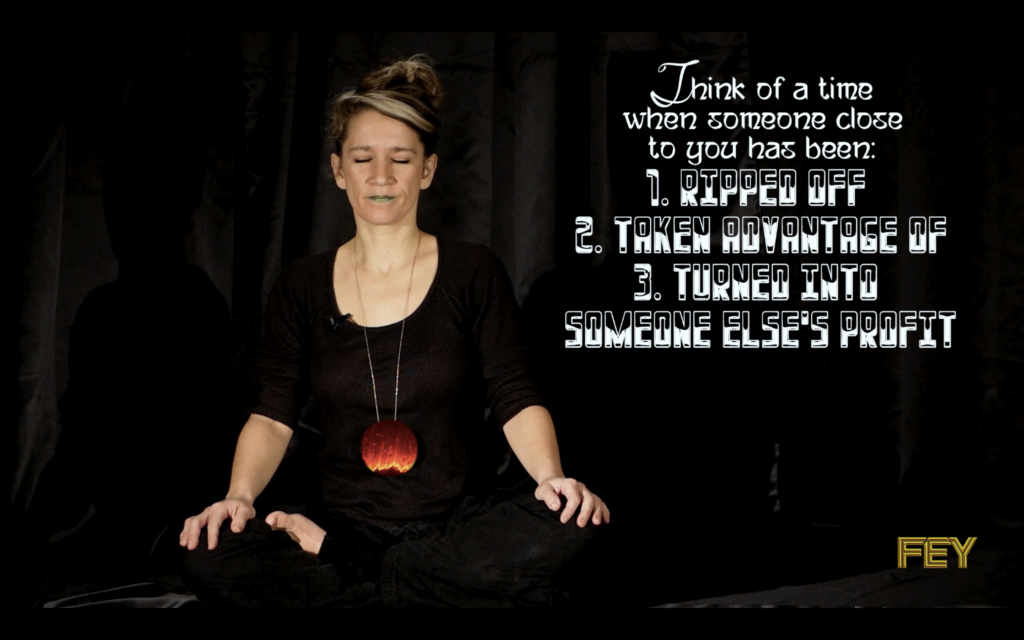
Finally I interview Tatiana Bazzichelli, artistic director and curator of the Disruption Network Lab, in Berlin, questions about art as Investigation of political misconducts and Wrongdoing. Since 2015, the Disruption Network Lab has cultivated a stage and a sanctuary for otherwise unheard and stigmatised voices to delve into and explore the urgent political realities of their existence at a time when the media establishment has no investment in truth telling for public interest.
“When the speakers are with us and open their minds to our topics, I feel that we are receiving a gift from them. I come from a tradition in which communities, networks and the sharing of experience were the most important values, the artwork by themselves.” Bazzichelli.
The programme creates a conceptual and practical space in which whistleblowers, human right advocates, artists, hackers, journalists, lawyers and activists are able to present their experience, their research and their actions – with the objective of strengthening human rights and freedom of speech, as well as exposing the misconduct and wrongdoing of the powerful.
To conclude, all one needs to say is…
“Whether in the variety of human, backgrounds and perspectives, biodiversity or diversity of technologies, coding languages, devices, or technological cultures. Diversity is Proof of Life.” Ruth Catlow, 2018.
Since the financial crash 10 years ago, we’ve learned that it tends to be everyday people, on the ground, who pick up the pieces and not governments. Millions have been dragged into poverty while those who caused the “crisis”, after creating dangerously high levels of private debt, remain unscathed. [1] The UK Conservative government’s response was an Austerity policy, driven by a political desire to reduce the size of the welfare state. Amadeo Kimberly says, “austerity measures tend to worsen debt […] because they reduce economic growth.”[2] The effect has been devastating, creating all together, more homelessness, precarious working conditions and thus pushing working communities, deeper into debt. In the UK, the NHS is being privatized as we speak. According to a CNBC report, medical bills were the biggest cause of bankruptcies in the U.S in 2013, with 2 million people adversely affected. [3]
The work of artist and activist, Cassie Thornton is included in the upcoming Playbour– Work, Pleasure, Survival exhibition at Furtherfield, curated by Dani Admiss. In this interview I wanted to explore the following questions as revealed in her current Hologram project:
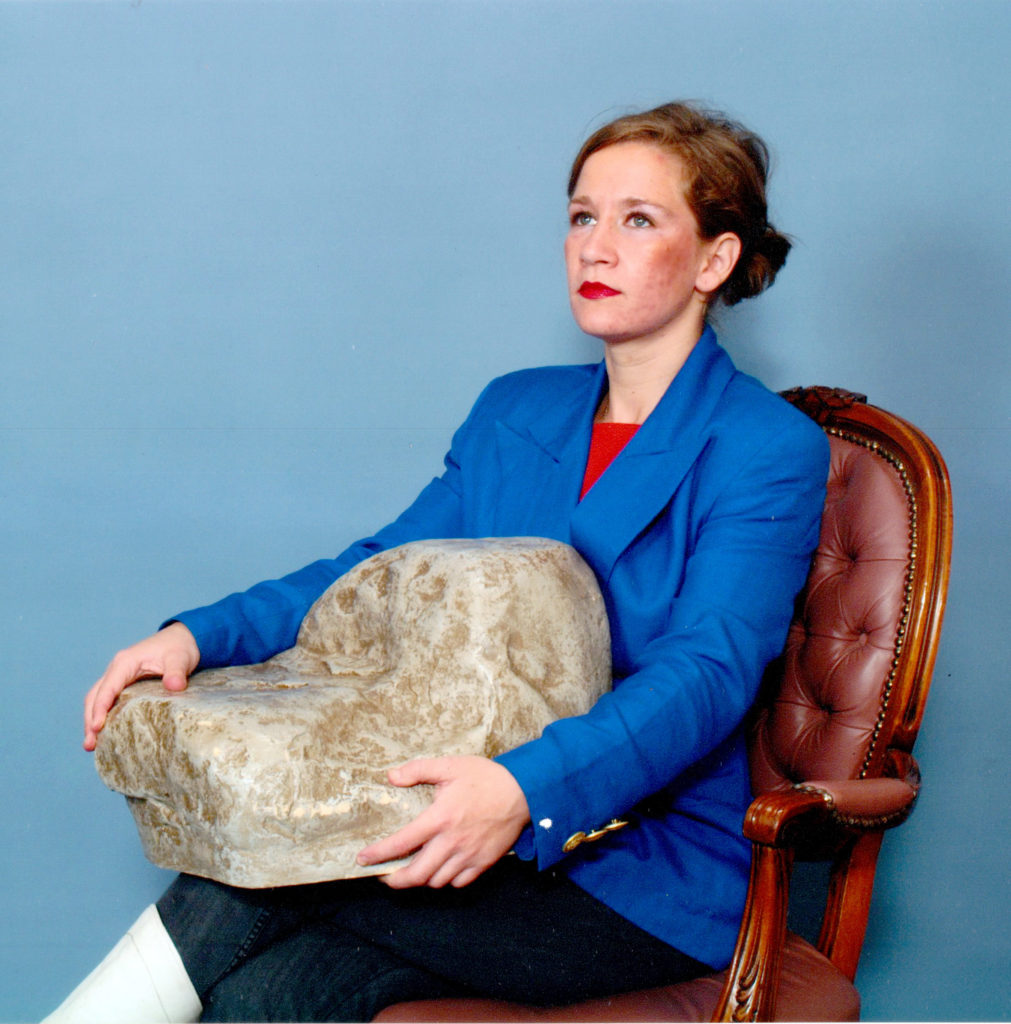
Cassie Thornton is an artist and activist from the U.S., currently living in Canada. Thornton is currently the co-director of the Reimagining Value Action Lab in Thunder Bay, an art and social center at Lakehead University in Ontario, Canada.
Thornton describes herself as feminist economist. Drawing on social science research methods develops alternative social technologies and infrastructures that might produce health and life in a future society without reproducing oppression — like those of our current money, police, or prison systems.
Marc Garrett: Since before the 2008 financial collapse, you have focused on researching and revealing the complex nature of debt through socially engaged art. Your recent work examines health in the age of financialization and works to reveal the connection between the body and capitalism. It turns towards institutions once again to ask how they produce or take away from the health of the artists and workers they “support”. This important turn towards health in your work has birthed a series of experiments that actively counter the effects of indebtedness through somatic work, including the Hologram project.
The social consequences of indebtedness, include the formatting of one’s relationship to society as a series of strategies to (competitively) survive economically, alone, to pay the obligations that you has been forced into. It takes so much work to survive and pay that we don’t have time to see that no one is thriving. Those whom most feel the harsh realities of the continual onslaught of extreme capitalism, tend to feel guilty, and/or like a failure. One of your current art ventures is the Hologram, a feminist social health-care project, in which you ask individuals to join and provide accountability, attention, and solidarity as a source of long term care.
Could you elaborate on the context of the project is, as well as the practices, and techniques, you’ve developed?
CT: Many studies show that the experience of debt contributes to higher levels of anxiety, depression, and suicide. Debt disables us from getting the care we need and leads us away from recognizing ourselves as part of a cooperative species: it is clear that debt makes us sick. In my work for the past decade, I have been developing practices that attempt to collectively discover what debt is and how it affects the imagination of all of us: the wealthy, the poor, the indebted, financial workers, babies, and anyone in-between. Under the banner of “art” I have developed rogue anthropological techniques like debt visualization or auxiliary credit reporting to see how others ‘see’ debt as an object or a space, and how they have been forced to feel like failures in an economy that makes it hard for anyone (especially racialized, indigenous, disabled, gender non-binary, or ‘immigrant’) to secure the basic needs (housing, healthcare, food and education) they need to survive, because it is made to enrich the already wealthy and privileged.
“The rise of mental health problems such as depression cannot be understood in narrowly medical terms, but needs to be understood in its political economic context. An economy driven by debt (and prone to problem debt at the level of households) will have a predisposition towards rising rates of depression.”[4]
After years of watching the pain and denial around debt grow for individuals and entire societies, I was so excited to fall into a ‘social practice project’ that has the capacity to discuss and heal some of this capital-induced sickness through mending broken trust and finding lost solidarity. This project is called the hologram.
MG: What kind of people were involved?
CT: The entire time I lived in the Bay Area I was precarious and indebted. I only survived, and thrived, because of the networks of solidarity and mutual aid I participated in. As the city gentrified beyond the imagination, I was forced to leave. I didn’t want to let those networks die. So, at first, the people who were involved were like me– people really trying to have a stake in a place that didn’t know how to value people over real estate and capital
The hologram project developed when, as I was leaving the city, I had invited a group of precariously employed, transient activists and artists to get together in the Bay Area for a week of working together. We aimed to figure out ways to share responsibility for our mutual economic and social needs. This project was called the “Intentional Community in Exile (ICE)” [the ICE pun was always there, now an ever more intense reference in the public eye] and it grew out of an opportunity offered by Heavy Breathing to choreograph an event at The Berkeley Art Museum. They allowed me to go above and beyond my budget to invite a group of 8 women together from across the US to choreograph methods of mutual aid: sharing resources, discussing common problems and developing methods for cooperating to co-develop an economic and social infrastructure that would allow us to thrive together, interdependently. What would it mean for our work as activists and artists to feel that we had roots within an intentional community, even if we didn’t have the experience of property that makes most people feel at home?
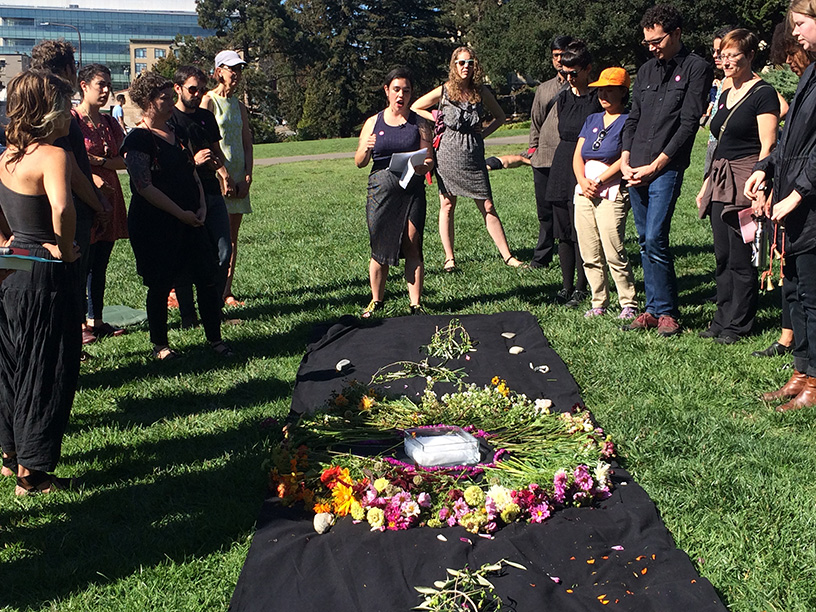

Facebook event: “In departing from the idea of a long term home, family, property, or ownership, ICE models a mutual aid society to sustain creative and political practices within a hostile economic system. This project is about finding ways to exit economic precarity by building human relationships instead of accumulating capital– or to make exile warm. After a one week convergence of a small group of collaborators, ICE presents a discussion and performance of life practices as well as frameworks for material and immaterial mutual support.”
The Hologram was one of many ideas that developed as part of this project. One of the group members, Tara Spalty, founder of Slowpoke Acupuncture, (and one of the two acupuncturists you will see at SF protests or homeless encampments) and I fell into this idea when combining our knowledge about the solidarity clinics in Greece, our growing indebtedness and lack of medical records, and the community acupuncture movement. Then the group brainstormed about what the process would be like to produce a viral network of peer support.
MG: What inspired you to do this project? (particularly interested in the Greek influences here and what this means to you)
CT: My practice of looking at debt became boring to me by 2015 as it became more and more clear that individual financial debt was a signal of a larger problem that was not being addressed. The hyper individualism produced by indebtedness allows us to look away from a much bigger deeper story of our collective debts, financial and otherwise. We don’t know what to do with these much bigger debts, which include sovereign debts, municipal debts, debts to our ancestors and grandchildren, debts to the planet, debts to those wronged by colonialism and racism and more. We find it so much easier to ignore them.
When visiting austerity-wracked Greece after living in Oakland, I noticed that Oakland appeared to have far more homeless people on the street. It made me realize that, while we label some places “in crisis,” the same crisis exists elsewhere, ultimately created and manipulated by the same financial oligarchs. The hedge funds that profit off of the bankruptcy in Puerto Rico are flipping houses in Oakland and profiting off of the debt of Greece. We’re all a part of the same global economic systems. The “crisis” in Greece is also the crisis Oakland and the crisis in London. For this reason, I have been interested in what we can all learn from activists, organizers and others in crisis zones, who see the conditions without illusions.
This led me to an interest in the the Greek Solidarity Clinic movement, which since “the crisis” there has mobilized nurses, doctors, dentists, other health professionals and the public at large to offer autonomous access to basic health care. I went to go visit some of these clinics with Tori Abernathy, radical health researcher. Another project using this social technology is called the Accountability Model, by the anonymous collective Power Makes Us Sick. These solidarity clinics are run by participant assembly and are very much tied in to radical struggles against austerity. But they have also been a platform for rethinking what health and care might mean, and how they fit together. The most inspiring example for me was in at a solidarity clinic in Thessaloniki, the second largest city in Greece. The “Group for a Different Medicine” emerged with the idea that they didn’t want to just give away free medicine, but to rethink the way that medicine happens beyond conventional models, including specifically things like gender dynamics, unfair treatment based on race and nationality and patient-doctor hierarchies. This group opened a workers’ clinic inside of an occupied factory called vio.me as place offer an experimental “healed” version of free medicine.
When new patients came to the clinic for their initial visit they would meet for 90 minutes with a team: a medical doctor, a psychotherapist and a social worker. They’d ask questions like: Who is your mother? What do you eat? Where do you work? Can you afford your rent? Where are the financial hardships in your family?
The team would get a very broad and complex picture of this person, and building on the initial interview they’d work with that person to make a one-year plan for how they could be supported to access and take care of the things they need to be healthy. I imagine a conversation: “Your job is making you really anxious. What can we do to help you with that? You need surgery. We’ll sneak you in. You are lonely. Would you like to be in a social movement?” It was about making a plan that was truly holistic and based around the relationship between health, community and struggles to transform society and the economy from the bottom-up . And when I heard about it, I was like: obviously!
So the Hologram project is an attempt by me and my collaborators in the US and abroad to take inspiration from this model and create a kind of viral network of non-experts who organize into these trio/triage teams to help care for one another in a complex way. The name comes from a conversation I had with Frosso, one of the members of the Group for a Different Medicine, who explained that they wanted to move away from seeing a person as just a “patient”, a body or a number and instead see them as a complex, three dimensional social being, to create a kind of hologram of them.
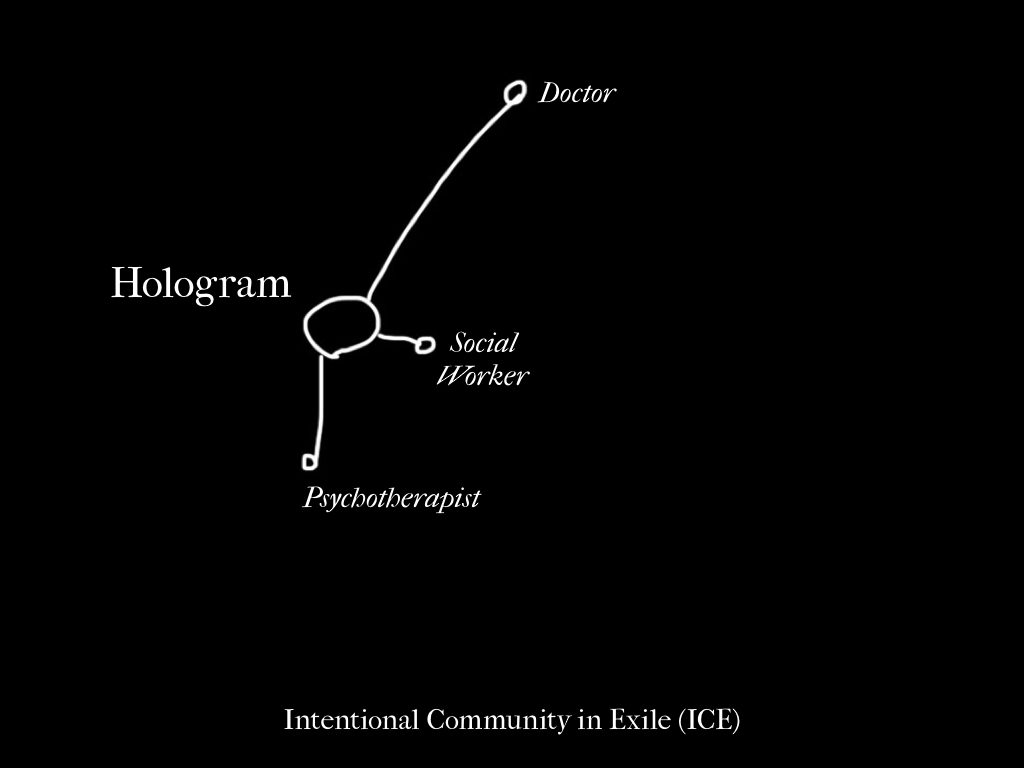
MG: Could you explain how the viral holographic care system works?
CT: Based on the shape above, we can see that we have three people attending to one person, and each person represents a different quality of concern. In this new model, these three people are not experts or authorities, but people willing to lend attention and to do co-research, to be a scribe, or a living record for the person in the center, the Hologram. We call these three attendees ‘patience’. Our aim is to translate the Workers’ Clinic project to a peer to peer project where the Hologram receives attention, curiosity and long term commitment from the patience looking after her, who are not professionals. Another project using this social technology is called the Accountability Model, by the anonymous collective Power Makes Us Sick.
So the beginning of the process, like that of the Workers’ Clinic, is to perform an initial intake where the three patience ask the Hologram questions which are provided in an online form, about the basic things that help or hurt her social, physical and emotional/mental health. When this (rather extended) process is complete, the Hologram will meet as a group every season to do a general check in. The goal of this process is to build a social and a physical holistic health record, as well as to continue to grow the patience understanding of the Hologram’s integrated patterns.
Ultimately, over time we hope to build trust and a sense of interdependence, so that if the Hologram meets a situation where she has to make a big health decision (health always in an expansive sense) about a medical procedure, a job, a move, she will have three people who can support her to see her lived patterns, to help her ask the right questions, and to support peer research so that the Hologram is not making big decisions unsupported.
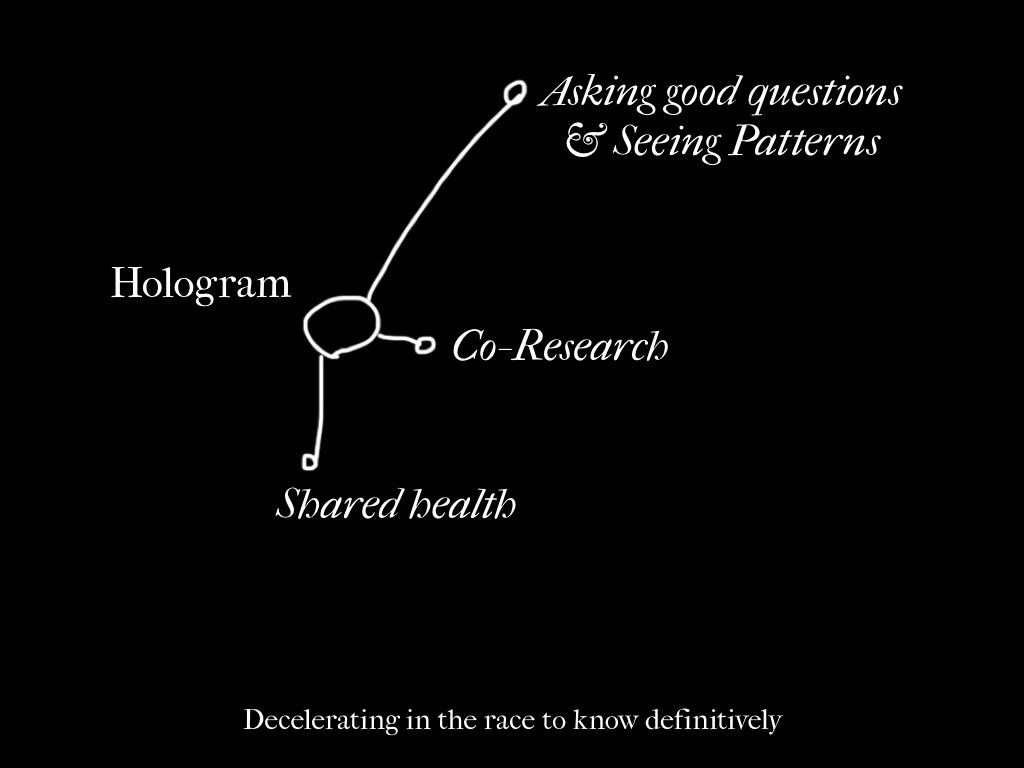
But, in order for the Hologram to receive this care without charge and guilt free, she needs to know that her patience are taken care of as she is. I think this is one part of the project that acknowledges and makes a practice built from the work of feminists and social reproductive theorists – you can’t build something new using the labor of people without acknowledging the work of keeping those people alive; reproducing the energy and care we need to overturn capitalism needs a lot of support. Getting support from someone feels so different if you know they are being, well taken care of. This is also how we begin to unbuild the hierarchical and authoritarian structures we have become accustomed to – with empty hands and empty pockets.
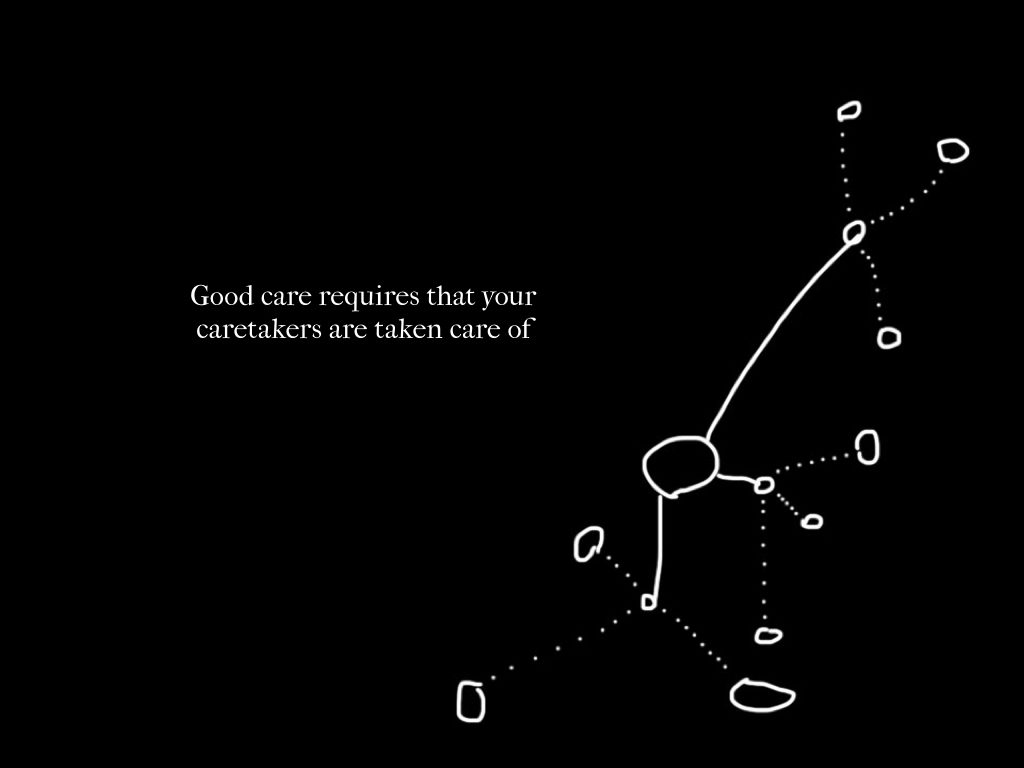
And then, the last important structural aspect of the Hologram project is the real kicker, and touches on the mystery of what it means to be human outside of Clientelist Capitalism – that the real ‘healing’ (if we even want to say it!) comes when the person who is at the center of care, turns outward to care for someone else. This, the secret sauce, the goal and the desired byproduct of every holographic meeting– to allow people to feel that they are not broken, and that their healing is bound up in the health and liberation of others.
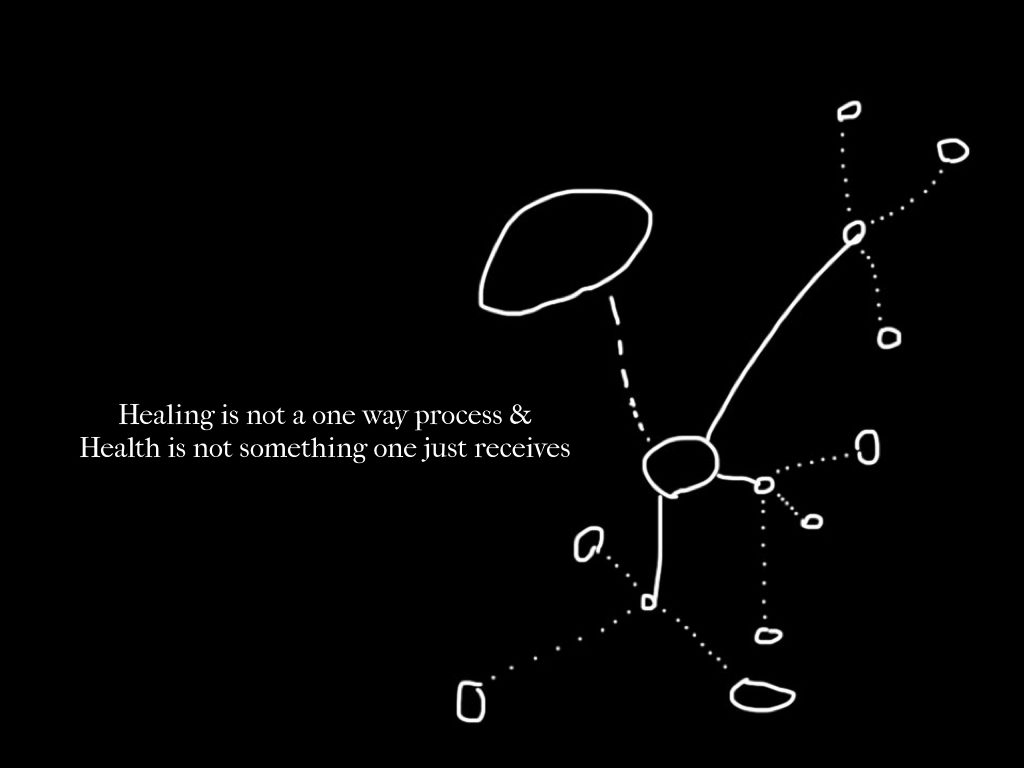
The viral structure, is built into this system and there is a reversal of the standard way of seeing the doctor and patient relationship. In this structure it is essential that we see the work of the Hologram as the work of a teacher or explicator, delivering a case that will ultimately allow the patience to learn things they didn’t previously know. This is the most important, (though totally devalued by money) potent and immediately applicable, form of learning we can do, and it is what the medical system has made into a commodity, at the same time as it is seen as ‘women’s work’ or completely useless.
MG: Could you take us through the processes of engagement. For instance, you say a group of four people meet and select one person who will become a Hologram, and that this means they and their health will become ‘dimensional’ to the group. Could you elaborate how this happens and why it’s important for those involved?
CT: We are about to experiment, this fall, with what it means for these groups to form in different ways. We will start with four test cases, where an invited, self-selected person will become a Hologram. She will be supported to select three Patience in a way that suits her, based on an interview and survey. The selection of Patience is a part of the process that we have not had a chance to refine. It is not simple for any individual to understand what support looks like for them, or who they want support from, if they’ve never really had it.
The experiments we will work through this fall will attempt to understand what changes in the experience of the whole Hologram when the Hologram is supported by Patience who are trusted friends and family, acquaintances or highly recommended strangers. An ‘objective’ perspective from an outside participant also adds a layer of formality to the project, because, instead of a casual gathering of friends, an unfamiliar person signals to the other members of the hologram to be on time, and make the meetings more structured than a regular friend to friend chat.
The onboarding process for the Hologram and the Patience includes a set of conversations and a training ritual, which are still quite bumpy. The two roles every participant is involved in, requires a different set of skills, and so they both involve a special kind of “training” that one can do in a group or independently. This “training” is a structured personal ritual that allows participants to witness and adapt their own communication habits so that they feel prepared to participate and set up trust, curiosity and solidarity for the group in the opening intake conversations.
At the completion of the intake process, the Hologram (1) transitions to become a Patience. At this time, the Hologram (1) begins a short training to transition to the other role, and she is supported by her Patience to do this work. At the conclusion of the Hologram’s (1) transition to Patience, and the completion of the new Hologram’s (2) intake process, the original Hologram’s (1) Patience become Holograms (3,4,5).
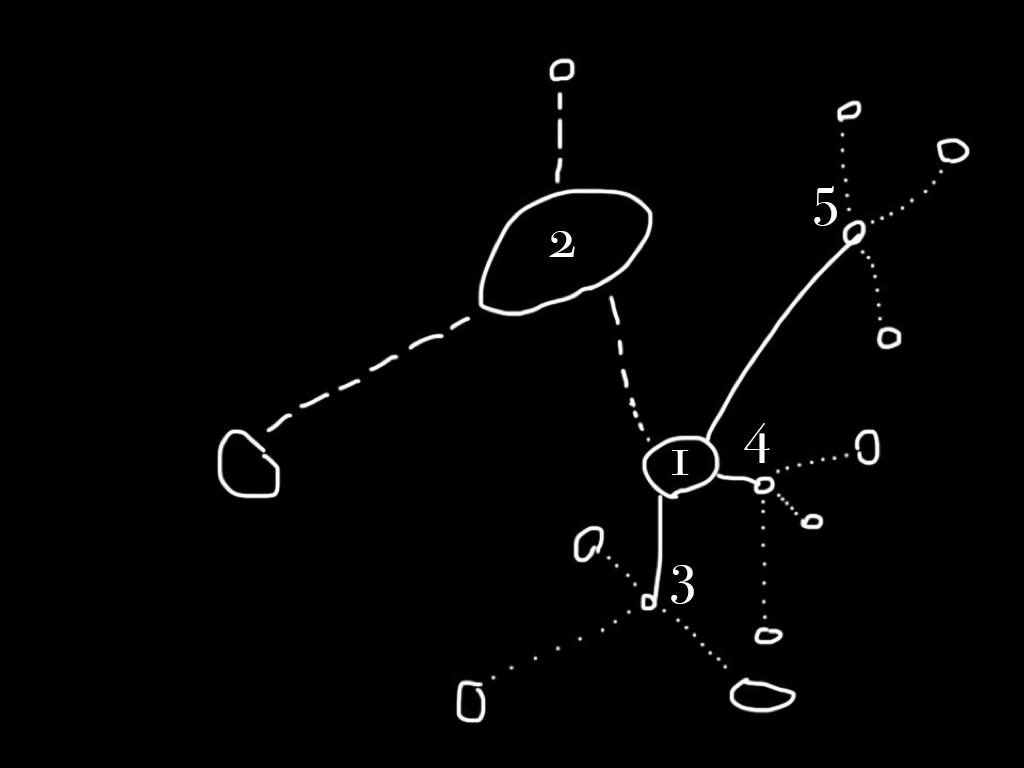
MG: The Hologram project was first trialed as part of an exhibition called Sick Time, Sleepy Time, Crip Time at the Elizabeth Foundation Project Space in New York City, March 31-May 13, 2017. What have you learnt in more recent undertakings of The Hologram project?
CT: Since the original trial one year ago, which lasted for 3 months, the research has shifted to looking at building skills and answering acute questions that will accumulate to support and build the larger project. Starting in the Spring of 2017, I began to offer the Hologram project as a workshop, where participants could test the communication model that is implicit in the Hologram format. The method for offering it is, as a performance artist and rogue architect, creating a situation in a space where people go through a difficult psycho social physical experience together. In the reflective conversations that follow, I ask the groups to use the personal pronoun ‘we’ for the entire duration of the conversation. The idea is that one person’s experience can be shared by the group, and even as temporary Patience we can take a leap and share their experience with them for a duration of time, allowing a Hologram to feel as if their experience is “our” experience. And this feeling that one is not alone in an experience, if carried into other parts of life, has the potential to break a lot of the assumptions and habits that we have inherited from living and adapting to a debt driven hellscape.
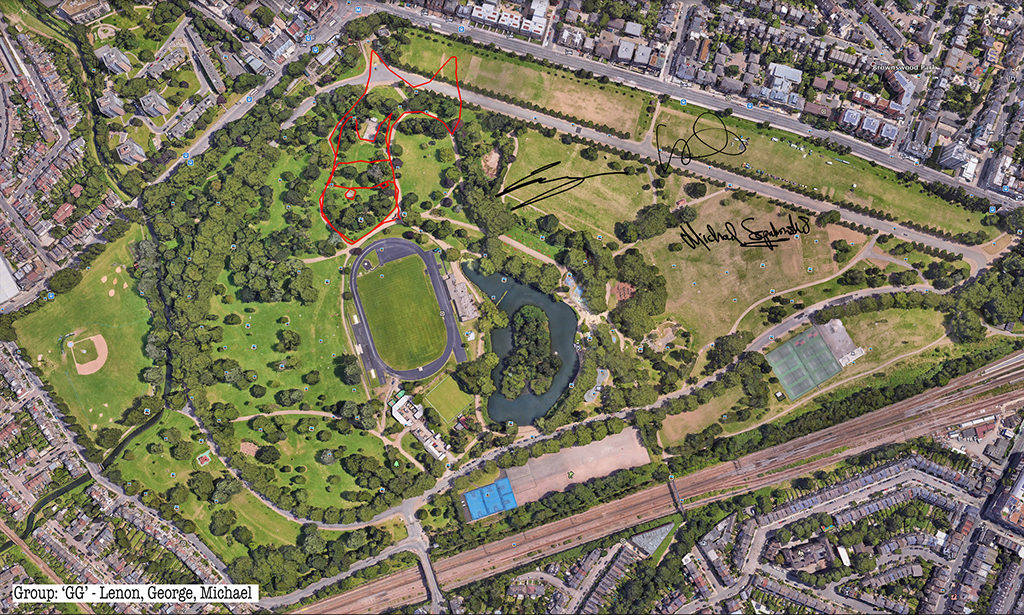
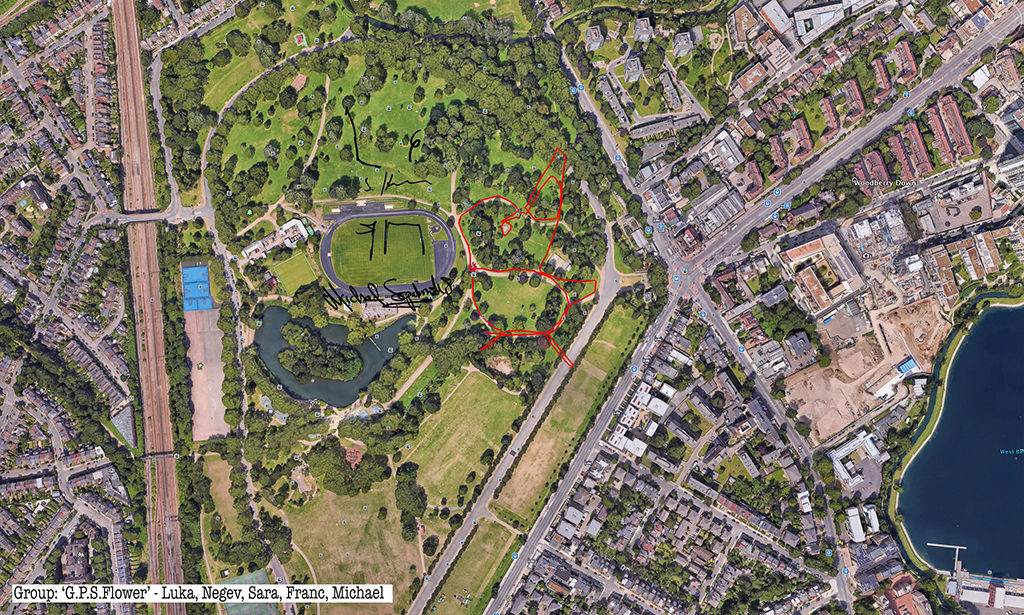
Recently I was approached to conceive and run an outreach project to accompany a solo show of work by Eduardo Kac at Furtherfield Gallery in North London’s Finsbury Park.
Among the works on show was one of Kac’s Lagoogleglyphs, large scale stylised representations of rabbits (something of a signature obsession for him) painted in some sort of sportsground emulsion directly onto a section of the park and allegedly of a scale which make it harvestable by the satellites Google rents for its various mapping activities.
Being completely frank, I have to say I entertained a degree of scepticism about Kac’s work—some of it falling within, in my view, one or both of two entertainment based metaphors—the ‘one-liner’ and the ‘theme park’—neither particularly positive elements of my critical lexicon.
Be that as it may, some of the work, particularly the less grandiose pieces (that delicate bunny flag flapping above the gallery!) were touched enough with real poetry to make me want to take up the challenge.
I say ‘challenge’ advisedly for I’m only ever interested in doing anything which in some sense challenges me and I also felt that my ambivalence about Kac would result in anything I ended up making containing a return element of ‘challenge’ or, perhaps more gently put, practical critique.
The word challenge also described the sense I had of wanting to counterpose collaboration, the collective, the everyday, to the artist with a capital ‘A’; of going some way to claiming art as a way of seeing and feeling and thinking together for All ( also with a capital ‘A’).
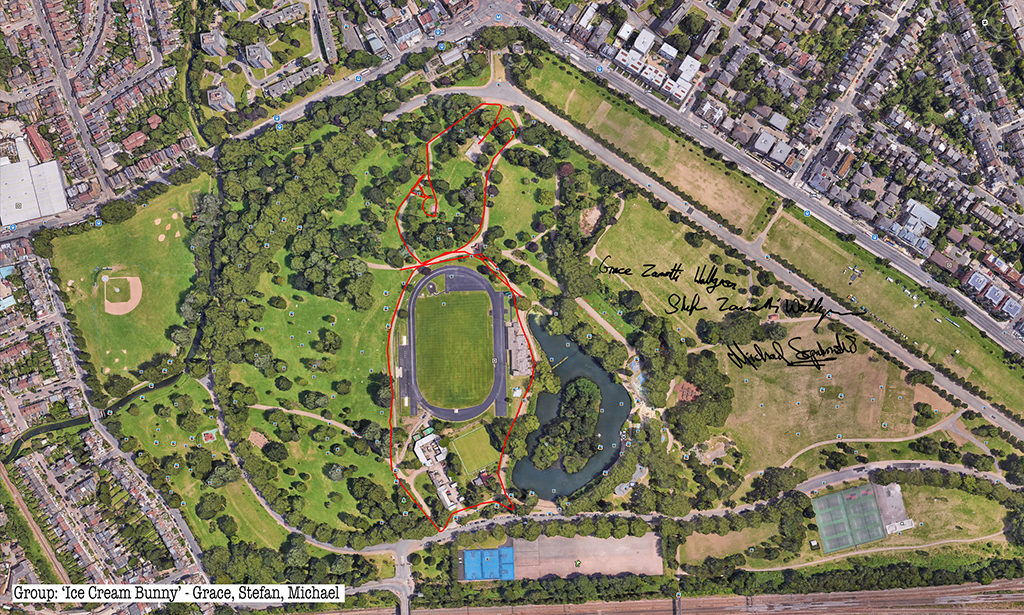
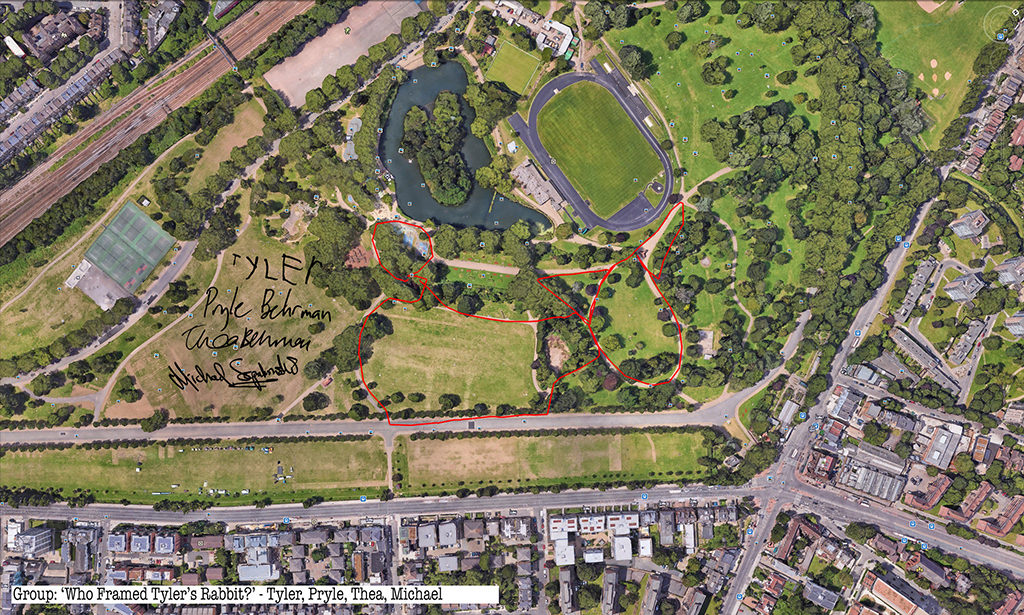
Reaching back in memory I pondered two remix/homage projects from the noughties which somehow straddled, in a pleasantly clunky fashion, practices both cutting edge digital (at least in their original moment) and time honoured too.
Apposite and practical stimuli for my 2018 purposes, they suggested elegant pathways to both honour previous work and to gently…um… stress-test it.
Both evinced rich humour, a warmth and a concomitant refusal to take themselves too seriously, qualities lacking in much contemporary art and both had a kind of performative klutziness I found entirely engaging.
Both were made in the first years of this millennium when digital and particularly online art was a wild west with a few fragile homesteads scattered here and there and not the orderly space it is today colonised almost entirely by the mainstream art world or commerce or both.
I recalled first a project by Nathaniel Stern where he hired South African billboard sign writers to paint physical representations of various, mostly art related, web pages.
The second was artist duo MTAA’s remix of Tehching Hsieh’s One Year Performance project, an endurance piece where Hsieh had forced himself to punch a timeclock on the hour, every hour for a whole year.
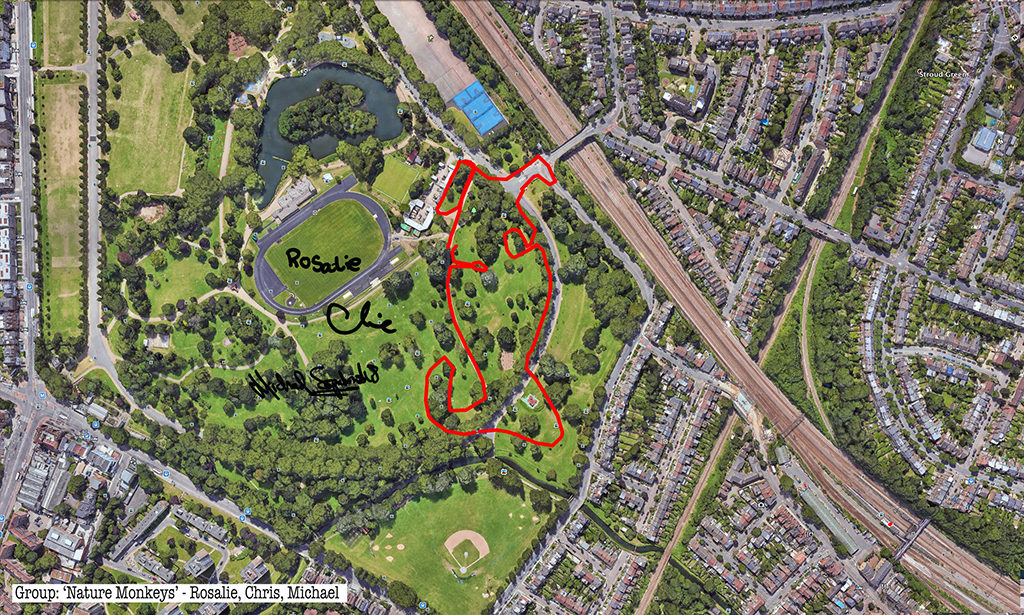
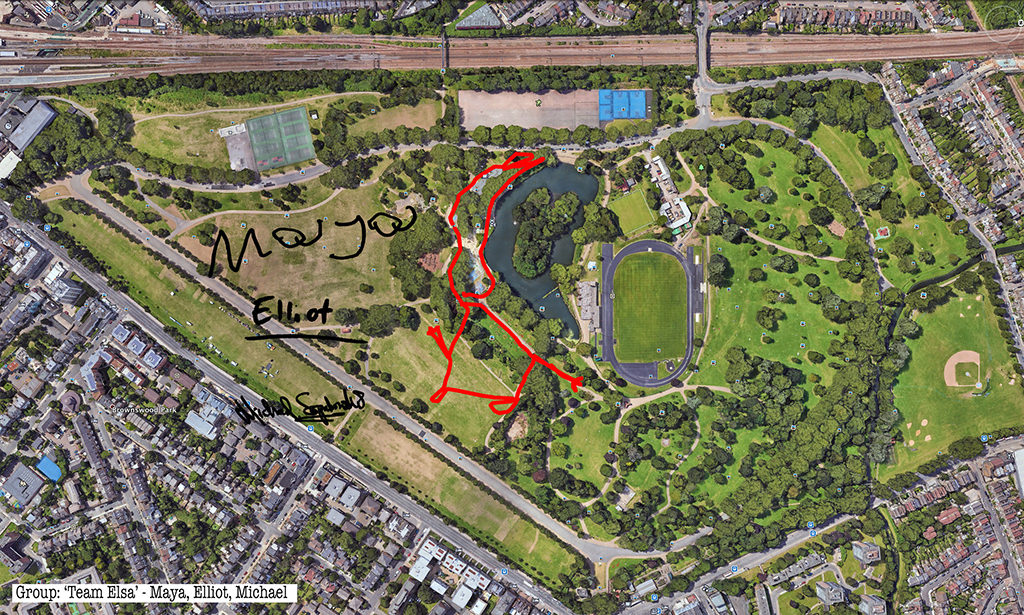
Reversing the premise MTAA’s Whid and River posted a database of video clips of themselves sleeping, eating, inhabiting the space and left it to the online viewer to watch these being digitally assembled (by Flash—remember that?) into a simulacrum of the original over the assumedly continuous period of a year.
Armed, fortified, prepared thus, I set to work—but I still needed a concrete plan and methodology.
Being a keen runner and the project taking place in a London Park in which I had run a 10k not long before (and now having endurance floating near the top of my mind) I felt some kind of park related physical activity would be an element and this would be a way of coming closer to those who loved the park but for whom the art gallery might not be their first association.
But still I lacked the concrete rabbit themed activity which would offer genuine practical, meaningful and autonomous artistic engagement and creation to participants.
I did not want to control what those participants would do but give them a clearly defined (clearly defined enough that all inputs from three separate days of activity could be brought together into a final unified work) and interesting task within which they would need to deploy creativity, focus and skill.
The fad for exercise related GPS devices had previously passed me by but one day whilst running with my daughter, who uses her phone and GPS enabled software to document her running in data and map form, I had a small epiphany—here there (might) be rabbits.
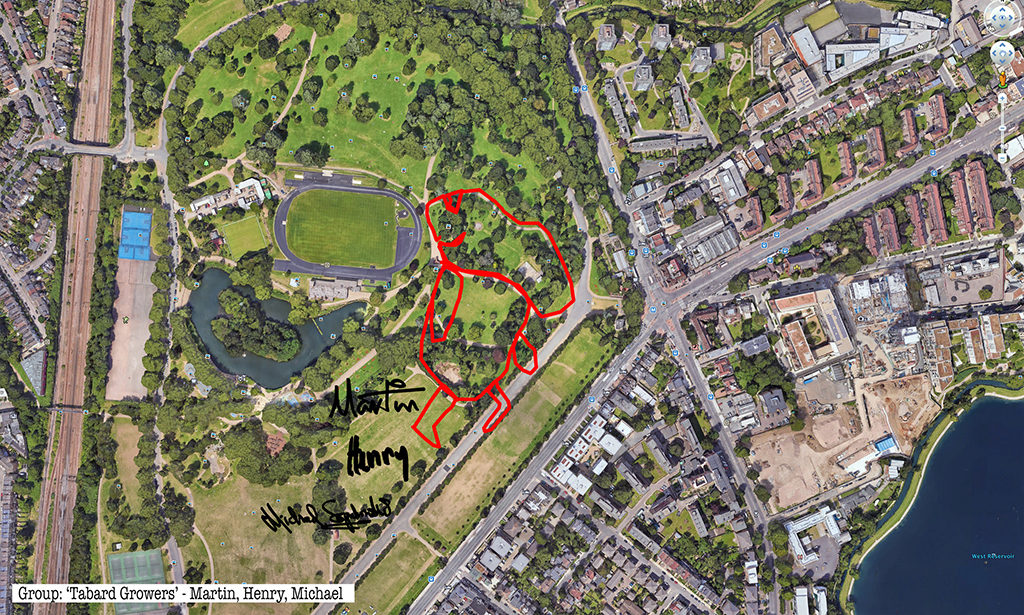
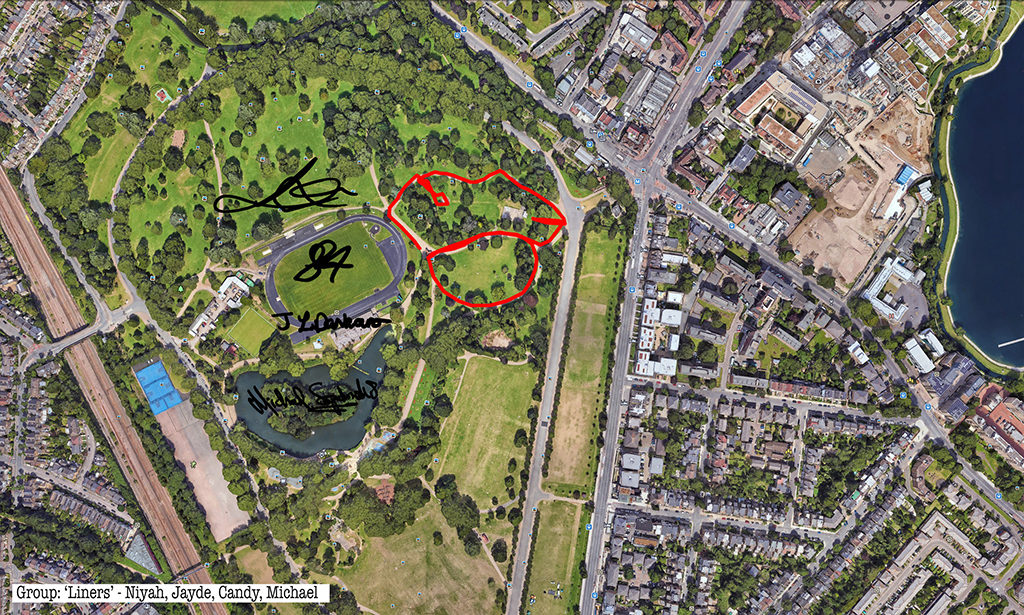
Rabbits, giant GPS rabbits, first planned and sketched by participating teams in marker pen over a satellite image of the park—ears, eyes, paws, body, fluffy tails emergent within its various paths and trails and features and obstructions.
And then, using these maps, we would carefully and attentively walk-out each monster rabbit trapping and freezing it as a succession of data, a series of co-ordinates in the memory of the GPS watch I would wear, finally to be reconstitututed as a continuous line drawing in turn fed back into a fresh satellite view of the park.
But that succession of co-ordinates, actuated by the actual movements of the human body (like a giant pencil lead or nib or brush) will resolve itself into something ancient—line, preconceived and then drawn out by human beings.
Being, together, both the very oldest form of mark making and something blink-of-an-eye recent too (well, as recent as the noughties efflorescence of so-called locative media which I shamelessly pillaged here.)
Inaccuracy in some measure a feature of both ancient and modern—the error margin of even GPS and GLONASS together, two sets of four satellites working in concert; the mix of will and skill and the fallibility and triumph too of flesh and bone and sinew which is part of what thrills and moves us in the arts.
This is what I had in mind.
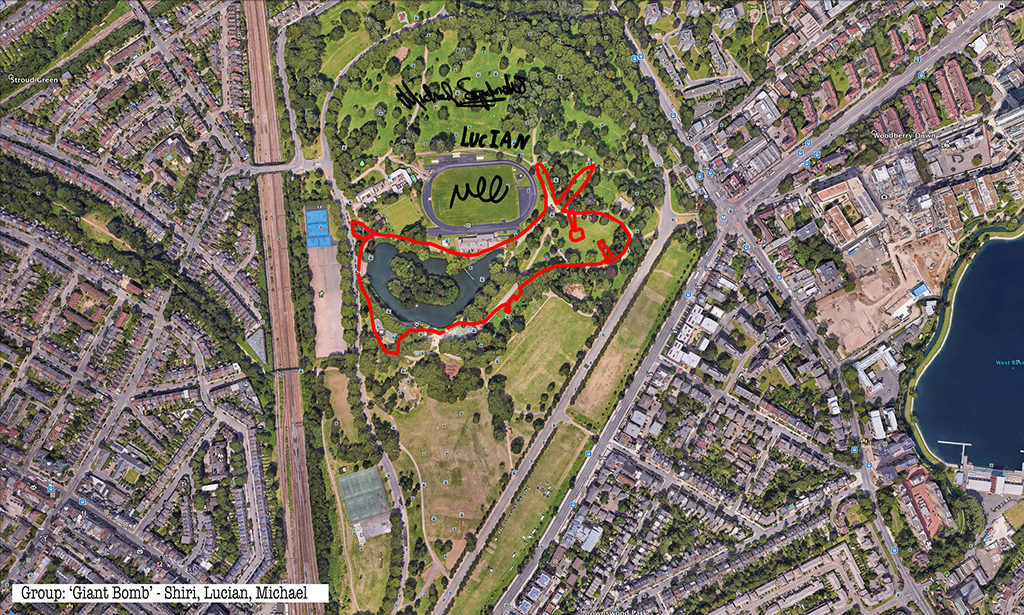
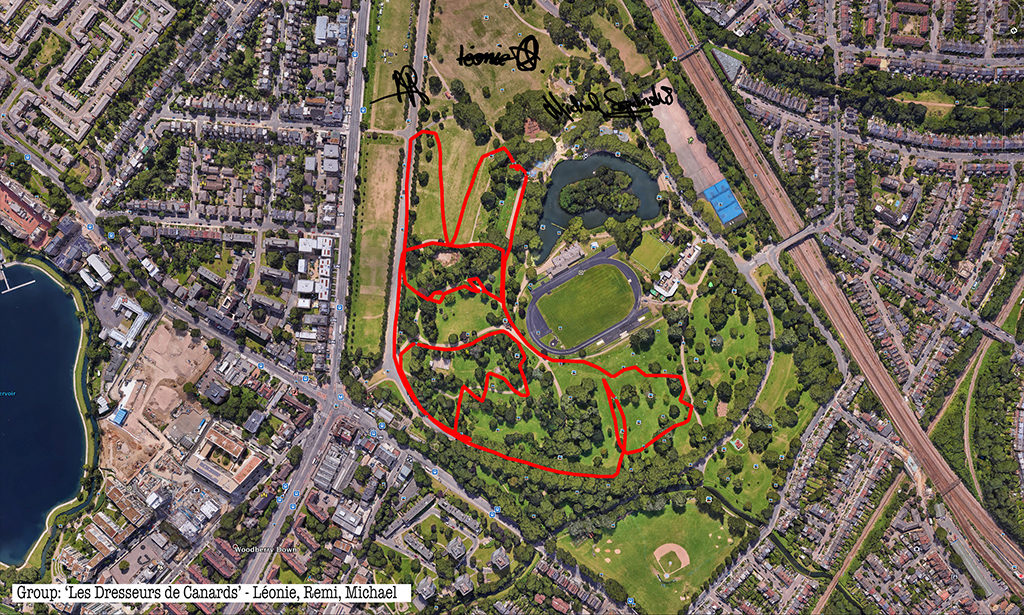
Repeatedly outlining then co-performing an activity which I learned to summarise simply and precisely, almost automatically, one might have thought boredom or a dozy, parroted, routine might threaten.
And how anxious I was each time as to whether and in what way each new team would engage with—buy into—adopt as theirs, as ours—the task.
But how striking the variation both in the simple, basic act of depicting in continuous line each new rabbit-of-the-imagination and the forty minutes lively sociability surrounding that initial sketching and subsequent walking-out.
Balancing the competing claims of making something serious, something with some kind of weight, some satisfying end product, whilst making space for others’ fun and dreams and and will and whimsy is neither easy nor is it trivial.
In the end people seemed to have a good time, they seemed at ease, went at it with a will and—it seems to me—something rich and affecting emerged.
Thanks to all at Furtherfield and thanks—no, not thanks, but credit—to my fellow artists: Alessandra, Anna, Candy, Chris, Elliot, Evgenia, Franc, George, Grace, Henry, Jade, Lenon, Léonie, Lucian, Luka, Martin, Matthew, Maya, Negev, Niyah, Pryle, Rémi, Rosalie, Sara, Shiri, Stefan, Thea and Tyler.
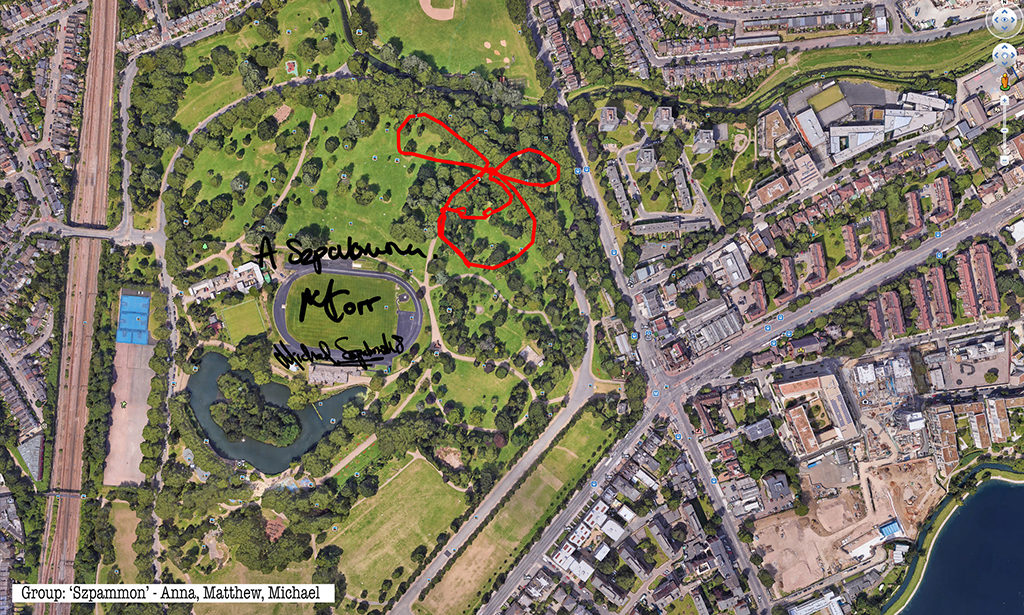
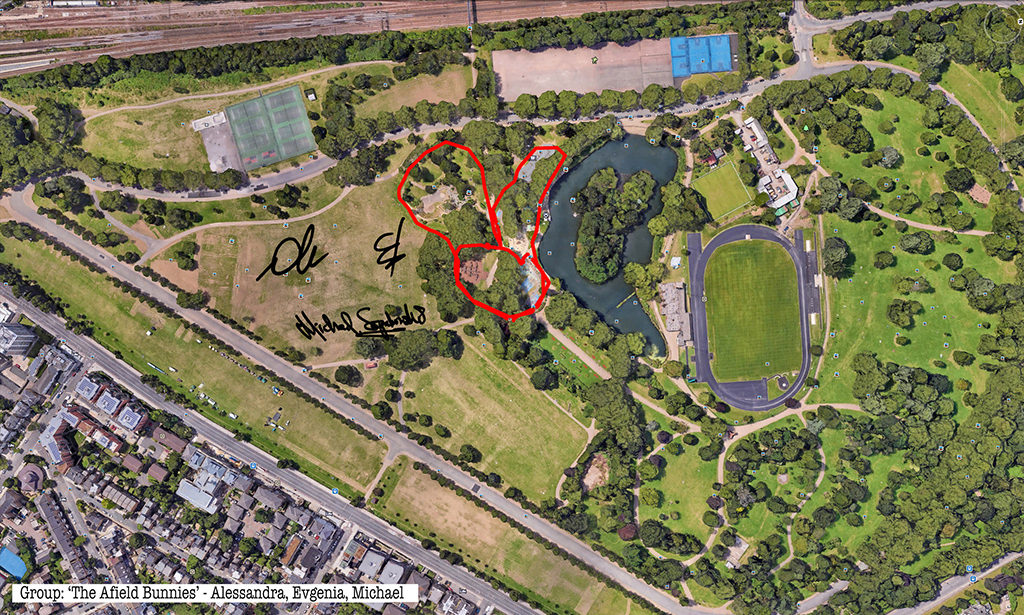
Mark Hancock discusses the politics and artistry of Janez Janša’s identity interventions in the context of their recent challenge at the Parliamentary Elections in Slovenia, in June 3rd 2018.
Ideas firmly deduced, tested against all variables and tentatively sent out into the world for appraisal by others, soon betray us as they bend to the whims of anyone they encounter. But that’s the nature of the malleable, post-digital world we live in. Ideas have to adapt and change to suit the warp and weft of the society if they are to survive in some form. How do we lock down our ideas into their final form? And what level of commitment can we expect from our ideas even if we apply intellectual property rights and that centuries-old mark of authenticity, the signature? The art world is particularly vulnerable to the conceit of signed authenticity. A signature often being the only guarantee that you’ll see any return (financial, reputational or otherwise) on your investment. If you really want to play with systems of power and bureaucracy, try altering artist names.
Davide Grassi, Emil Hrvatin and Žiga Kariž all changed their names to Janez Janša in 2007, joining the conservative Slovenian Democratic Party (SDS) at the same time, to explore the bureaucratic and political systems of their home country, Slovenia. The foundation of their actions ever since has been the question: what power exists in a name? And not just the art power system, but what political forces come into play when that name also belongs to the leader of the Slovenian Democratic Party, Janez Janša, (Prime Minister 2004 to 2008 and then again in 2012 to 2013). Incidentally, or perhaps not, Janez Janša, the politician was born Ivan Janša. The renaming of the three artists becomes a sort of double bluff when you also start to ask who the ‘real’ Janez Janša is.
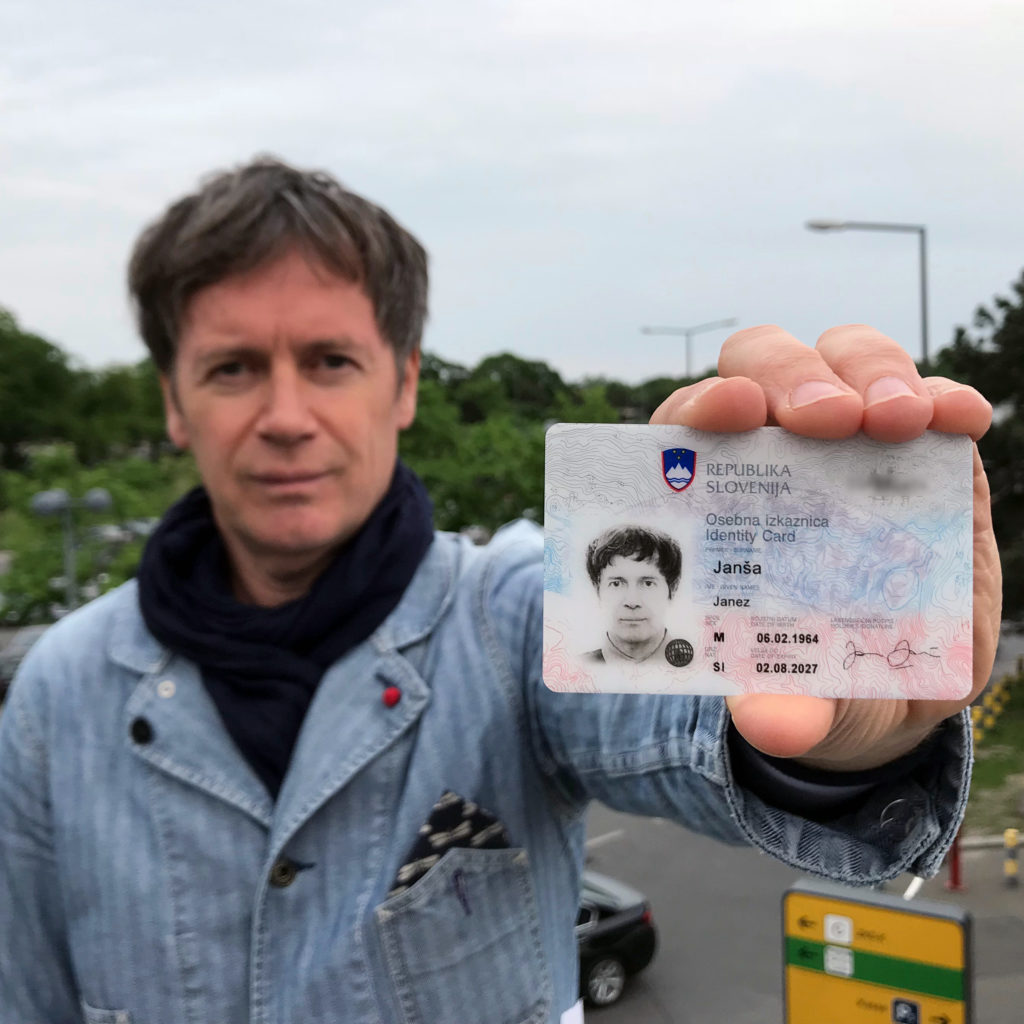
It would be easy to assume that the work of Janez Janša is simply another playful, flaccid baiting of the art world and right-wing political hegemonies. All too often work that challenges the political system might as well be challenging the rules of the Italian Football League, for all the difference in the world it makes beyond the enclosed loop of the art community. There’s only so far that insulting the work of Damien Hirst with another work of art can get you. But the Janez Janša artists have chosen to pierce through the membrane of the art world and make a social difference.
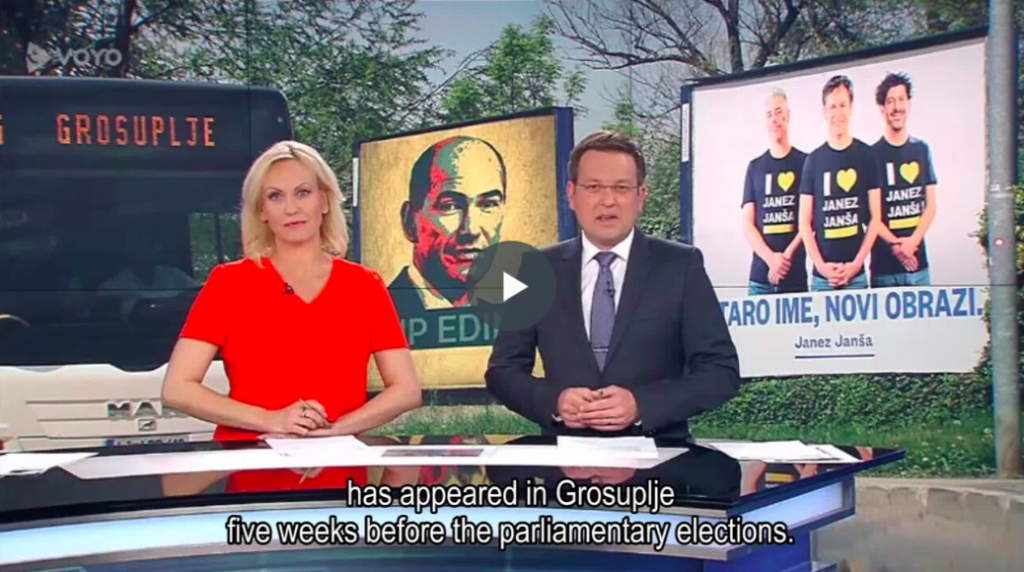
In the Slovenian Parliamentary Elections on the 3rd June 2018, one of them ran as a member of the opposition party, Levica (The Left) in Grosuplje the home district of the ex-Prime Minister, Janez Janša. In a press release, Janez Janša (the artist) said: “Running for parliament is a logical consequence of the view I have towards society. I care about what is happening. I react to things. I want to change them. (…) Society must be organized in such a way that the state begins to serve its citizens, as opposed to serving capital. Capital has no interest either for society or for art or for the individual.”
There is something inherently political in multiple authors using a single name, at least if you cast an eye over recent history. Reference points include Wu Ming, the Italian author collective that produced a number of literary works (they published a best-selling novel, Q, in 1999). They evolved from the Luther Blissett collective, whose playful, socially engaged activities defy the concept of the singular creative voice. This concept seems so alien to much of the mainstream media, particularly in Wu Ming’s home country of Italy, where they have been accused of everything from cybercrime to the less savoury aspects of rave culture. It’s this uncertainty about ownership that seems to bring a nervous lump to the throat of media and political gatekeepers. Perhaps this revolves around two questions so central to capitalism: If you’re doing nothing wrong, why hide behind a nom de plume or a collective? And, who do I send the check to, if I want to buy an Art?
On top of this, copyright issues become complex when the roster of names increases as well. Because we still want ideas to be owned, even when they are expanded through homages and pastiches. Copyright, as the attorney representing the Janez Janšas points out, is a legal construct, protecting, “original artistic (and scientific) creations, which are expressed in any way. A work is protected by copyright only if it was created by a human being (an author) and bears a stamp of author’s personality.” With work by Luther Blissett and Wu Ming, at least the authors can be understood as ‘artists’, even anonymously. Janez Janša, Janez Janša and, last but not least, Janez Janša have layered this authorship of their artwork with another layer of copyright/ownership complexity.
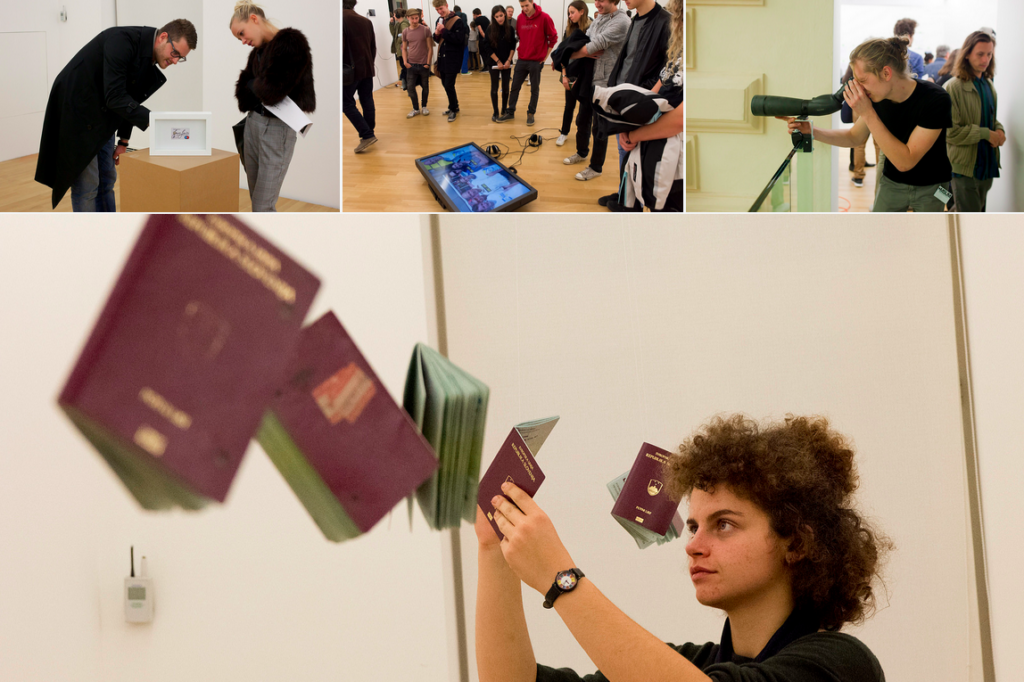
They refer to this work as collateral art, a phrase resonant with the phrase collateral damage, used to describe the acceptable casualties of battles. Collateral art is the acceptable damage on their ideas and projects from engagement with companies and institutions: ID cards, membership cards, the whole panoply of detritus that comes with the work. The artists want this collateral art, often customised by companies on request, to question the relationship between artworks and functional objects, “exploring post-Fordist means of production.” Any art historians still trying to shoehorn the belief of the gifted singular genius crafting his (note the gender pronoun: now discuss) solo masterpiece, probably hasn’t been paying close enough attention. The individual work of art often only becomes such with the signature of the artist attached as providence. When the work of art carries the signature of a non-artist though, can it still be brought into the art world as a valid comment on… anything? Paperwork sent to institutions by Janez Janša, and signed by an official becomes art. But whose art?
The answer, of course, is that it is their art. Whatever bureaucratic grindstone the works have been milled under, they ultimately belong back with the artists. It is they who return the work back to the art world through the exhibition. The exhibition co-produced by Moderna galerija (MG+MSUM) and Aksioma – Institute for Contemporary Art, Ljubljana, and curated by independent curator Domenico Quaranta, in 2017, was a chance to display and reflect back on ten years of work by the artists. Called the Janez Janša® exhibition, on display were works including Signatures (2007 – ongoing) which explored interventions of the Janez Janša name into public spaces, such as the Hollywood Walk of Fame (Signature, 2007), or Signature (Copacabana), in Rio de Janeiro, 2008. Playfully appearing in numerous locations around the world. Or Mount Triglav on Mount Triglav, an action performed in August 2007. This action commemorated “the 80th anniversary of the death of Jakob Aljaž; the 33rd anniversary of the Footpath from Vrhnika to Mount Triglav; the 5th anniversary of the Footpath from the Wörthersee Lake across Mount Triglav to the Bohinj Lake; the 25th anniversary of the publication of Nova Revija magazine and the 20th anniversary of the 57th issue of Nova Revija, the premiere publication of the SLOVENIAN SPRING; this was a re-enactment of Gora Triglav (Mount Triglav), by the OHO group in 1968 and the latest in a chain of re-enactments, as it was also performed by in 2004 by the Irwin Group.
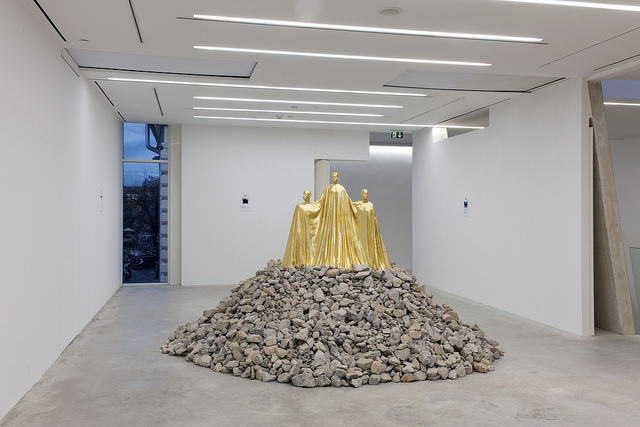

The conference in the same year, Proper and Improper Names: Identity in the Information Society conference, hosted by Aksioma – Institute for Contemporary Art, Ljubljana, and curated by Marco Deseriis in 2017, invited speakers including Natalie Bookchin, Marco Deseriis, Kristin Sue Lucas, Gerald Raunig, Ryan Trecartin, Wu Ming. The subjects under discussion arose from Marco Deseriis’ book Improper Names: Collective Pseudonyms from the Luddites to Anonymous. Deseriis, as keynote speaker, talked about the genealogy of the improper name. This is Deseriis’s term for the use of pseudonyms by artist collectives, including Wu Ming (who presented a talk at the conference) and Ned Ludd, the fictional leader of the English Luddites.
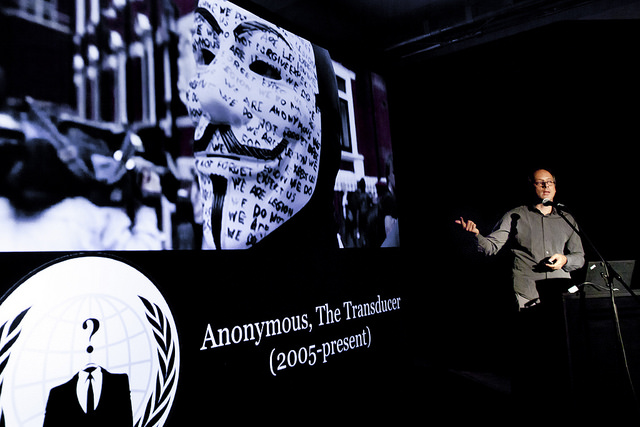
Releasing your ideas out in the wild doesn’t always guarantee they will come back to you unscathed or even return at all. The works of the Janez Janša collective are sent out to corporate systems, being adapted and altered, and returned. Or at the very least offering a challenge to accepted forms of ideological structures. In the Slovenian elections on 3rd June, the Slovenian Democratic Party (SDS) won with 25% of the votes. Levica won 9.0%. The SDS is a far-right, anti-immigration party, reflecting the increasing rise of right-wing parties across Europe right now. The leader of the SDS, Janez Janša, now has the opportunity to form a right-wing government. If this happens, and by the time you read this, it may well have, it would continue the shift in European Councils members towards the right.
There’s nothing new in declaring that everything is in flux. That’s the nature of our hyper-accelerated world. But right now there is a creeping sense that The Other is also to be viewed as The Enemy. The social, political value of art has to change to mean something in what is little short of a battle for a better society for ourselves and others across the globe if it is to have any value whatsoever. Janez Janša, Janez Janša and Janez Janša’s work reflect this evolution by being part of the society around them. Being part of the electoral system reflected this challenge and desire to be part of the real world and to make art mean something more than gallery space and conference papers. If art wants to survive and continue to belong to everyone, then it needs to be part of the world we are living in right now. No one work of art ever changed the world, but it helps us unravel and see through the propaganda of systems. We all need to become Janez Janša®.
The final outcome of the recent Slovenian Elections remains uncertain as Social Democratic Party’s Janez Janša attempts to form a coalition government.
More images at Flickr – https://bit.ly/2yniHYL
More about Janez Janša – http://www.janezjansa.si/about-jj/
SEE IMAGES FROM THE PRIVATE VIEW
Would you like to monetise your social relations? Learn from hostile designs? Take part in (unwitting) data extractions in exchange for public services?
Examining the way that the boundaries between ‘play’ and ‘labour’ have become increasingly blurred, this summer, Playbour: Work, Pleasure, Survival, will transform Furtherfield Gallery into an immersive environment comprising a series of games. Offering glimpses into the gamification of all forms of life, visitors are asked to test the operations of the real-world, and, in the process, experience how forms of play and labour feed mechanisms of work, pleasure, and survival.
What it means to be a worker is expanding and, over the last decade, widening strategies of surveillance and new sites of spectatorship online have forced another evolution in what can be called ‘leisure spaces’. From the self-made celebrity of the Instafamous to the live-streaming of online gamers, many of us shop, share and produce online, 24/7. In certain sectors, the seeming convergence of play and labour means work is sold as an extension of our personalities and, as work continues to evolve and adapt to online cultures, where labour occurs, what is viewed as a product, and even, our sense of self, begins to change.

Today, workers are asked to expand their own skills and build self-made networks to develop new avenues of work, pleasure and survival. As they do, emerging forms of industry combine the techniques and tools of game theory, psychology and data science to bring marketing, economics and interaction design to bear on the most personal of our technologies – our smartphones and our social media networks. Profiling personalities through social media use, using metrics to quantify behaviour and conditioning actions to provide rewards, have become new norms online. As a result, much of public life can be seen as part of a process of ‘capturing play in pursuit of work’.
Although these realities affect many, very little time is currently given over to thinking about the many questions that arise from the blurring between work and play in an age of increasingly data-driven technologies: How are forms of ‘playbour’ impacting our health and well-being? What forms of resistance could and should communities do in response?
To gain a deeper understanding of the answers to these questions, we worked with artists, designers, activists, sociologists and researchers in a three-day co-creation research lab in May 2018. The group engaged in artist-led experiments and playful scenarios, conducting research with fellow participants acting as ‘workers’ to generate new areas of knowledge. This exhibition in Furtherfield Gallery is the result of this collective labour and each game simulates an experience of how techniques of gamification, automation and surveillance are applied to the everyday in the (not yet complete) capture of all forms of existence into wider systems of work.
In addition to a performance by Steven Ounanian during the Private View, the ‘games’ that comprise this exhibition are:
Lab session leads and participants: Dani Admiss, Kevin Biderman, Marija Bozinovska Jones, Ruth Catlow, Maria Dada, Robert Gallager, Beryl Graham, Miranda Hall, Arjun Harrison Mann, Maz Hemming, Sanela Jahic, Annelise Keestra, Steven Levon Ounanian, Manu Luksch, Itai Palti, Andrej Primozic, Michael Straeubig, Cassie Thornton, Cecilia Wee, Jamie Woodcock.
Curated by Dani Admiss.
Concept development Dani Admiss and Cecilia Wee.
Mask Making for Children
Sunday 22 July and 12 August 2018, 11:00 – 16:30
Furtherfield Gallery
FREE

Dani Admiss
When I was 16 I was in a band. I couldn’t sing that well so I used to write lyrics (about vampires) and put them into Babelfish to translate them into French thinking it made me sound automatically cooler.
@daniadmiss
Kevin Biderman
First met you in a dial up world; green block letters on a black screen. Later we traversed through neon colours, pixelated images and imperfect designs. I always knew you were an army brat born out of apocalyptic fears but I never thought you’d turn your back on the counter-culture who raised you. Maybe there will be a third act…
@act3
Marija Bozinovska Jones
The internet has concurrently enhanced and diminished life, yet I appear no longer able to recall life before it. Adding to Jameson’s quote: it is easier to imagine the end of the world, than the end of TECHNOcapitalism.
Ruth Catlow
I am a recovering Web Utopian – decentralised infrastructure does not, it turns out, lead automatically to decentralised power. However i am still most excited by art that happens in wild flows, through collaboration on open channels, rather than being owned, certified and traded like dead matter. I am Ruth and I am one of the voices and pairs of eyes.
@furtherfield
Maria Dada
I regularly translate whole books from German to English using Google Translate. I then take the transcripts and print them using lulu.com. I take pride in the design of the covers for each book. Not all of them are unreadable but most of them just sit on my shelf untouched.
@mariadada
Beryl Graham
I confess:
To buying a mobile phone so that I could text my sweetie.
To being mildly obsessed with weather apps that work best in the North.
To using online dating 15 years ago. The respectable Guardian rather than Tindr of course – hey I’m not an animal.
@berylgraham
Miranda Hall
After school, my friend and I would take screenshots of penises on ChatRoulette then save them in a desktop folder on the family computer called ‘cool fish’
@Miranda__Hall
Arjun Harrison-mann
For Much Longer than I Would Care to Admit, Every Since I Got Msn at the Age of 12, My Msn Profile Picture Was (and I Just Checked, Still Is), a Photoshopped Collage of Michael Jordan.
@arjun_harrisonmann
Maz Hemming
When I was 11, lying about my age to sign up on msn chat to chat about neopets, I ended up as one of the chatroom moderators. Which sometimes ended up with me leaving the window open to idle overnight (or the room would close). On the bonus side when my parents ended up with a bill at the end of the month of £200 (which I didn’t know would happen) we did get broadband. Much cheaper.
@MazHem_
Robert Gallagher
The unread emails in my inbox currently outnumber my Twitter followers by a factor of 47.7461024499 to 1.
@r_gealga
Sanela Jahić
Once my inbox got flooded with promotions of an online store. So my boyfriend and I composed a simple bot, which took random quotes from our sci-fi eBooks collection and posted them as customer reviews on their product pages.
Annelise Keestra
Until more recently than I would admit, I genuinely didn’t think there was any correlation between the file size of a download and data use. As if, there were two kinds of “GB”. Please don’t judge me.
@aut0mne
Steven Levon Ounanian
I think the internet loves me, but just doesn’t know how to show it.
@levontron
Manu Luksch
Our dream rewired. Our powers of prediction grow with every new circuit crammed in. Leap into tomorrow – one trillion calculations a second. And it grows more powerful, becomes smaller. Smart, mobile, personal. Today – in our pockets. Tomorrow – woven into our bodies. Create and share, everything, everywhere. Life in the cloud… with a chance of blue skies. Our time is a time of total connection. Distance is zero. The future is transparent. To be, is to be connected – the network seeks out everyone.” (Dreams Rewired; 2015 – my latest feature film about our hopes and fears of being hyper-connected).
@ManuLuksch
Itai Palti
I started visiting an architecture news forum as a teenager, excited about updates on local building projects. I still visit regularly for the updates, but also make sure to check on an exceptionally cringeworthy, decades-long feud between a couple of regular posters. I think they’d really miss each other if it all stopped.
@ipalti
Joana Pestana
Back in 1999, frustrated, I nurtured no love for my iMacG3 as I had to bare with 1-song-download-per-week for not having Napster.
@joanampestana
Michael Straeubig
Before social networks and Reddit, newsgroups were the places for online discussions. Catering to my interests was comp.ai.philosphy, a group notorious for debates going haywire.
Once I had a very heated discussion with someone I considered to be an immature and irrational teenager. It turned out it was a professor in Artificial Intelligence.
@crcdng
Cassie Thornton
I own/owned these URLs: bizzykitty.com, temporaryartbeautyservices.biz, infinitemuseum.com, evilarchitexture.net, teachingartistunion.org, sfluxuryrealestatejewelry.org, mastercalendar.biz, debtimage.work, institutionaldreaming.com, poetsecurity.net, universityofthephoenix.com, debt2space.info, secretchakra.net, wombco.in, givemecred.com, wealthofdebt.com, strikedebtradio.org, matterinthewrongplace.info, futureunincorporated.com, feministeconomicsdepartment.com, projectherapy.org, and many more I will never remember.
@femnistecondept
Cecilia Wee
The first time I went on the internet was about 1 year after Cyberia cafe opened in central London. I somehow convinced my mum to make a detour from a shopping trip so I could go online to look at 2 websites. Everyone else there was working very hard.
@ceciliawee
Jamie Woodcock
I decided it would be a fun idea to learn to play League of Legends as part of the fieldwork for an esports project. However, I was so bad at it that instead I had to study before playing, reading up on guides and watching streams/videos.
@jamie_woodcock
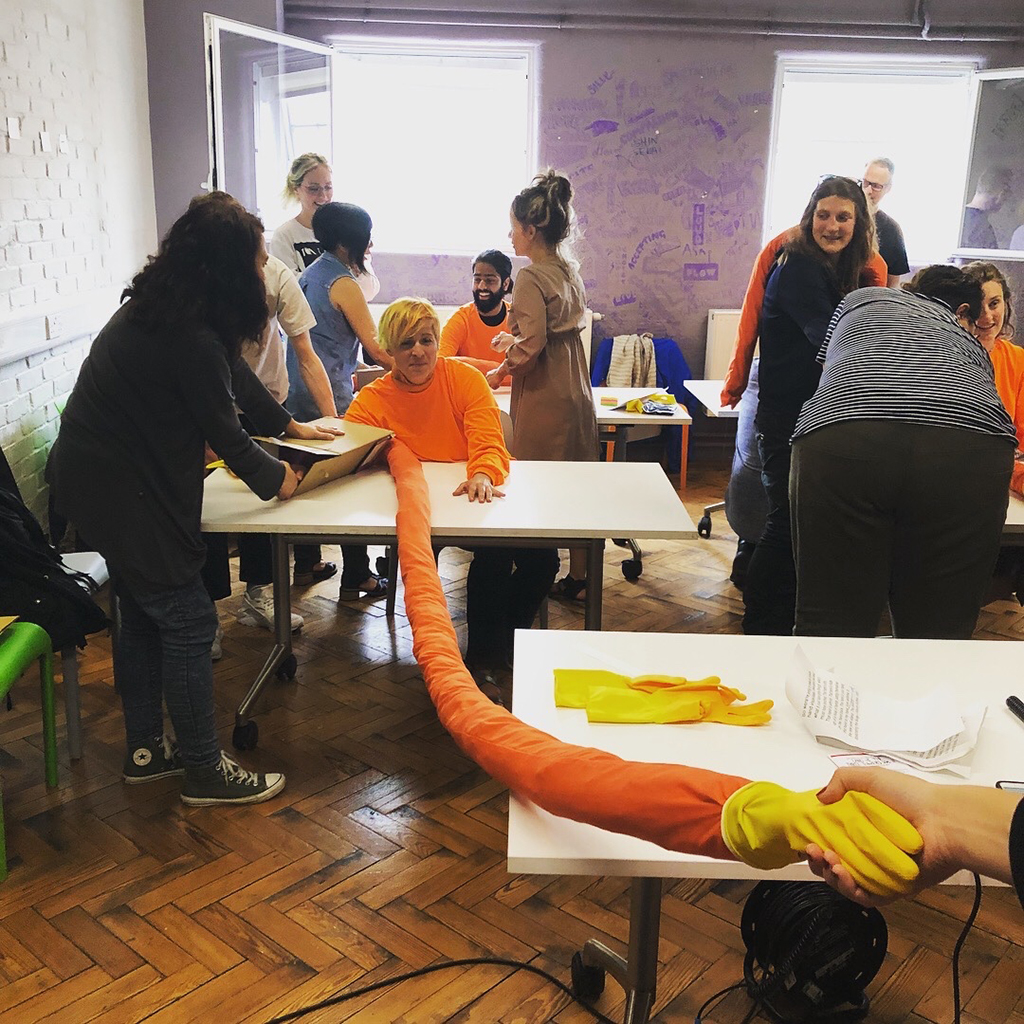
In the lead up to Furtherfield’s Playbour: Work, Pleasure, Survival exhibition Maria Dada, Miranda Hall and Cassie Thornton will be taking over the social media channels on Twitter, Instagram, and Facebook. Each micro-commission is an online space to take in different directions related ideas and themes of #playbour.
Our first week kicks off with Maria. Researcher in the fields of design and material culture, Dada’s Confessional Viral Hoax Engine brings together an interest in the infrastructures and processes used to spread misinformation online with themes of transparency, anxiety, and virtue signalling.
The second week is headed by Miranda Hall, who is a freelance journalist and research assistant at SOAS specialising in digital labour.
In the final week Cassie Thornton, artist, activist and feminist economist, will take-over Furtherfield’s social media channels. You can learn more about her here and her new project being launched on Kickstarter. Her take-over explores ideas surrounding yoga, feminist economics, class war, collective revenge, and social technology.
Dani Admiss is an independent curator and researcher working across art, design, and networked cultures. Her work employs world-building and co-creation to explore changes happening to our social, technological, and ecological, contexts. She is particularly interested in working with others to understand not yet completed transformations of body, society, and earth, into global capitalist systems. She is Founder of Playbour: Work, Pleasure, Survival, an art and research platform dedicated to the study of the worker in an age of data technologies. daniadmiss.com

Furtherfield is an internationally renowned arts organisation specialising in labs, exhibitions and debate for increased, diverse participation with emerging technologies. At Furtherfield Gallery and Furtherfield Lab in London’s Finsbury Park, we engage more people with digital creativity, reaching across barriers through unique collaborations with international networks of artists, researchers and partners. Through art Furtherfield seeks new imaginative responses as digital culture changes the world and the way we live.
Furtherfield Gallery
McKenzie Pavilion
Finsbury Park, London, N4 2NQ
Visiting Information
This project would not have been possible without the kind support of our partners.
This project has been funded with the support from the European Commission. This communication reflects the views only of the author, and the Commission cannot be held responsible for any use which may be made of the information contained therein.
Playbour: Work, Pleasure, Survival, is realized in the framework of State Machines, a joint project by Aksioma (SI), Drugo More (HR), Furtherfield (UK), Institute of Network Cultures (NL) and NeMe (CY).
This is a long read by one of the inhabitants of the Zad, about the the fortnight rollercoaster of rural riots that has just taken place to evict the liberated territory of the Zad. It’s been incredibly intense and hard to find a moment to write, but we did our best. This is simply one viewpoint, there are over 1000 people on the zone at the moment and every one of them could tell a different story. Thank you for all the friends and comrades who helped by sharing their stories, rebel spirits and lemon juice against the tear gas.
“We must bring into being the world we want to defend. These cracks where people find each other to build a beautiful future are important. This is how the zad is a model.” Naomi Klein
“What is happening at Notre-Dame-des-Landes illustrates a conflict that concerns the whole world” Raoul Vaneigem
The police helicopter hovers above, its bone rattling clattering never seems to stop. At night its long godlike finger of light penetrates our cabins and farm houses. It has been so hard to sleep this last week. Even dreaming, it seems, is a crime on the Zad. And that’s the point: these 4000 acres of autonomous territory, this zone to defend (Zad), has existed despite the state and capitalism for nearly a decade and no government can allow such a place to flourish. All territories that are inhabited by people who bridge the gap between dream and action have to be crushed before their hope begins to spread. This is why France’s biggest police operation since May 1968, at a cost of 400,000 euros a day, has been trying to evict us with its 2500 gendarmes, armoured vehicles (APCs), bulldozers, rubber bullets, drones, 200 cameras and 11,000 tear gas and stun grenades fired since the operation began at 3.20am on the morning of the 9th of April.
The state said that these would be “targeted evictions”, claiming that there were up to 80 ‘radical’ Zadists that would be hunted down, and that the rest, the ‘good’ Zadists, would have to legalise or face the same fate. The good zadist was a caricature of the gentle ‘neo rural farmer’ returning to the land, the bad, an ultra violent revolutionary, just there to make trouble. Of course this was a fantasy vision to feed the state’s primary strategy, to divide this diverse popular movement that has managed to defeat 3 different French governments and win France’s biggest political victory of a generation.
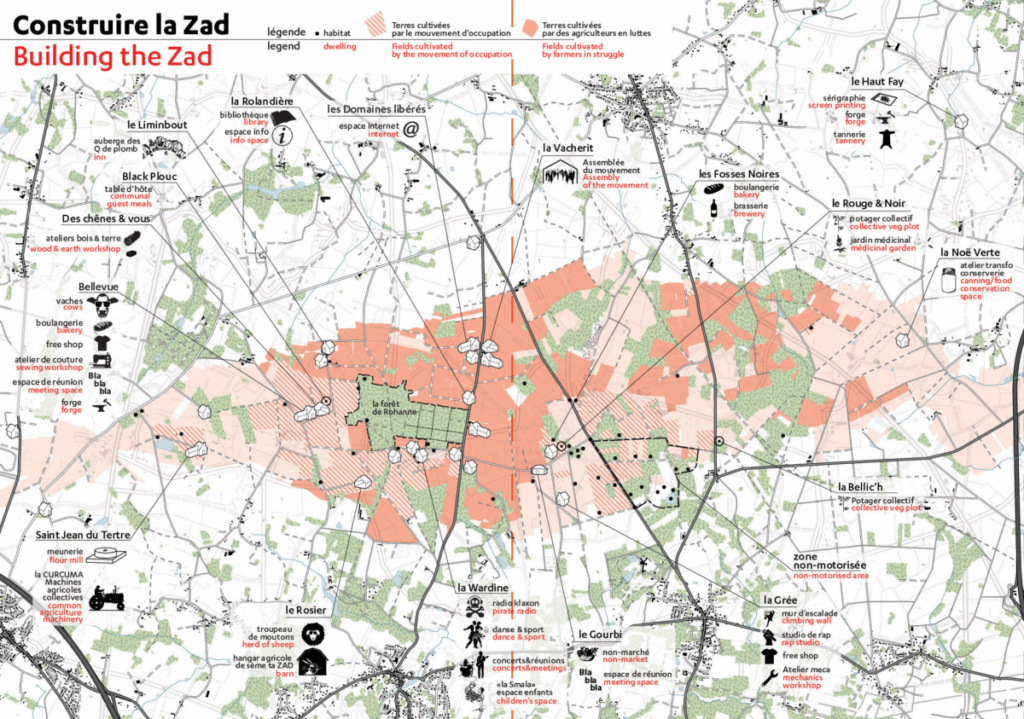
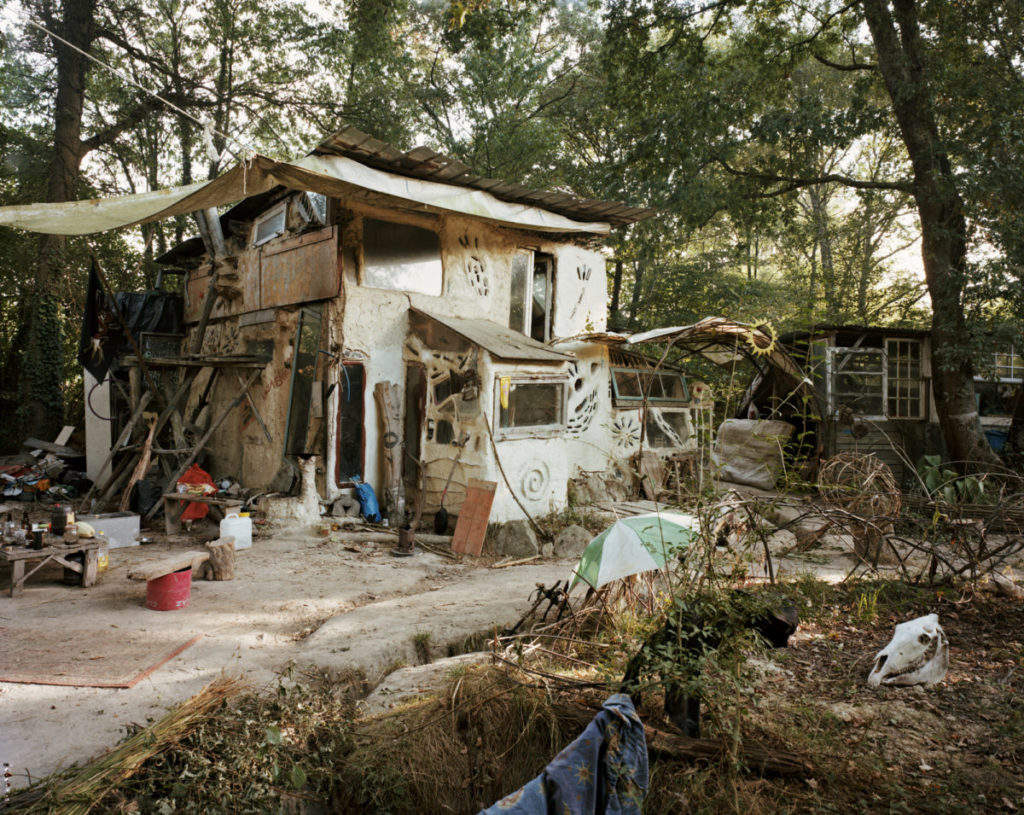
The zad was initially set up as a protest against the building of a new airport for the city of Nantes, following a letter by residents distributed during a climate camp in 2009, which invited people to squat the land and buildings: ‘because’ as they wrote ‘only an inhabited territory can be defended’. Over the years this territory earmarked for a mega infrastructure project, evolved into Europe’s largest laboratory of commoning. Before the French state started to bulldoze our homes, there were 70 different living spaces and 300 inhabitants nestled into this checkerboard landscape of forest, fields and wetlands. Alternative ways of living with each other, fellow species and the world are experimented with 24/7. From making our own bread to running a pirate radio station, planting herbal medicine gardens to making rebel camembert, a rap recording studio to a pasta production workshop, an artisanal brewery to two blacksmiths forges, a communal justice system to a library and even a full scale working lighthouse – the zad has become a new commune for the 21st century. Messy and bemusing, this beautifully imperfect utopia in resistance against an airport and its world has been supported by a radically diverse popular movement, bringing together tens of thousands of anarchists and farmers, unionists and naturalists, environmentalists and students, locals and revolutionaries of every flavour. But everything changed on the 17th of January 2018, when the French prime minister appeared on TV to cancel the airport project and in the same breath say that the zad, the ‘outlaw zone’ would be evicted and law and order returned.
I am starting to write 8 days into the attack, it’s Tuesday the 17th of April my diary tells me, but days, dates even hours of the day seem to merge into a muddled bath of adrenaline socked intensity, so hard to capture with words. We are so tired, bruised and many badly injured. Medics have counted 270 injuries so far. Lots due to the impact of rubber bullets, but most from the sharp metal and plastic shrapnel shot from the stun and concussion grenades whose explosions punctuate the spring symphony of birdsong. Similar grenades killed 21 year old ecological activist Remi Fraise during protests against an agro industrial damn in 2014.

The zad’s welcome and information centre, still dominated by a huge hand painted map of the zone, has been transformed into a field hospital. Local doctors have come in solidarity working with action medic crews, volunteer acupuncturists and healers of all sorts and the comrades ambulance is parked outside. The police have even delayed ambulances leaving the zone with injured people in them, and when its the gendarmerie that evacuates seriously injured protesters from the area sometimes they have been abandoning them in the street far from the hospital or in one case in front of a psychiatric clinic.
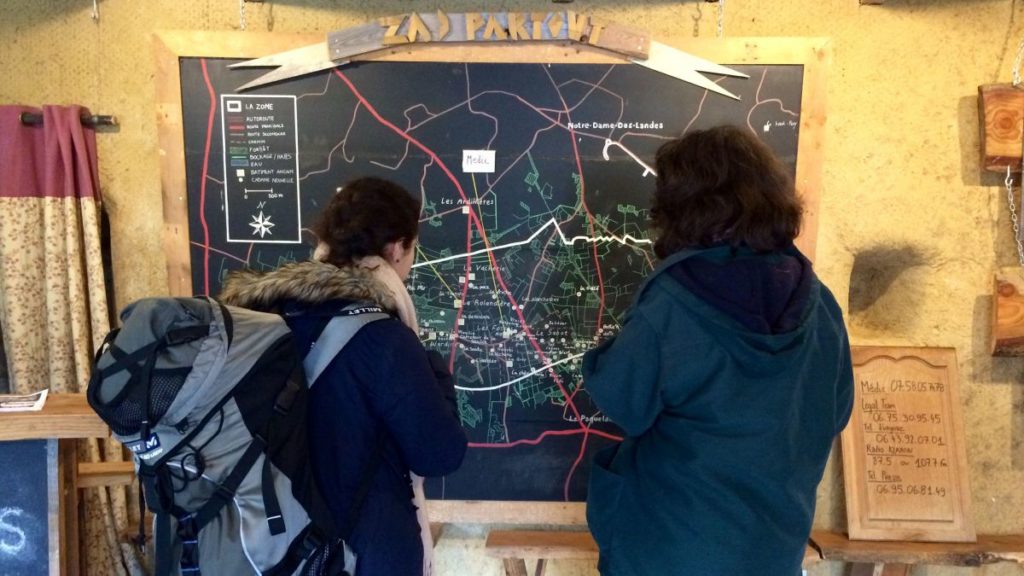
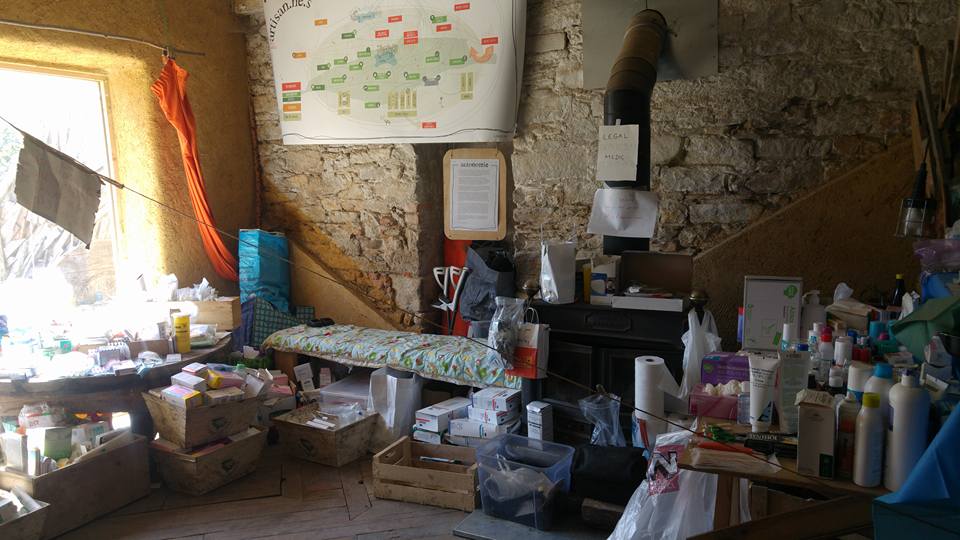
The thousands of acts of solidarity have been a life line for us, including sabotaged French consulate parkings in Munich to local pensioners bringing chocolate bars, musicians sending in songs they composed to demonstrations by Zapatistas in Chiapas, banners in front of French embassies everywhere – from Dehli to New York, a giant message carved in the sand of a New Zealand beach and even scuba divers with an underwater banner. Here on the zone three activist field kitchens have come to feed us, architects have written a column deploring the destruction of unique forms of habitat signed by 50,000 people and locals have been offering storage for the safe keeping of our belongings. A true culture of resistance has evolved in parallel with the zad over the years. Not many people are psychologically or physically prepared to fight on the barricades, but thousands are ready to give material support in all its forms and this is the foundation of any struggle that wants to win. It means opening up to those who might be different, those that might not have the same revolutionary analysis as us, those who some put in their box named ‘reformist’, but this is what building a composition is all about, it is how we weave a true ecology of resistance. As a banner reads on one of the squatted farmhouses here, Pas de barricadieres sans cuisiniers “There are no (female) barricaders without (male) cooks.”
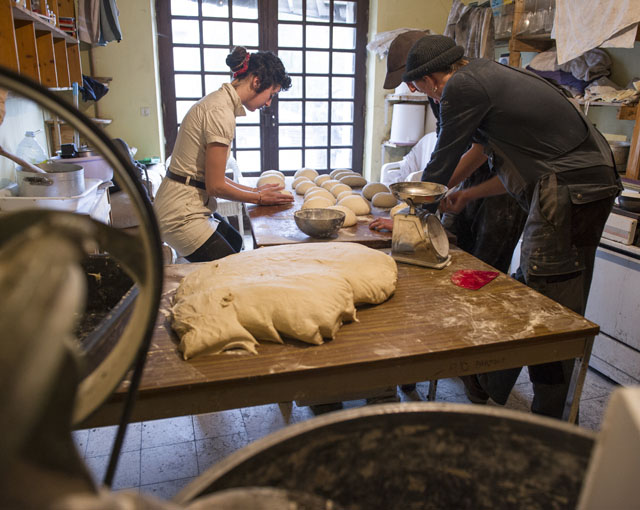
Today has been one of the calmest since the start of the operation, and it felt like the springtime was really flowering, so we opened all the doors and windows of house letting the spring air push away the toxic fumes of tear gas that still linger on our clothes. It feels like there is a momentary lull. For the first time since the evictions, our collective all ate together, sitting in the sun at a long table surrounded by two dozen friends from across the world come to support us. I hear the buzzing of a bee trying to find nectar and look up into the sky, its not a bee at all, but the police drone, come to film us sharing food, it hovers for hours. In the end this is the greatest crime we have committed on the zad, that of building the commons, sharing worlds together and deserting the pathology of individualism.
Two years before the abandonment of the airport project the movement declared in a text entitled The Six Points for the Zad: Because there will be no Airport, that we would, via an entity that emerged from the movement , collectively look after these lands that we were saving from certain death by concrete. A few months before the abandonment the form that this entity took was the Assembly of Usages. Soon after thethe airport was cancelled, we entered into negotiations with the state (via the prefet. Nicole Klein, who represents the state in the department) following a complicated week of pre-negotiations, where we were forced to open up one of the roads which had had cabins built on it since the attempted evictions of 2012. It seemed that the flow of traffic through the zone was the state’s way of telling the public that law and order had returned on the zone. (see the text Zad Will Survive for a view of this complicated period).
A united delegation of 11 people made up from the NGOs, farmers, naturalists and occupiers of the zone attended the negotiations and did not flinch from the demand to set up a collective legal land structure, rather than return these lands to private property and agro-business as usual. In the 1980s a similar legal structure was put in place following the victory of a mass movement against the expansion of a military base on the plateau of the Larzac in Southern France. With this precedent in mind we provided a legally solid document for a global land contract, but it was ignored, no legal grounds were given, the refusal was entirely political. Three days later the evictions began.
The battle lines were made clear, it was not about bringing ‘law and order’ back to the zone, but a battle between private property, and those who share worlds of capitalism against the commons. The battle of the Zad is a battle for the future, one that we cannot loose.
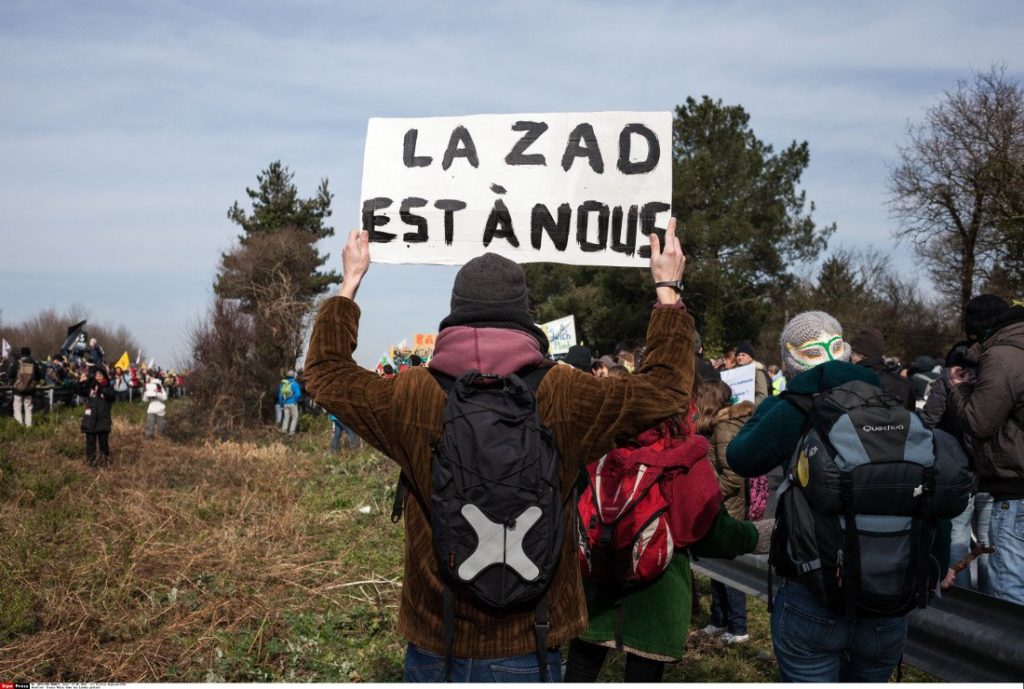
The telephone rings, it’s 3.20am, it’s still dark outside, a breathless voice says two simple words, “It’s begun !” and hangs up. Everyone knows what to do, some run to offices filled with computers, others to the barricades, some to the pirate radio (Radio Klaxon, which happens to squat the airwaves of Vinci motorway radio, 107,7, the construction company that was going to build and run the airport) others start their medics shift. Hundreds of police vans are taking over the two main roads that pass through the zone.
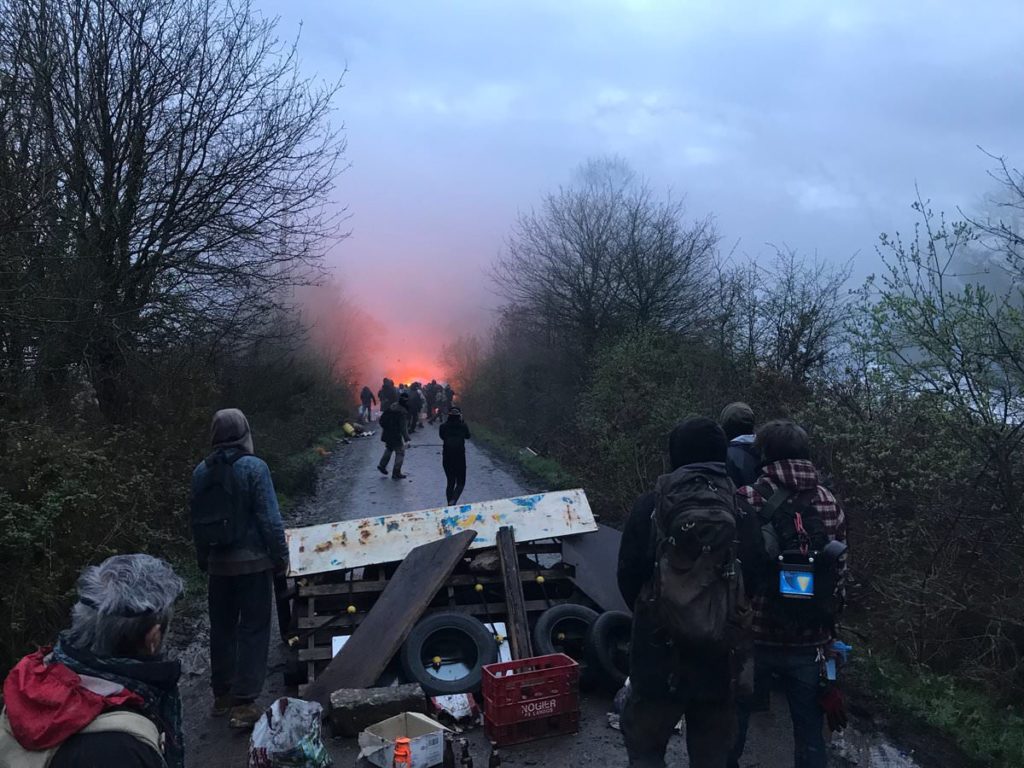
Fighting on one of the lanes manages to stop the cops moving further west. But elsewhere the bulldozers smash their way through some of the most beautiful cabins made of adobe and the wastes of the world that rose out of the the mud in the east of the zone, they destroy the Lama Sacrée with its stunning wooden watch tower, permaculture gardens and green houses are flattened and they rip gashes in the forest. A large mobile anti riot wall is erected by the police in the lane that stretches east to west, a technique that works in cities but in rural riots it’s useless and people spend all morning hassling them from every angle. Despite gas and stun grenades we hold our ground. Journalists are blocked for a while from entering, the police stating that they will provide their own footage (free of copyrights!). The “press group” gives them directions so that they manage to cross the fields and the pictures dominate the morning news.
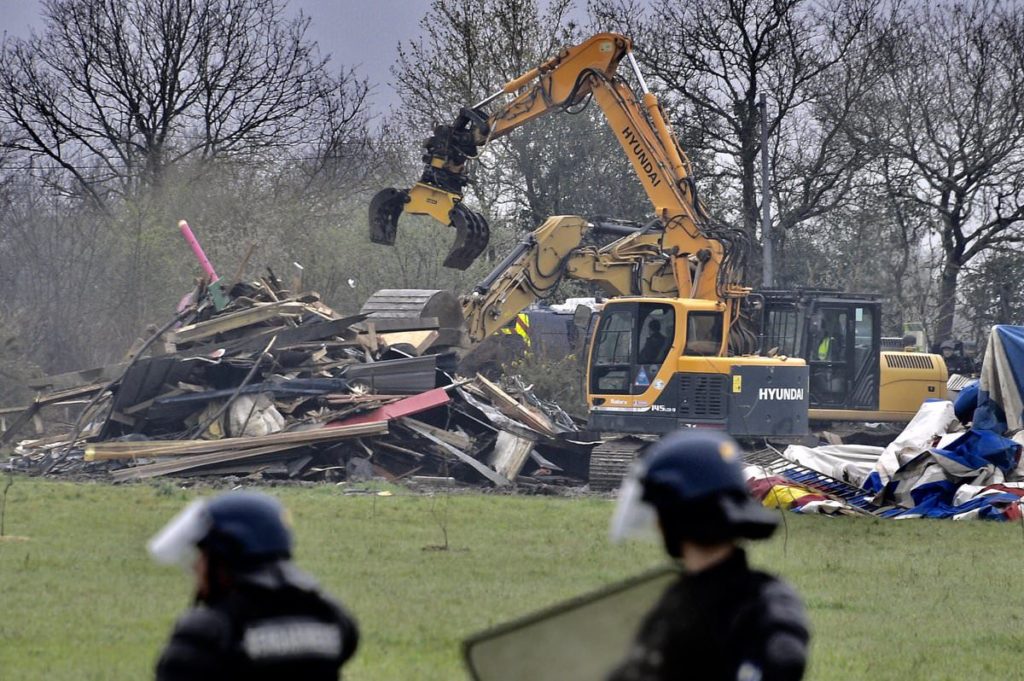
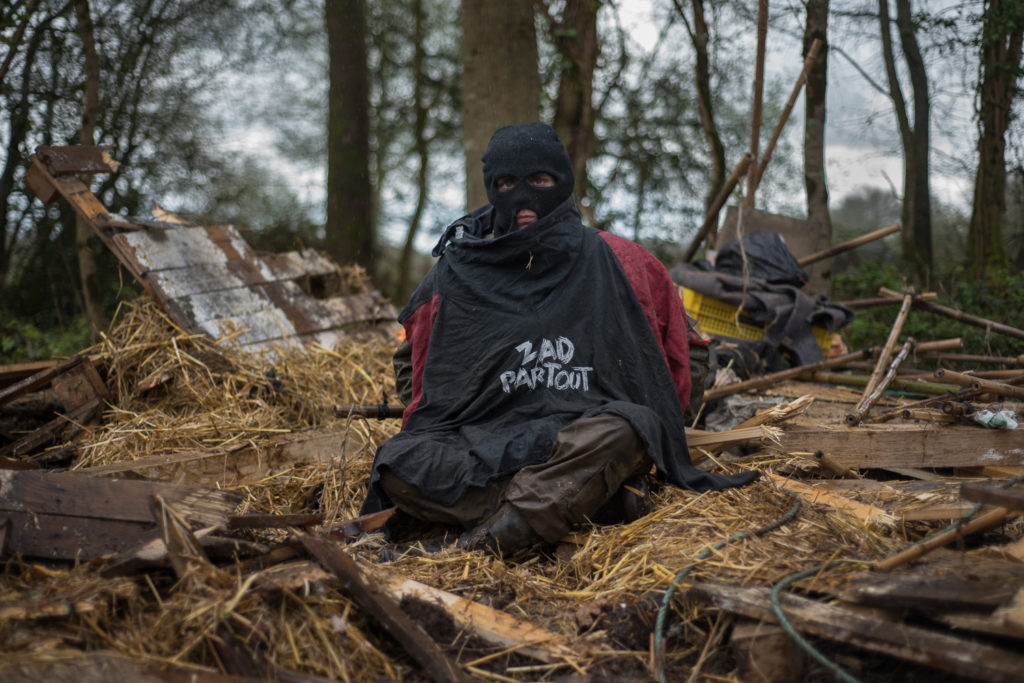
There are over a dozen of us are facing a line of hundreds of robocops at the other end of the field. One of us, masked up and dressed in regulation black kway is holding a golf club. He kneels down and places a golf T in the wet grass. He pulls a golf ball out of a big supermarket bag and serenely places it in the T. He takes a swipe, the ball bounces off the riot shields. He takes out another ball and another and another.
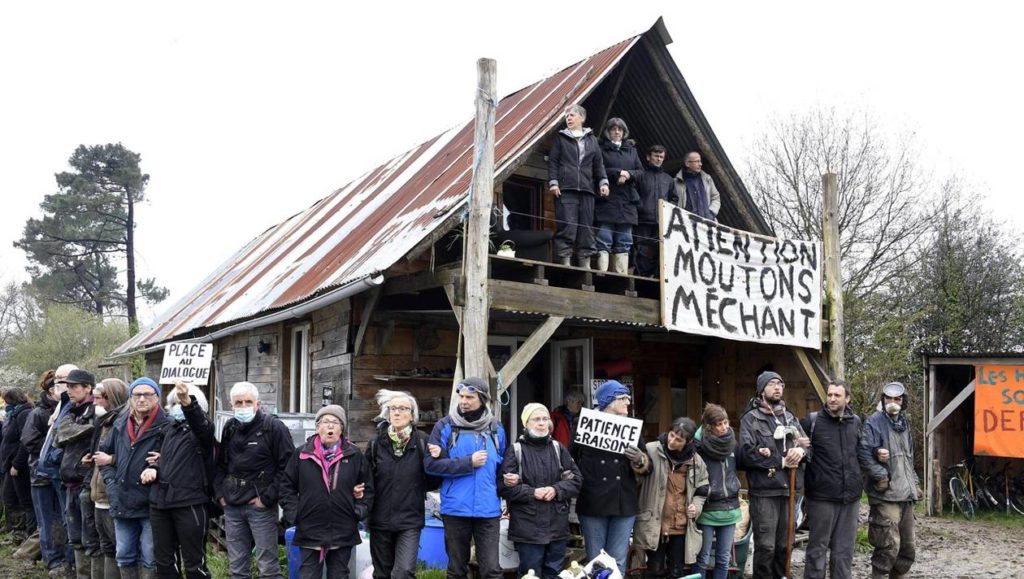
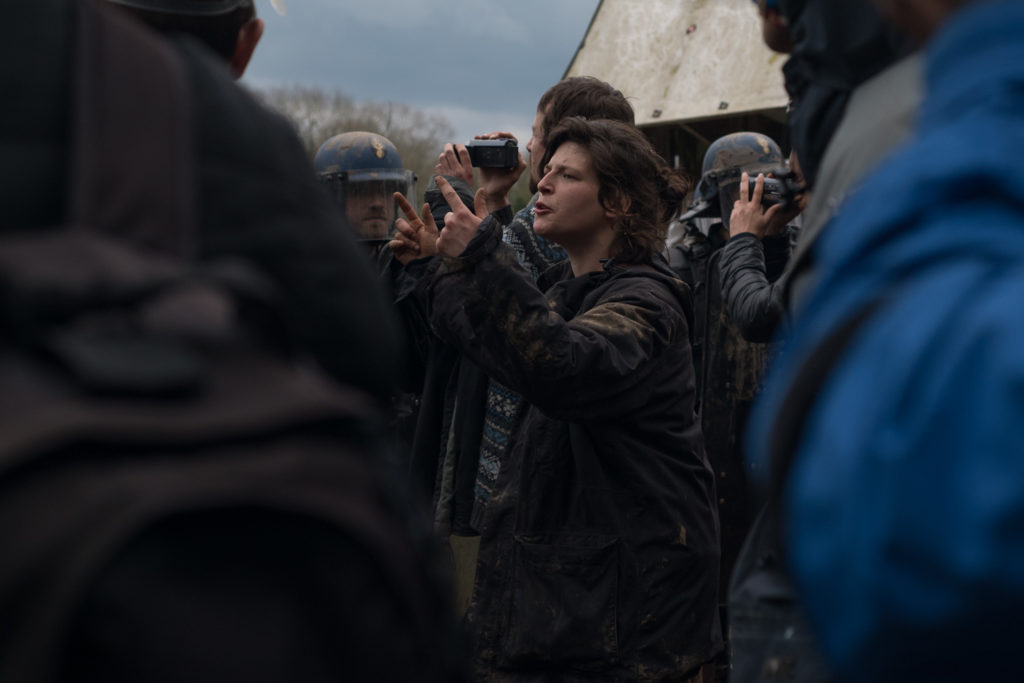
In the afternoon the cops and bailiffs arrive at the 100 noms, an off grid small holding with sheep, chickens, veg plots, and beautiful housing including a cabin built by a young deserting architect which resembles a giant knights helmet made with geodesic plates of steel. The occupiers, who have built this place up from nothing over 5 years are given 10 minutes to leave by the bailiff. Several hundred people turn up to resist, many from ‘the camp of the white haired ones’ which hasbrought together the pensioners and elders, who have called it a camp for “the youth of all ages” and have been one of the backbonesof this long struggle. There must be nearly 200 of us, at the 100 noms, this time no one is masked up. A massive block of robocops is coming up the path, some of us climb on the roof of the newly built sheep barn, others form a line of bodies pressed hard against the riot shields, we are peasants and activists, occupiers and visitors, young and old and they beat us, burn our skin with their pepper spray and push us out of the fields.
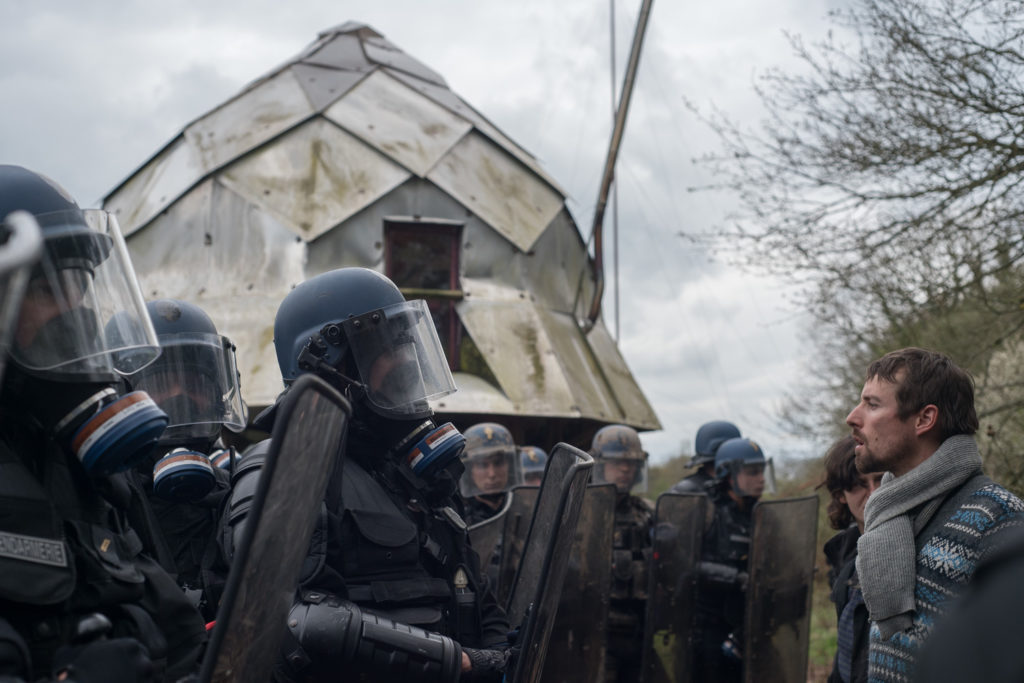
We reply with a joyful hail of mud that covers their visors and shields. The people on the roof are brought down by the specialists climbers and the bulldozer does its job. A few minutes later a one of their huge demolition machines gets stuck in the mud, a friend shouts ironically to the crowd: “come on let’s go and give it hand and push it out!”, Hundreds approach, trails of gas take over the blue sky, dozens of canisters rain down on the wetlands, many falling into the ponds which begin to bubble with their toxic heat. I try to console Manu whose home, a tall skinny wooden cabin with a climbing wall on its side, has just been flattened, my hugs cannot stop his sobs. Our eyes are red with tears of grief and gas.
In the logic of the state, the 100 Noms ticked many of their fantasy boxes of those want to be legalised, ‘the good Zadists’. It was a well functioning small holding, producing meat and vegetables and where the sheep were more legal than its inhabitants. It was a project that had the support of many of the locals. Its destruction lit a spark that brought many of those in the movement who had felt a bit more distant from the zad recently back into the fold of the resistance. Of course its no less disgusting than the flattening of all the other homes and cabins, but the battle here is as much on the symbolic terrain as in the bocage and it is seems to be a strategic blunder to destroy the 100 Noms.
The live twitter videos from the attack are watched by tens of thousands, news of the evictions spreads and a shock wave ripples through France. Actions begin to erupt in over 100 places, some town halls are occupied, the huge Millau bridge over 1000 km away is blockaded as is the weapon factory that makes the grenades in Western Brittanny.
The demolition continues till late, but the barricades grow faster at night, and we count the wounded.
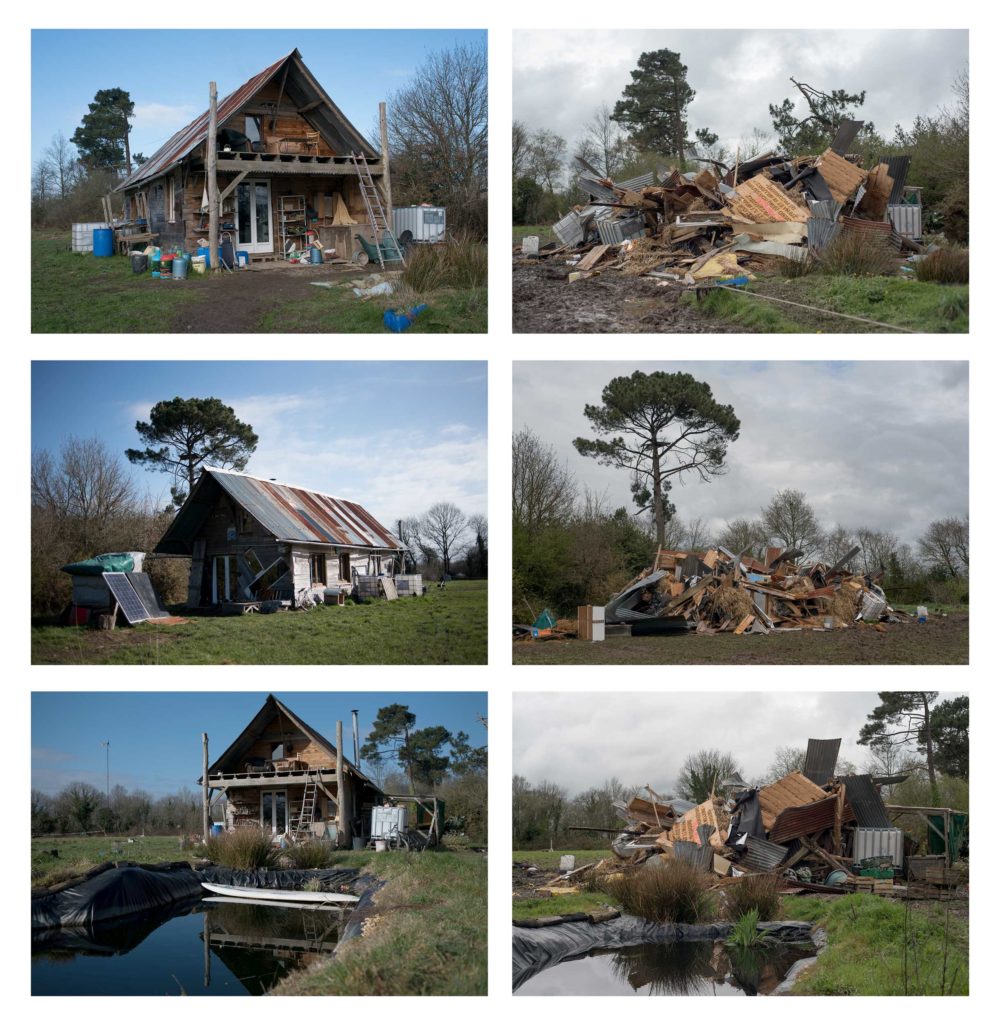
It all begins again before sun rise, the communication system on the zone with its hundreds of walkie talkies, old style truck drivers cb’s and pirate radio station calls us to go and defend the Vraie Rouge collective, which is next to the the zad’s largest vegetable garden and medicinal herb project. We arrive through the fields to find one of the armoured cars pushed up against the barricade, we stand firm the barricade between us and the APC. We prepare paint bombs to try and cover the APC’s windows with. Then the tear gas begins to rain amongst the salad and spinach plants. A friend finds a terrified journalist cowering in one of the cabins, she writes for the right wing Figaro newspaper and is a bit out of place with her red handbag. “What’s that noise??” she asks, trembling, “the stun grenades” he replies. “But why aren’t you counter attacking?” she says, “where are your pétanque balls covered in razor blades?” Our friend laughs despite the gas poisoning his lungs, “we never had such things, it was a right wing media invention, and it’s impossible anyway, no one can weld razor blades onto a pétanque ball! ”
There is so much gas, we can no longer see beyond our stinging running noses. The police are being pressurised simultaneously from the other side of the road by a large militant crowd with gas masks, make shift shields, stones, slingshots and tennis rackets to return the grenades. They are playing hide and seek from behind the trees. The armoured car begins to push the barricade, some of us climb onto the roof of the two story wooden cabin, others try to retreat without crushing the beautiful vegetable plot. Its over, the end of another collective living space on the zone. Then we hear a roar from the other side of the barricade. Dozens of figures emerge from the forest, molotov cocktails fly, one hits the APC, flames rise from the amour and the wild roar transforms itself into a cry of pure joy. The APC begins to back off as do the police. The Vraie Rouge will live one more day it seems, thanks to diversity of tactics.
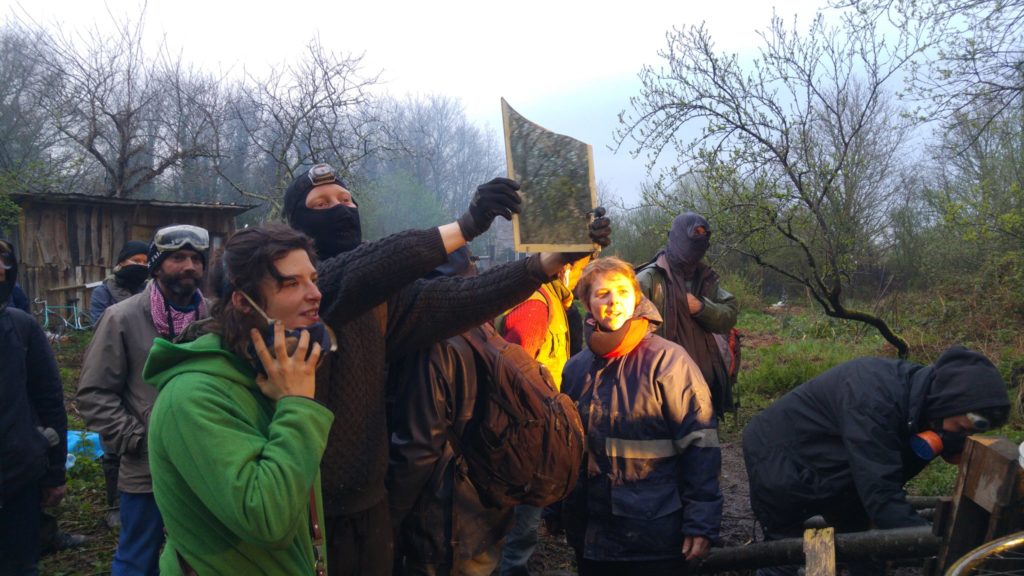
In 2012 when we managed to stop the first eviction attempts of the zone, this was what gave us an advantage. Over the 50 years that the movement against the airport lasted, it used everything from petitions to hunger strikes, legal challenges to sabotage, riots to citizens ecological inventories of the zone, defensive tree houses to flying rocks, tractor blockades to clown armies. Its secret weapon was the respect we had for each others’ tactics and an incredible ability to try and not condemn each other. Pacifist Pensioners and black bloc worked together in a way that I had never seen before, which made criminalising the movement much more complicated for the government. Movements win when they have the richest most colourful palette of tactics at their disposition and they are ready to use everyone of them at the right time and place.
In a woodland dip to the east of the zone, the Cheverie, is still resisting. A huge high cabin made from different types of swirling coloured clay – brown, grey, ochre and white – punctuated by mosaics and carved spiders, constructed by hundreds of hands, is about to be crushed. Hundreds of gendarmes surround it, one of them seems to have a machine gun strapped to his back. From the roof someone uses a traffic cone as a megaphone: “we are defending life and the living.” When the cabin is finally brought down a minor miracle occurs, none of the dozens of windows is broken, which will make it much easier to rebuild.
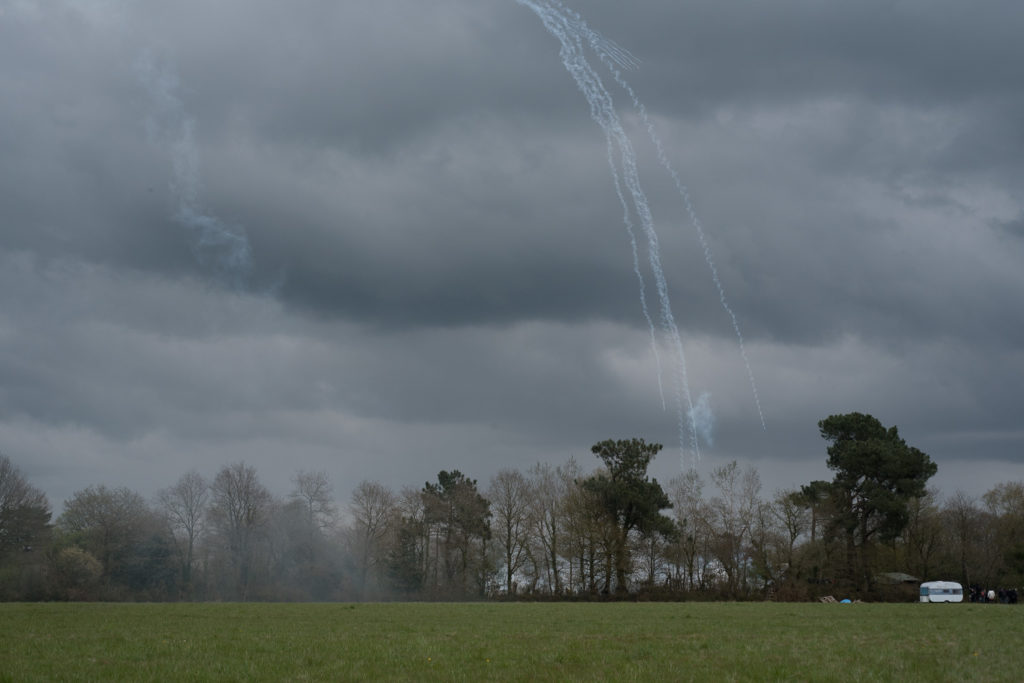
At the Fosses Noires, the brewery has been turned into a canteen, but the tear gas is falling on the pots, pans and piles of donated of vegetables. After lunch, a second press conference takes place, yesterday the first one had brought dozens of TV cameras and microphones from radios across the country, 8 people from all the composition of the movement faced the cameras, their dignified anger was so powerful, so palpable, many of us shed tears listening.
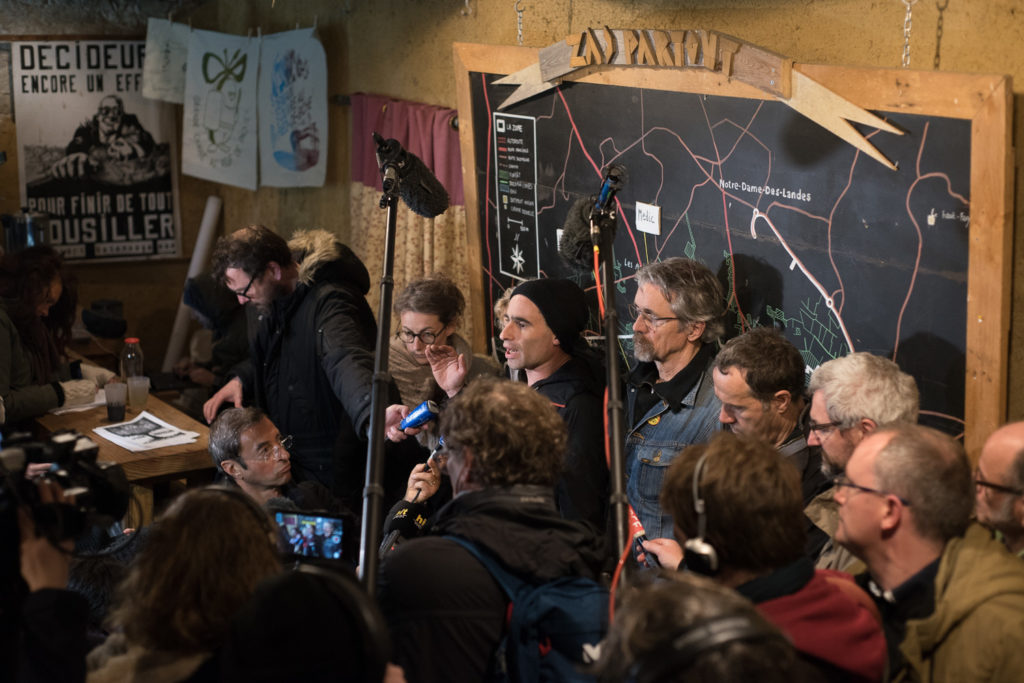
Today there are 30 inhabitants are in front of the cameras, it is those that have an agricultural and craft projects running on the zone, the tanner is there as is the cheese maker, the potter and market gardeners, cow herders and leather workers. They explain how over the last weeks of negotiations with the state, they handed over documents to develop a collective project within a legal non profit association that had been set up. They show that on this bocage to think ecologically is to realise that all the projects are interdependent, rotating the fields between folk, sharing tools and and everyone helping out on each others projects when needed. To divide the zad into individual separate units makes no sense.
But the words are not as strong as the striking image of Sarah, our young shepherdess who like a modern day madonna holds a dead black lamb on here lap. She explains how her flock was legalised already and that this one died from stress when it was moved from the 100 Noms farm to avoid the evictions. Her grey eyes pierce the camera lenses, “they chose violence, they chose to destroy what we build, they chose to break off the dialogue with us.” Whilem a young farmer, whose milk herd squats fields to the west, raises his trembling voice, “ If there is no collective agriculture then you get what’s already happening in the countryside – individualism: eat up your neighbours farm land, be more and more alone with a bigger and bigger farm,” he takes a deep breath, “the isolation is pushing farmers to commit suicide, we are more and more alone on our farms faced with increasing difficulties. On the zad we hold a vision of farming for all, not just for us.”
The zad makes a call for a mass picnic the following day. Vincent one of the supporting farmers from the region, a member of COPAIN 44, a network of rebel farmers whose tractors have become one of our most iconic and useful tools of resistance, sighs, “the government has broken any possibility of dialogue now, they have forced us to respond with a struggle for power.”
Between the tall poles that hold the breweries’ hop plants a long banner is raised, “Nicole Klein radicalised me.”
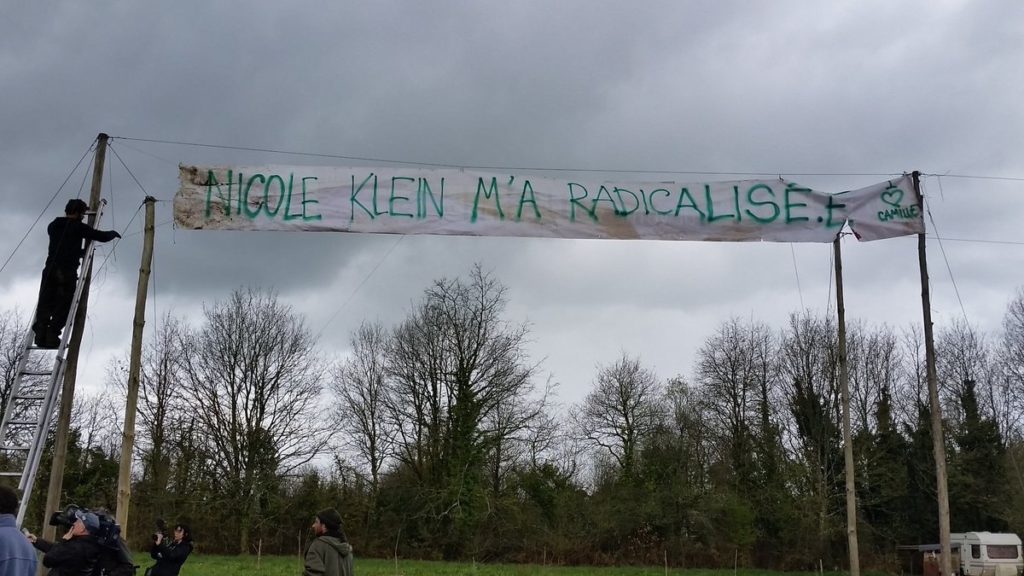
We are woken as normal by the explosions of gendarmes grenades, fighting continues near the D281 road. A small group is trying to stop the police lining up in a field, there aren’t many of us, it feels hopeless, then out of the morning mist comes a tractor, its driver wears a balaclava, in the front bucket – a tonne of stones. He drops them in a pile just where we are standing, puts the tractor in reverse and disappears back into the mist.
In the next door field a towering guy wearing a balaclava and dressed in a full monks habit throws a bucket of water over a handful of robocops – “I baptise you in the name of the zad”, he bellows. A cloud of pepper spray engulfs him, but one the gendarmes slips in the mud and drop his truncheon, at the speed of light the monk grabs it and runs off, wielding his rebel relic in the air. The police megaphone calls out “You must return the state’s property. Return it now!”
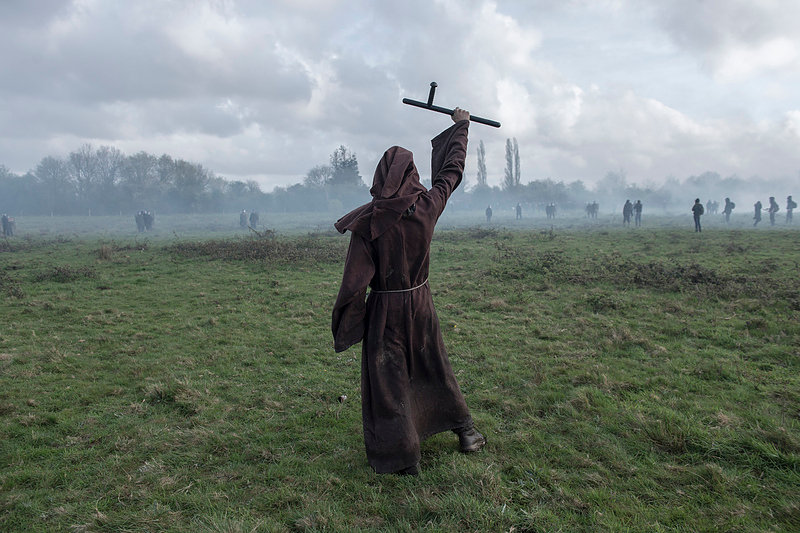
The picnic before it was gassed.
At lunch time, over a thousand people turn up to share a picnic in the fields. Over thirty tractors have come, some from far, despite the fact that its one of the busiest seasons for the farmers, they encircle the large Rouge et Noir collective vegetable garden, now littered with hundreds of toxic plastic tear gas canisters. “The state crossed the red line when they destroyed the 100 Noms” one of them says.
The crowd of all ages walk through the barricades and debris of yesterday’s battle that litter the country lanes. The atmosphere is festive, a samba band with pink masks leads us into the field beside the Lama Sacrée. A long line of black clad police stretches across the spring green pasture. The samba band approach, then all hell lets loose: gas canisters shower down, dozens of stun grenades are thrown into the peaceful crowd, panic ensues, people retreat across the hedgerows.
The houses of la Boite Noire, Dalle à Caca, Jesse James and la Gaité fall in the east. Simultaneously they attack la Grée, the large rambling grafitti covered farm at the centre of the zone that has an unconditional welcome policy. There is a car repair workshop, climbing wall and the rap studio and many folk escaping the misery of street life and addictions end up living there together. Farmers’ tractors are surrounding the building, a barricade made from the carcasses of cars, is set alight. But the tear gas is too strong and the tractors are forced to back off.
Out of the mist of gas come black lumbering troops, they charge across the fields. The whole zone is split in two by a seemingly endless lines of robocops stretching east to west. The crowd is dispersed, people are coughing up their lungs, they are furious. It began as a picnic, now it’s a war zone again. The gas clouds cling to the pasture, frightened cows huddle together in a corner of a tiny field. The medic post at the Fosses Noires has to move away to the Gourbi, but then the gas catches up with it there too and it moves to La Rolandière just in time before the police arrive to smash one of the zone’s most symbolic sites, the Gourbi.
In the very centre of the zad the Gourbi is where the weekly assembly of occupiers is held and Friday’s No-market, a place where excess produce is distributed with no fixed price but by donation only. Initially there was a stone farm house there, inhabited by an old couple who were evicted in 2012 and their home destroyed for the airport project. Then a wooden hut was built in its place, but its ramshackle pallet sides soon needed restoring and so a brand new state of the art cabin like meeting house was built over 2015. But one night someone sneaked into this beautiful meeting house and set it alight.
But Gourbi was to rise from the ashes, and as an ironic response to the governments 2016 local consultation about the airport project, we held an all night building party whilst the results came through (55% for building the new airport). To the sound of a wild one man accordion band doing kitsch covers of Queen and other trashy pop songs, hundreds of people stuffed the clay of the wetlands into a huge geodesic metal dome structure to build our new round meeting house. It was made of steel and mud to resist arson, but today the bulldozer crushed it with a single swipe of its blade. Worlds away in the metropolis, the Minister of Interior, Gérard Collomb, tells parliament “We want to avoid all violence in this country, this is what we are doing at Notre-Dame-des-Landes.”
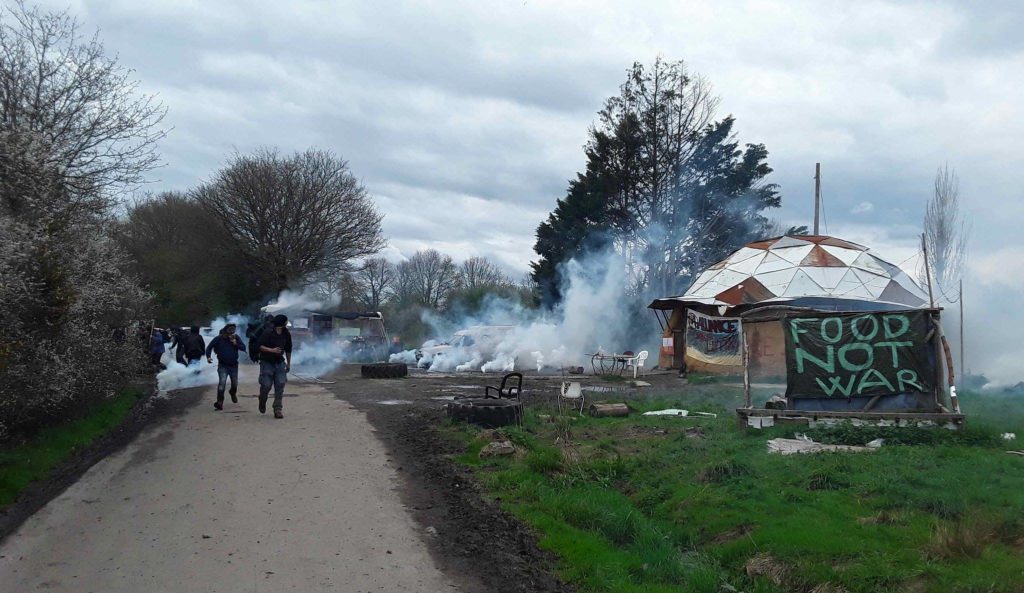
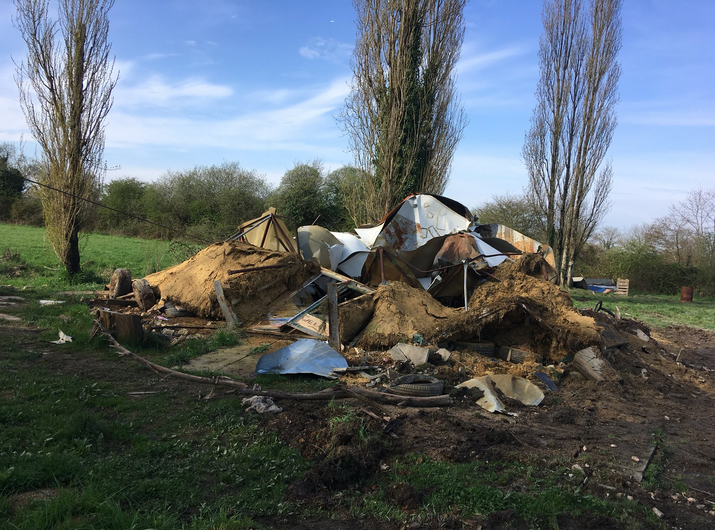
By sunset the government claims to have evicted 13 more living spaces, bringing the total to 29 since Monday. The prime minister refuses to pause the operations, and the medic team share horrific photos of some of the 60 injuries since Monday, including 3 journalists. Meanwhile the cops release their figures: 32 injuries, but it turns out most are from the mis use of their own weapons. Solidarity actions pour in from thousands, including squatters in Iceland, farmers in Lebanon and eco builders in Columbia. In Paris, sex workers send in kinky zad themed S and M photos and students occupy the EHSS elite social science school in solidarity. That afternoon electricity is cut across a large part of the zone and many of our neighbors homes outside of the zad. It is a tactic reminiscent of collective punishment used during military occupations , At night the gentle lulling croak of mating frogs in the marches mixes with the hum of back up electric generators. Four hundred of us meet at the Wardine, in the old concrete cow shed covered in bright murals, we share stories, dogs bark, tempers fray.
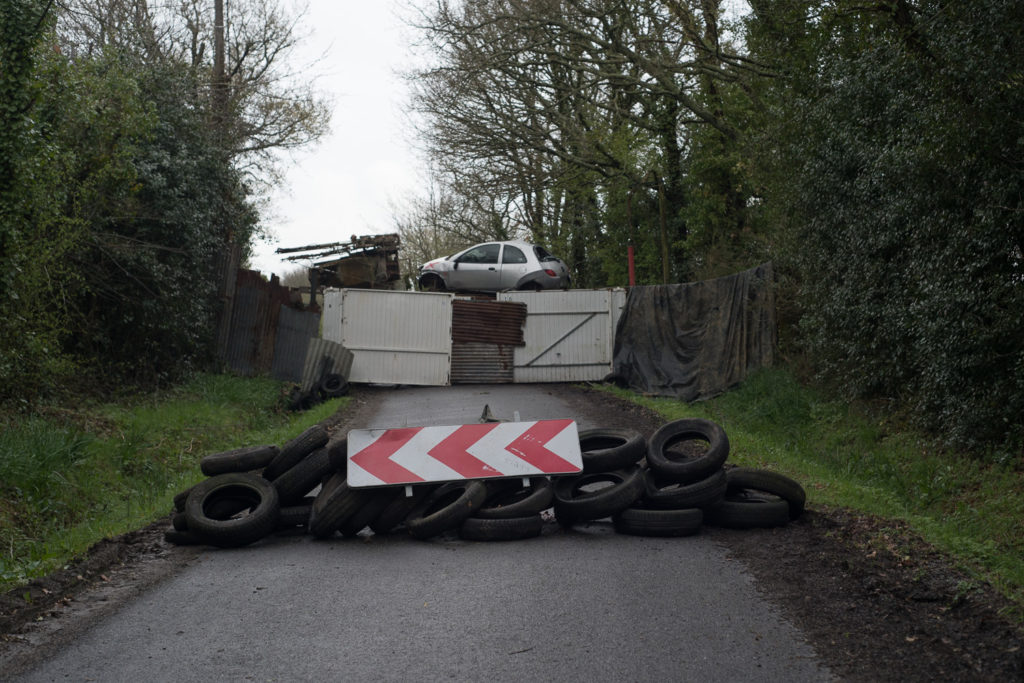
The day begins with some good news on radio klaxon. An affinity group action just shut down the motorway that passes near the zad. Emerging from the bushes they flowed down onto the tarmac armed with tyres, fluorescent jackets and lighters. Within seconds a burning wall blocked the flow of commuters to Nantes. The group disappeared just as quickly as they materialised, melting back into the hedgerows. The more we fight for this land, the more we become the bocage and the harder it is to find us. Every day more and more people converge here, many for the first time in their lives.The art of the barricade continues across the zone, including one topped with an old red boat. Some of our most useful barricades are mobile, in the form of tractors, dozens of COPAIN 44’s machines take over the main cross roads of the zone.
Following an attempt by friendly lawyers to prove that the eviction of the 100 noms was illegal, the prefect is forced to appear in court in Nantes, but the case is adjourned. The indefatigable zad press group sends out a new communique entitled, After 3 days of evictions are they ready to kill because they don’t want a collective ? Clashes continues across the bocage as Macron take to the TV screens for a national statement about his policies. A social movement is rising against him, with university occupations, supermarket, rail workers and Air France on strike – he has to respond. The mise-en-scène is bizarre, he sits in a primary school class room. He speaks about the zad for a little over a minute, “republican order must be returned” he says, and “everything that was to be evacuated has already been evacuated”.
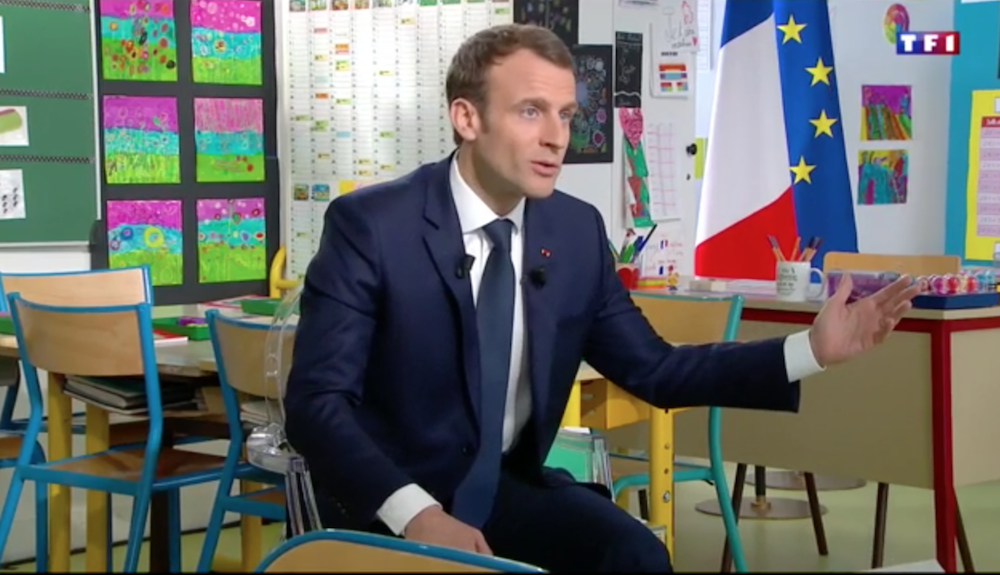
As he speaks a hundred and fifty concussion grenades are launched in less than half an hour in the Lama Sacrée field, the explosions echo across the bocage, bursting the ear drums of those nearby and raising the anxiety levels of those within hearing distance, which on this flat landscape of the zad, is all of us. The league of Human Rights demands that all parties come back to the table. A call is sent for people to converge on the Zone on Sunday: “ The time has come to find ourselves together, to say that the zad must live, to dress our wounds and re build ourselves..” …
We walk home to la Rolandière, with its ship shaped library attached to the lighthouse, built where they wanted to build the airport control tower. The sun is setting, 20m high up on the lighthouse’s balcony a lone figure is playing a trumpet, fluid sumptous jazz floats across the forest. It is one of those moments when you remember why you live here.
That night under a clear constellation filled sky, the Assembly of Usages meets. We sit on wooden hand made bleechers under Le hangar de l’avenir (The Barn of the future). This cathedral like barn was built by over 80 traditional carpenters in 2016 using mostly hand tools, it is ornamented with snakes and salamanders carved into the oak beams. There are several hundred of us at the assembly, one of the peasants whose tractor is blocking the crossroads reads out a series of texts messages he has received from the préfete who is trying to negotiate with COPAIN 44. “Yesterday the Prime minister said it was war, today the president says its peace, therefore it’s all over.” It’s clear that she’s feeling that the situation has become much more complicated than predicted. A deal is made, move your tractors she writes, and I promise that by 10pm I will announce to Ouest France, the regional news paper, that it is the end of operations by the Gendarmes.
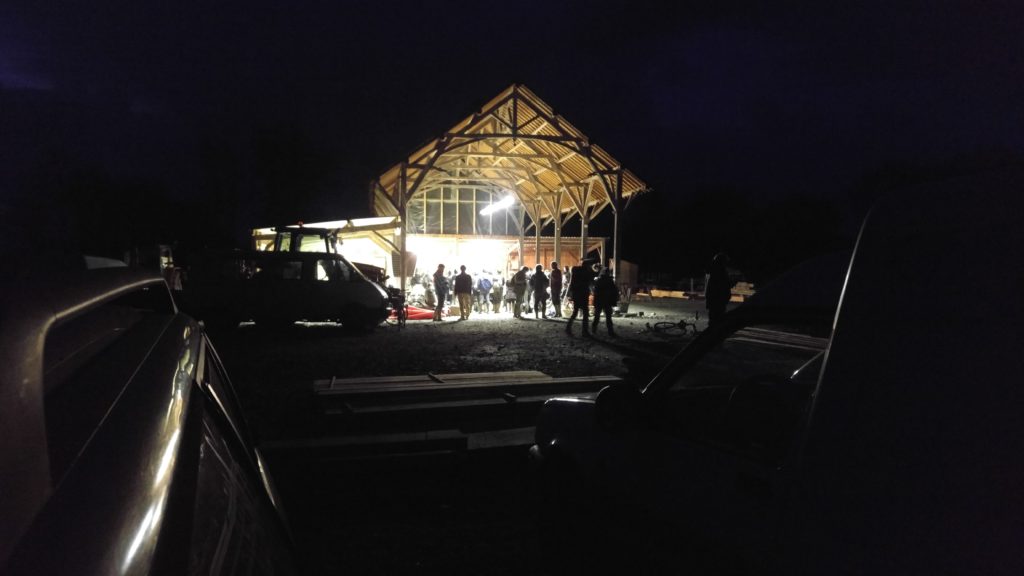
The meeting continues, we wait for the article to appear on the newspaper’s web site. I reload my phone endlessly waiting for the site to update. Suddenly it does, but it’s just a story about rock legend Johnny Hallyday, was it all a bluff ? Then it arrives, half an hour late. A cheer rises from the tired voices. At home we try to party a little, at least we might get a lie in tomorrow morning, it seems that it’s over for the time being?
I’m half awake, there is a rumble of vehicles on the road… At first I think it’s tractors, then I see the lights, blue and flashing, van after van of cops passing. We leap out of bed and run to the top of the lighthouse, the entire road is filled with vans as far as the eye can see. The huge barricade at the crossroads, which the tractors left last night following the préfete’s announcement, is on fire, a plume of black smoke frames the the orange dawn. The familiar pop of tear gas canisters being fired is accompanied by the crunching sounds of barricades being pushed by the APC. Radio Klaxon says they have kettled la Grée and are searching it, the Wardine camping is also encircled and a hundred and fifty cops are heading towards the Rosier. The Lascar barricade, made of several burnt cars, with a huge metal doorway and a trench that is several meters wide, is being defended by a nearly 100 of us. The forest is wrapped in toxic mist, ghostly rebel silhouette run from tree to tree, stones are aimed at the robocops with catapults that were made by Andre, an 83 year old who set up a production line for us during the eviction threats of 2016, his team churned out 1000. The cops throw stun grenades blindly from the fields into the forest, one explodes just above my head, caught in the tree it rips the bark into smithereens. Is this what they call the end of operations ?
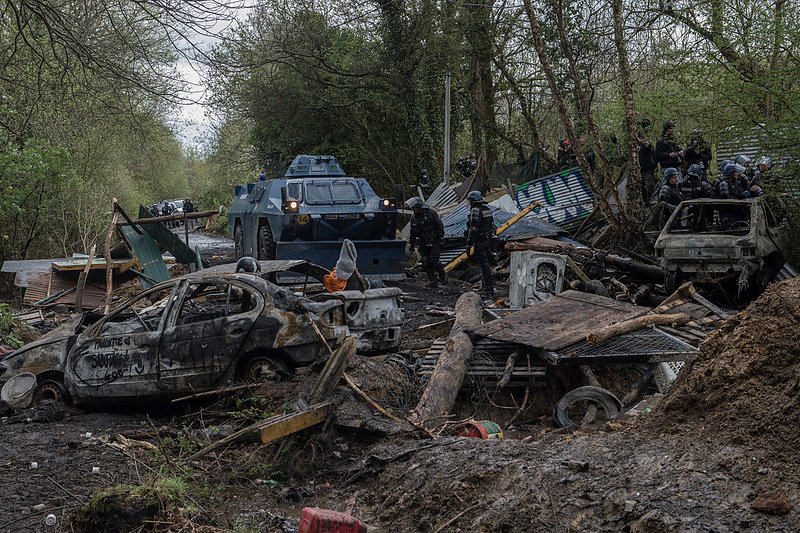
A communiqué from the gendarmerie explains that they are clearing the roads and are not doing any expulsions or knocking down any squats, but that they are looking to arrest people who fired a distress rocket at their helicopter. At la Grée they take away two people but not for that charge. The gas pushes everyone back from the Lascar’s barricade and the grinders come out to cut the metal gateway into pieces. Despite the rising clouds of tear gas, people on the roof of the brand new Ambazada, a building that will host folk from intergalactic struggles, manage to sing some of our re purposed folk songs, recount the history of the struggle of the zad.
Then a moment of joy, one of the armoured cars attacking the Lascar tips into a ditch and has to be pulled out by the other one. The mud of this wetlands has always been our ally, its wetness our friend. When they retreat a banner is put up, “Cheap APC driving license available here.” Our other accomplice is humour of course, even in what feels like a war zone, with tarmac scorched, broken glass and rubble everywhere, being able to laugh feeds our rage. The police retreat again and the barricade grows back out of its ruins, bigger and stronger than ever. We notice that where the APC fell into the ditch is now a huge deep hole at exactly the place where the drain for the Ambazada was going to be dug, no need for digging, just put the plants in it to make our grey water reed bed. That’s what you call radical permaculture, least effort for maximum gain.
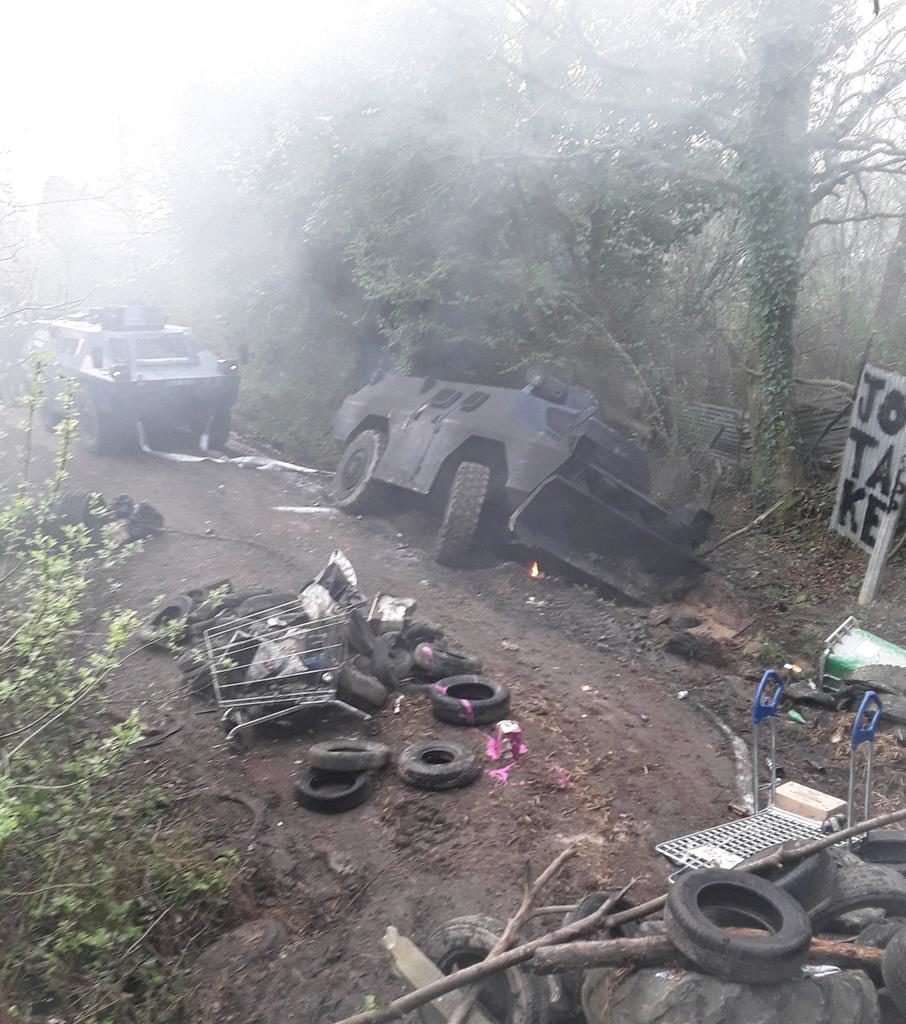
At midday the préfete begins her Press conference in Nantes. She confirms last nights message – evictions are over – and in a dramatic gesture, flourishes a page of A4 paper towards the cameras. “It’s a simplified form” she tells the press, “so that those who wish can declare their projects as quickly as possible…The deadline is the 23rd of April” she continues “ all we are asking is that they declare their names, what agricultural project they wish to develop and to tell us what plot of land they wish to work on, so that the state can process them.” She also confirms that it was Macron who was running the operation not the prime minister or interior minister, it was he who decided to stop the expulsions. “I am holding out my hand” she says, and asks for negotiations to re start on Monday, “I am giving the zadists a last chance.” Sitting next to her General Lizurey in charge of the Gendarme’s operations says that the number of zadists on the zone has increased from 250 to 700.
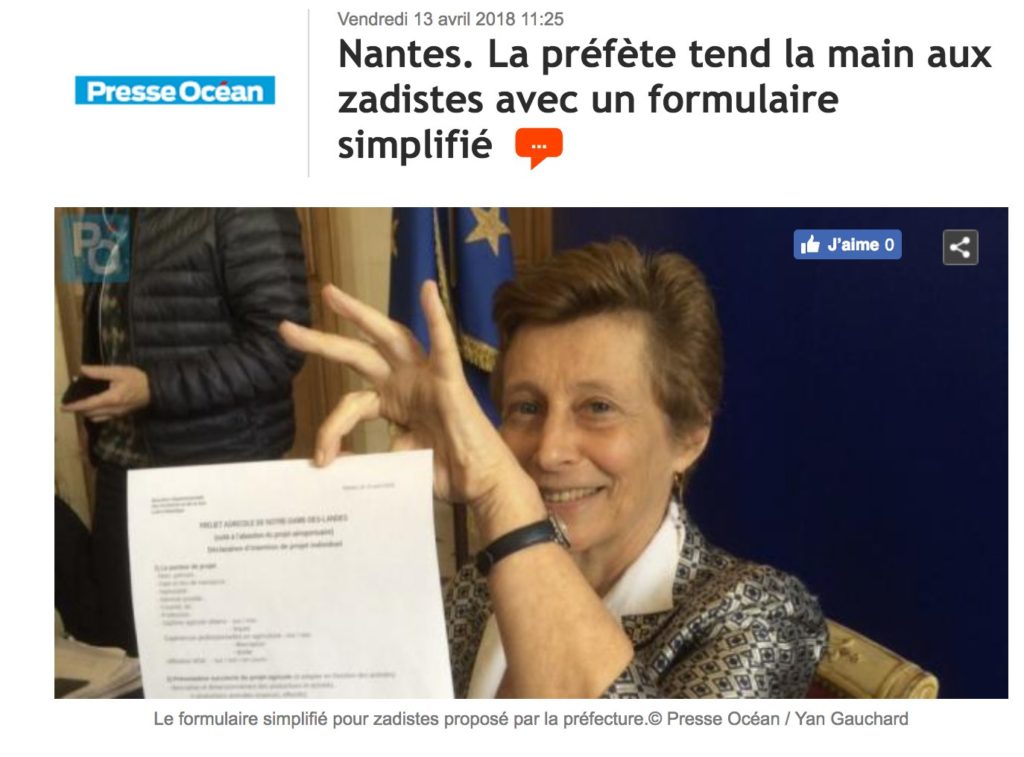
I walk through the Rohanne forest to The Barn of the Future, I breathe in the forest air, the sweet pine, the musty damp smell of mushrooms. The barn has returned to its normal use as a saw mill and carpentry workshop for the zad. It is the base of the Abracadabois collective that looks after the forests and hedgerows, harvesting fire wood and building timber and setting up skill shares to learn carpentry, forest biology, wood carving, chain saw use and learning about other ways of inhabiting forests inspired by indigenous practices from past and present. The saw mill is planking the logs, twenty carpenters are busy preparing frames for a new building, a new assembly and no-market hall for the Gourbi, that we aim to put up on Sunday during the mass action.
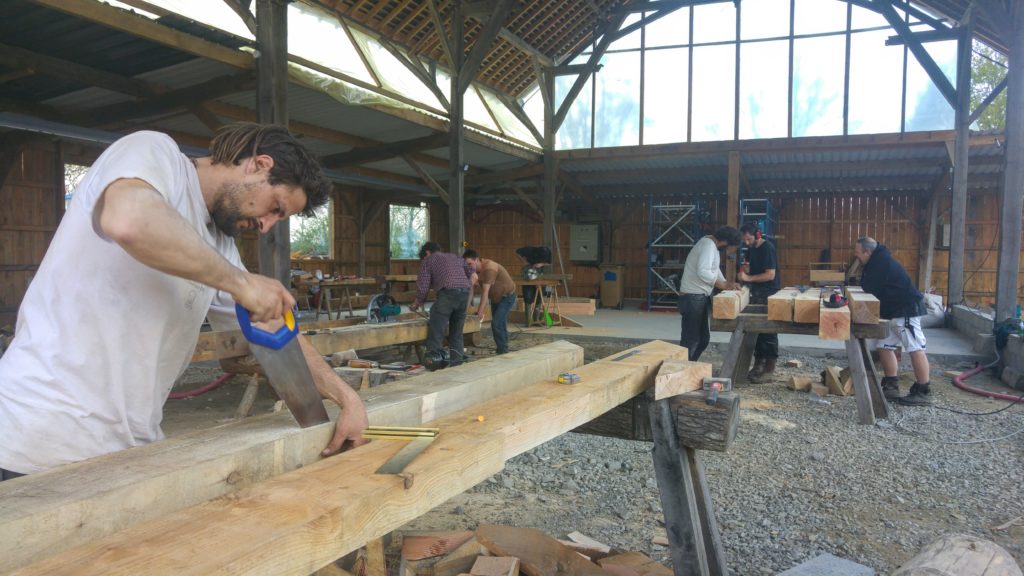
This morning I was enveloped in tear gas and now I’m watching some of the same barricaders without their gas masks making a barn using the techniques that have been used for millennia. It is somehow healing to watch the attentive work. It is this capacity to fight and build, to block capitalism and to construct other forms of life which gives the zad its strength. It is also another reason the state wants to destroy us, they can deal with nice clean alternative eco projects, easy to buy off and recuperate into new forms of green capitalism. But when those who have a systemic critique are also providing material examples of other ways of being, it becomes dangerous. The resistance and creativity, the no and the yes, are the twin strands of DNA of this territory, split one from the other and the zad dies. It becomes another ecovillage or Transition Town, alternatives without teeth.
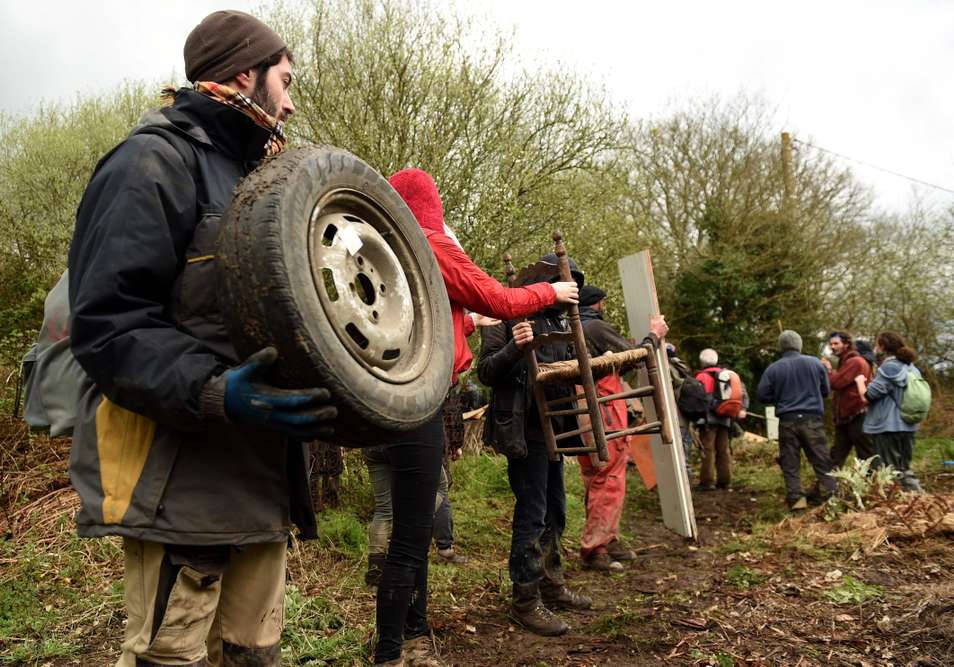
Yet a second helicopter is flying above the barn, this time with Prime Minister Edouard Philippe and the minister of interior inside, they are getting a private birds eye tour of the zad. They have come to congratulate the troops for their hard work. As he shakes hands with the gendarmes Phillippe tells the press that “the state will not accept any reconstruction or reoccupation.” He is referring to the action planned on Sunday, “Any place that tries such an action will exclude itself from any possible regularisation…. and will thus put themselves under judicial proceedings.” Once again the threat of sorting the good zadists from the bad. The carpenters work late into the night.
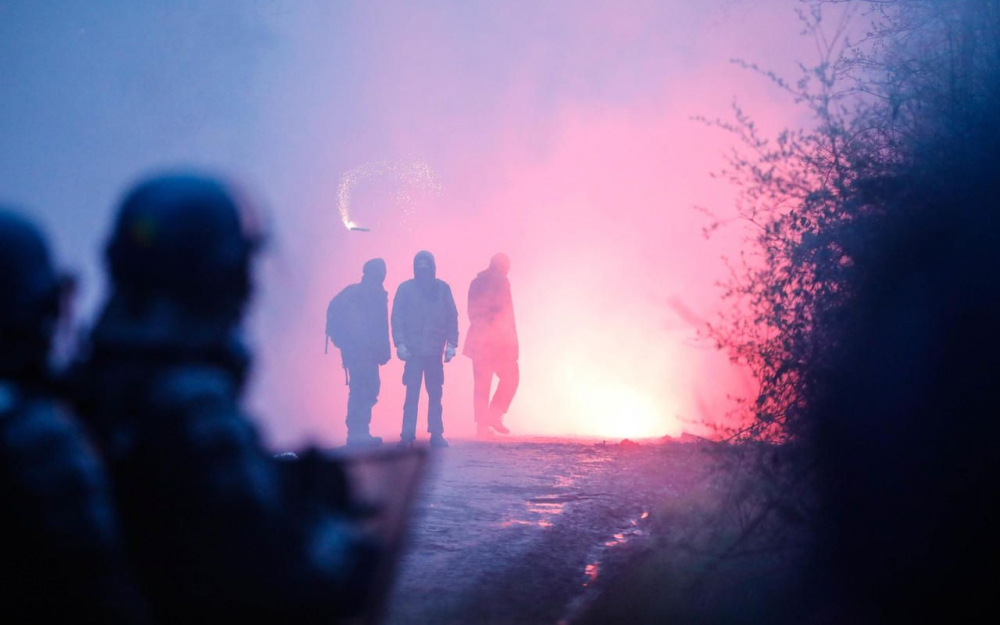
Bang, another wake up call, the APCs and dozens of vans pass by at the speed of a TGV train, bulldoze the barricades away on the D81 road again, and continue South, probably to Nantes where striking workers are holding a demonstration followed by one against the eviction of the Zad.
Barricades are cleared at the Lama Fachée at the same time, and a strange new gas is spotted, dark yellow. It makes people throw up, sows mental confusion and a loss of all spatial and temporal senses. Behind one of the barricades, a trio of action medics are keeping an eye on the adjoining woodland where grenades are exploding, “ It’s been war wounds here,” they explain “skin and nerves hit by shrapnel, open gashes, eardrums damaged, necrosis and bone fractures.” Some folk have over 70 pieces of shrapnel in their limbs, it takes hours every day to pull them out and clean them, some have gone 3cms deep into the skin. Many of the new comers on the zone throw themselves into picking up the thousands of gas canisters that litter the fields, placing them in big bags for everyone to see in the “camp of the white haired ones.” Each canister costs 110 euros.
The demonstration in Nantes is big, 10,000 people. The 1000 riot police on duty attack it and gas people drinking on the café terraces.
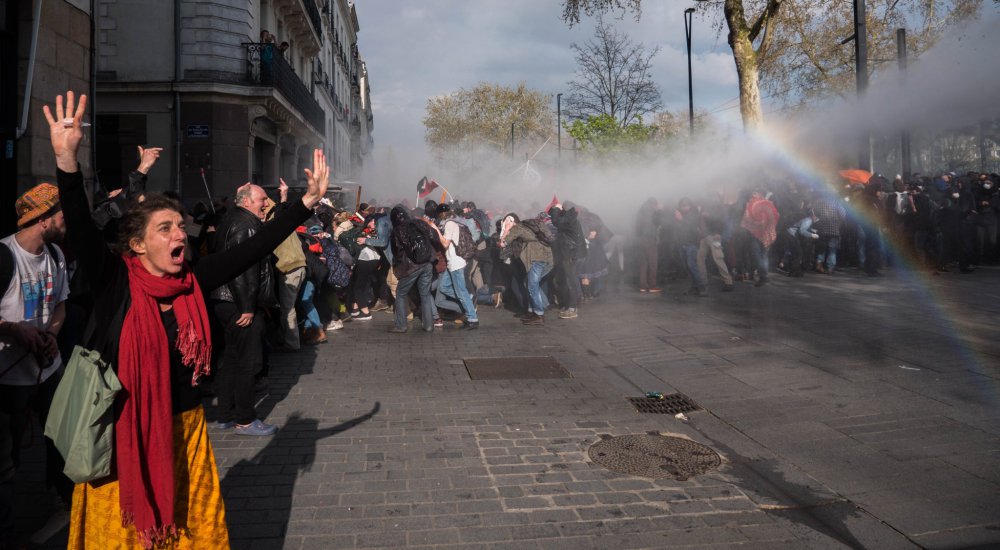
The sun set is dark red this evening. The wood working tools and machines are cleared aside, the Barn of the Future becomes a meeting hall again for the Assembly of Usages. The fresh smell of saw dust perfumes the discussions about whether we should go to back to the negotiations on Monday. The response is no, not yet.
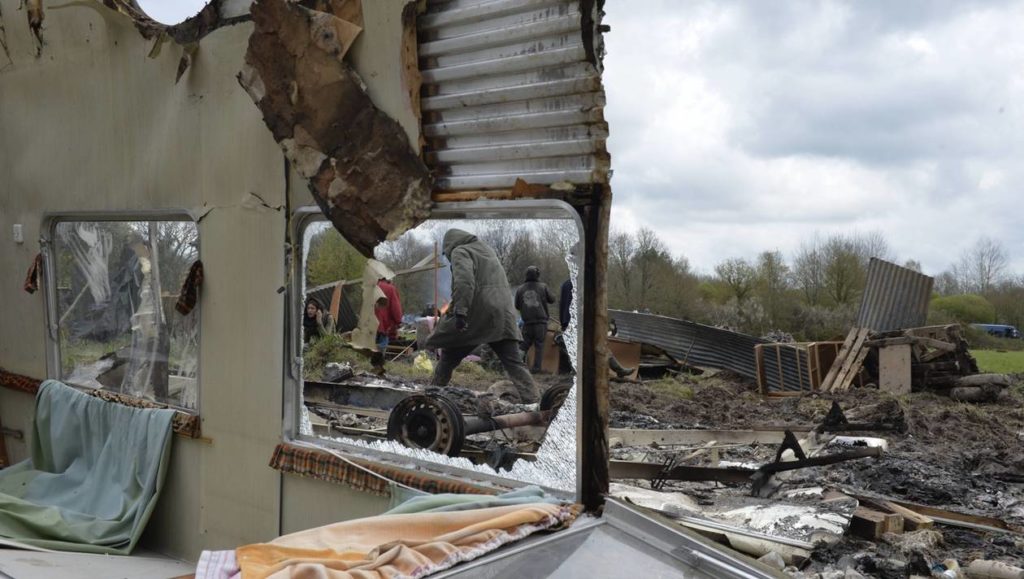
It’s the big day, thousands of people from all over the country are converging on the zone for the day of mass action. The troops have cut off a third of the zad, they line the lanes for kilometers, cutting off access to any of the part of the zone where homes had been destroyed last week. This includes the Gourbi where we hoped to bring the new building too. All road access to the zad are blocked off by the gendarmes, they tell people to go home because they won’t be able to reach the demonstration. But more than ten thousand of them disobey, park their cars and coaches in the nearby villages and trek for over an hour across the bocage. The details of the new building are still being finished, as the crowds arrive, such as a large ‘fuck you’ finger and the face of a fox that are being carved.

Through the pirate radio, text messages and word of mouth, we tell people to converge on Bellevue, the big farm in the west and wait for a decision about what we will do. 50 of us meet in a field in an emergency meeting, the farmers don’t want to risk their tractors, we don’t want to have a gesture that feels too symbolic, once again the collective intelligence comes to the fore and we come up with a plan B. The building will be erected as close to the front as possible without forcing the police line, there are too many families here to risk being gased.
Simultaneously we will ask people to unearth the staffs and sticks that had been planted in the ground in October 2016 when the government told us they were coming to evict. It was a ritual disguised as a demonstration, 40,000 people answered the call, planted their stick into the ground and made a pledge to return to get them if the government came back to evict the zone for the airport. The ritual magic worked, that time the government stood down. But now they were back with a vengence and the moment has come.
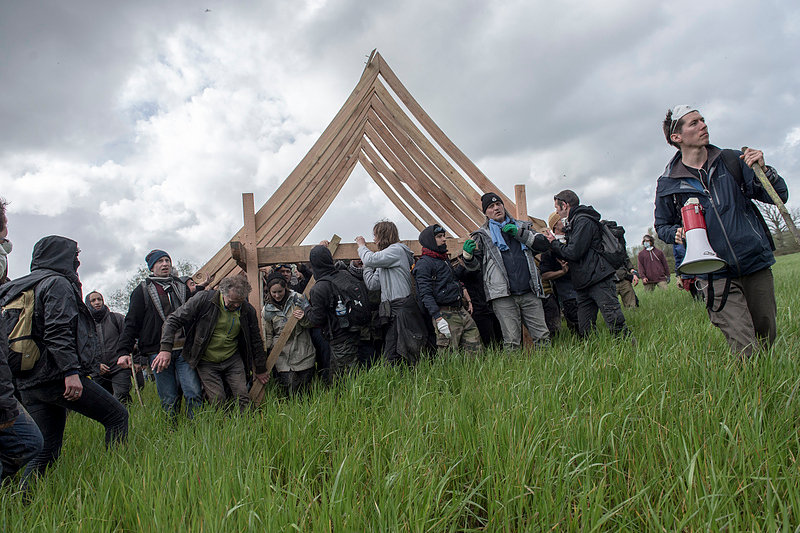
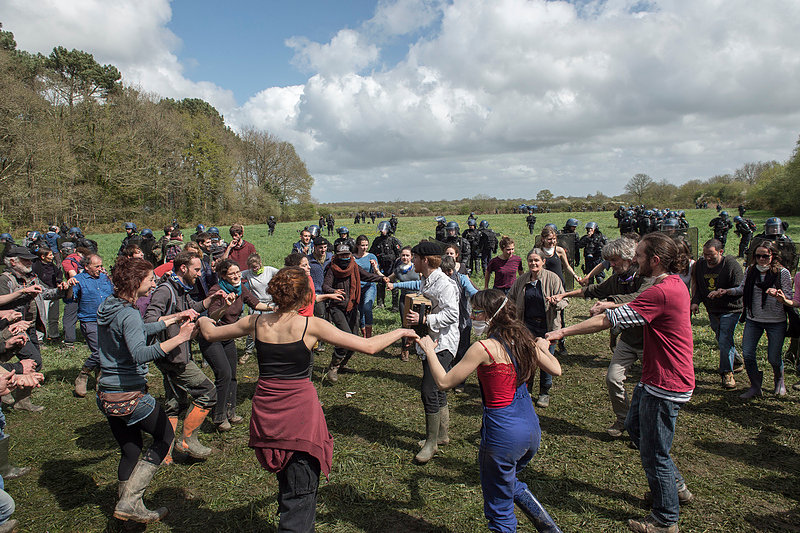
Whilst people pulled the deeply charged sticks out of the clay, others on lane behind carried the huge wooden frames, planks and beams of the new building to the field between between the Wardine and the Ambazada. It takes a few hours to put the carpentry back together and raise the structure up, meanwhile thousands of people push their sticks back into the ground creating a huge circular pallisade around it. In the next door field the police start to tear gas and stun grenaded hundreds of people, some had been reading poems to the cops many held their hands in the air in a gesture of peace. Families hold their ground next to masked up barricaders.
Meanwhile, a handful of people decide as a kind of game, to take the campanille, the tower like addition of the new building, through the forest to the east. A crowd of hundreds follows, we cross the road next to the cops who charge but are forced back by the mass of bodies, we try to get as near to the Gourbi as possible. The wind is on our side and blows the teargas back into the cops lines. But the playful act of defiance ends when its clear that we can’t get anywhere near the Gourbi, the police lines are too thick. However, the pleasure of running through forests and fields carrying part of a wooden building is clearly addictive. A few hours later, once the sun has gone down and the cops have left, a new plot is hatched. Why don’t we move the whole building, one and a half tonnes of it, 3kms across the fields, in the dark – to the Gourbi !
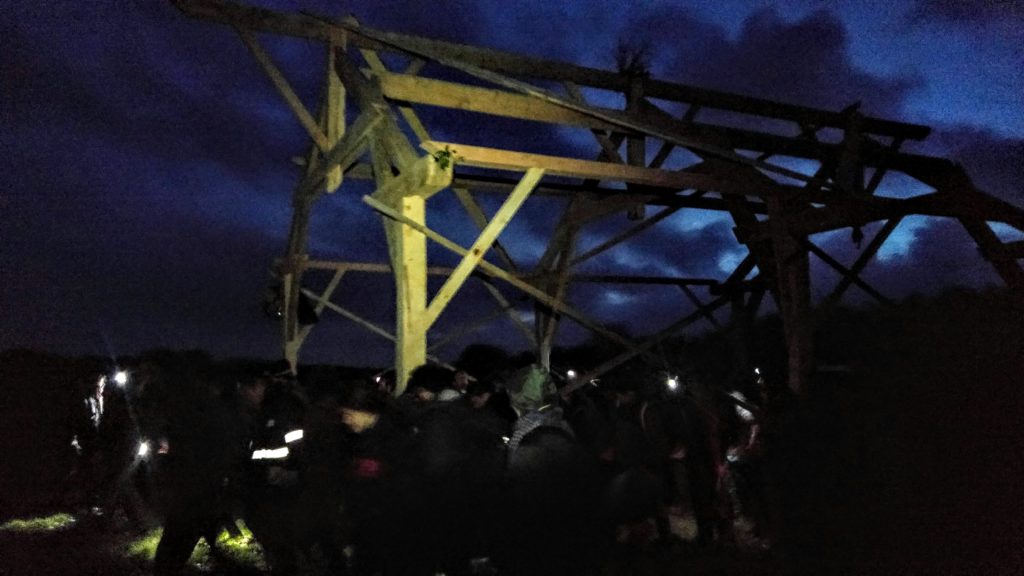
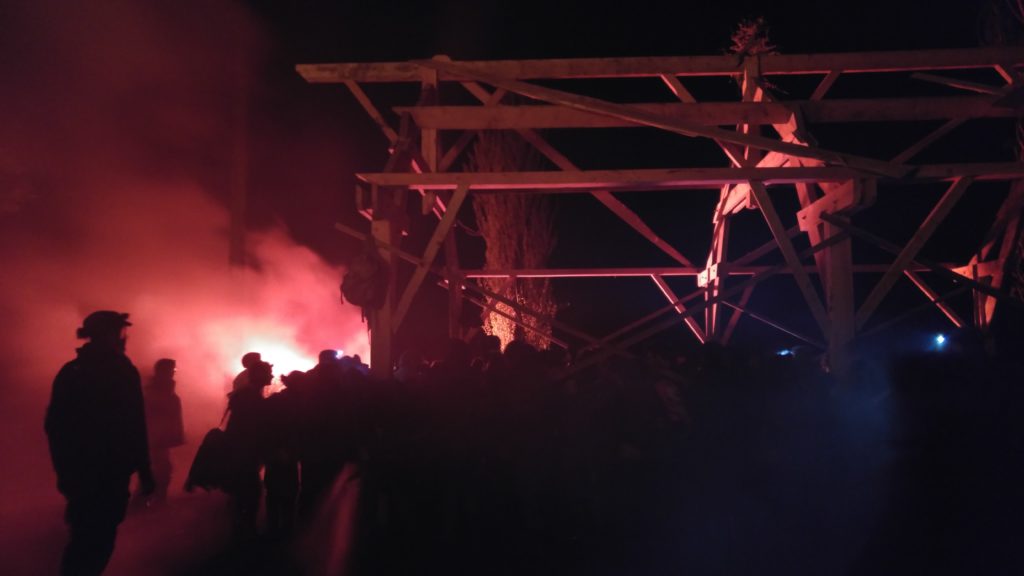
Despite the general state of tiredness that fills our bodies, we manage a huge heave, 150 of us lift up the structure. A mass of rubber booted feet walk in unison, it feels like a strange chimera shuffling across the bocage, half human half millipede. One of the carpenters directs the operation via megaphone, “a bit to the left ! slow down ! watch that tree branch !” Lit by the beams of dozens of head torches the building seems to float above the prairies, we are plunged into a space between fabulous dream and a scene from an epic film. Someone sits on the very top of the building pushing up the electricity and phone cables so we can pass under them. This is what we call the magic of the zad, the belief that anything is possible when we do it together.
We half expect to see the police helicopter, to feel its spot light pierce the night, but nothing. The closer we get to the Gourbi the louder the chants: “on est plus chaud, plus chaud, plus chaud que le lumbago” (we are much hotter, much hotter than lumbago). When we arrive, fireworks shoot up into the darkness, a bright red distress flare illuminates the scene. We set the building next to the pilled up ruins of the dome. We light a bonfire, Gourbi has risen again.
Whilst we were moving our house, Macron was being interviewed live on TV, sitting in a black and gold marble hall the Eiffel tower as monumental backdrop. He declares that airport had been abandoned as part of the “ecological priorities of the government” and that therefore our anger is no longer legitimate. Rather than an alternative society, the zad was “a project of chaos… illegally occupying public lands” he tells the nation.
“We have restored republican order” he declares, at least four times. We must sign individual forms before the 23rd of April or “everything that should be evicted will be evicted” he says. Macron ends with a ridiculous analogy: the zad is as if someone came into your living room to propose an alternative and squated your sofa. Ridiculous and wrong, none of the land here belongs to private individuals, it all still belongs to multinational airport builders Vinci and the state. But his statement was a new ultimatum, a declaration of total war against all collective forms of life. We return home to the news, but it cannot blunt the memories of this improbable night.
There are a half a dozen bodies perched like birds on the rafters of the new Gourbi, one plays a drum, a couple kiss, the green prairies below burst with yellow dandelions. We hear the rumble of APCs, it’s obvious they are coming straight here. The glint of riot visors shimmer in the sunlight, a column is moving towards us. A few flash bangs later and those on the roof are brought down by police climbers. The pillars of the building are cut by a chainsaw and the APC drives into it. Like the skeleton of a dying beast it crumbles to the ground. The police leave under a hail of stones, people sort out the broken beams. “Bastards !” a friend points to a stump of cut timber, “they sawed off the big fuck you finger and took it back to the barracks as a trophy !”
The Gendarmerie release their drone footage of the destruction on social networks. They need to show some success in their operation, they too are getting tired of this infernal cycle of destruction and reconstruction. A communication from a group called “Gendarmes and Citizens” denounces the fact that they are feeling “bogged down” and feel like “cannon fodder” faced with “rural guerrillas”. They deplore the “political paralysis” of the government who are on the one hand communicating with a “warlike tone” but are not following it up with effective orders on the ground. “Why are we not being given orders to arrest everyone in the squats ?” they complain. So far there have been suprisingly few arrests, we wonder if they will just come back later, raid our homes, pick us off one by one, when things are quieter ?
There is a new moon above tonight’s Assembly of Usages. Unsurprisingly the debates are heated, we have to decide to re start negotiations or not. The question has never been negotiate or fight, we always knew that we had to do both, but after so many days of attacks it’s not easy to accept to go back to the table. In the end we decide that we can meet the préfete, not to negotiate the base issues, but make demands for the continuation of talks, one of which is take the troops off the zone. “You don’t negotiate with a gun to your head”, one of the locals says, but we known that if we refuse to meet, Macron’s machine could return and destroy everything that is left, risking lives and in the end depriving us of this territory where we found each other.
An older friend of mine, someone who experienced the uprisings of ’68, writes to me. His letter just says, “the zad will never end, it will simply change shape.” And he is right. This attachment we have to this territory where we have been able shake our dependence to the economy and the state, is something that brings us together, however disparate our political perspectives. Our love for this huge play ground which inspires us to organise together, this deep desire for the wetlands that lubricates our imaginings, these are not abstractions but feelings that are deeply anchored to our experience of this bocage and all our experiments that emerge from it. It is a place that compels us to recompose, to renew, to have the courage to put our political ideas into question, to always push ourselves further than what we thought was possible, to open ourselves up beyond a radical ghetto or walled off utopia. Despite our barricades and the diversity of disobedience, if the state really wants to eradicate the whole of the zad, they can. Everyone would have lost their homes, workshops, fields, tools and we would probably find ourselves banned from returning to the region (a common judicial punishment in France). Scattered across the country without a place that enables us to grow roots together, we would loose all our strength. We know that changing shape is painful, but like a cameleon changes colours, we need to find a way protect this laboratory and camouflage its revolutionary potentialities from the eyes of the state. If we want to stay we need to find a compromise whilst refusing to let go our the commons.
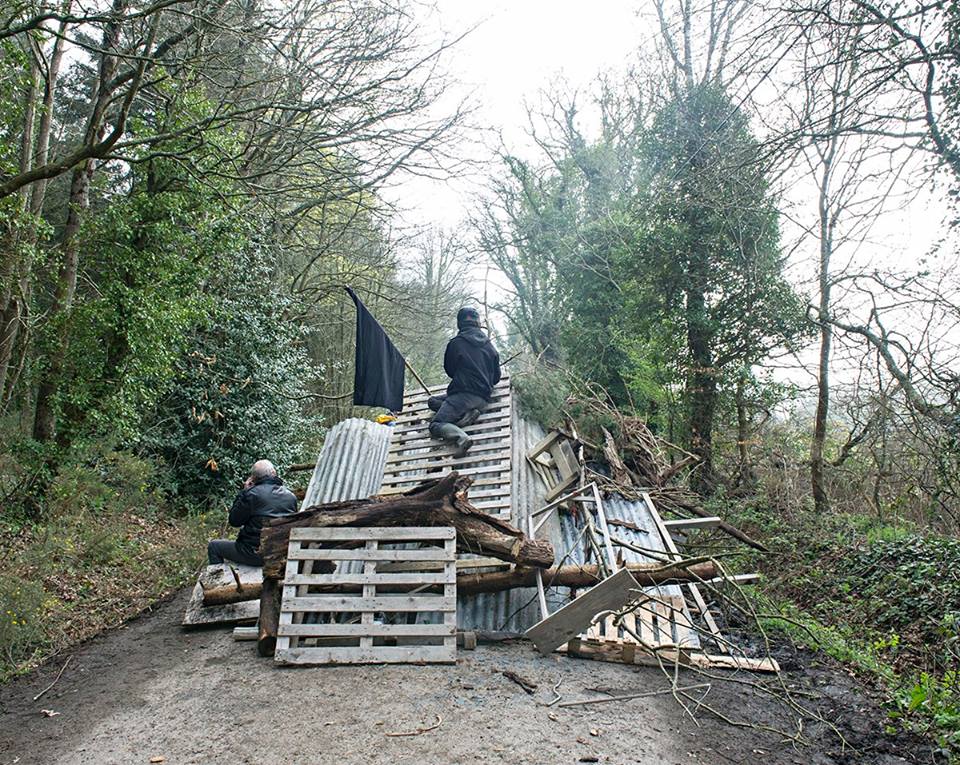
It’s a week later. Over breakfast, Paul tells me about last night’s adventures. “It felt like we were robbing a bank. So organised, dressed in black, head lamps, maps, scouts etc. Except all we were doing was evacuating the bee hives from the destroyed homes and gardens, getting them off site.” he smiles “we had to carry them full of bees across the hedgerows behind police lines.”
The days have calmed down. Less cops on the zone, more bird song than explosions. The cycle of barricade growing and then being smashed slows down, partly because on the main roads the police bring in huge skips to take the materials away. In the smaller lanes barricades remain.
The restart of the negotiations on Wednesday went badly, nothing shifted, despite the presence of ex TV personality Nicolas Hulot, now Minister of Ecological Transition, in charge of the zad case since Marcron’s election. He is flown in specially to Nantes in the presidential jet. Following the meeting with us, he gives a press conference in the palatial hall of the Prefecture. The government’s hard line is held, the rights of property and the market reign, there will be no global or collective contract for the land, we have to give individual names and land plots by the 23rd or face evictions. In a rhetorical floury he ends, “ecology is not anarchy.”
Not surprising for a man whose ‘ecology’ involves owning six cars, signing permits for oil exploration and supporting the nuclear dump at Bure. Hulot is simply the ‘eco’ mask for Macron’s “make the planet great again” form of authoritarian neoliberal green capitalism. But his statement shows Hulot’s absolute ignorance of the history of both ecological and anarchist thought. Many of the first theoreticians of ecological thinking, were anarchists. Élisée Reclus, world famous geographer and poet, whose beautiful idea that humans are simply “nature becoming aware of herself,” fought on the barricades of the 1871 Paris Commune. 19th century geographer Peter Kropotkin, spent many years in jail and exile for his politics, but was renowned in scientific circles as an early champion of the idea that evolution is not all a competitive war of “red tooth and claw” but instead involves a cooperation, what he termed Mutual Aid. From the 1950s onwards, US political philosopher Murray Bookchin (now best known for the influence he has on the Kurds to build a stateless form of Municipal Confederalism, taking place in the autonomous territory of Rojova – Northern Syria) brought ecology and anarchy together.
At the heart of his Social Ecology is the idea that humans dominate and destroy nature because we dominate ourselves. To avert ecological collapse we had to get rid of all hierarchies – man over woman, old over young, white over black, rich over poor. According to Bookchin, our greatest lesson to gain from the natural world was that we had let go of the idea of difference, and reclaim the concept held by many small scale organic societies, of unity in diversity. Diversity being the basic force of all bio-systems. He envisioned a world that would be neither communist nor capitalist, but what he called “Communalist”. “The effort to restore the ecological principle of unity in diversity,” he wrote, “has become a social effort in its own right – a revolutionary effort that must rearrange sensibility in order to rearrange the real world.” For him the question of society, to reframe Rosa Luxembourg’s: “Socialism or barbarism” – was: “Anarchism or extinction.”
When we truly inhabit an eco system it becomes obvious that life has no control centre, no heirachy, no chiefs or bosses, no governments or presidents. Every form of life is a self organising form of commons – deeply connected and interdependent, always changing, always embedded and entangled – from the cells in your fingers to worms in your the garden, from the trees in the forest of Rohanne to the bacteria in your gut. As biologist and cultural theorist Andreas Weber says, all life forms “are continuously mediating relationships among each other – relationships that have a material side, but also always embody meaning, a sense of living and the notion of belonging to a place.” The more we observe the living world in all its complexity the more we are able to understand how to become commoners, how to truly inhabit a place and see that the separation between the individual and the whole is a fiction.
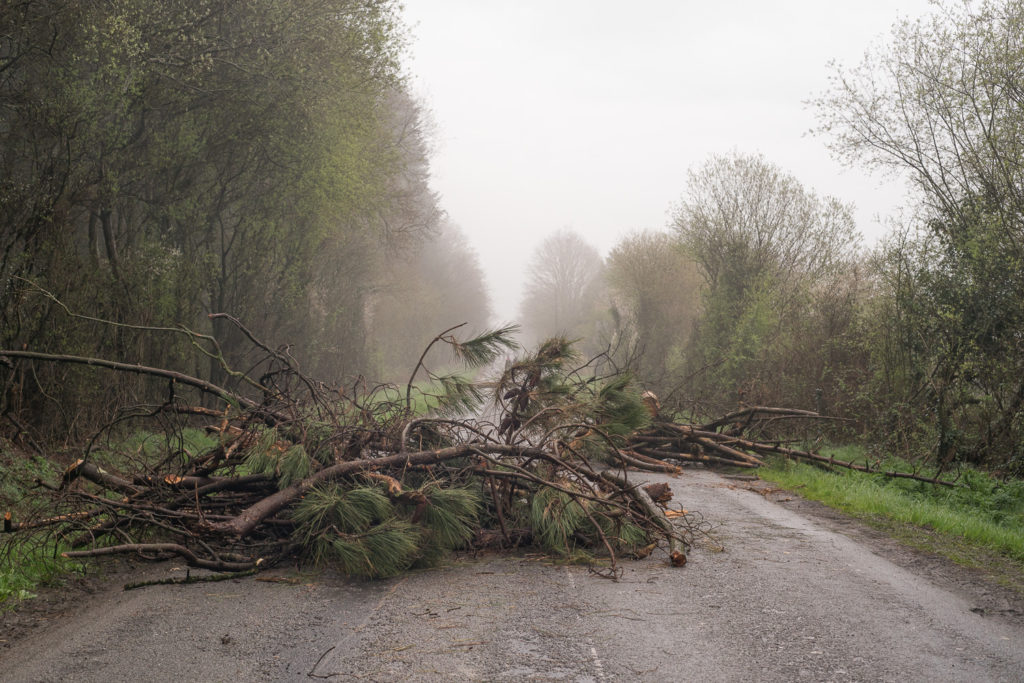
“In the ecological commons” writes Weber “a multitude of different individuals and diverse species stand in various relationships to one another – competition and cooperation, partnership and predatory hostility, productivity and destruction. All those relations, however, follow one higher principle: Only behaviour that allows for the productivity of the whole ecosystem over the long term and that does not interrupt its capacities of self-production, will survive and expand. The individual is able to realise itself only if the whole can realise itself. Ecological freedom obeys this basic necessity.”
And so to be really free is not to be an individual able to operate free from constraints, but to be tied to beneficial relationships with people and habitats, relationships that feed you materially and psychologically. Without a tie to your food – you starve, without the tie to lovers – you sadden. We are free because we are linked. Freedom is not breaking our chains but turning them into living roots and veins that connect, share, flow together and enable us to change and evolve in common.
Since the abandonment of the Airport, changing together on the zad has been a very a painful process. On the zad often it is a fight between those of us who try to read the terrain and invent something new that is messy and hybrid yet fits the situation we are in and those of us who want to keep a pure radical position, more based on uprooted ideas and ideology than the complexity of the present moment, the here and now, the forces we hold and don’t. In 1968 Bookchin asked“When will we begin to learn from what is being born instead of what is dying?” It is a question still just as relevant today on the zad.
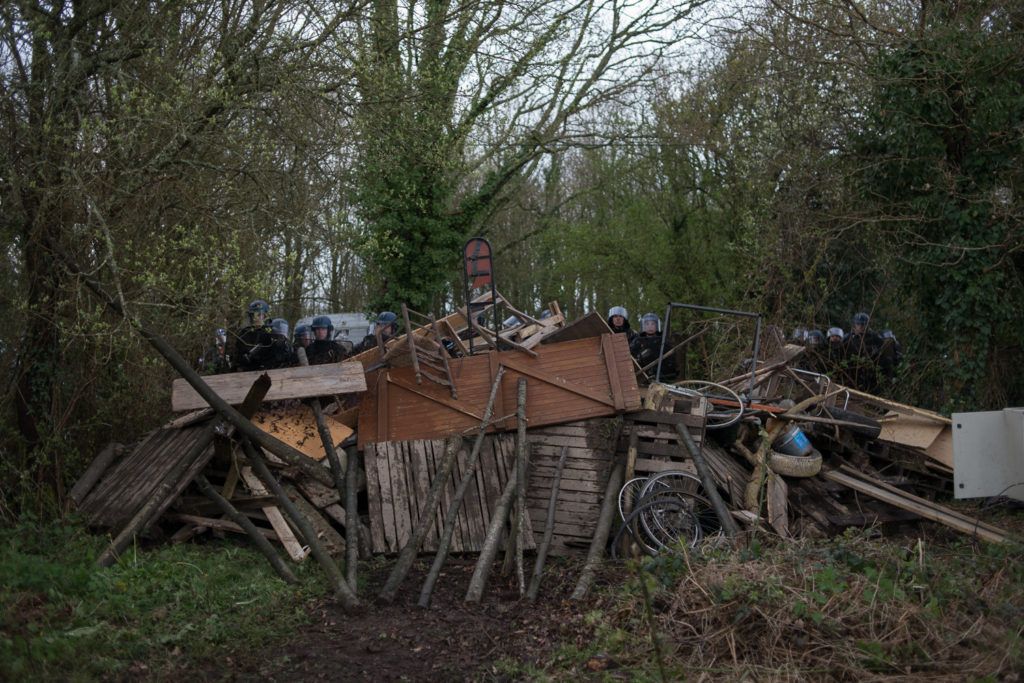
Things have been moving so fast. After Hulot’s ultimatum, a ministerial announcement suggests that the Prime minster and minister of interior are on a war footing, they are prepared to go for it, evict the whole zone on Monday’s deadline, the 23rd.
During the re start of negotiations on Wednesday a technical meeting between our delegation and the bureaucrats, who look at the case from a purely land and agriculture question, had been set for two days later, Friday 20th . Once again we are on a knife edge, this could be the last moment of negotiation before a full scale attack, an attack that most of us who live on the zone know we can’t win against, how ever big our barricades.
The Assembly of Usages makes a huge strategic gamble, its a paradigm shift in tactics. We decide to hand in the forms at the Friday meeting, but in a modified way, to show that yes we can fit the state’s square boxes of individual projects if they want, but that on the bocage nothing can be separated out, everything is interdependent. Whilst at the same time making a call out for people to come and be ready to defend on the territory from Monday onwards if the state attack. Its the logic of hacking, take what’s there, re purpose it, change its use.
Then one of the most unexpected types of zad magic takes place, an office of form filing is set up in the Zad’s library, and for 24 hours the building becomes a disturbed ants nest, dozens and dozens of people are running around carrying white pages of paper, writing on computers, having meetings together, looking at maps of the zone, making phone calls. Comrades with great legal and administrative knowledge help out and and by Friday afternoon, just as the meeting at the Prefecture begins a huge black bound file of 40 different projects is produced, each with a name and plots of lands earmarked, but no single name attached to a single plot. A colourful cartography of the commons of the zad is attached to further illustrate the interdependent and cooperative nature of the projects, be they a school of shepherding or the library, orchards or the sports group, mechanics garage or a snail farm, sunflower oil production or bringing up children together. Of the 70 living spaces on the zone, 63 are covered by the forms, only 7 decide not to take this bet of a barricade of paper. Of course paper barricades are not half as fun as ones on the streets, but this time they just might be the ones that save zad from becoming just another orgasm of history, another free commune which shined briefly but ended in bloodshed, another martyred experiment in freedom sacrificed for the sake of a pure revolution. The zad always tried to go beyond the idea of a TAZ (Temporary Autonomous Zone), in favour of a building a PAP ( Permanent Autonmous Zone), this desire is embeded in the solid buildings, the long term agricultural plans, the vineyards planted for win in 5 years time. We can’ just let go of all the ties we built here, with the locals, surrounding farmers, pensioners, workers in the city, wanderers of all sorts, Nantes students and the youth, the owls, the black squirming salamanders, the knarly oaks trees, the mud. We must hold onto all these deep friendships and networks of struggle that we have shared with such intensity over the last decade.
The state bureaucrats were confused, some enchanted, the préfete seemed relieved. Leaving the meeting our delegation tells the press that “we have responded to the injunctions of the state because we want to stop the escalation of tension and at last find the time for dialogue and construction,” warning that “ if we take away one element of the collective, it cannot work. It’s up to the state now to negotiate.”
As I finally finish this text, the helicopter returns, anxiety rises again in my chest. It spends a long time swooping over the zone, observing this rebel bocage that it wants to reclaim back. Perhaps it is preparing for a final revenge against the commons, who knows, all we know is that during this last fortnight we have fought with every weapon we thought possible including the unexpected. Now we wait to see if the bet worked out…
P.S
On the 26th of April three days after we posted this blog, the Prime Minister made a statement about the Zad: announcing a truce in evictions until at least the 14th of May, to allow time for the regularisation of the occupants who filed forms. According to the Minister of the Interior, “Everything moves calmly and in serenity, as always,” that hasn’t stopped them piling in with the tear gas this morning to clear barricades. The bet seems to have given us some breathing space, even though they remain with the logic of sorting the ‘good’ who have chosen the ‘right path’ and the bad ‘illegals’, something we continue to reject.
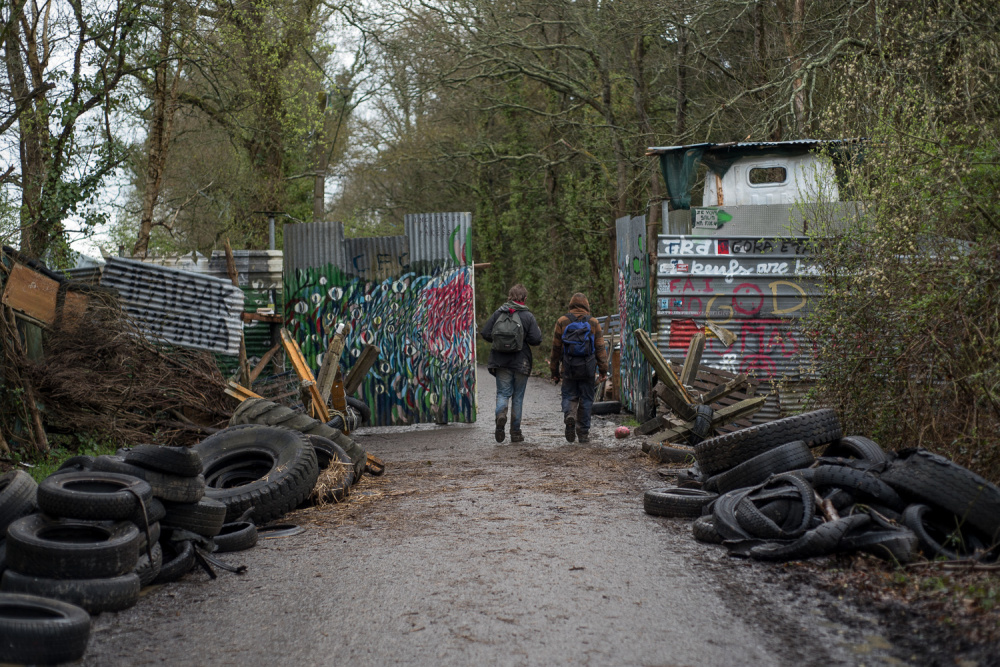
A recent report on digital attitudes shows that while 50% of people in the UK say that the Internet has a positive impact on their lives, only 12% believe it has a positive impact on society.[1] Mark Zuckerberg’s recent failure to give a straight answer to questions about misuse of Facebook’s user data, illustrates a major problem.
Much has been made of the democratising effect of social media platforms. However, while more of us are encouraged to “have our say”, we have less influence over the important decisions that most affect our lives, our localities, and the ways in which our societies are organised. The owners of digital platforms from Facebook to Uber, answer to shareholders in private, rather than to citizens in public. It should therefore not surprise us when they manipulate, monetize and exploit users’ interactions, attitudes and behaviours for their own commercial and political interests.
This problem of privately owned social space is not one that can be resolved by consumer and state regulation alone. It is a wider societal issue that further reinforces to us at Furtherfield, the immense value of park spaces in which neighbours come together each day, renegotiating in public, the spirit of the place through a diverse mingling of purposes.
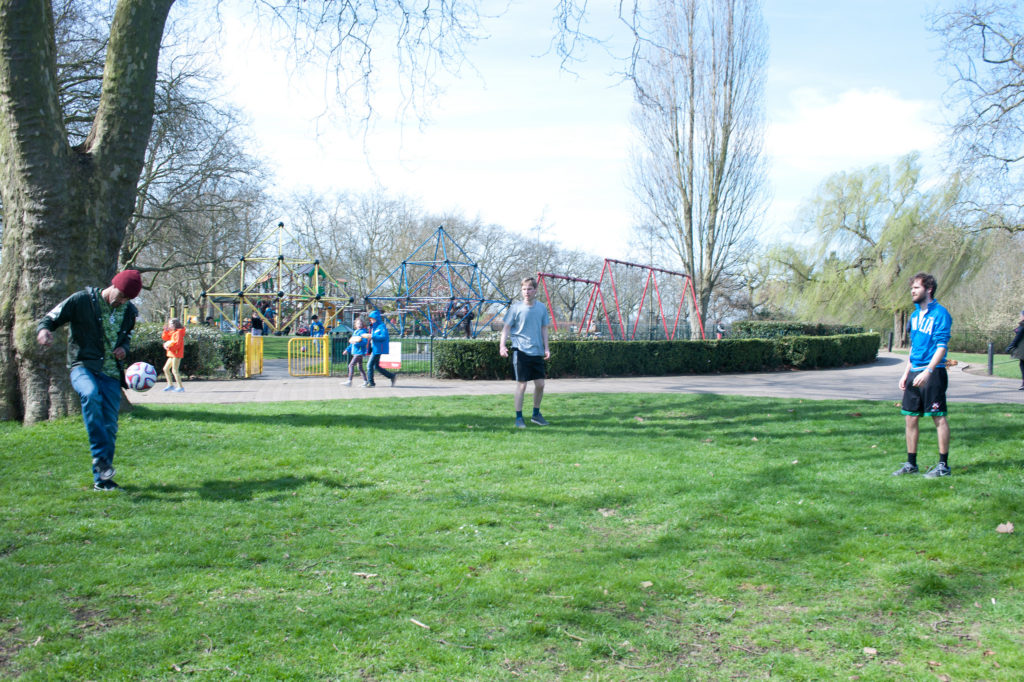
Over the last six years more than 50,000 people have encountered over 75 digital artworks that Furtherfield has brought to the park, working with international artists who reveal the invisible forces at play in machine and digital infrastructures. This summer Furtherfield extends its programmes beyond the Gallery and Commons venues into public green space of the park as we announce the first exhibitions, workshops and labs as part of Platforming Finsbury Park.
We are inviting park users to collaborate with us to transform the park into a public platform for cultural adventures, social inventions and reflections; to work with artists, hackers and academics from all backgrounds to rethink the social impact of technology and its flows on public spaces; and to bring local needs to the forefront in the context of planetary-scale techno-social advancements.
Currently showing at Furtherfield Gallery in the heart of Finsbury Park is the exhibition Poetry for Animals, Machines and Aliens: the Art of Eduardo Kac which is free and open to the public every day through May. The exhibition includes Lagoogleglyph, the third in a series of images as part of a global, networked artwork that takes the form of a pixelated bunny painted (in this instance) onto a field in the park, to be enjoyed by people on the ground and seen from Google Earth. In his essay Andrew Prescott, curator of the exhibition and Professor of Digital Humanities at Glasgow University revisits historic antagonisms between culture and technology prompted by reflections on the invention and imagination at play in Kac’s digital poetry.
Meanwhile families are joining artist Michael Szpakowski to use the very same satellite infrastructure to create GPS bunny drawings in his workshop series Let’s Fill the Park With Rabbits!
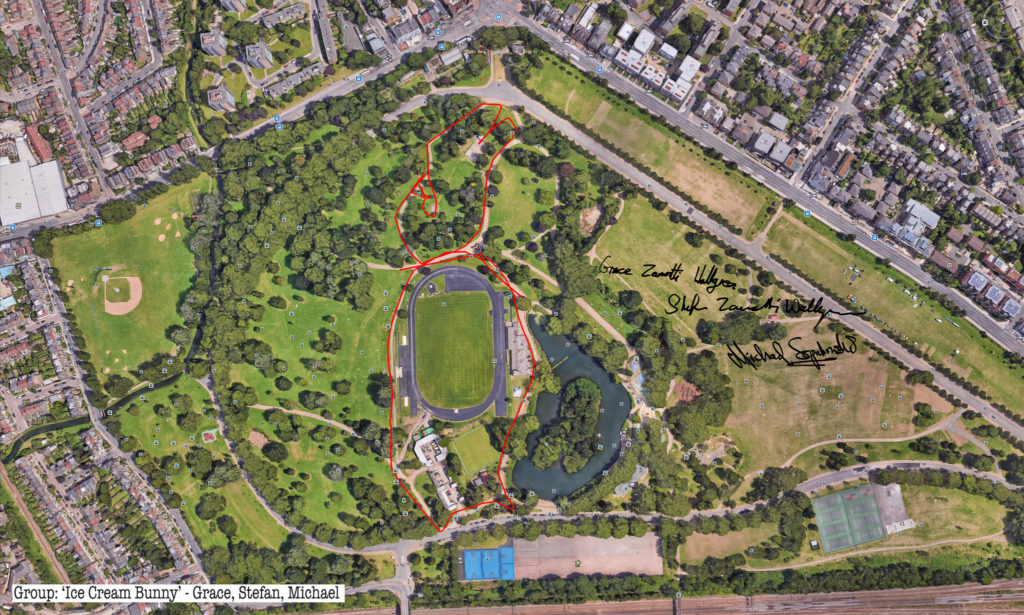
We hope that Platforming Finsbury Park will also start to flip some assumptions about who and what both art and technology are for. Over 180 languages are spoken in Finsbury Park. We want to make space for conversations and experiments with people from different backgrounds. Alongside the exhibition Andrew Prescott is also leading a series of public workshops on the theme of Digital Transformations promoting dialogue between and across diverse cultures.
In late May, we host Playbour – Work, Pleasure, Survival, a 3 day lab for artists, scientists and technologists dedicated to “the worker in an age of data and neurotechnologies”. From these will flow art commissions and collaborations towards our next exhibition in July.
Here you can read an interview with designer Ling Tan about the SUPERPOWER wearable technology workshops at Furtherfield Commons last summer in Finsbury Park. Ling tells us about how a group of young women from All Change Arts worked with her to devise activities and to learn about creating and interpreting data to themselves shape attitudes and behaviours. Dani Admis, curator of Playbour, continues this work later in the summer, exploring with local young women how they might effect change on their own terms, using the conceptual power tools of neuroscience.
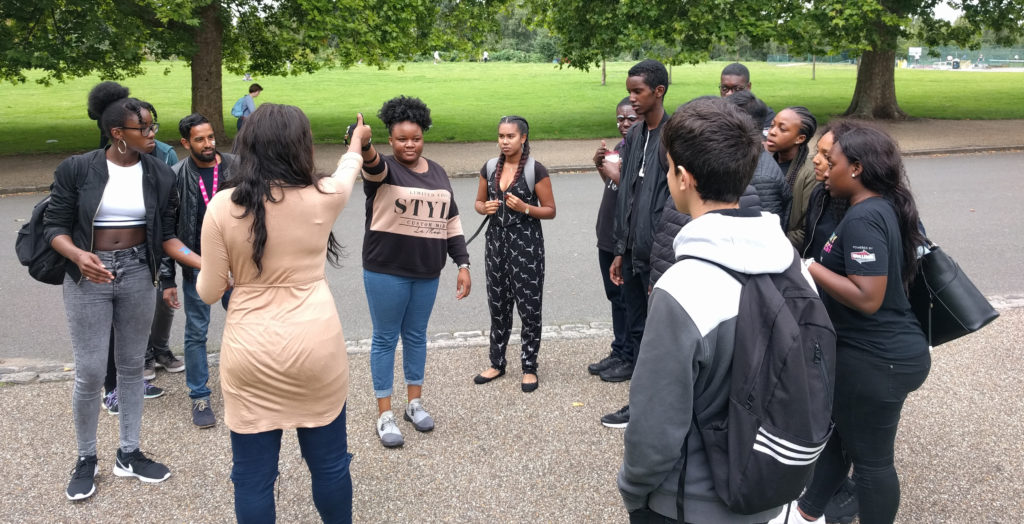
Finally a provocation to Furtherfield from Simon Poulter, artist, technologist and producer of NetPark, the digital art park at Metal in Southend, who is working in partnership with us. He celebrates our commitment to the commons “as a real thing, worth our energy and stewardship, the point at which people do touch each other and listen.” He also issues a call to action…“It is time to invent another future, lest we will become the disrupted and not the disruptors.”
As Manuel Castells famously put it ‘The flows of power generate the power of flows, whose material reality imposes itself as a natural phenomenon that cannot be controlled or predicted… People live in places, power rules through flows’. [2] And in network society these flows often have the power to wash clean away communities’ ties, extracting value and flowing it to the private interests of absent and distant persons and bodies.
So our future mission grounds us in Finsbury Park, while maintaining our global reach. We are passionate and committed to multiple points of entry, bringing in consenting and diverging voices, to channel and circulate flows locally to generate the power to enact this public place together with verve.
Much of our cultural history of the past two hundred years has been defined by anxieties about the growth of a technological and commercial society. In the nineteenth century, Samuel Taylor Coleridge bewailed ‘the philosophy of mechanism which, in everything that is most worthy of the human intellect, strikes Death’, while Matthew Arnold declared that ‘Faith in machinery is our besetting danger’. For such commentators, culture represented a means of staving off the threat of an industrial society ruled by money and commercialism.
It is easy to fall into a false binary of opposition between art and technology. When pioneering artists and scholars first demonstrated the potential for using computers in arts and humanities research in the period after the Second World War, their work often provoked antipathy because of this anxiety to maintain a distance between art and the machine. In my inaugural lecture at King’s College London in 2012, An Electric Current of the Imagination, I argued that artistic practice offers a particularly effective means of fostering a creative and critical relationship between art and technology. I declared that ‘Such a new conjunction of scientist, curator, humanist, and artist is what the digital humanities must strive to achieve. It is the only way of ensuring that we do not lose our souls in a world of data’.
Since 2012, I have held an AHRC fellowship as Theme Leader Fellow for its strategic theme of ‘Digital Transformations’. One important outcome of this theme has been further exploration of the way in which artistic practice offers innovative perspective on our relationship with technology. Artistic experiments with a range of text technologies from the typewriter to the computer provide exciting insights into the materiality of the text and the way in which text interacts with our senses as readers and writers.
One event held under the auspices of my fellowship which seemed to me to encapsulate these possibilities was an exhibition, Design and the Concrete Poem, curated by Bronac Ferran at the Lighthouse Gallery in Glasgow from 28 September – 6 October 2016. This exhibition introduced me to the work of many artists whose exploration of the materiality of text and poetry I found compelling.
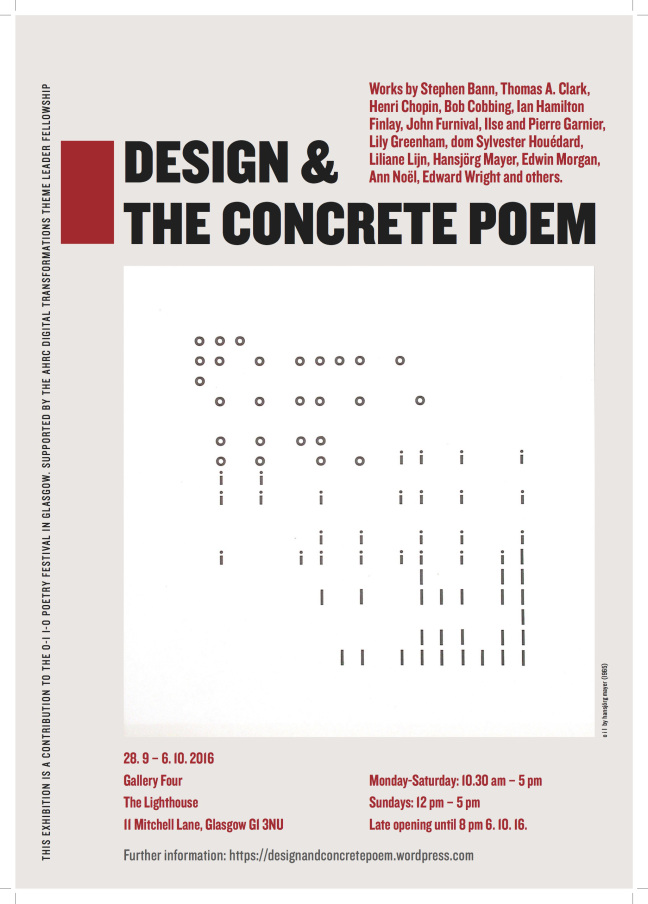
Design and the Concrete Poem introduced me to such reinventions of the text as dom Sylvester Houédard’s experimentation with typewriters or Liliane Lijn’s use of letraset on metal drums to create Poem Machines. The way in which Lijn’s exploration of Dickensian engineering workshops in London in the late 1960s inspired her Material Alphabet (1970), and her fascination with industrial processes and images, epitomises the way in which artistic practice can generate creative conjunctions with technology. Pierre and Ilse Garnier’s poem cut on a Gestetner duplicating stencil, shown for the first time in the Glasgow exhibition, offered both a novel view of textual materiality and an elegy for an obsolete technology.
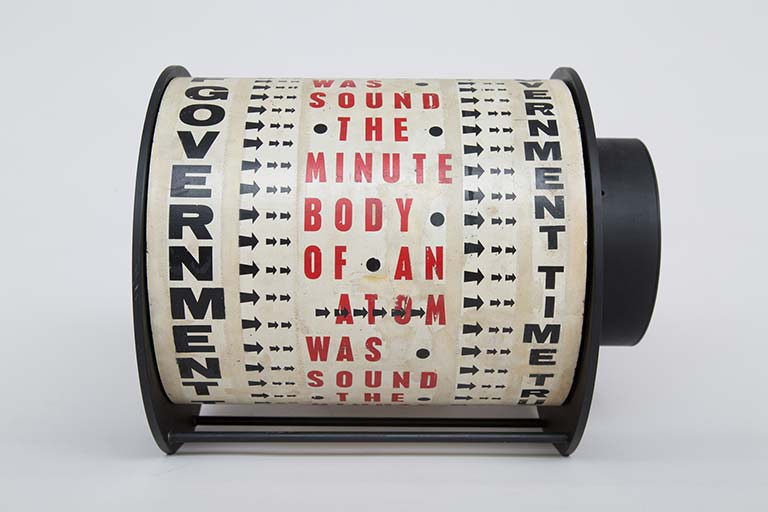
One artist whose work I have found consistently helpful in thinking about the interaction between technology, communication and our human condition is the Chicago-based Eduardo Kac (b. 1961), and I am delighted to have helped arrange at Furtherfield his first UK show, Poetry for Animals, Machines and Aliens.
Poetry is challenging. A poem questions our certainties, makes us see the world from different angles and, by encouraging us to pause and reflect, subverts that mechanistic goal-oriented outlook which so horrified Coleridge and Arnold but nevertheless dominates the modern world. Technology can give words and letters new shapes and resonances and, in so doing, subvert a consumer-oriented view of technology.
There can be no more imposing expression of technological achievement than the International Space Station. One of the most fascinating aspects of the video of Eduardo Kac’s space poem Inner Telescope, performed in 2016 by the French astronaut Thomas Pesquet, shown in the Furtherfield exhibition, are the interior shots of the cramped space station, jam-packed with wires, containers and panels from innumerable scientific experiments. The confined space station contrasts with the expansive views of the earth visible through the space station windows. This contrast itself seems like a commentary on the puny character of human technological ambitions.
Kac proposed the idea of space poetry in 2007. He pointed out that weightlessness would affect the temporal and physical logic of a poem, while the readers’ sensory engagement with the act of reading would also be different under zero gravity. Inner Telescope vividly illustrates how a simple performance such as cutting paper may be different in zero gravity, while the movement of the paper (cut into a form representing the word ‘Moi’) seems to epitomise the fragility of textual communication. In the rigidly scheduled life of the space station, Inner Telescope uses poetry to pause and reflect on the complex interrelationship of humanity, technology and the wider universe.
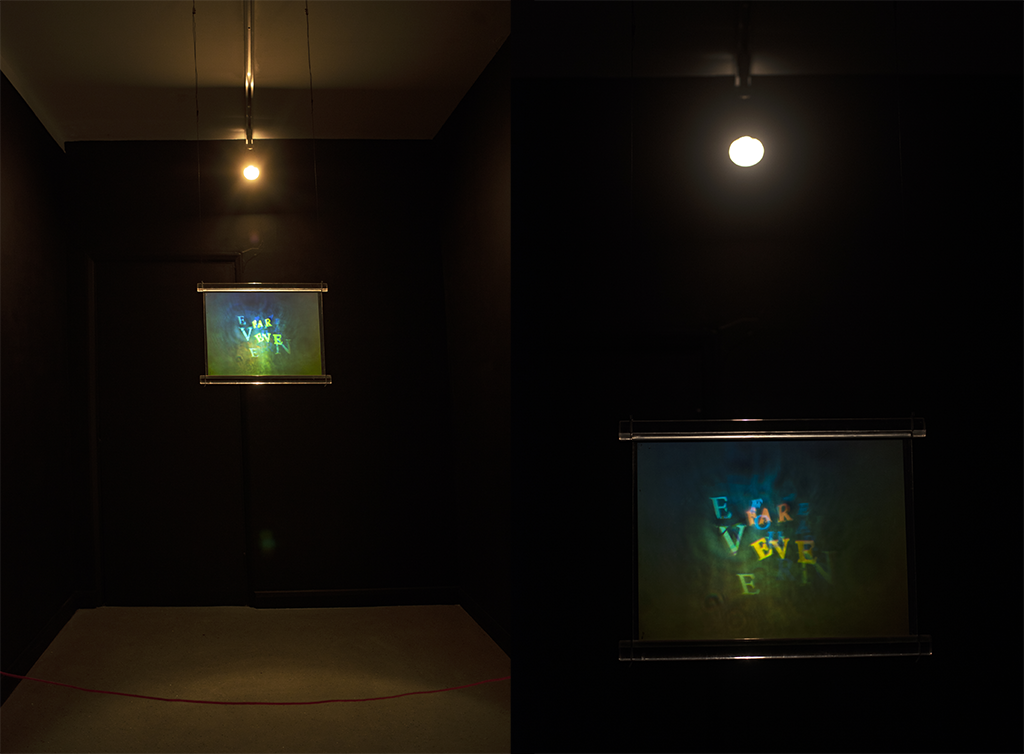
One major thread of Kac’s art has been the relentless interrogation of technology to create radical and original poetic visions. Kac experimented with the potential of the typewriter to allow different juxtapositions and textual shapes in his Typewritings of 1981-2 and from these experiments sprang his first digital poem, Não! (No!) , in 1982-4. Não! was presented on an electronic signboard with an LED display with fragmentary text blocks, encouraging the reader to guess at the links between them.
The digital poems shown in the Furtherfield exhibition illustrate how Kac makes use of digital technologies to redefine the relationship between the reader and text and to reveal new poetic elements in short words and phrases. In Accident (1994), a digital loop introduces shifts and uncertainties into a text, recalling the nervous hesitation when two lovers meet, but also causing the reader’s perception of the text to change as the piece progresses.
Another remarkable pioneering digital poem on display at Furtherfield, Letter (1996), uses virtual reality markup language to create a three-dimensional spiral of text which the reader can spin, invert, twist and explore from every conceivable angle. The text appears to be a single letter, but turns out to be two letters, one from the artist to his dead grandmother and another to his newly born daughter.
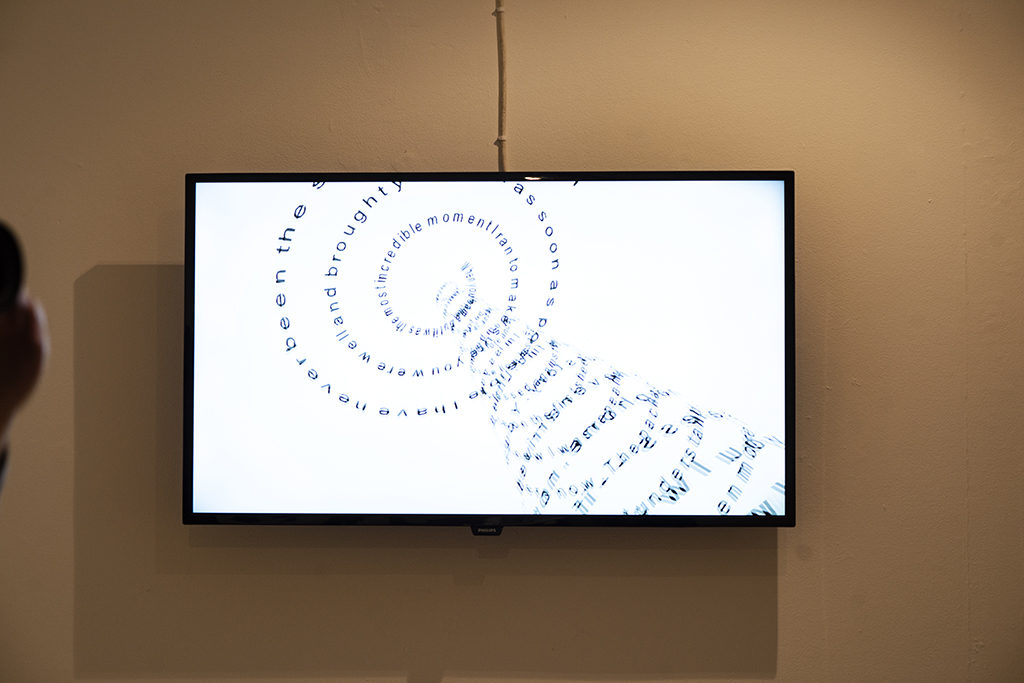
Text and language are perhaps the two technologies which most profoundly shape our lives. By altering our perception and engagement with text, Kac raises questions about the way in which we communicate and understand each other. In his beautiful holopoems, one of which is on display in the Furtherfield exhibition, Kac creates texts which shift and change depending on the angle at which they are viewed. Text technologies frequently give the impression of immutability, but Kac’s holopoems remind us how unstable and deceptive texts may be.
The full range of Kac’s technological exploration is impossible to encompass in a single exhibition, but some sense of it is evident from his website (www.ekac.org). Particularly fascinating is the way in which Kac has explored the poetic possibilities of technologies which are now redundant. Although the platform on which the work was realised is now obsolete, the work nevertheless anticipates contemporary digital cultures. Thus, Kac used the French videotext network Minitel to show the possibilities of network art. He demonstrated the potential of large-scale collaborative works by various pieces using fax. Kac was already experimenting with the potential of telepresence, robotics and wearables in the 1990s.
At each point in these explorations, Kac urges us to engage with these technologies creatively, to use them to create fresh visions, and not simply to accept them as consumers. As a historian, I have long felt that humanities scholars too often passively accept the technological resources and tools made available to them by commercial companies and others. One of the reasons why I believe passionately that humanities scholars should engage more closely with artistic practice is that such a dialogue will foster a more creative and critical approach to the use of digital methods by humanities scholars. The artists whose work I have encountered in the course of my AHRC Fellowship, such as Fabio Lattanzi Antinori, Michael Takeo Magruder, and Katriona Beales as well as pioneers such as Nam June Paik all convey the message that we need to engage creatively with technology. Technology is a threat if we view it passively as an inhuman external force; if we rather seek, like Kac and these other artists, to interrogate, extend and reimagine technology in a creative way we can hope to take greater ownership of it.
This is most spectacularly illustrated in Kac’s bio-art. It is now becoming evident that new biotechnologies will within a short period of time profoundly alter human existence and personality. Kac’s bio-art (following in a tradition which includes the creation of germ pictures by Sir Alexander Fleming) again encourages us to engage creatively with these emerging technologies.
DNA is text and DNA can be poetry of the most profound sort. In a series of works called Genesis (2001), a synthetic gene was created by Kac by translating a sentence from the biblical book of Genesis into Morse Code, and converting the Morse Code into DNA base pairs according to a conversion principle developed by the artist. The sentence chosen was Genesis 1:26: ‘Let man have dominion over the fish of the sea, and over the fowl of the air, and over every living thing that moves upon the earth’.
Visitors to the gallery showing Genesis could trigger mutations in the bacteria’s DNA by switching an ultra-violet light on and off. This in turn mutated the text when it was converted back in morse code and then into English. The artist comments that ‘the ability to change the sentence is a symbolic gesture: it means that we do not accept its meaning in the form we inherited it, and that new meanings emerge as we seek to change it’.
Kac’s most well-known work is GFP Bunny (2000) in which an albino rabbit called Alba was bred in a laboratory with a gene causing the rabbit to glow fluorescent green under a blue light. Kac’s image of Alba has become very well-known and was perhaps one of the first iconic art images of the twenty-first century. We will be exploring the cultural phenomenon of Alba in another exhibition at the Horse Hospital called ‘…and the Bunny goes Pop’, opening on 2 June 2018.
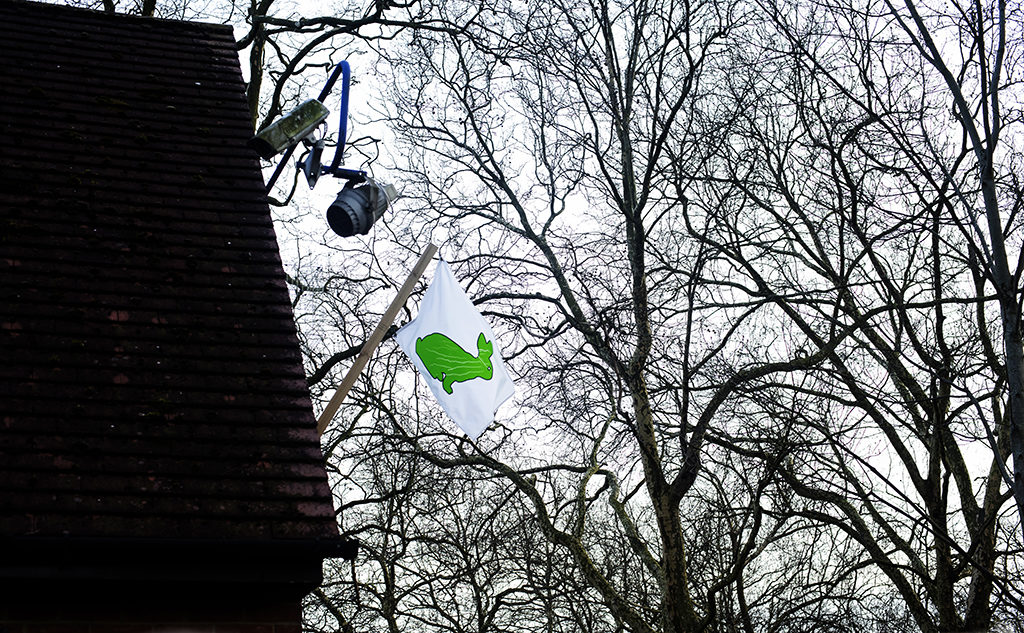
The distinctive image of Alba, shown on The Alba Flag (2001) hanging outside Furtherfield during the exhibition, is also a highly poetic image, conveying many messages about identity, the nature of life and belonging, and the increasing intersection of these with technology. Kac’s memories of Alba prompted him to create a wordless language system incorporating rabbit imagery which he called lagoglyphs (from the ancient Greek words ‘lagos’ for hare and ‘glyphe’ for carving).
Kac has now begun a series of Lagoogleglyphs, large lagoglyphs designed to be visible from the satellites which provide the imagery for Google Earth. Lagoogleglyph I (2009) was installed at Oi Futuro, Rio de Janeiro, Brazil and Lagoogleglyph II (2015) at Es Baluard Museum of Modern and Contemporary Art, Palma de Mallorca, Spain. Lagoogleglyph III has been installed in Finsbury Park.
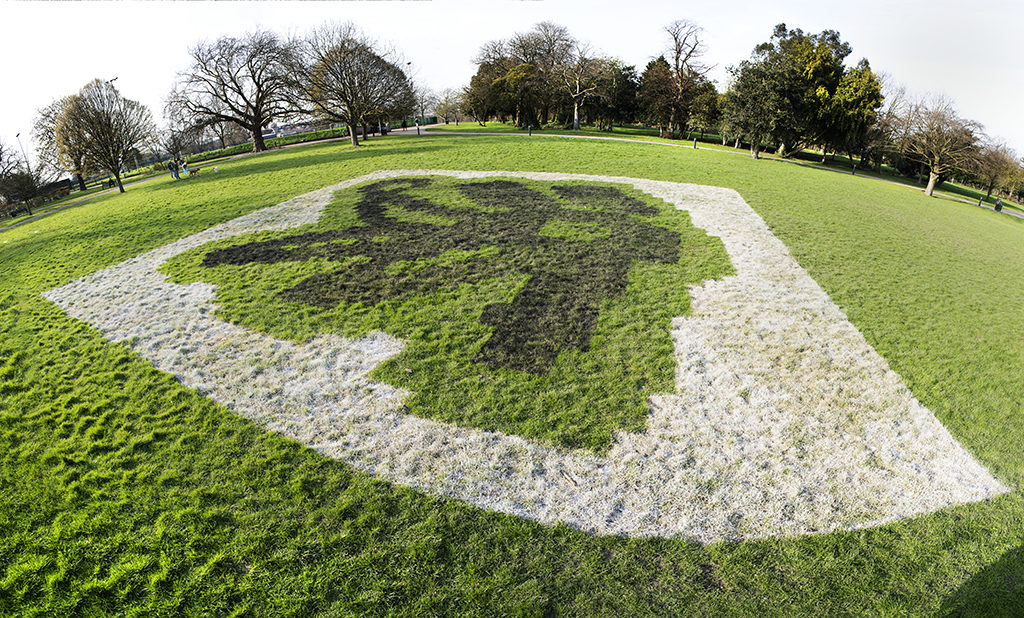
The Lagoogleglyphs encapsulate what is to me the central message of Kac’s work. Google is a vast all-encompassing technology giant which encourages us to consume its services while it makes money from data about us. The way in which Google Earth acts as a panopticon for the world, presenting an idealised sunny view of the planet’s surface, symbolises the hierarchical downward nature of much modern technology.
How can we seek to make our presence felt with the world of mass corporate technology? Painting a huge image in Finsbury Park is an inspired way of intervening in the artificial deracinated corporate view of the human world presented in Google Earth.
When the Arts and Humanities Research Council established its strategic theme of ‘Digital Transformations’ in 2011, the terminology echoed that used in many corporate contexts, and was redolent of improved business processes and data management. Eduardo Kac’s work reminds us that real digital transformations are achieved through creative interrogation of technology and through reimagining how we engage with that technology. Poems turn out to be true drivers of digital transformation.
Valuing people is a core property of wealth creation, wealth creation can be positively bound into communities. We can’t afford not to be involved in digital creativity because it explores areas of social space that are entwined with intrinsic cultural and economic value.
The point of entry has become ubiquitous, we are everywhere, they are everywhere – I am over there and here too. Marshall McLuhan, the Canadian media theorist gave us ‘emotional extension in electronic space’ [1]before we came up with the clumsy and often misunderstood paradigm of ‘post-digital’ – a way to describe a circularity and return to being human that accepts the intersubjectivity and convergence we feel with other people and technology.
It is this corporeal and algorithmic unification and association that Furtherfield grasps; sometimes like harsh high summer nettles on uncovered hands, gathered as ingredients for a convivial soup. Not afraid to be stung or to make the soup, even though after 22 years of foraging you are not now the only voice or flag raised at the intersections of art, technology and social change. The mission is always different and always the same. This then is my provocation to you.
The case for digital creativity has grown. Why is that? Because there is deep unrest and even malevolence in electronic spaces and at their corporeal nodes. “The creative adult is the child who has survived,” says Ursula K. Le Guin.
As creative people engaged in the field we are with agency and in turn create agency; we gladly pick up refurbished laptops, remixed maps and fragmented tweets. Our fieldwork means we are in the river, standing watching by the shore, and holding up a mirror in the lobby of the hotel. We facilitate others, not just ourselves, we do it with others. Artistic people are children and not confined or restrained by common sense orders from the immaterial elite – some are pointed, focused and ready to enter the field, others are yet to claim their agency, and even more have yet to experience due North and due South. We can provide the co-ordinates, the beginning of the map and the line of sight. Artists in the future will become agents of change and observers of truth in a familiar return to base. And so we are not given to the idea, in the field, of carrying out instrumental command and we caution ourselves against suggesting this to others.
In a hotel in Sweden we listened as the French Philosopher, Bernard Stiegler brought attention to our attention. In clipped and someway jarred English, he opened up the vast chasm and problem of attention as the fundamental commodity of our age (emotionally extended, post-digital etc). His references to ‘techne’ willfully conjured up derivations from Greek – craftsmanship, craft and art. We are crafting the digital to draw attention to ourselves and our products. We are becoming products, through a process of digital reification. Lukács describes reification ‘as a relation between people that has taken on the character of a thing’[2]. So, while humans and machines merge evermore, we understand that the end-point of creative processes is not to make attention-seeking people become products and things, it is to diversify our subjectivities and illuminate the way forward for all.
The agency of artists has been a key factor in the development of the Furtherfield’s mission in its first two decades. This agency broadly disseminates to artists networks, activism, societal change, environmentalism, localism, global affairs and more recently emerging technologies such as blockchains. Within an unfolding world political landscape, these areas of interest show greater convergence and potential as moments of reflection become more important in the reified world of products. Our role is to be that reflective space for 360 degree scanning and to hold digital time up in the chain.
Our future mission grounds us on our locus in order to do this, while maintaining our global reach. We are passionate and committed to multiple points of entry, bringing in consenting and diverging voices. The ‘commons’ to us is a real thing, worth our energy and stewardship the point at which people do touch each other and listen.
We know that technology will not save us and furthermore we propose that this is not the right question. In working in partnership with academics, businesses and other institutions we are always asking ourselves where progressive change can come from, in a series of open dialectical spaces. Finsbury Park offers us a node in which to conduct business and make new wealth – cultural, social and economic capital. The predication of wealth creation on technology alone is too simplistic when a multitude of tools are needed. Our approach to the idea of the ‘commons’ is to use old and new tools and ways of getting things done together..
As McLuhan says: “Once we have surrendered our senses and nervous systems to the private manipulation of those who would try to benefit from taking a lease on our eyes and ears and nerves, we don’t really have any rights left. Leasing our eyes and ears and nerves to commercial interests is like handing over the common speech to a private corporation, or like giving the earth’s atmosphere to a company as a monopoly.” (from Understanding Media, 1964.)
We are not isolated from the huge pressures of the global economy, when advancements outstrip the ethics and the algorithms that come to define new normative patterns and processes. The role of digital creativity and artists is now fully emerging as one that reconnects them and us back into the critical space that Goya, Galas and others occupied. So, we can hold up time and re-enter it at a different point. Yes, Furtherfield offers time travel!
The disruptive power of technology is evident in its ability to unhinge and even eliminate existing businesses, local centres and distribution methods. This is not new, just as McLuhan defined electronic extension in the 1960s, Clayton Christensen defined ‘Disruptive Innovation’ in his book The Innovator’s Dilemma in 1997. However, digitally disruptive business models such as Uber are now mainstreamed and fast-tracked into our everyday experiences. With the advance in real time data and algorithms these disruptions can have a dramatic effect in social and economic terms. We are faced with a shift in the language from the progressive and anti-establishment power of Punk and music culture; into the realms of digitally distributed start-ups, iterative technologies and remix culture.
It is time to invent another future, lest we will become the disrupted and not the disruptors.
Image credit: Museum of Contemporary Commodities by Paula Crutchlow at Furtherfield 2016
Ryan Bishop, Kristoffer Gansing, Jussi Parikka & Elvia Wilk (eds.) across and beyond: A transmediale Reader on Post-digital Practices, Concepts, and Institutions, Sternberg Press, 2017, pp.352, €15.00 (paperback), ISBN 978-3-95679-289-2
Although the notion of the “post-digital” has gained some prominence in media art and theory, the uptake of the term in the humanities and social sciences has so far been more muted: whilst the field of “post-digital” art scholarship is by no means new (see Berry & Dieter, 2015), the term itself is often used quite sparsely and ambiguously such that it risks becoming a vague referent for almost any form of human and nonhuman entanglement with media. This rich collection of 25 essays and artwork contributions, many from world-renowned artists and media theorists, seeks to remedy this by developing the notion of the “post-digital” as something that gains specific expression through certain kinds of critical practice. As the editors note in the introduction, across & beyond does so by focussing on the “post-digital conditions for critical media practices…for understanding and working in the transversal territories between theory, technology, and art” (p.5). Organised around a series of contributions presented in recent years by participants of the annual transmediale festival in Berlin, the transversal explorations in this reader are critical insofar as they aim to engage with the “material complexities of digital culture” beyond what the editors describe as the “phantasm” of the supposed “immaterial reality” of digital media (p.16).
To be clear, across & beyond is not strictly a theory book but a gathering of diverse academic and artistic contributions that variously approach questions concerning the “post-digital”. Some of the stakes of “post-digital” media theory are set out in this reader, and will be noted in this review, but it should be said that this is not merely a theoretical intervention into technological media.
The “post-digital” describes a set of “speculative strategies and poetics” (p.13) that act as a “heuristic to understand the historical and material contexts of media art and culture” (p.12). In this sense the “post-” of “post-digital” does not designate a temporal period after a bygone ‘Digital Age’, but instead describes an opening up of a whole “field for material but also imaginary, alternative practices” (p.13) that concern the different temporalities and spaces produced through and with media. The post-digital, then, is presented here as a field of study into the material and imaginary practices of media, which aims to offer “new means of critically linking technology, culture and nature” (p.15).
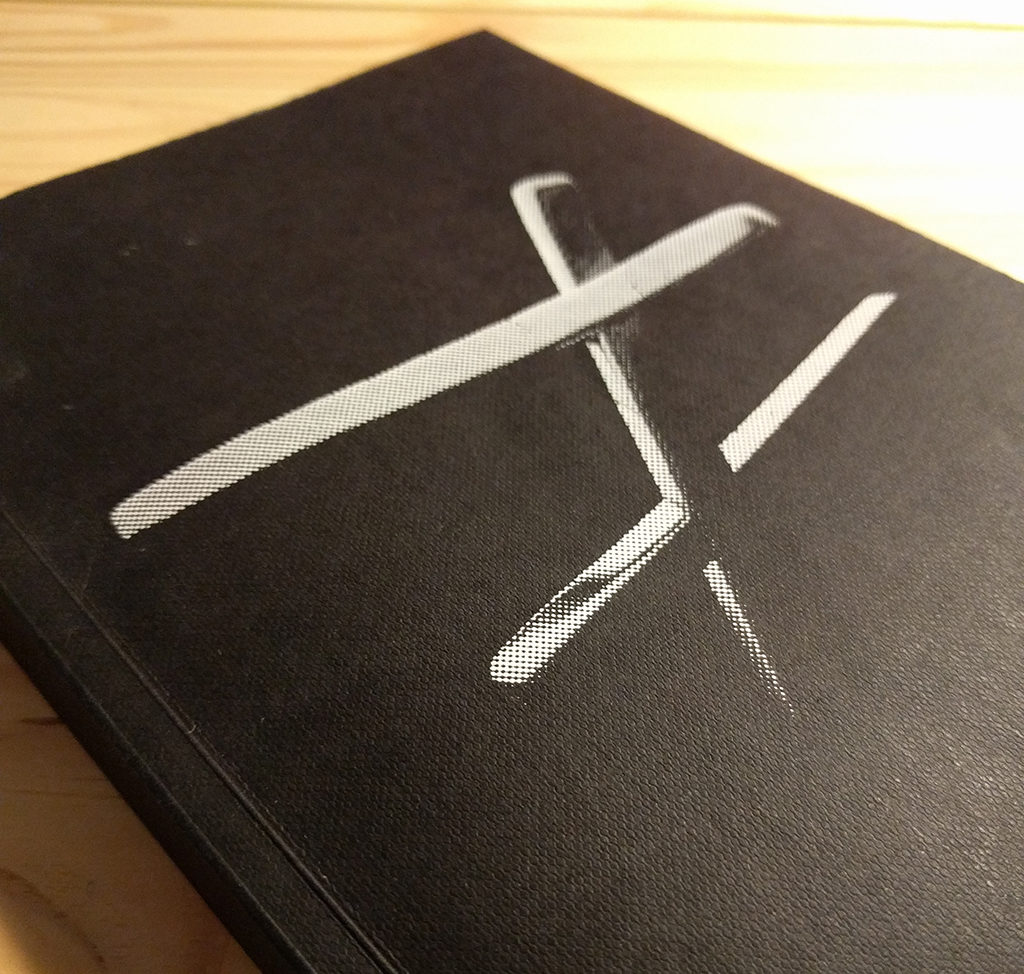
To thematise some of these traversal territories for thinking about the post-digital conditions of media, the essays and artworks in this reader are split into three themed subsections: “Imaginaries,” “Interventions,” and “Ecologies.” Rather than organising this review by treating each individual chapter, I will instead briefly suggest how certain chapters develop each of these three themes, and end by reflecting on how these themes intervene in the political stakes of social scientific engagements with digital media more widely.
At least in part, the first subsection – “Imaginaries” – develops a number of responses to the idea that the post-digital would be a field of study that rethinks the relationship between technological culture and time (see especially chapters by Gansing; Ludoivo; Daniels; Parikka; Menkman). In the opening chapter, Kristoffer Gansing develops the ‘problem of time’ for post-digital approaches to media by analysing the CD-ROM as a noteworthy “offline art form” (p.41). Rather than thinking about the CD-ROM as a redundant media of a bygone era, Gansing instead highlights the way that the “offline experience” (p.36) of the CD-ROM counters certain contemporary structures of digital surveillance. This intervention is post-digital, perhaps, insofar as the CD-ROM is seen to present specific opportunities for disrupting both processes of online surveillance, but also the reductive tendency to rush towards new, à la mode forms of digital media.
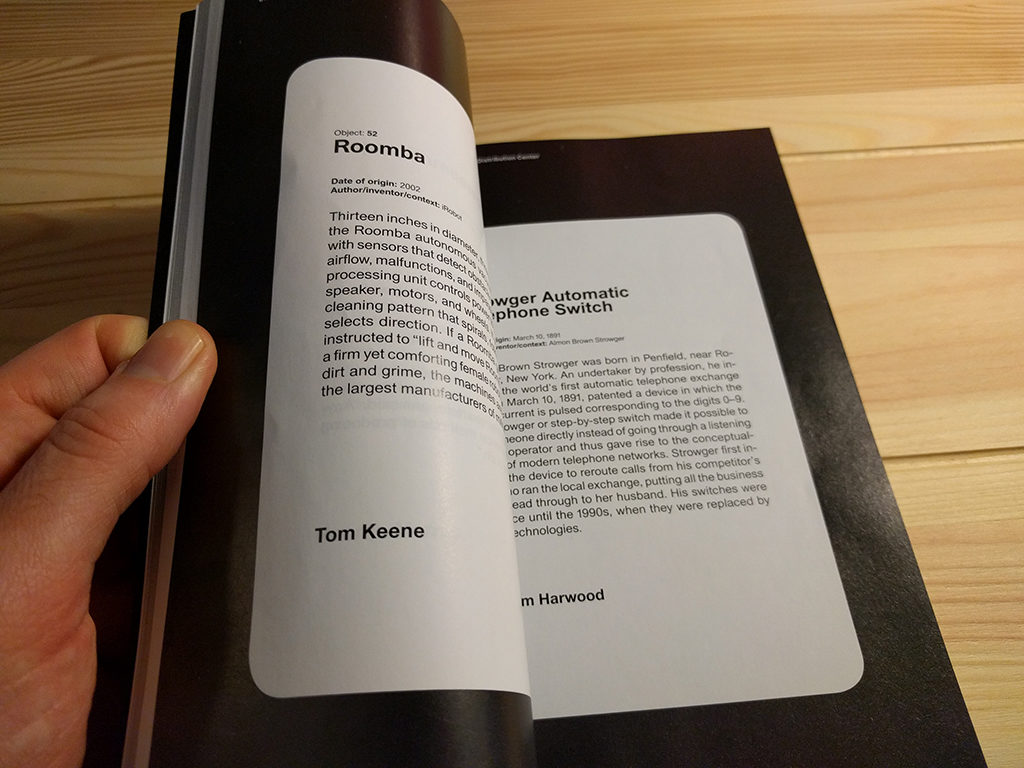
Likewise, Jussi Parikka’s chapter focuses on the question of time in the context of laboratory media and draws attention to the way that certain “time-critical technical media” (p.86) produce “micro-temporalities” that are irreducible to human perception (p.86). In producing a series of situated micro-temporalities, these laboratory media contribute to post-digital approaches to media more widely insofar as they allude to a sense of media time that exceeds humanity. Theorising the micro-temporalities of laboratory media is important because they are involved in fabricating and sustaining certain “situated practices” (p.87) of time that often exceed human perception (p.86) – a line of thought that will be familiar to those have read Parikka’s other contributions to developing a “geology” of media (Parikka, 2015).
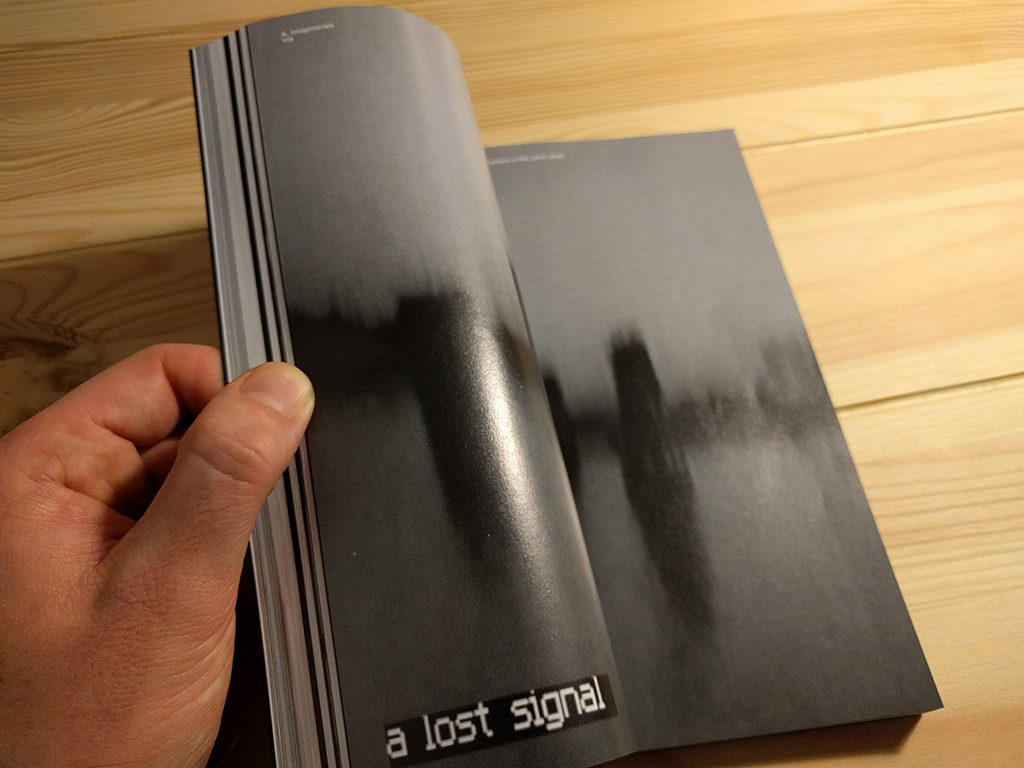
The second subsection – “Interventions” – foregrounds uses of technological media for activist and political purposes (see especially Dragona; de Lagasnerie; Oliver & Vasiliev; Sollfrank; Terranova; Juárez & Allen). In doing so, a number of chapters approach the politics of technological media through a critical engagement with its supposedly transformative power. As Jamie Allen – writing in dialogue with Geraldine Juárez’s artwork Hello Bitcoin – pointedly asks: “[w]hy is it that we cannot seem to stop regaling ourselves with hyperbolic, mythic tales of technological heroism?” (p.223). Put differently, how might media art and theory engage with ‘new’ digital media without overplaying its transformative political power? One answer to these questions revealed in across & beyond concerns the task of developing techniques for storying digital media. As Cornelia Sollfrank’s piece on “cyberfeminism” concludes, the task attending to the political power of technologies is not simply about affirming new advances in technological media, “but rather the use of imagination” (p.245): it is a task of remaking the clichéd stories told about technical cultures.
Yet, at a time when the drone and the TV series Black Mirror have gained prominence in invoking a certain unease about future technological change, what might it take to tell different stories about the political implications of technological culture? Decidedly, Daphne Dragona inflects this political question in a stellar essay on the role of “subversion” in media art. Classically, the problem of “artistic subversion” is its tendency to become appropriated into existing regimes of power, such as “media corporations and state surveillances agencies” (p.184). Identifying strategies that are already at work in “subversive” practices in media art – namely: “obfuscation”, “overidentification”, and “estrangement” – Dragona attempts the ambitious task of redefining the role of artistic subversion. Referring to an example of glitch artists, Dragona (p.191-192) notes that for such work processes of subversion and “estrangement” require a methodological approach attentive to the “hacks, errors and glitches” that “disrupt and challenge user experiences with digital media” (p.191).
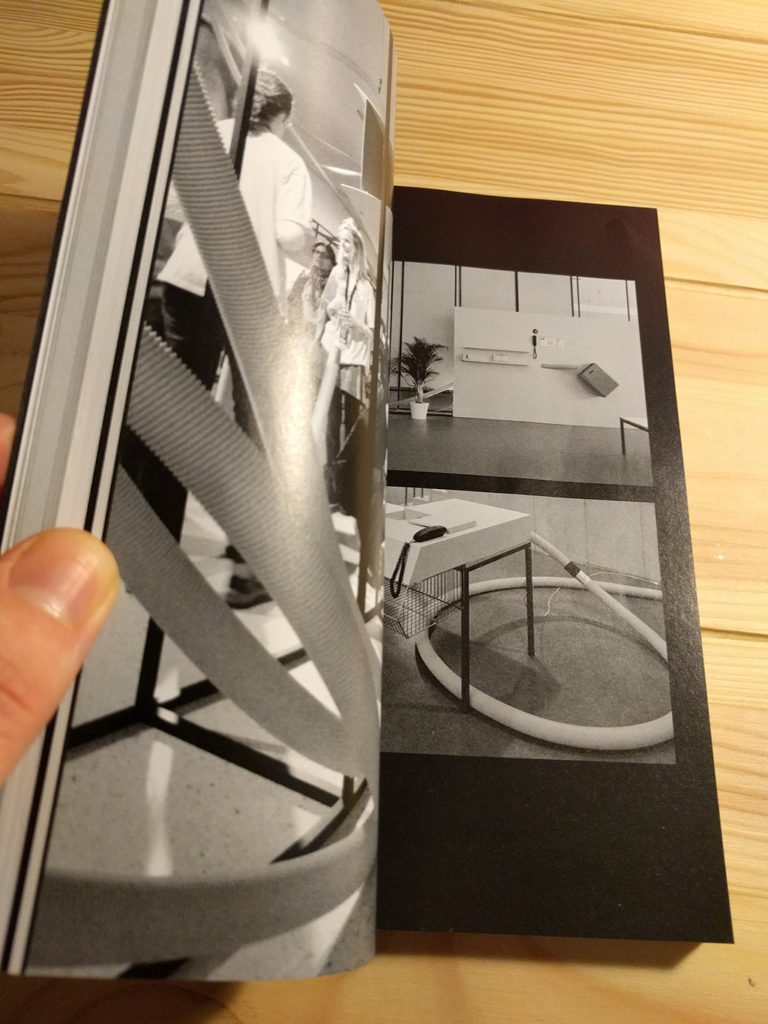
Terranova’s chapter also considers how and whether the political power of technologies might offer opportunities for political transformation, but in doing so draws upon a different question around the relationship between the notion of the “commons” and certain kinds of “techno-political experiments” (p.211-215) – experiments that include, but are not limited to, certain cryptocurrencies and internet-based political parties. These experiments are noteworthy because they offer opportunities for transforming capitalist social, political and technical assemblages – assemblages that, as they are currently configured, not only produce restrictive forms of consumption and surveillance, but also limit freedoms at the level of desire through processes of subjectivation (p.213-217).
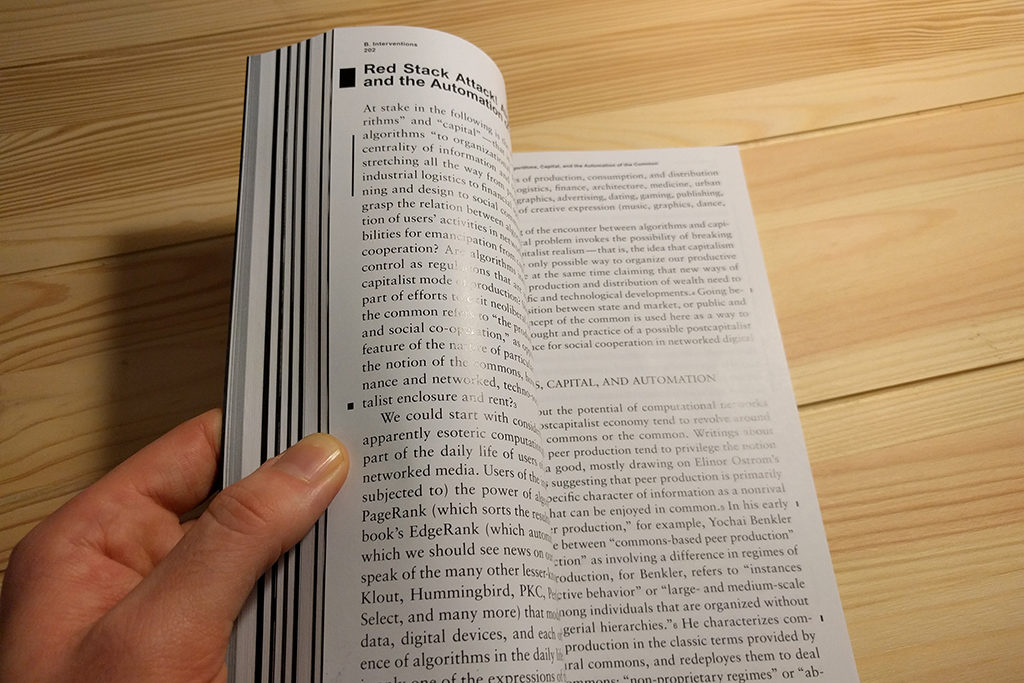
The third subsection – “Ecologies” – concerns the relationship between post-digital readings of technological media and certain kinds of technological infrastructure. In doing so it intervenes in a number of timely and ongoing social scientific debates about technology’s relationship to subjectivity (Bishop; Rossiter & Apprich; Bratton), materiality (Allen & Gauthier; Henderson; Goriunova), and affect (Goriunova; Allahyari & Rouke) – amongst others. Approaching the theme of infrastructure via user interfaces like Apple’s Siri and Amazon’s Alexa, Benjamin Bratton (p.322-323) notes that “[h]uman intelligence and machine intelligence may be radically different (one need not be the model for the other) but they are never isolated or independent of one another”. Bratton calls for a more complex reading of artificial intelligence that resists both the simple equivocation of human and machine ‘intelligence’, and the tendency to suggest that human or machine intelligence exists as an isolable entity.
Directly engaging with the question of post-digital approaches to technological infrastructure, Jamie Allen & David Gauthier – commenting on their Critical Infrastructure project – foreground the need to attend not only to spectacular forms of technological infrastructure, but also those “banal systems” (p.266) and infrastructures that “we are not supposed to notice” (p.266). The point here is to force media art and theory to generate new forms of critique and thought about technical culture beyond some of the tendencies of human perspectivism – what Morehshin Allahyari & Daniel Rourke’s chapter differently refers to as technology’s “unintended affects” (p.328).
One critical concern throughout across & beyond is the sense that the various contributions (artworks, films, photos, essays) do not always easily fit together as a contribution to post-digital scholarship and practice. Whilst the book benefits from a precise introduction, it is not always obvious how certain chapters, and their corresponding subthemes, critically engage with whether or not this field of study would be preferable to other approaches to digital media. Indeed, is the “digital” the problem to be addressed for the task of rethinking technical culture today or – as a moving composite expressed by numerous media – does it form what Deleuze (1988: 16-17) refers to as a “false problem”: that is, a problem that merely discovers pre-existing terms for its solution?
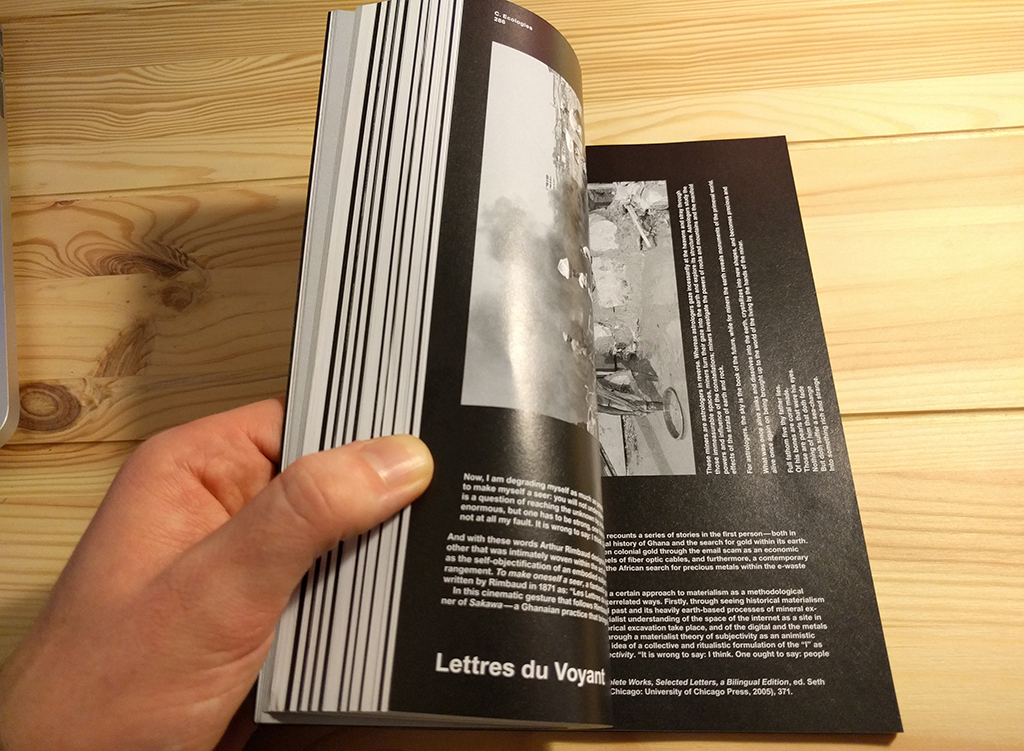
This critical question notwithstanding, and to conclude, across & beyond is highly successful in opening up novel questions about technological media: those mundane and overlooked technological processes that nonetheless offer opportunities for experimenting with profound mediations between humans and nonhumans (see here the chapter by Yokokoji & Harwood). These post-digital registers would engender a different focus from a recent emphasis in the arts, humanities and social sciences on the ways that certain dominant technological figures are variously weaponized and monetized (see chapter by Bazzichelli). In countering the logics of weaponization and monetization, this reader – like the transmediale festival – will have a wider appeal to those interested in how media art and theory keeps apace with changes to those overlooked forms of technical culture.
Artists Organise (on the blockchain) was the fourth event in the DAOWO blockchain laboratory and debate series for reinventing the arts, in collaboration with Goethe Institut London.
In this special event, hosted by Drugo more in Rijeka we learned from the Croatian cultural context before envisioning, devising and testing alternative forms of blockchain-based cultural production systems, for application at Furtherfield in London.
We talked with Davor Miskovic about Clubture, the non-profit initiative that has distributed national cultural funding between a network of peers in Croatia since 2002 according to decentralised, participatory principles.
Workshop participants then took Julian Oliver’s Harvest, in which “wind energy is used to mine cryptocurrency to fund climate research”, as their focus for new proposals for blockchain-based projects to connect park-based arts venues with their local communities. Then they took turns to perform the role of a select committee of skeptical park stakeholders who wanted to know how park users would benefit from the scheme in a time of cuts to public funding and climate change.
Read the semi-fictional Minutes of the Bunsfury Park Stakeholders Group Select Committee
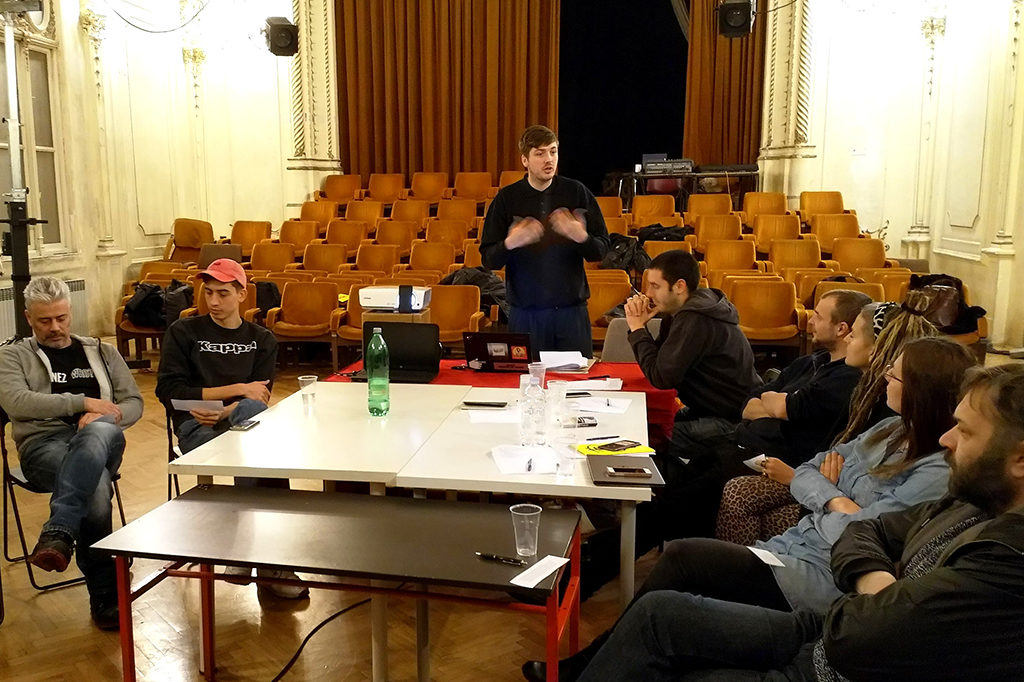

This special event, devised by Ruth Catlow and Max Dovey, and hosted by Drugo more formed part of a wider programme events in Rijeka to accompany the opening at Filodrammatica Gallery of the touring exhibition New World Order.
Thanks to all participants!
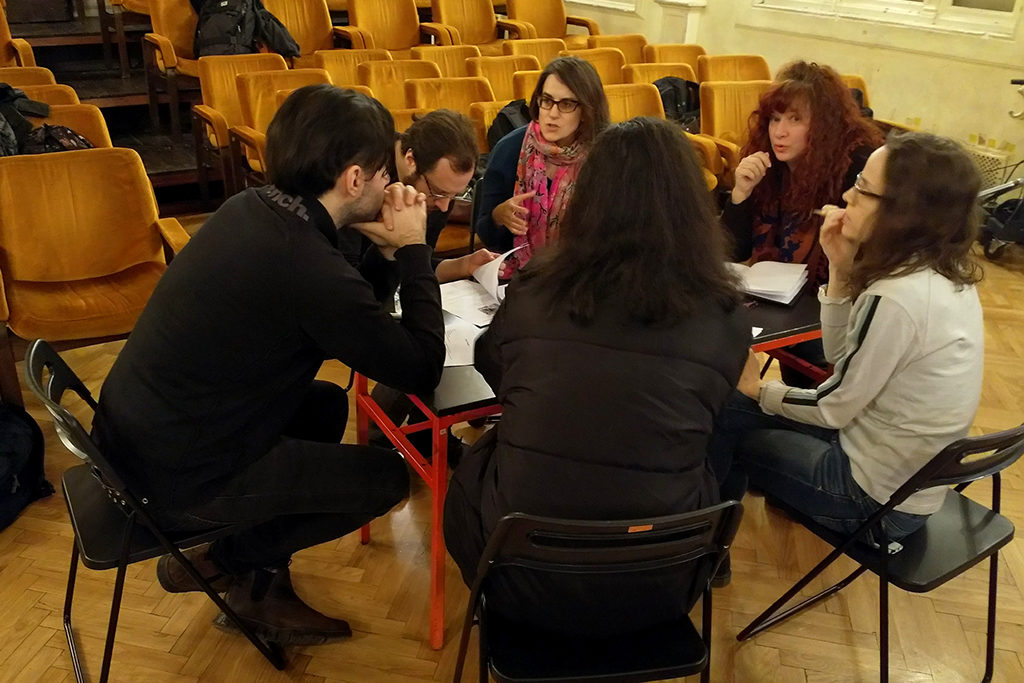
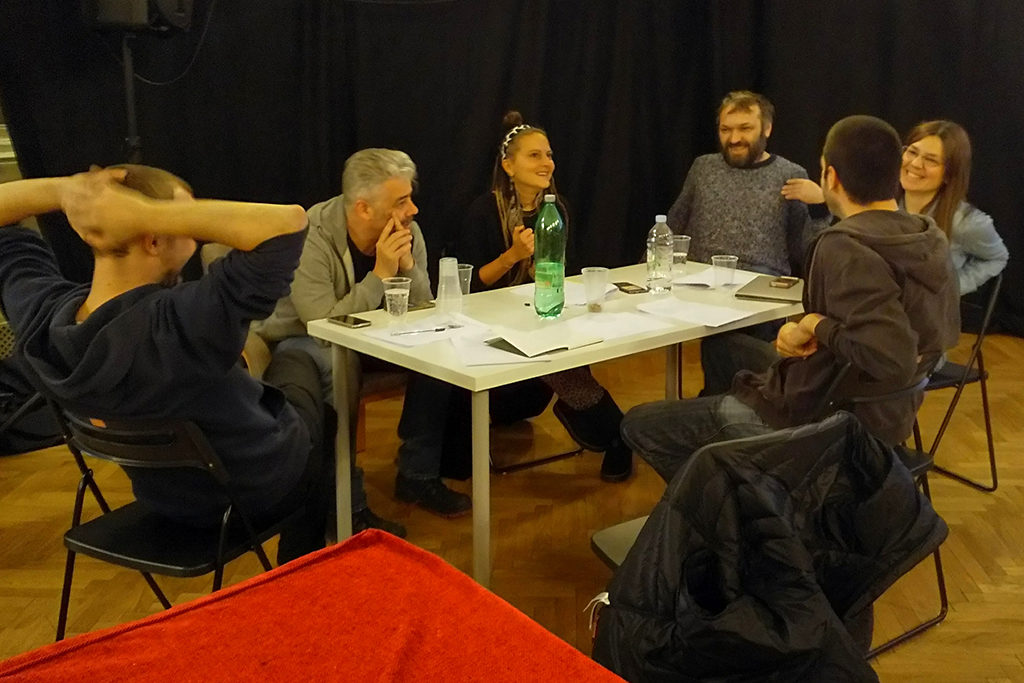
Keep calm and carry on monitoring the media: a review of Monitorial Citizen
NeMe (Cyprus), 9th December 2017, part of the State Machines programme
One couldn’t have wished for a more grounding response to contemporary media anxieties than this event. I don’t mean that the conference was all rainbows and lolkittens. I mean that it collected and tackled serious issues about the contemporary media landscape, its decentralization and its paranoias. It brought together perspectives on monitorial citizenship, citizen participation and citizen journalism –increasingly discussed in journalism and citizenship studies as new, post-modern, or alternative forms of civic engagement that also involve new, post-modern or alternative practices of media participation– and how this phenomenon can reinforce democratic ideals, and counteract forces or fears for their dissolution.
By all means, there seems to be a lot for us to worry about, a condition which the conference takes as its starting place. As moderator Corina Demetriou mentioned during her introduction, there’s the increasing fragmentation and polarization of our world where the success of populist rhetoric and the degradation of political discourse raises concern about our democratic institutions. Then there’s the proliferation of fake news, the dominance of media-scepticism, of conspiracy theory and of justifiably alarmist parental control discourse. And further yet, there’s the democratic failures of contemporary mass media, the corporate nature of social media, and concerns about the failures of media-education. All these in the face of increased surveillance and online censorship instituted with the excuse of / in order to battle all sorts of nightmarish villains.
The conference had the intended side-effect of facing and disarming most of the above, not least by providing historical context and balancing fears with contemporary research, following up criticisms with constructive questions, and offering numerous examples of citizen monitoring at work to an inspiring effect. NeMe gathered its speakers around the urgent premise of the potential for political change that is contained in networked citizen journalism (after Michael Schudson 1998) or citizen witnessing (after Stuart Allan, 2013). This was done in relation to what NeMe frames as a growing demand for political and corporate clarity that brings citizens immediate access and grants crucial issues a kind of evanescence: a transparency that is double-edged, both in terms of exposure, but also a tendency to fade or be drowned out in a sea of information.
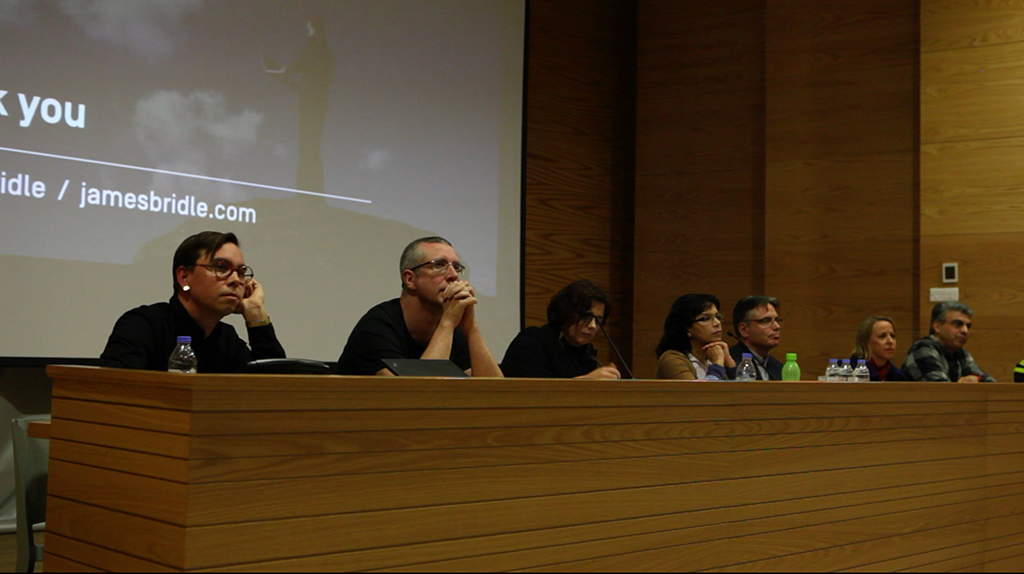
It helps to think of the conference in four parts. First, it provided an introduction to the discursive context and the development of the notion of citizen witnessing (Stuart Allan). Second, it moved on to crucial debates in media education (Joke Hermes) and children’s rights of access to information (Cynthia Carter). Third, it introduced a discussion of the politics of democratic citizen participation in theory and online (Nico Carpentier) and the transformative potential of grassroots media monitoring practices towards conflict transformation (Nicos Trimikliniotis). And it concluded, with satisfying momentum, with a discussion of monitorial practice from an artist perspective (James Bridle).
In the first presentation, the conference defined the field and what is at stake in terms of the media establishment’s clash with the simultaneous need to subsume new developments in citizen journalism: Stuart Allan set-up the context for this through a discussion of the idea that “somebody should be telling this because journalists aren’t.” His overview reached from the Kennedy assassination, to the definition of the Arab Spring as the Twitter revolution, to #blacklivesmatter, and the WITNESS human rights initiative. Allan also reflected on negative reactions from the world of professional journalism where citizen reporting is cast as “ghoulish voyeurism enabled by contemporary technology.” He most interestingly, juxtaposed professional “helicopter” or “parashoot” reporting, done according to editorial directives, with an emergent form of reporting from within. A form that is embedded and unsanitised, and comes in the form of unapologetically subjective documentation, where the amateur camera approaches truth or reality with an immediacy that trumps formal news, and demonstrates how purposeful citizen witnessing can bring about positive social change.
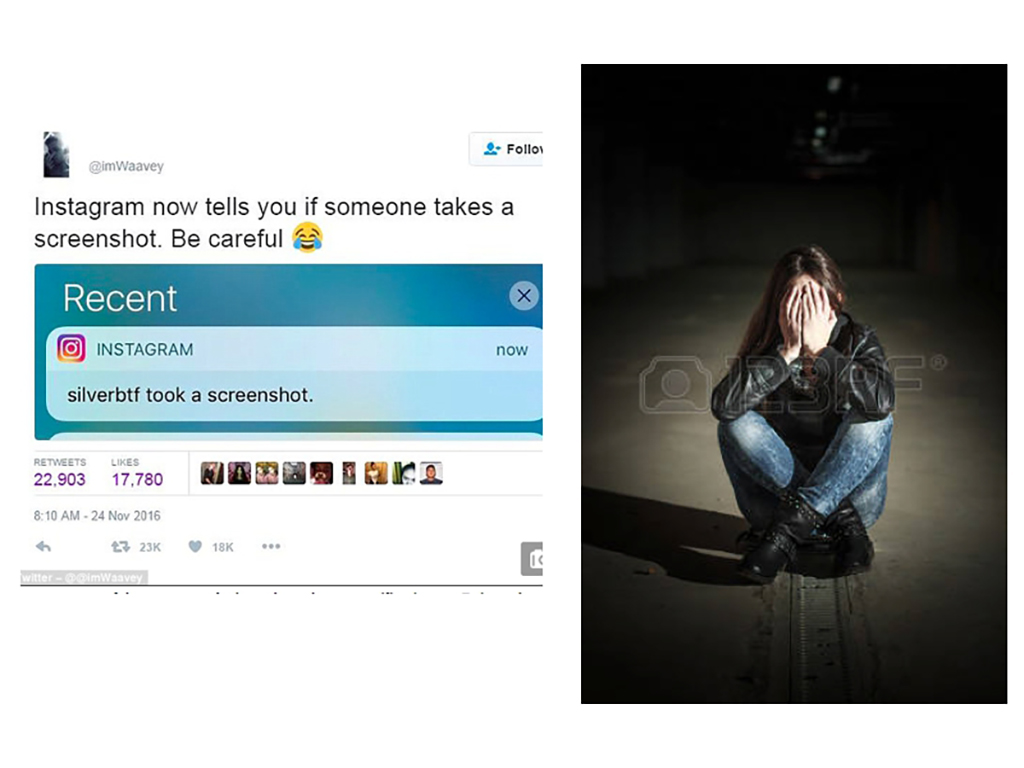
Then came two complementary discussions of sensitive issues around the failures and alarms of contemporary media-education (Joke Hermes) and children’s access to information, with emphasis to their online participation and their potential for political contribution (Cynthia Carter). Both speakers have been working towards the deconstruction of the stereotypic fear that it is a dangerous online world for young people, and they’ve been doing this in different ways and from different angles. Hermes discussed how a quarter century of media education has succeeded in breeding fear and mistrust rather than ways to corroborate and cross-reference. She made the very convincing argument that we need a plan for long-term engagement rather than immediate survival. That we must work towards the strategic teaching of the difference between downright holistic mistrust and meaningful engagement. That we may construct a perspective for cultural citizenship that makes “learning how to listen” (to disengaged sceptics) a priority: part of a new set of conditions for citizenship, where “irony, satire, and playing games” are understood as survival mechanisms, and “ways of blocking screening and fooling one’s parents are understood as useful tools for children to survive in all this, without giving in to conspiracy theories.” Following up from Hermes, Cynthia Carter explored arguments around parental control and its misunderstandings, with a discussion of how research on news media remains incomplete by failing to include the voices of children. She argued against perspectives that cast children as “passive recipients of information that is going to socialise them.” She emphasised how children’s civic rights are undermined by the mistaken perception that, primarily, rather than engaged, they need to be protected. She offered examples where interventions by children exercising monitorial citizenship, have the potential to change perceptions about children’s political interests and their capacity for meaningful, world-changing participation.
Nico Carpentier connected issues of online participation with broader debates and definitions centering on participation as integrated with democratic ideas. He discussed the development of participation-related discourse online and offline, and the posturing contained in such theoretical or practical endeavours vs. their democracy-reinforcing capacity. He highlighted a serious problem with the idealisation of the democratic capacity of online participation: that, for example, “we still haven’t looked at the radical right form of online participation where neo-nazis are participatorily deciding whether they should kill somebody.” Carpentier argued for the need to further “democratise democracy” across fields like the arts and the media, and “do more than pay lip service to the logics of participation.”
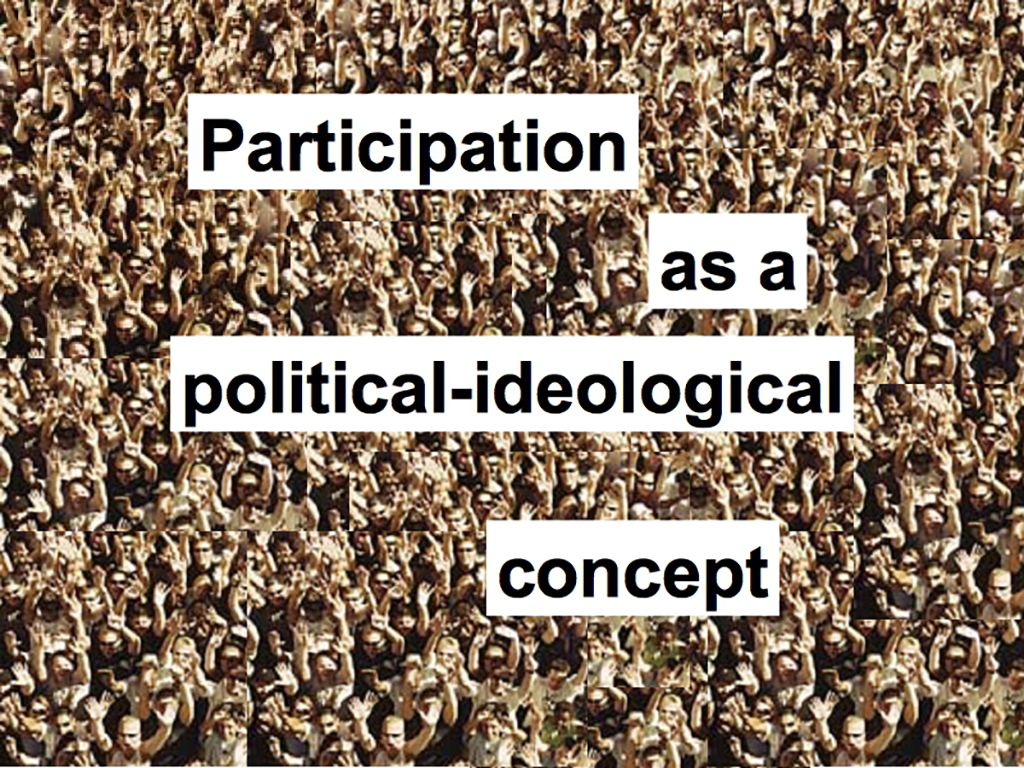
Next, Nicos Trimikliniotis introduced debates around participation and citizen journalism in relation to Cyprus, and to argue for the need to compare struggles and national contexts, particularly in relation to peace journalism and the potential for overcoming austerity and chauvinist citizenship models. He emphasised the role of the media in conflict transformation, in defining the nature of conflict and division: its contextualisation and relativisation, and transference towards social and other issues. For him, the creation of third spaces that defy the long-embedded interests of mainstream media is a crucially valuable new element. He identified such a critically valuable third space in the practice of the monitorial citizen. He used the example of the Cyprus-based collaborative online journalism collective Δέφτερη Ανάγνωση (trans. Second Reading), to argue that it indeed possible to undercut colluding media, and transform the reporting, the investigation, and the very nature of professional journalism, with the help and participation of monitorial citizens, intellectuals and artists.
Finally, James Bridle introduced a multilayered example of his own monitorial artistic research practice, an exercise of monitorial citizenship that actually researched issues of citizenship, migration, and asylum. He focused on a particular project where he worked to cross-reference details left out of a story in the UK press about Theresa May putting asylum seeker and hunger striker Isa Muazu on a private jet for deportation (2013). Bridle tried different methods in order to find out where this jet landed and to investigate the systemic, legal and spatial conditions for this kind of deportation. He spoke about the value of collectively maintained online tools that pool information through crowdsourcing, such as tools designed by the flight-spotting community, in this case making public the capacity to track flights. Bridle’s investigation led to a detention centre next to Heathrow, and then to the architectural mapping of this facility, where secret deportation trials seem to be taking place. He proposed this as a way of using the ability to research and cross-reference information through new tech, to make visible something that wasn’t visible before, and thus draw a picture of the system that produces a particular kind of story. In this case a story of deportation, also connected to the debate about global surveillance, by performing a kind of reverse surveillance.
Most interesting, and as a conclusion to the conference, Bridle made transparent his own questions about this instinct of monitorial citizenship: the issue that bringing things to view could be a solution to injustice. He pointed out that his own investigative whistleblowing and NSA surveillance, have in fact, the same logic behind them. Both top down centralised government surveillance, and bottom up citizen-driven monitoring or reverse surveillance are based on the logic that there’s something secret and if we bring it to view, then something will be radically transformed. Except according to Bridle this is not fully accurate. There is a danger here that we may make the invisible visible but remain blind to the systemic forces that brought it to be in the first place.
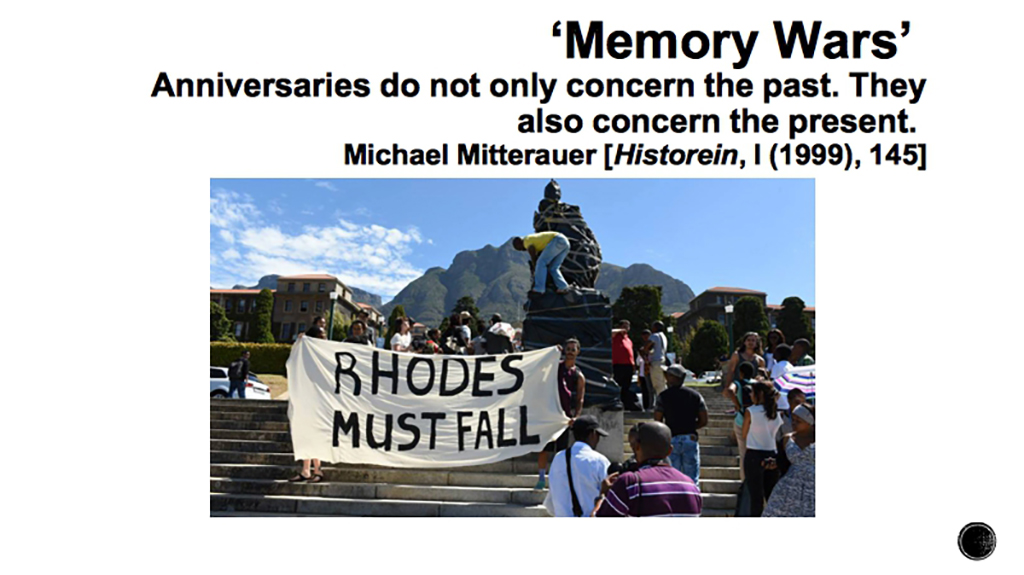
The discussion following the presentations focused on the potential of citizen monitoring given local Cypriot peculiarities, returning to the example of Δέφτερη Ανάγνωση, with members of the audience introducing the consideration that the structure of coordinated efforts of citizen monitoring (whether flat, or hierarchical, or anonymous, and so on) can play a role in its potential to set-up democratic resistance. The formal discussion transformed into after-conference mingling over drinks and finger food that was good enough to keep people processing in small groups for over an hour. My own conversations pushed onwards from James Bridle’s point about our unwitting complicity with surveillance logics: do we try to resist such logics? (The answer may be that we can try to temper them). This included a conversation with Joke Hermes, making the connection with a recent article by James Bridle documenting weird and often disturbing algorithmically generated youtube videos targeting children (Bridle, 2017), and putting the question of where to draw the line between parental concern and parental panic. (The answer seems to be gently, by avoiding random overexposure at the preverbal stage, not attempting totalitarian control, and focusing on being there and paying attention).
There’s a lot to pick up on in conclusion, aside from my insolent and possibly unjust isolation of one-liners in bold, for which I must ask the speakers’ forgiveness. I am most interested in two elements that seem especially innovative contributions to what is already a very rich and intensely investigated intersection of scholarly work on journalism and citizenship. This conference went the extra step to further bridge this growing field with other sides of media theory: First, in connection with peace scholarship and local issues around media collusion and their effect on conflict transformation through the work of Nicos Trimikliniotis. And secondly the connection made with educational theory and cultural studies through the work of Joke Hermes and Cynthia Carter, a beautifully resonating combination with a feminist focus on understanding, rather than fear or control.R
Photographs and videos by Sakari Laurila
This project has been funded with the support from the European Commission. This communication reflects the views only of the author, and the Commission cannot be held responsible for any use which may be made of the information contained therein.
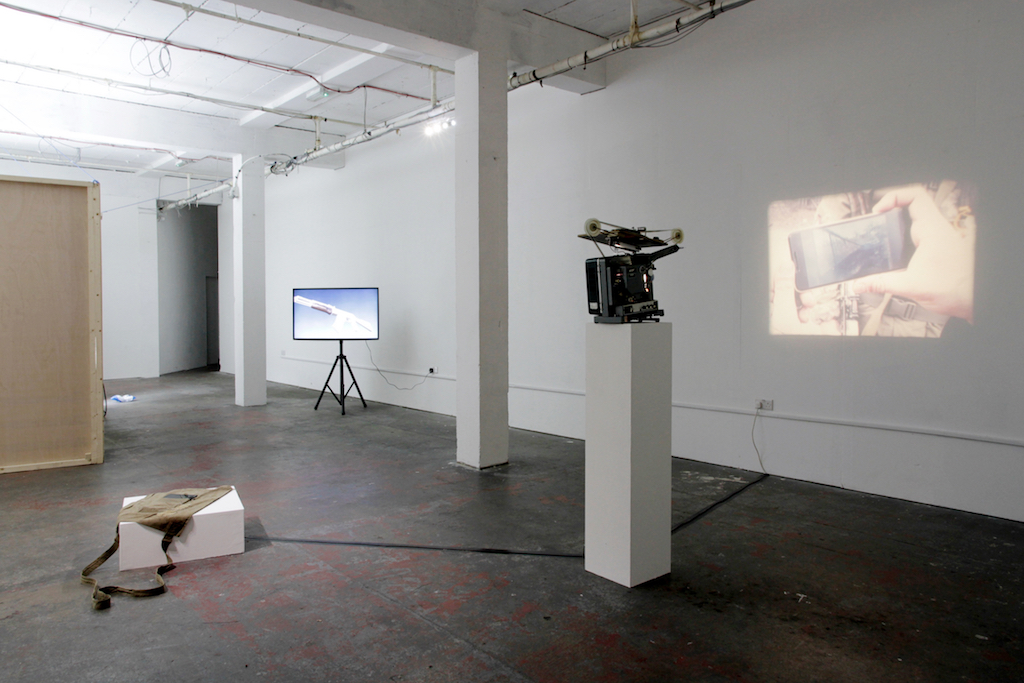
Referring to Ernst Jünger’s proto-fascist concept of the ‘front experience,’ Dani Ploeger’s fronterlebnis takes us to a frontline where digital consumer culture and traditional warfare meet. Combining filmed footage of a journey to the frontline in the Donbass War, Ukraine, alongside vintage military paraphernalia, Ploeger puts the artist in the field with the ‘real’ soldier. These soldiers are men from the far-right Ukraine Volunteer Corps, affiliated with the Right Sector, and remind Ploeger of ‘the weird and wonderful mix of action heroes in Sylvester Stallone’s Expendables series, albeit without the body builder physiques and less carefully manicured.’ Here, Ploeger not only conceives an exhibition which examines the relationship between the cleanliness of modern day technology and the grittiness of traditional warfare, but also highlights wider issues around society’s continued masculinised and fetishised relationship to conducting, and, as some of these pieces show, documenting war. With Ploeger’s ‘weird and wonderful’ group made up exclusively of men, featuring masculine nom de guerres such as Bear and Carpenter, fronterlebnis is an exhibition in which masculinity is in the crosshairs as much as anything else.
The four-piece exhibition is part of Ploeger’s current exploration into the militarisation of public spaces across Western Europe in connection with our increasingly fetishised relationship with consumer technologies, and how these apparently disparate elements converge in various conflicts, ranging from the Donbass War to public security in cities like Brussels and Paris. The soldier’s body has arguably shifted in its role since the latter part of the 20th century, with the advent of sophisticated warfare technologies moving the human body away from the process of killing, at least in popular imaginations of conflict. With this development, the methods of war appear to have shifted, but it is in fronterlebnis that we are able to see how in the Donbass War in Ukraine, traditional warfare not only remains but has now become intertwined with advanced techno-consumer culture.
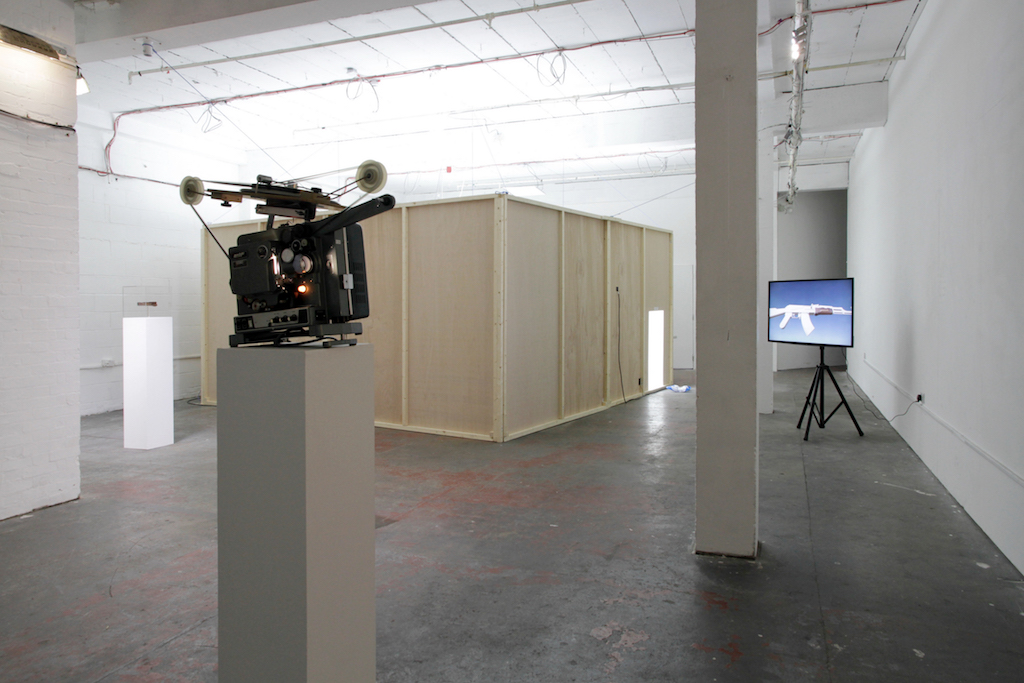
This juxtaposition of the old and new is present in the first piece you encounter as you enter the gallery. In Patrol (2017), Ploeger captured a firefight on his smartphone. The footage has been transferred to 16mm film and is being projected onto the wall of the gallery in a continuous loop. In the film, we see three soldiers – Bear, Carpenter and Steinar – escort Ploeger around the frontline on the edge of the destroyed seaside village, Shyrokyne. These men, in an assortment of vintage and contemporary battle array, many carrying the iconic Kalashnikov rifle, are seen sharing footage of their exploits on the frontline with each other, which they have captured on their smartphones and GoPros. Steinar, the youngest and, as Ploeger told me, the most fashion conscious in his choice of military gear, is filmed by Ploeger watching footage of the moment where he and Carpenter blow up an unexploded mortar shell. In this piece, the 16mm film echoes the era of the weapons that the men are carrying. The manner in which this film is projected reveals the peculiarity of watching a modern day firefight where many of the weapons and uniforms are from the Soviet era, but the men are astute in their engagement of consumer technology in order to document their experiences of the conflict. In Patrol, the Kalashnikov and the smartphone appear to have made an unlikely pairing.
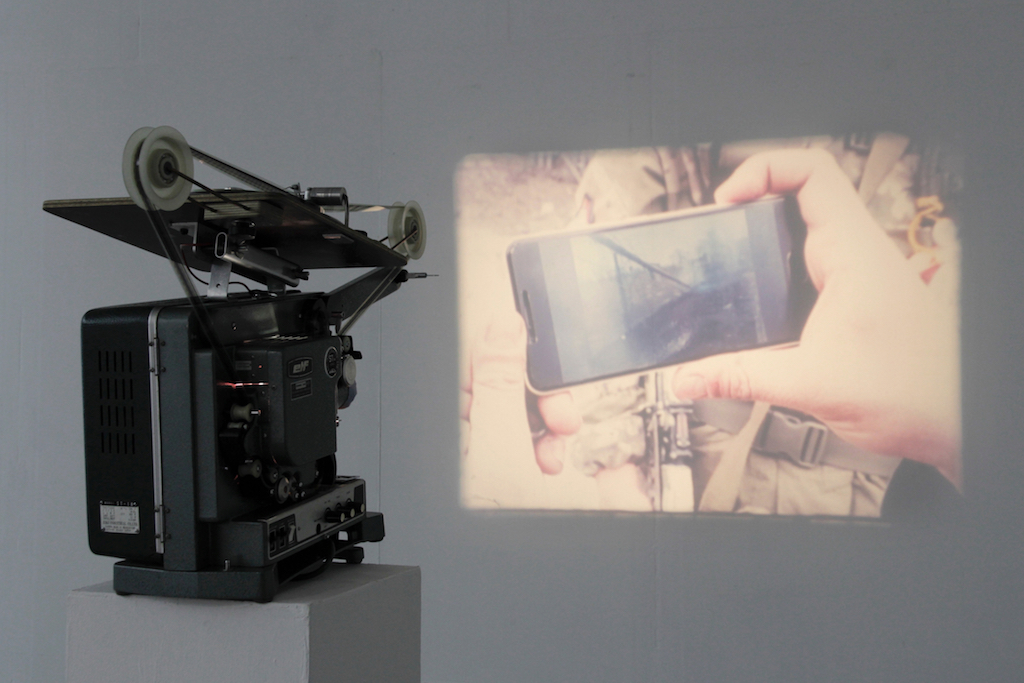
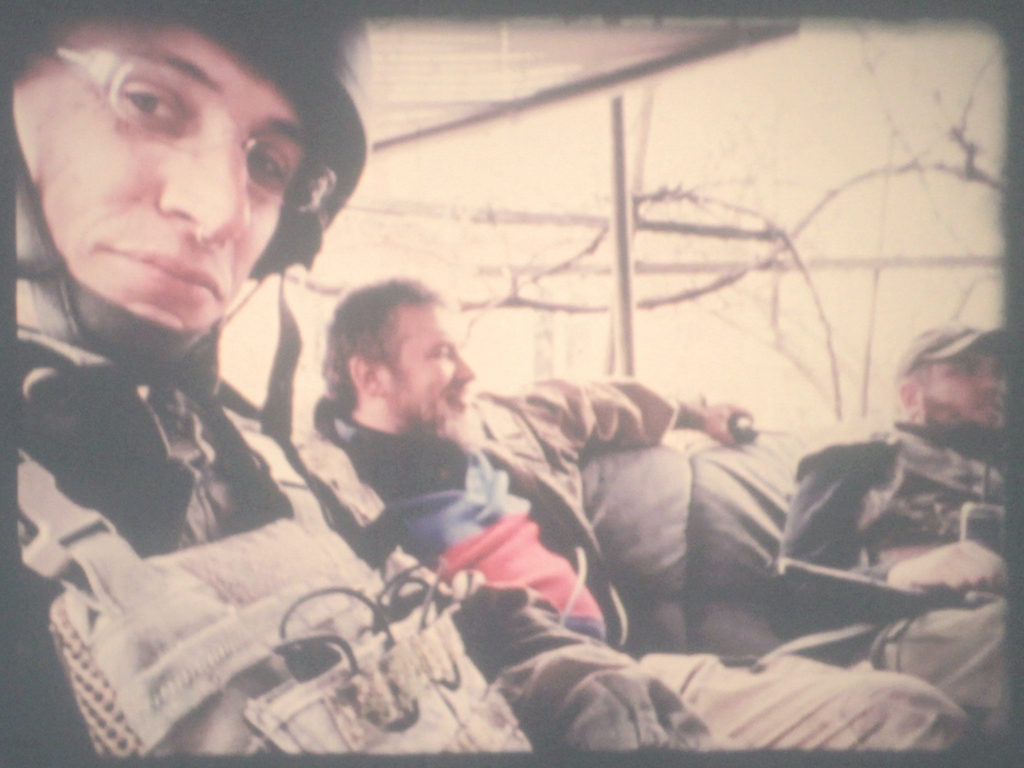
The other work in the show features such seemingly unlikely pairings of traditional paraphernalia of warfare coupled with different pieces of consumer technology. In artefact (2017), the wooden handguard of a Kalashnikov assault rifle is exhibited like an archaeological artefact. Presented on a white plinth, encased in Perspex glass, you can see that the wood of the handguard has been worn with the indents of many hands, signalling its intense use. This carefully exhibited object is just one half of this piece though. The other half consists of digital video animation in which a high-resolution 3D scan of the handguard is inserted onto a digital model of an AK-47. Presented on a large television screen, the digital model, set against a standard blue sky backdrop reminiscent of game development engines, highlights how many of us only come into contact with these types of weapons in a digitised form; whether that be in video games or through action movies. Ploeger’s engagement with firearms here reminds me of some of his past work that seems to suggest an interest in these weapons in relation to masculinity and phallic imagery. Dead Ken /Less Pink (2016), a short video installation in which Ploeger fires a small revolver at a Ken doll, speaks to the seemingly indelible relationship between firearms and masculinity. When seen in relation to this video installation, artefact signals an enduring fascination in our shared social psyche with these weapons, but also speaks to how these weapons continue to be consumed and represented in relation to masculine identities.
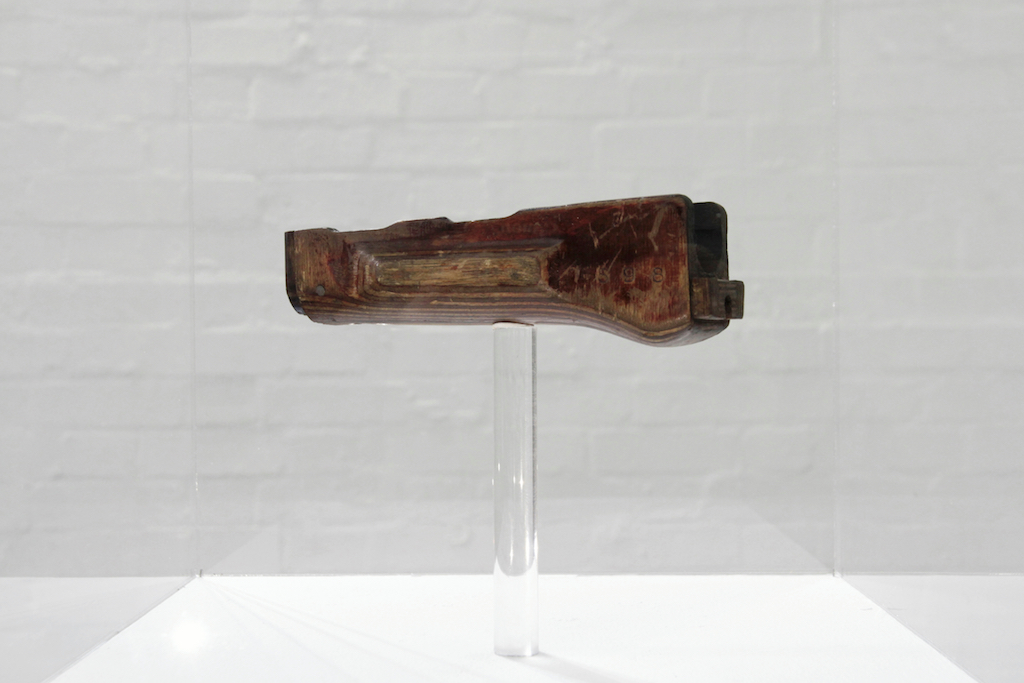
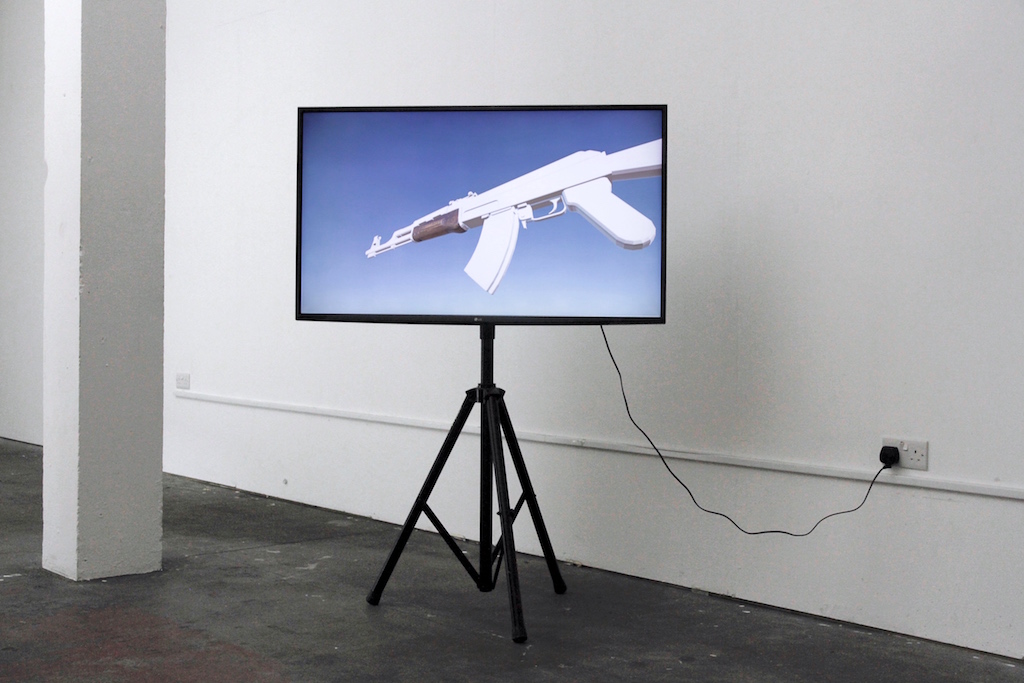
In worse than the quick hours of open battle, was this everlasting preparedness (2017), we can see a more tangible engagement with the co-existence of war artefacts and digital technology. Held in the front pocket of a Soviet army backpack from the Afghanistan War period is a damaged tablet computer which displays a bouncing screensaver, featuring a piece of text from Ernst Jünger’s proto-fascist novel Storm of Steel (1920). Jünger describes his experiences of fighting on the frontline during the First World War and the title of this piece is a translation of the text we see displayed on the tablet. Here, the mediatised depictions of war that are so pervasive in popular culture are delineated from the lived experience of Jünger, who discusses this perennial notion of prepared waiting that is a common, though rarely shown, aspect of war. Here, the worn backpack which has been roughly patched and repaired, presumably by the hands of the man to which it used to belong (men’s hands are for holding guns rather than sewing needles this bag appears to suggest), holds the similarly worn and damaged tablet. These damaged items speak to Ploeger’s past work with electronic waste, which explored our society’s proclivity for abandoning technologies when they become outdated or damaged. In this exhibition, however, Ploeger brings together the old and new, using pieces of (almost) electronic waste alongside other material artefacts to further explore the relationship between the material and digital.
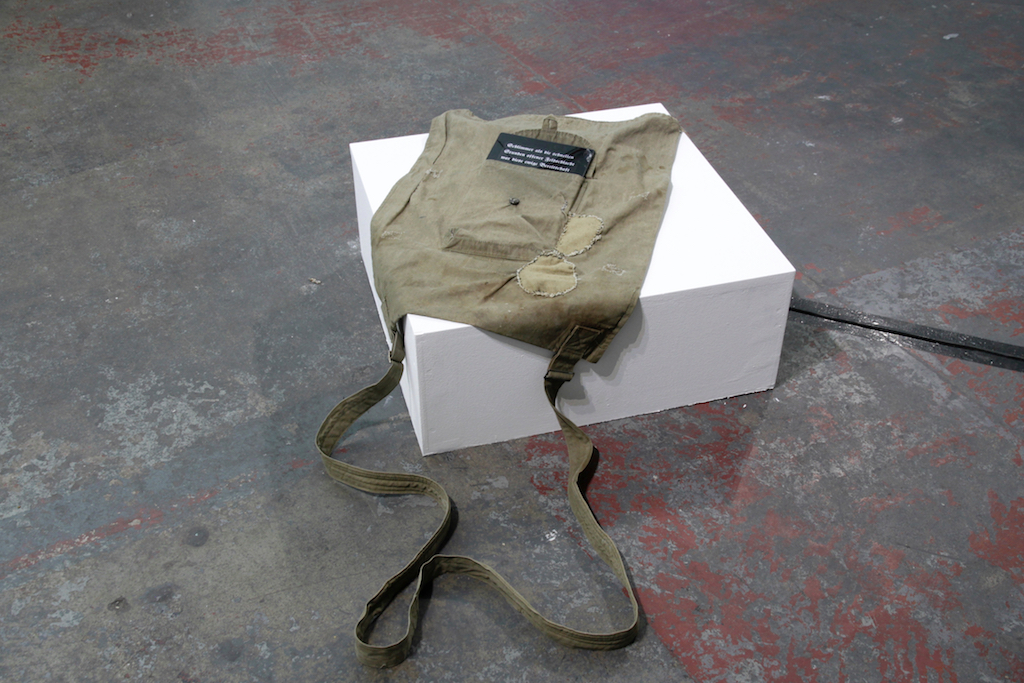
The largest piece of the exhibition, frontline (2016-17), deploys this new and ‘clean’ technology in order to take us to the frontline. The work consists of a big wooden enclosure of about 5 by 5 meters which can be entered through a small opening on its side. The entirely white inside of the space is brightly lit by a large grid of office LED lighting that hangs above it. This enclosed space speaks to the ways in which Westernised notions of conducting war are now considered clean and sterile as a result of the technology that they use. Before entering the space, you are asked to place foot coverings over your shoes, as if you would be entering a sterile space, a futile gesture it would seem as the same coverings are used again and again. This action, however, also references the cultural shift in how Western nations like to represent high-tech warfare as a clean affair.
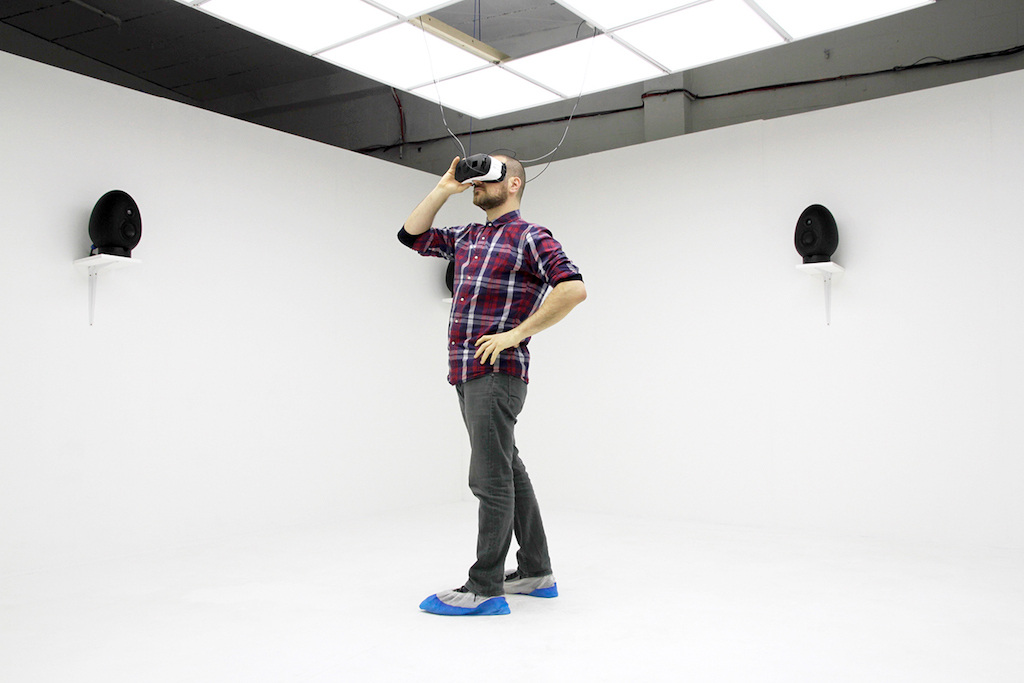
When you enter the enclosure a sensor is triggered and a soundscape of intense gunfire and explosions suddenly surrounds you. It is only until the you place the VR headset on to your eyes that this soundtrack, fit for an action movie, ceases. Roused by the noise, you are then met with a starkly contrasted image to what was suggested through the preceding gunfire soundscape. Rather than an action scene which complements the sounds previously heard, you enter an uneventful immersive video of soldiers smoking and sitting on the frontline. Using an intricate combination of partial video loops, the men appear to be on a never ending smoking break. frontline, subverts our spectacular expectations of warfare and VR technology by creating a VR experience that – after using sound to further heighten our expectations – foregrounds the mundanity of waiting for something to happen that makes up most of everyday life in an area of conflict.
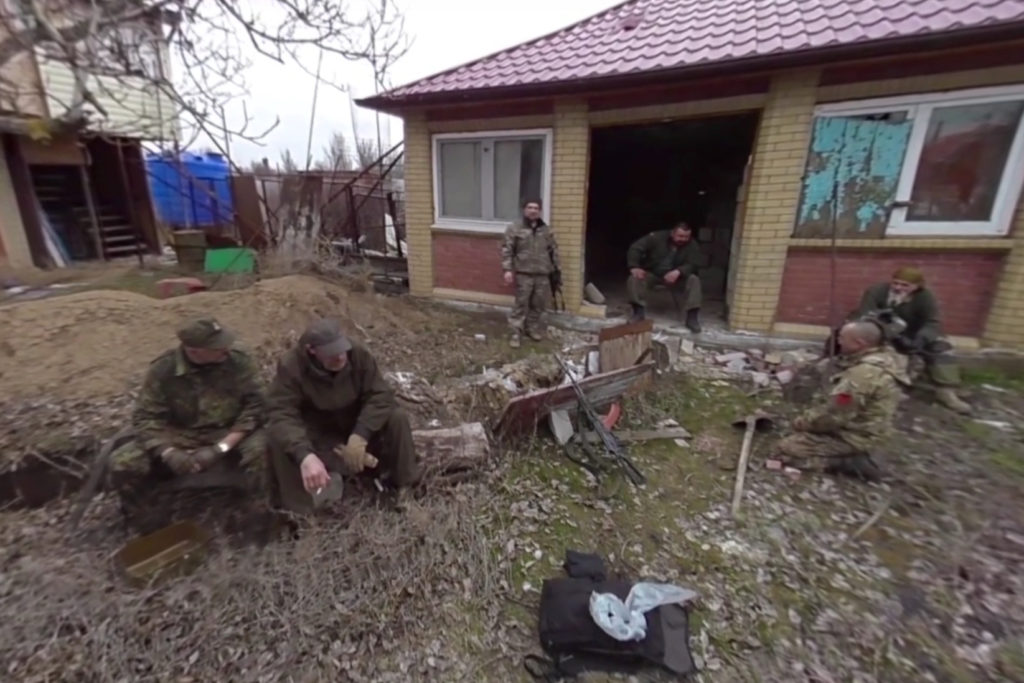
In frontline, as in all of the pieces that are exhibited as part of fronterlebnis, Ploeger subverts our expectations by combining and repurposing technology to make us question our relationship with our technological devices and how we perceive and engage with them in everyday life. In addition to its examination of digital culture, fronterlebnis also seems to suggest that warfare remains a man’s game. We encounter men who are still prone to having their boy’s toys, but it would seem that in this case they are a GoPro in one hand, and a Kalashnikov in the other. Ploeger’s documentation of these conflicts, made with his own personal technological devices, arguably envelopes him in similar mechanisms of fetishization as the soldiers he was with. Neither soldier nor artist seem able to extract themselves from the seductive realm of audiovisual gadgets and self-mediatization in an era of omnipresent digital consumer culture that even reaches as far as the trenches of a dirty ground war.
TERROR FEEDS: Inside the Fear Machine, took place in Berlin November 24-25 2017, and was an analysis of ISIS and its media strategy, the meaning of cyber jihad, and why people enroll as foreign fighters. The 12th conference of the Disruption Network Lab was directed by Tatiana Bazzichelli. Studio 1, Mariannenplatz 2, 10997 Berlin.
Curated by Tatiana Bazzichelli and investigative journalist Mauro Mondello. In cooperation with Kunstraum Kreuzberg /Bethanien, SPEKTRUM and Supermarkt Berlin. Funded by the Reva & David Logan Foundation (grant provided by NEO Philanthropy), the Mozilla Foundation, the Bertha Foundation and the Checkpoint Charlie Foundation. Supported by: the Radicalisation Awareness Network (RAN). In collaboration with the Alexander von Humboldt Institute for Internet and Society (HIIG). Media Partners: ExBerliner, Furtherfield.
To analyse the operational methodology of ISIS means to understand terrorism beyond general terms and not only in reference to the Islamist group. It has updated its strategies during the years, making communication a decisive element of its system. ISIS has shown us how it is possible today, through the networking and the fluidity of information exist runs and build a structure, on several levels and far from a geographically fixed dimension. We are used to thinking about such situations in traditional ways when we refer to paramilitary organisations, and not in such elusive terms where the enemies are so difficult to control, and very difficult to identify. The Terror Feeds conference, has made it possible for us to focus on how terrorism is conducted, in how electronic jihad and strategic messaging affects the worldwide public opinion, both in the west and in the Arab world, representing a new icon of “global jihad”.
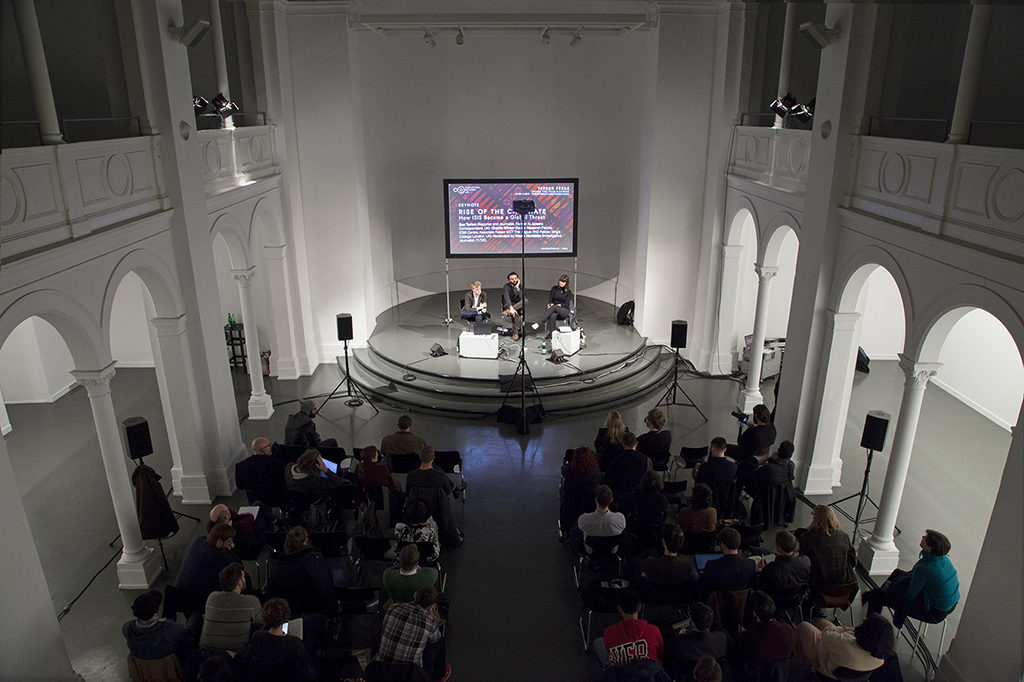
It is a fact that the territories which were once dominated by ISIS have now collapsed and are fragmenting into smaller, chaotic forms of inter-connected, spurious networks, scattered in the rural parts of Iraq and Syria. Nevertheless the group will go on and transform into something else, adapting its strategy.
“ISIS seems to have taken its foot off the official media pedal and is now instead, putting more effort into the logistics side of its insurgent equation”, said Charlie Winter, researcher at King’s College London, during the first panel of the Disruption Network Lab conference. “This change is part of a shift prefigured by the organisation’s changing emphasis on Hijrah, the act of travelling to the caliphate to join the Islamic State. On one side, Hijrah is still promoted but ISIS no longer prioritises this form of recruitment”.
During his speech at the conference, Charlie Winter focused on the importance of propaganda for ISIS, and how their production and dissemination is at times considered to be even more important than the military side of the Jihad itself. Winter says, the caliphate message is entirely non-spontaneous and based on three principles: a coherent, positive and alternative narrative; a rejection-based counter-speech operations; the launching of occasional, carefully calibrated media “projectiles”. The mainstream is considered as an effective weapon that can exceed the power of the most powerful bombs.
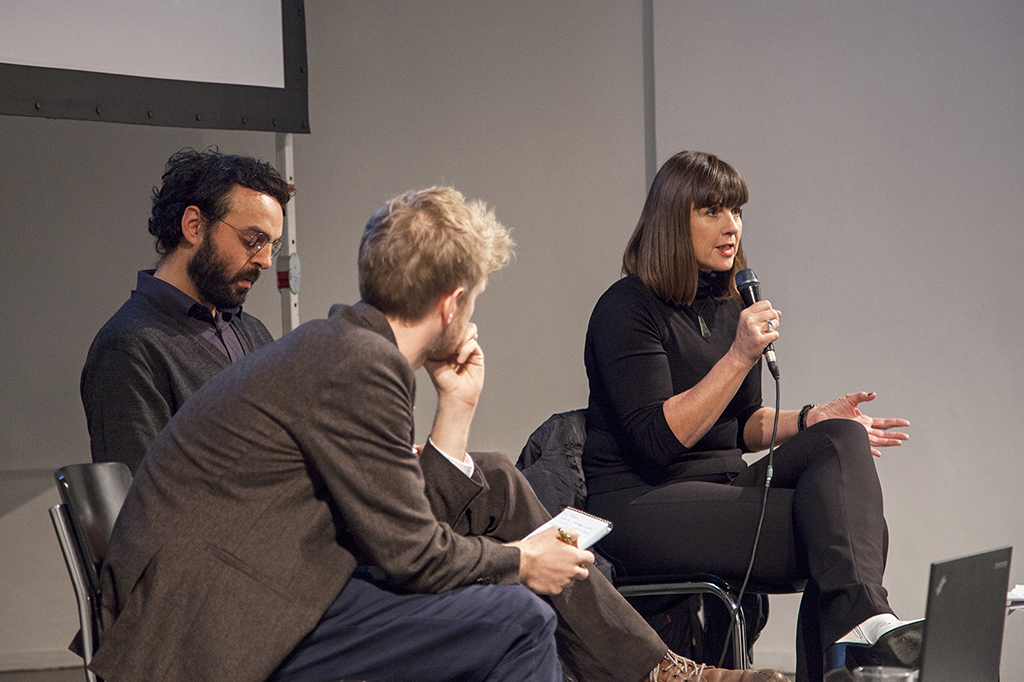
Sue Turton, former Al Jazeera correspondent, writer and journalist, explained during her speech at the conference that ISIS strength is built on its capacity to reach through its propaganda, at people sitting at home eating their dinner with the aim to transform these viewers into ISIS fighters, wherever they are in world. “In some way, ISIS is exciting and gives these individuals the feeling that they’re doing something right and that they accomplish something for their faith.”
“Isis has an extensive network of media experts and social media accounts”, said Dlshad Othman, security engineer and speaker of the Keynote. Focused on the so called Cyber Jihad, “ISIS, has been able to hack government websites and carry out attacks on thousands of Syrian activists social networking accounts, to develop malware, as well as hack the White House website. Cyber Jihad is an organised branch of the ISIS’s military strategy and has been able to be used as a main element to reinforce its structure. Cyber Jihad started with doing very simple malware and then increased its level right up to a very well organised phishing campaign.”
Another way to understand how ISIS works is to look at the documents relating to the ISIS administration. “The records sometimes can say more about Isis than the propaganda it releases everyday”, says Jihad-Intel Research Fellow at the Middle East Forum, Aymenn al-Tamimi. The reach and wide “impact and influence, of ISIS media development over time, is pretty clear,” and you can see this reflected in “how many other military groups are trying to emulate the ISIS media strategy in Syria, today .”
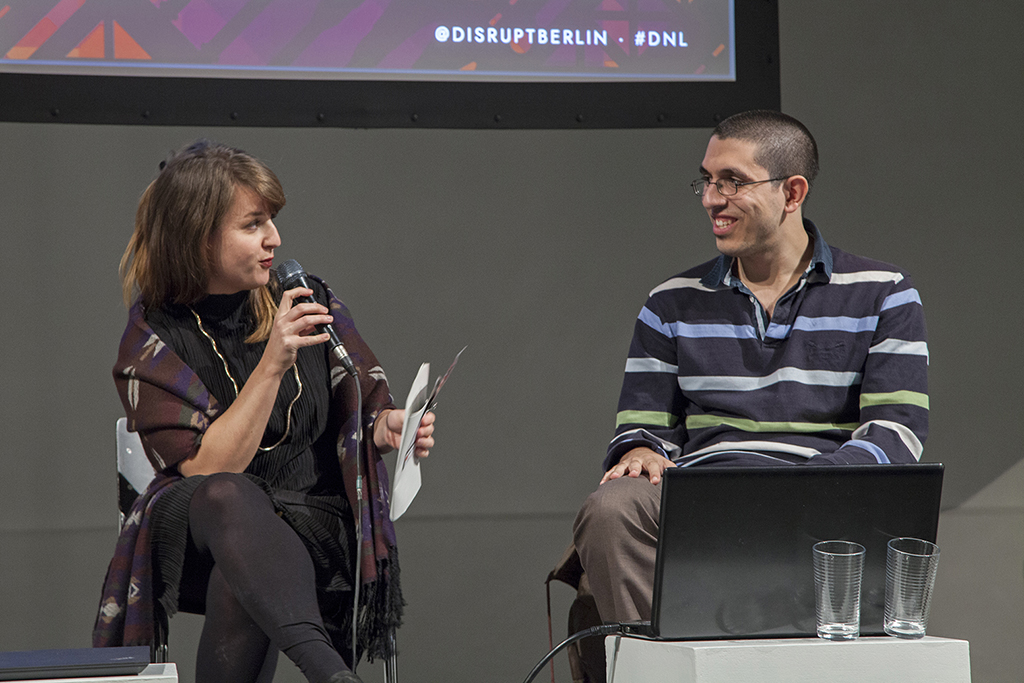
ISIS marked a new path especially concerning the recruitment of fighters, demanding Muslims across the world to swear allegiance and migrate to a territory under its control, and also demanded that other jihadist groups worldwide accept its supposed, supreme authority. “In order to understand ISIS – points out Saud al-Zaid, Scholar of Islamic Studies, Berlin Graduate School of Muslim Cultures and speaker at the Disruption Network Lab conference during the keynote Radicalized: the franchise of terror – “it is crucial to make a difference among individuals, societies and cultures in the ISIS world and to start focusing on what they all have in common, that of course is, first of all, support for the terrorist group”. Al-Zaid concentrate on the distinctions, in terms of conflict, between Native and Foreign fighters. “It is not so easy to distinguish, for example, between a guy from Falluja, Iraq, and another one from Yemen,” Sayd al-Zaid during his speech at Terror Feeds conference. In the words of Peter Van Ostayen, also a speaker during the Radicalized: the franchise of terror keynote, “half of jihad is media”. For Van Ostayen, Historian and Arabist, PhD candidate at KU Leuven, “half of jihad is social media, especially in the recruitment, as we can see exploring the recruitment process of Belgian foreign fighters: more than 600 Belgian individuals joined or tried to join ISIS in Iraq and Syria”.
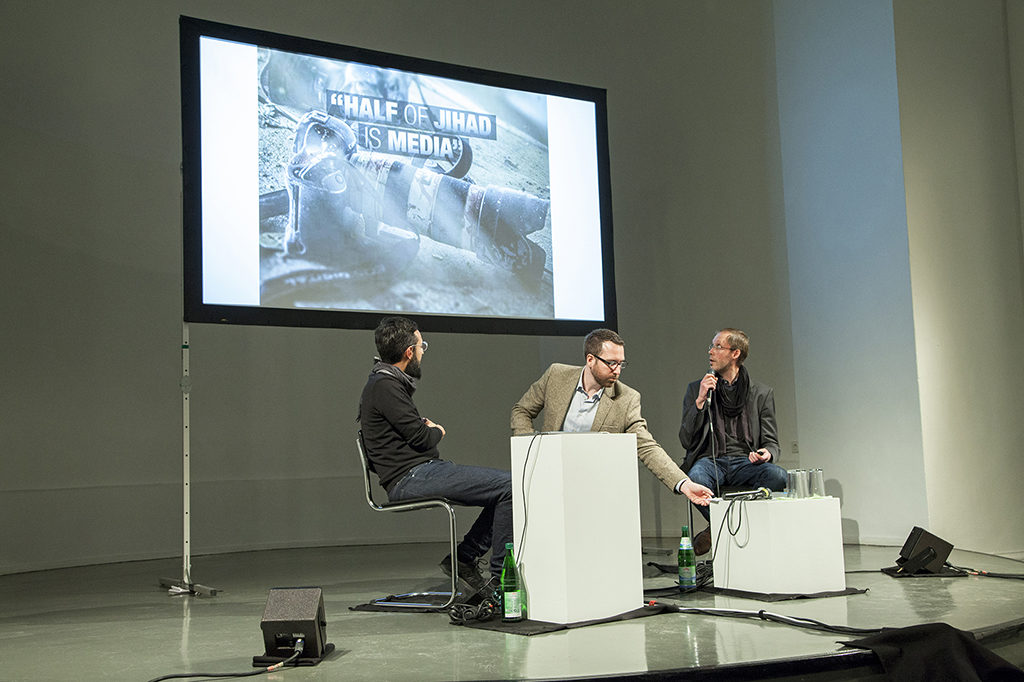
Counter-extremism strategies and prevention also are an issue to consider in the context of increased public fear about homegrown terrorism. “Initially our prevention strategy was not focused on schools and teachers, but engaging with civil society, mainly trying to prevent young people, entirely from Muslim communities, from becoming extremist” – explained Tufyal Choudhury, Assistant Professor at the University of Durham Law School in England, during the Prevention and Prejudice panel – “Than the government changed in 2010, so Prevent policy changed too, in two important ways: Prevent was not anymore focused on all forms of extremism and was not just concentrated on violent radicalization, but also on extreme ideology. Of course this created another issue: we needed to understand what non violent extremism was”. Michéle Hassen, Working Group Leader at RAN, Radicalisation Awareness Network, also a speaker during the Prevention panel, stated that “we’ve not a problem with the concept of radicalisation, but it is different when radicalisation leads to hate crimes and terrorism.” For Sindyan Qasem, Research Associate at the University of Münster, Centre for Islamic Theology, the question about Prevention and Radicalisation is how do vague conceptualisation of radicalisation and extremism lead to the infringement of human rights. “I personally think that preventive measures against islamic extremism are almost always based on ideology, so the educational measures and countering extremism in schools is based on giving alternatives to the ideology of islamic extremism”.
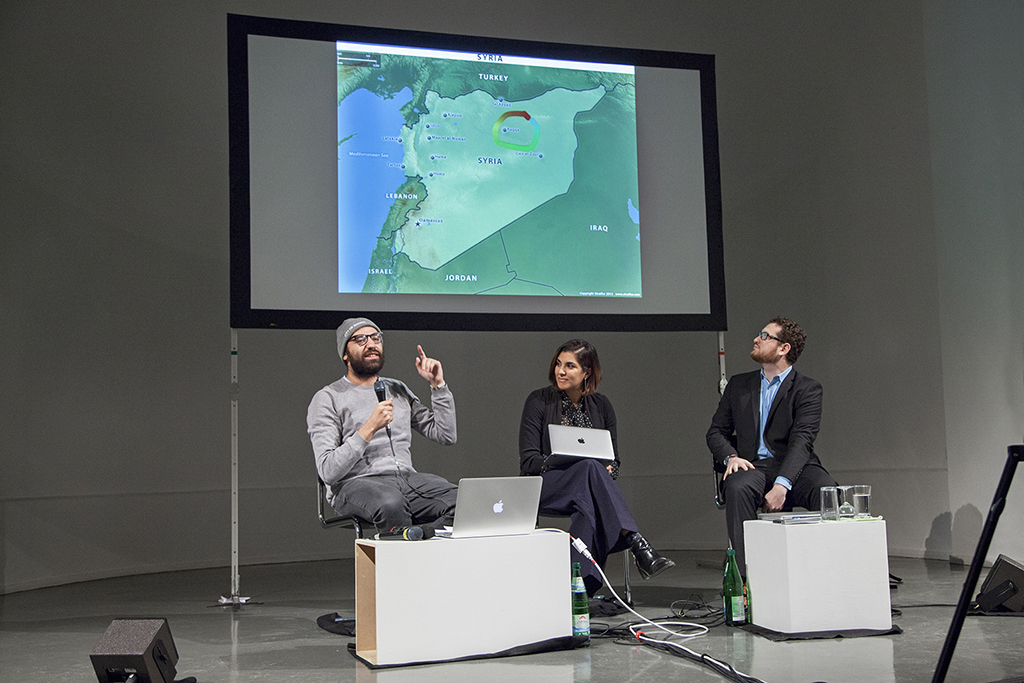
Among the goals of the conference was to focus on the territorial challenges provoked by ISIS. In this sense, Abdalaziz Alhamza co-founder of the blog Raqqa Is Being Slaughtered Silently and Media Activist, shared the experience of living in a Raqqa under ISIS control, trying to resist and documenting the daily life in the “Islamic Caliphate”. “ISIS prevented all media organisations to cover the conflict, so it was very important to show what was going on,” explained Alhamza. “ISIS did mistakes that we were able to analyse and spread to others. Although, most people just had ISIS propaganda and they slowly started believing in it, so we decided to target everyone. Most of the people had no internet access, so we went speaking with people, we went to schools, we went to Arab communities, to tell them what was going on”. During the same keynote, “Fractured Lands: confronting the Islamic State”, Aaron Zelin, Founder of Jihadology.net and Richard Borow Fellow at the Washington Institute, explained how IS got from no territorial control to full territorial control. “The so-called Caliphate Project was the idea to establish an Islamic State upon prophetic methodology and based on their interpretation of sharia’a, the Islamic law – said Zelin – they also wanted to build a global network of members and supporters, overthrowing the post-World War II American international system. It’s important to understand how they built their structure in Iraq and Syria because it is a guide to their development or regression in other areas, like Philippines, or Libya or Somalia or maybe Europe in 15 or 20 years, considering the polarization that is happening in the european society”.
Despite the rout of the Islamic State last year and steady Syrian government advances in territories controlled by the group, a mis-perception has grown abroad that Islamic State (and Syrian war), is winding down. Instead, the carnage is reaching a new peak in Iraq and Syria: much of the world cheered the collapse of Islamic State caliphate, but that victory just cleared the way for a new stage of the conflict, with IS ready to come back again.
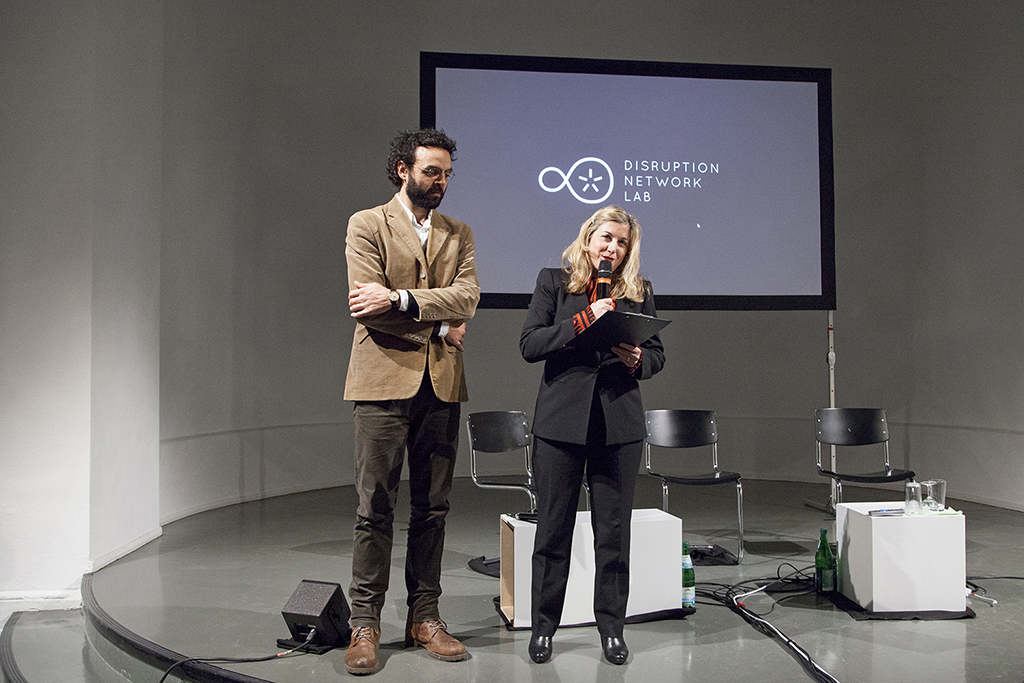
Photos by Maria Silvano for Disruption Network Lab.
More info about Disruption Network Lab:
disruptionlab.org – @disruptberlin
We are delighted to share with you our Spring season of art and blockchain essays, interviews and events, offering a wide spread of exploration and critique.
The blockchain is an evocative concept, but progress in ideas of cryptographic decentralisation didn’t stop in 2008. It’s helpful for artists to get a sense of the plasticity of new technical media. So first we are pleased to share with you Blockchain Geometries a guide by Rhea Myers to the proliferation of blockchain forms, ideas and their practical and imaginative implications.
In Moods of Identification Emily Rosamond writes her response to our second DAOWO workshop, Identity Trouble (on the blockchain). She reflects on both ongoing attempts to reliably verify identity, and continuing counter-efforts to evade such verifications.
Mat Dryhurst and Holly Herndon speak here with Marc Garrett in an interview republished from our book with Torque Editions Artists Re:Thinking the Blockchain (2017). Mat and Holly convey a sense of excitement about developments and opportunities for new forms of decentralised collaboration in music.
Finally you can book your place on future events at the DAOWO blockchain laboratory and debate series for reinventing the arts.[note] DAOWO is inspired by a paper written by artist, hacker and writer Rhea Myers called DAOWO – Decentralised Autonomous Organisation With Others.[/note] Download the DAOWO Resource #1 for key learnings, summaries of presentations, quotes, photographs, visualisations, stories and links to videos, audio recordings and much more from our first two events about developments in the arts and the trouble with Identity.
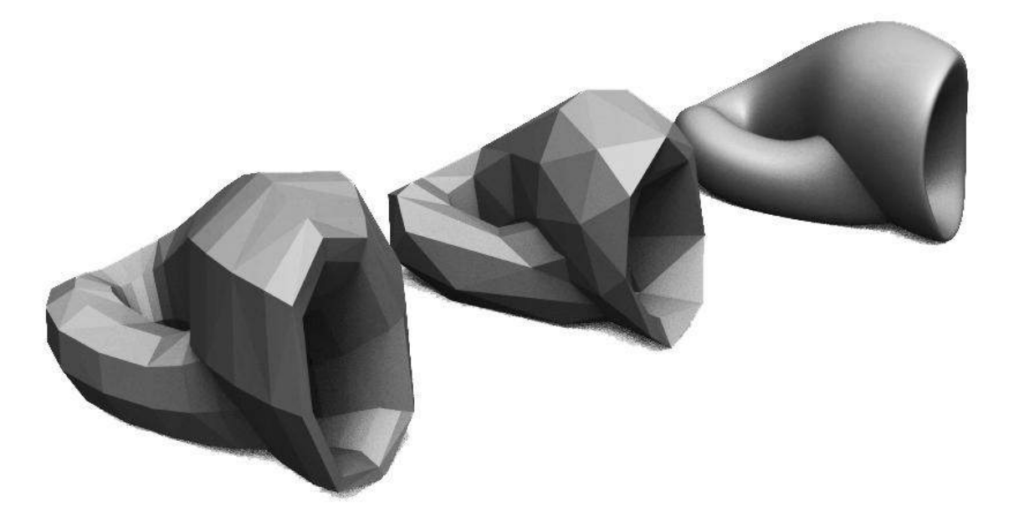
The blockchain is 10 years old and is surrounded with a hype hardly seen since the arrival of the Web. We’d like to see more variety in the imaginaries that underpin blockchains and the backgrounds of the people involved because technologies develop to reflect the values, outlooks and interests of those that build them.
Artists have worked with digital communication infrastructures for as long as they have been in existence, consciously crafting particular social relations with their platforms or artwares. They are also now widely at work in the creation of blockchain-native critical artworks like Clickmine by Sarah Friend[note]The 2017 Furtherfield and NEoN commission as part of the State Machines EU cooperation programme[/note] and Breath (BRH) by Max Dovey, Julian Oliver’s cryptocurrency climate-change artwork, Harvest (see featured image) and 2CE6… by Lars Holdhus[note]Featured as part of Øx, an exhibition of cryptographic artwork curated by Sam Hart as part of the Ethereal Summit, NYC. 2017[/note], to name but a few.
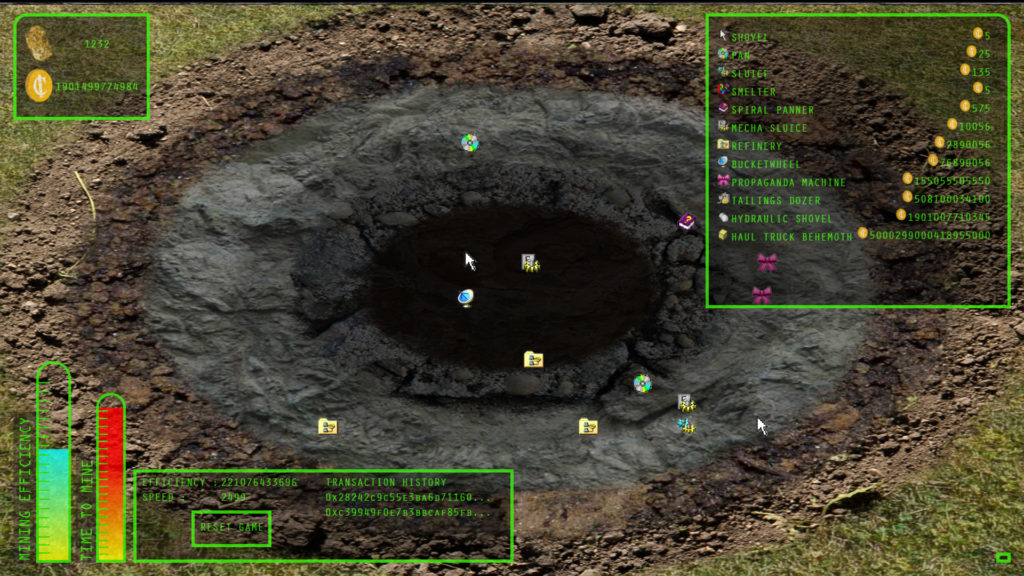
By making connections that need not be either utilitarian nor profitable, artists explore potential for diverse human interest and experience. Also, unlike on blockchains, where time moves inexorably forward (and only forward) – fixing the record of every transaction made by its users, into its time slot, in a steady pulse, one block at a time – human imaginative curiosity can scoot, meander and cycle through time, inventing and testing, intuiting and conjuring, possible scenarios and complex future worlds. They allow us to inhabit, in our imaginations, new paradigms without unleashing actual untested havoc upon our bodies and societies.
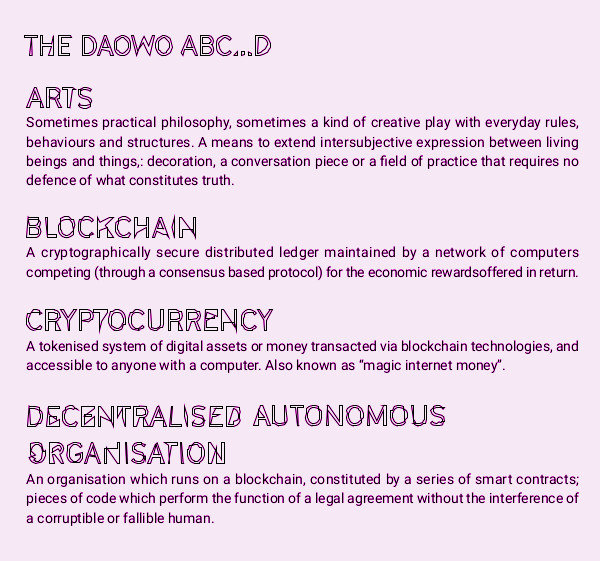
Back in 2008 the global banking system was bailed out by governments with tax payers’ money. Meanwhile a 15 year explosion of web-inspired, decentralised, mutualist-anarchist DIWO (Do It With Others)-style cultural actions and practices ebbed (though its roots remain and go deep). The global network of human attention and resources were, by this time, well and truly re-centralised. The “big five” now owned, and often determined, our communication and expression. Post-Internet artists rejected platform-building as a social artform and instead, took as their materials, lives mediated through social media and corporate owned platforms. Some dived into the marketing vortex, to revel and participate in the heightened commodification of art.
With the introduction of the blockchain protocol on the Internet we see a reversed direction of travel in the artworld, with major developments coming more quickly from the businesses of art, which reassert art’s primary status as an asset class, than from those artists experimenting with new forms of experience and expression enabled by its affordances. Now intermediaries of art world business are moving into blockchains (also sometimes called the “Internet of money”) with a focus on provenance, authentication, digital arts made scarce again with IP tracking, fractional ownership, securitisation and auction[note]See the Blockchain Art Stack Ready Reckoner, DAOWO Resource #1, page 19[/note]. It is blockchains for art, any art, as long as that art can be owned and commodified. This may be seen as a good thing, generating and distributing increased revenues to ‘starving artists’. Also perhaps inevitable, as that which cannot be owned is hard to represent on a blockchain ledger.
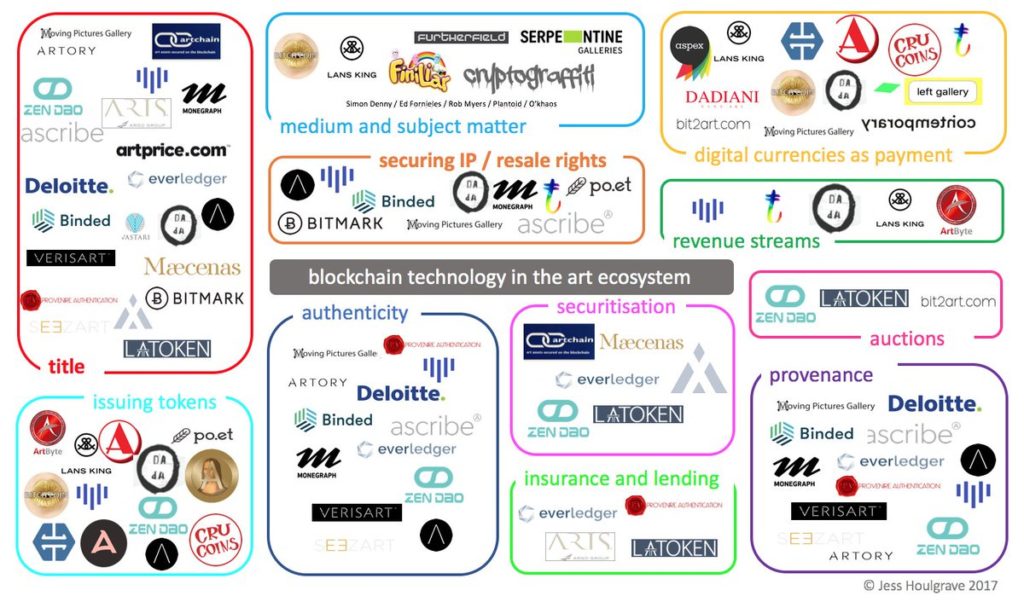
In his new book Reinventing democracy for the digital condition, (2018) Felix Stalder notes that people are increasingly actively (voluntarily and/or compulsorily) participating in the negotiation of social meaning through the “referentiality, communality, and algorithmicity, […] characteristic cultural forms of the digital condition”. In 2015 the Ethereum blockchain launched with a new layer that could run “smart contracts”, pieces of code which act as autonomous agents, performing the function of a legal agreement without the interference of a corruptible or fallible human[note]These technologies now underpin a range of post-currency developments, massive industrial and state investment for authentication of identity and matter, more efficient and secure financial transactions and distribution of digital assets; communications so secure as to facilitate voting; and as a coordinating technology for the billions of devices connected to the Internet.[/note]. These can be combined to perform as blockchain-based companies called Distributed Autonomous Organizations (DAOs) and there are a plethora of blockchain implementations and political agendas now developing. How these unfurl will affect our ability to relate to each other, to deliberate, decide and cooperate with each other as individuals, organisations and societies.
So for us the promise lies in platform-building: by-and-for communities of experimental artists (in the expanded sense of the word), participants and audiences who want to create not just saleable or tradeable art objects[note]For examples like Cryptopunks, Cryptokitties and Rare Pepes read Tokenization and its Discontents by Rhea Myers, Furtherfield 2017[/note] but artworks that critique the relationship between art and money, and expand the contexts in which art is made and valued.
‘AltCoins, cryptotokens, smart contracts and DAOs [Digital Autonomous Organisations] are tools that artists can use to explore new ways of social organisation and artistic production. The ideology and technology of the blockchain and the materials of art history (especially the history of conceptual art) can provide useful resources for mutual experiment and critique’ – Rhea Myers[note](Conceptual) Art, Cryptocurrency and Beyond by Rhea Myers, Furtherfield 2014[/note]
While FairCoin (being rolled out by FairCoop with the Catalan Integral Cooperative) puts new forms of decentralised social organisation into practice on the ground, blockchain based art projects such as Terra0 and Plantoid by O’khaos offer examples of governance systems and invite us to critically “imagine a world in which responsibility for many aspects of life (reproduction, decision-making, organisation, nurture, stewardship) are mechanised and automated.”[note]Both featured in the exhibition NEW WORLD ORDER, currently touring as part of the State Machines programme to Aksioma in Slovenia and Drugo More in Croatia[/note] Both artworks demonstrate functioning systems and help us to think through how we might determine and distribute artistic (and other) resources, their value, and the rules for their co-governance for the kinds of freedoms, commonalities and affiliations that are important for the arts.
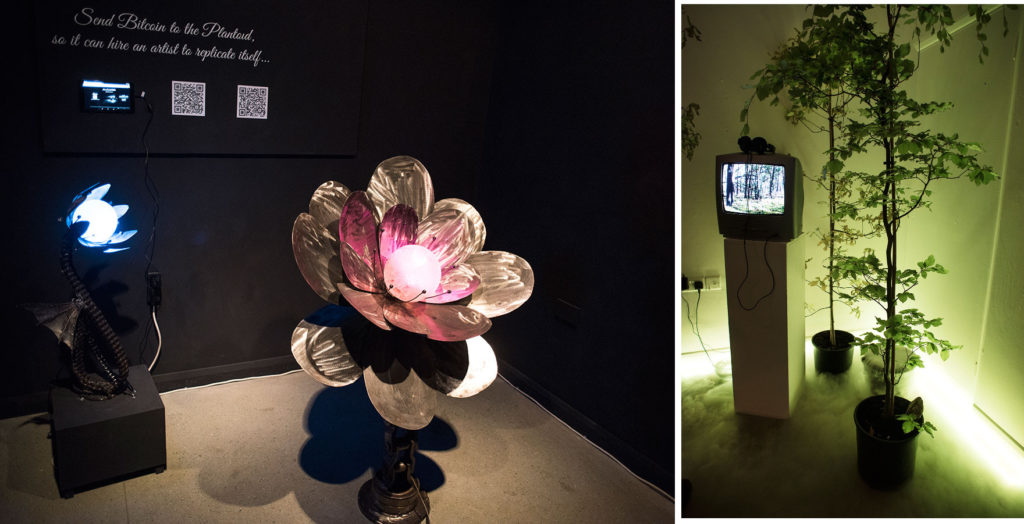
It may take a while. What to value and how to value it is a particularly tangled question. The technical infrastructure of the blockchain is at the stage of development that the Web was at in the early 90s (blockchain technologies are less forgiving, require deeper programming knowledge and are therefore more expensive to build than web pages or platforms) which, along with the get-rich-quick vibe of non-community-platform projects, might be why there are still so few community platforms actually in operation. Resonate.is the cooperatively owned music streaming service is an inspiration in this regard. It is a platform for musicians – creators and listeners – that opens up the governance of its resources to everyone who has ever created or listened to its music. It demonstrates one way in which a DIWO ethos might work.
Helen Kaplinsky is exploring how to bootstrap to the blockchain, Maurice Carlin’s Temporary Custodians project which realises an alternative system of peer2peer art ownership and stewardship at Islington Mill[note]See An Alternative to a Historical Mode of Art Ownership, Helen Kaplinsky in DAOWO Resource #1, page 6, Furtherfield, 2018[/note].
Three preoccupations dominate 2018 New Year blogs and commentary that mark the blockchain’s 10th anniversary: blockchains as cash cults; doubts about the actual utility of blockchains and; the environmental impact of Bitcoin (still, erroneously interchangeable with the blockchain in the minds of lots of people). We add to these our concern about the intensification of control enabled by these infrastructures, AND the simultaneous conviction (shaped by deep collaborations and hard criticisms over the last years) that blockchains have the potential to enable and stimulate new forms of social organisation, resource distribution and collaboration in the arts.
The first two preoccupations match exactly the commentary surrounding the early days of the Web and we know how that turned out. The remaining concerns are grist to the mill of our ongoing programme of publications, films, exhibitions and events. The technologies are only now stabilising to allow more grass-roots infrastructural developments.
We invite you to bring your own lens of constructive critique, gather a crowd to debate and explore how we might pull blockchains into art, on the arts’ own terms, and to gain an understanding of why it is worthwhile.
If you’re interested in Furtherfields critical art and blockchain programmes with various individuals, groups and partners since 2015. You could check out how it all started, watch our short film, read this book, visit this exhibition, or archives and documents of previous exhibitions[note]The Human Face of Cryptoeconomies[/note], [note]New World Order[/note], read reviews and debate, and join us at our ongoing DAOWO blockchain lab series, devised with Ben Vickers (Serpentine Galleries) in collaboration with the Goethe-Institut London, and the State Machines programme[note] Its title is inspired by a paper written by artist, hacker and writer Rhea Myers called DAOWO – Decentralised Autonomous Organisation With Others.[/note]
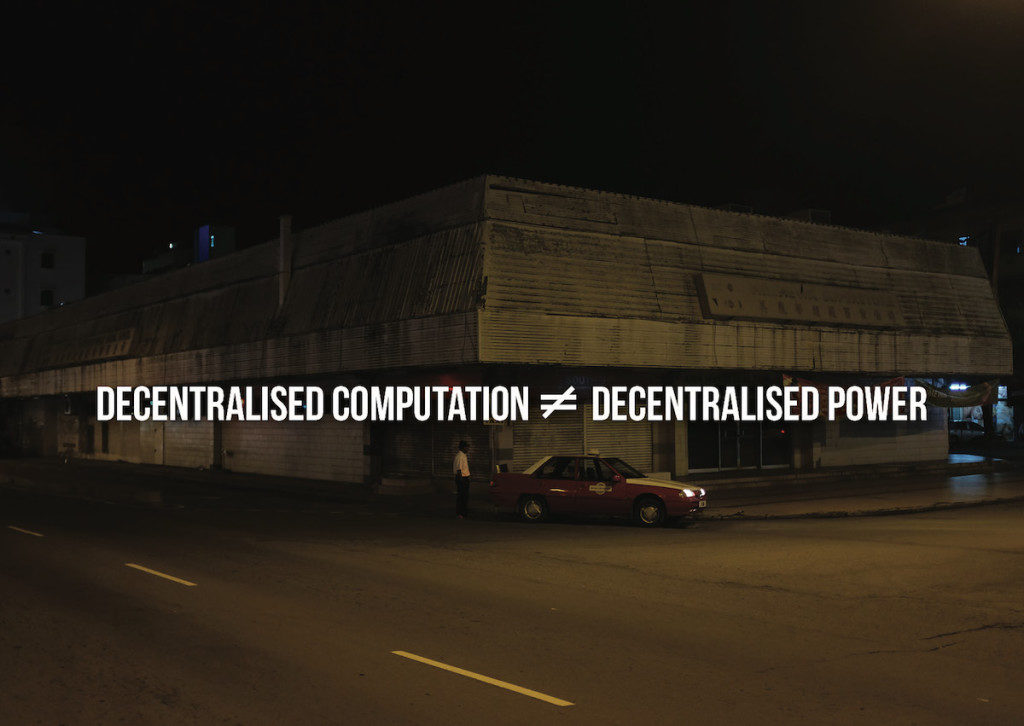
Data structures hold information in a way that makes it easier to be manipulated by software, given particular constraints on computing resources such as the time or space taken up. A linked list takes very little space in a computer’s memory on top of the space taken up by the data it contains and is very quick to add new data to but it is very slow to search from the beginning to the end of the list.
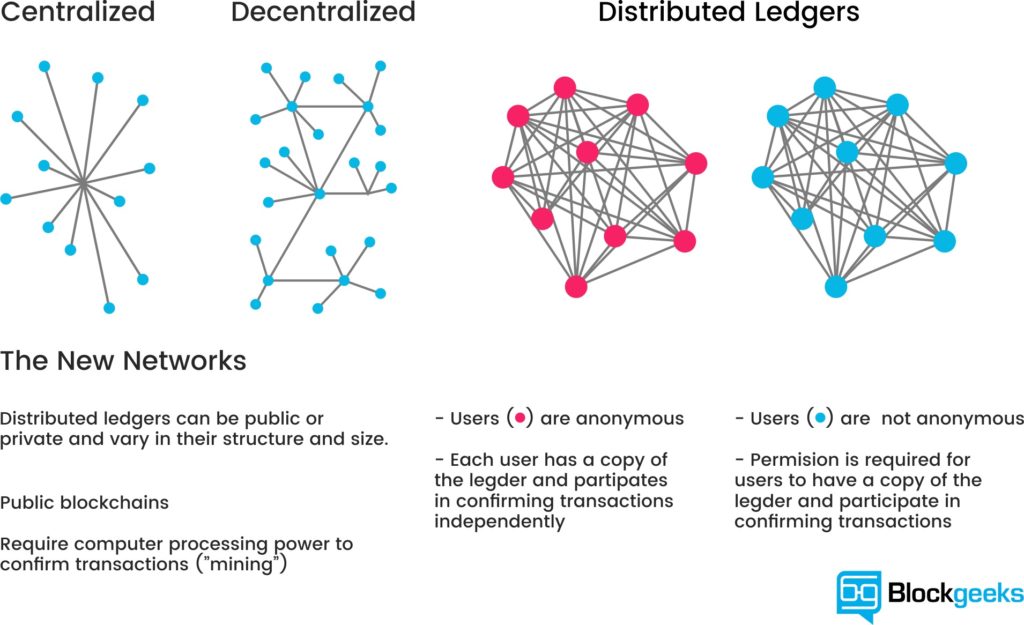
In contrast, a “hash table” data structure makes looking up information much faster by calculating a unique identifier “hash” for each item that can be used as an index entry for the data rather than having to search all the way through a long list of links. Think of a hash as a very large, very unique number that can be reliably calculated for any piece of data – any file containing the text “Hello world!” will have the same cryptographic hash as any other. The cost of this fast access is that the table must be allocated and configured in full before data can start to be stored in it.
A “binary tree” balances speed and storage space by storing data in a structure that looks like a tree with two branches at the end of each branch, creating a simple hierarchy that takes very little initial extra storage space but that given its structure is relatively fast to search compared to a linked list.
Each block in a blockchain is linked to the previous one by identifying it using its (cryptographic) hash value. And the transactions in the block are stored in a (cryptographic hash) tree. This means that a blockchain is a more complex structure than the simple image at the top of this page. But so what? Why should we care about the shape of the blockchain when its social, environmental and political impact seem to be in such urgent need of critique?
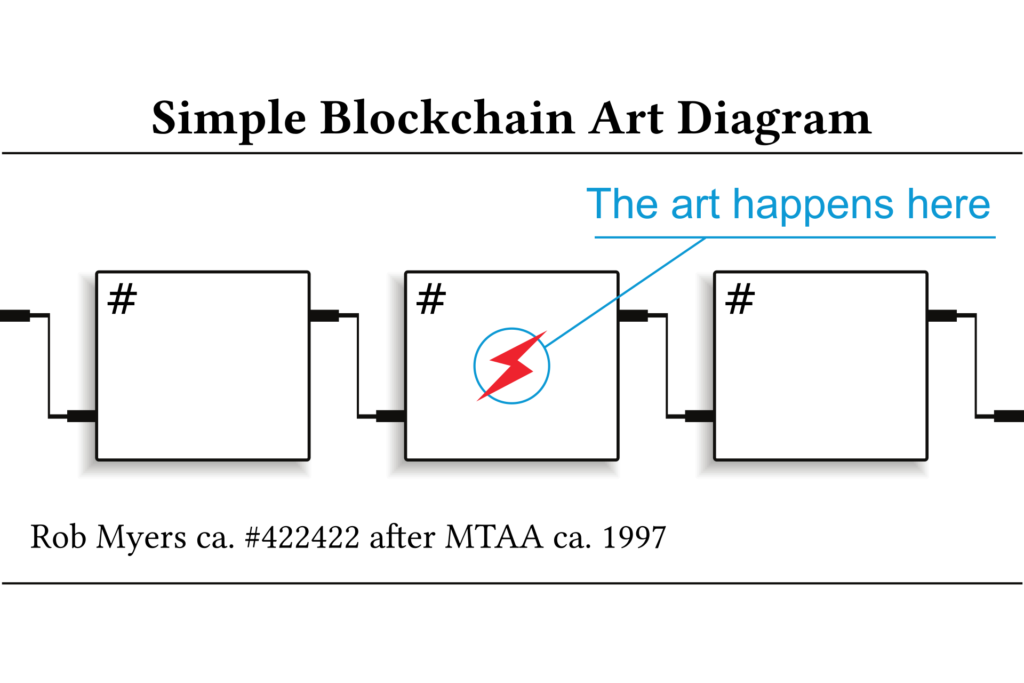
The geometric, techonomic and social form of a blockchain are all related, and understanding one helps us to reason better about the others. As the quick tour through software data structure design above indicates, the constraints on technological form are not abstract, they are tied to real needs and agendas. Bitcoin is no exception to this – the lists and trees that make up its blockchain as they are built and broadcast on a peer-to-peer network by computers competing to claim economic incentives for doing so were chosen very explicitly to exclude the intervention of the state and other “trusted third parties” (such as banks) in authentic economic relationships between peers.
Bitcoin’s algorithms prioritise the security of the blockchain above all else, maximising security like a mythical Artificial Intelligence “paperclipper” maximises the production of a particular material good regardless of the other consequences . This explains Bitcoin’s energy consumption, which whilst lower than the US military or the other equivalent systems that guarantee the security of the dollar is probably still much higher than Satoshi Nakamoto originally envisioned.
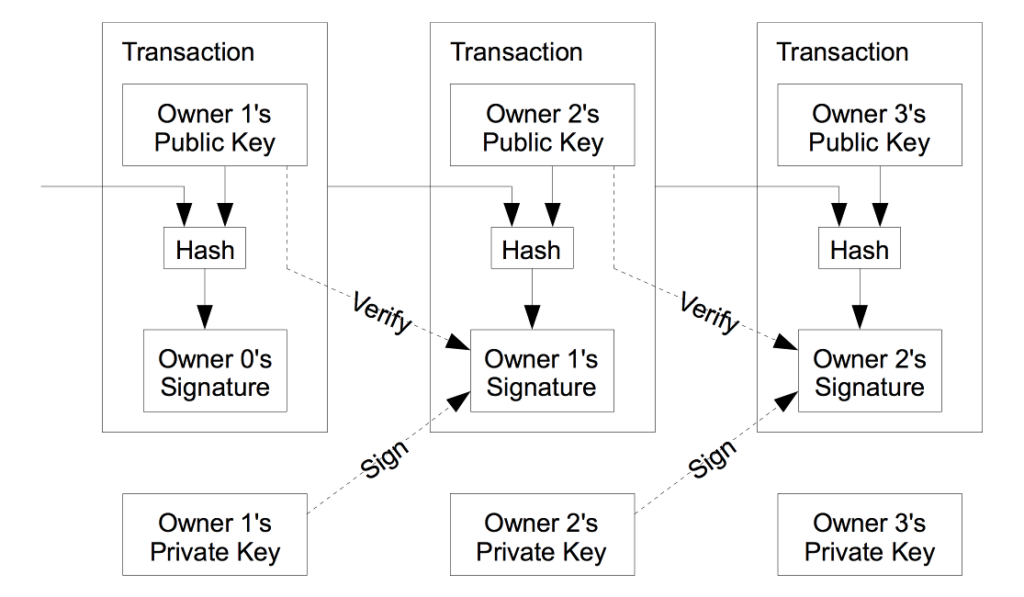
There are other algorithms, though, which have been created since 2008 to address perceived flaws in Bitcoin’s design or to address different ideological agendas. These create different forms, and contrast instructively with that of Bitcoin’s blockchain. Please note that these are experimental and often controversial technologies. Nothing that follows is investment advice.
Bitcoin creates blocks on average every ten minutes. Faster currencies quickly emerged, LiteCoin and Dogecoin are leading examples, with 2.5 minute and one minute block times respectively. Blocks may contain more or fewer transactions, and be more or less frequent even within the same blockchain as the algorithms tweak its parameters to ensure its security. Blockchains have rhythm, they stall or race, each block is larger or smaller and closer or further from the last one. Transactions fan into and out from addresses in each block, with varying values of currency or amounts of data each time. We are now very far from the block-and-arrow diagrams of linked lists indeed.
The Ethereum system, which extends Bitcoin’s financial ledger into a more general system for “smart contracts”, has the smallest block time of any leading cryptocurrency – fifteen seconds. Like the others mentioned it still uses a variant of the energy-hungry “Proof of Work” security system from Bitcoin. In Proof of Work, anyone who wants to add a block of transactions to the list must consume computing resources to solve a puzzle (essentially guessing a large number ending with multiple zeroes). As these resources cost money, anyone willing to expend them must stand to gain more from adding the next block than they lose to their electricity bill. This Game Theory gambit secures a Proof of Work blockchain. The mindlessly focussed, paperclipper nature of blockchain security algorithms means that as more people use more computers to compete to be the next person to add a block to the chain and claim the economic reward for doing so, the difficulty and therefore the amount of electricity required to solve that puzzle has increased massively, growing the energy footprint of cryptocurrency.
Ethereum is planning to switch to a “Proof of Stake” system, like that used in currencies like NXT and Decred (about which more below). Rather than burning electricity like Proof of Work, Proof of Stake uses a blockchain’s own existing currency “staked” by users to demonstrate their standing within the system and to thereby get a chance to be chosen by the network to add the next block. Proof of Stake and its related “Proof of Authority” system move from the “miners” of Proof of Work who operate on the blockchain from outside to a system of capitalist investors or even an aristocratic class of gatekeepers who operate within the logic of the blockchain itself. This folds the blockchain’s outside in on itself.
Bitcoin’s blocks have been fixed at one megabyte in size since a temporary security fix by Satoshi Nakamoto introduced the limit. As Bitcoin usage has grown, blocks have become increasingly full (allegedly often as a result of economic “spam” attacks intended to manipulate prices – competing for space in blocks drives up transaction fees which can in turn discourage users and ultimately drive down the price of Bitcoin). How should this problem be addressed – how should Bitcoin scale? Should the number of transactions stored in the blockchain grow, increasing the block size limit and making it harder for individuals to store the blockchain on consumer hardware in a decentralised manner? Or should transactions be somehow moved “off-chain” into “second-tier” systems that build on top of the blockchain, adding complexity and introducing potential new choke-points for existing capital to exploit? Big blocks or small blocks (like the big or little ends of eggs, or integers…)? This is a real debate in the Bitcoin world, and illustrates how the consequences of a simple change in technical form like, for example, increasing block sizes from one to two megabytes, can have profound effects on the social and economic form of a cryptocurrency. “Big blockers” propose solutions like the breakaway “Segwit2X” or “Bitcoin Cash” systems, scaling “on-chain” with ever greater amounts of data in the same structures. “Small blockers” propose solutions that move data out of the blockchain, into “Segregated Witnesses” that store cryptographic signatures outside of the blockchain, or the cybernetic rhizomes of “Lightning Networks”.
A Lightning Network adds a second peer-to-peer network of nodes that pass transactions between themselves. These are all valid Bitcoin transaction data structures, but unlike the main Bitcoin peer-to-peer network they are not immediately broadcast to the main Bitcoin network to be bundled up into blocks. Rather they can be replaced at any moment by new transactions, sending different amounts of cryptocurrency along a “channel” between one or (most often) more participants arranged in a random network like the one used by the Tor privacy network.
It’s an elegant but sometimes complex solution, and one that triggers moral panic within some elements of the Bitcoin community equivalent to that triggered by Bitcoin within some elements outside of it. Lightning Nodes with more Bitcoin can extract more fees from Lightning Network transactions, to be sure, and this is a form of centralisation. Decentralisation’s value to cryptocurrency is as a concrete guarantor of security, and Bitcoin’s value is its security. But individuals can still run Lightning Network nodes and send transactions between each other, and pools of capital already have centralising effects in exchanges and mining cartels.
Techniques similar to those used to move transactions off-chain by Lightning Networks can be used to move value between different blockchains without exchanges centralising the process. “Atomic Swaps”, the “Plasma” system and the realisation of the previously mythical “Doge-Ethereum bridge” using the TrueBit system are all different ways of building wormholes between the separate universes of individual blockchains.
Another approach to scaling is borrowed from conventional database design: breaking the blockchain into smaller and smaller pieces or “shards“, forming another tree structure, allows each group of users of the blockchain to only have to keep track of the part that contains the transactions they are interested in. The Ethereum blockchain will move to sharding in future, after its switch to Proof of Stake. Sharding destroys the metronomic, panopticonic unity of the blockchain to create islands of transactions whose truth is local to them, a non-monotonic logic that makes moving value and information between shards difficult but still not impossible.
CryptoKitties can go on their own shard, the Gnosis prediction market on another one, and if one needs to bet on something kitty-related this will require communicating cross-shard. From islands in the net to islands in the blockchain. Techonomically, the data structures and economic incentives of such a system are more complex than a unified blockchain, but making access to the network cheaper by requiring each user to store less data to send their transactions restores the blockchain’s initial low barrier of entry.
Deciding how to scale is a matter of governance. The Decred cryptocurrency has put governance front and centre. As well as moving to a hybrid Proof of Work / Proof of Stake system it has implemented an “on-chain-governance” system. Decred contains the forum for its own critique and transformation, implemented as an extension of the staking and voting system used by its Proof of Stake system. On-chain governance is controversial but addresses calls to improve the governance of cryptocurrency projects without falling prey to the off-chain voluntarism that can result from a failure to understand how the technomic and social forms of cryptocurrencies relate in finely-tuned balance.
Some post-Bitcoin systems move further away from the form of a chain or do without them altogether. The Holochain system gives each user their own personal blockchain and stores a link to it in a global “Distributed Hash Table” of entries (like that used by the BitTorrent system), a forest of trees rather than a tree of shards. This possibly solves the bandwidth problem of simple blockchain technology but weakens some of their strengths in a trade off of convenience against long-term security and robustness. Iota (the most controversial technical design discussed here) doesn’t have a blockchain at all. It uses a “tangle” of transactions, within which each new transaction must do the Proof of Work of validating several previous transactions. This seems like an ideal restoration of the original vision of Bitcoin as a peer-to-peer currency, solving the problems centralisation and energy usage, but the current Iota network is in fact heavily centralised by its reliance on nodes controlled by the Iota foundation to secure it.
IPFS is not a cryptocurrency and does not use a blockchain but it complements the blockchain technologically and often socially. IPFS is related to blockchain technology in its use of cryptography and the logic of game theory but also as a popular way of storing information that is too large to fit on the blockchain. And in its use of a cryptocurrency token – “Filecoin” – to pay for storage on its main network. Filecoin was released in an “Initial Coin Offering” in 2017, and that is all we will say about ICOs here… IPFS uses a “Merkle DAG”, a network of links similar to the World Wide Web or a filesystem, but with each item (the pages or files) represented not by a human-given name but by the cryptographic hash of its content. “Merkle” refers not to the German Chancellor but to the computer scientist who described this use of cryptographic hashes in a tree data structure (like that used in Bitcoin). “DAG” is an acronym for “Directed Acyclic Graph” – a network with no loops in it because loops would confuse the algorithm. IPFS distributes content using a “market” algorithm, bartering for blocks of data on the network with Filecoin or with other blocks.
Each of these pocket universes of social and economic reality has its own structure and forms, its own space and geometry. Chains, and being on or off of them. Blocks of different sizes and fullness, with varying distances between them. Channels, rhizomes, shards, tangles, mines and thrones. Forests, tables, graphs, markets and identities. These formal differences distinguish different cryptocurrencies technologically and politically. Algorithmic differences are ideological differences, this is not an external critique it is internal to the logic of cryptocurrency – algorithms are changed to better instantiate what is just. These algorithmic differences produce formal differences. Their surplus value and unintended consequences continue this process of critique-in-code.
The question of the shape of the blockchain opens up onto a space of technomic, geometric and social forms. We can move through the hyperspace containing and relating these forms to the specific spaces of individual blockchains that are built around them, through the constraints and agendas that they reflect, out into wider society. The gaps and overlaps in this space indicate useful problems for the work of development or critique. Given this, geometries and forms are at least as useful a navigational marker as professed intentions or revealed preferences. But only if we can imagine and visualise them.
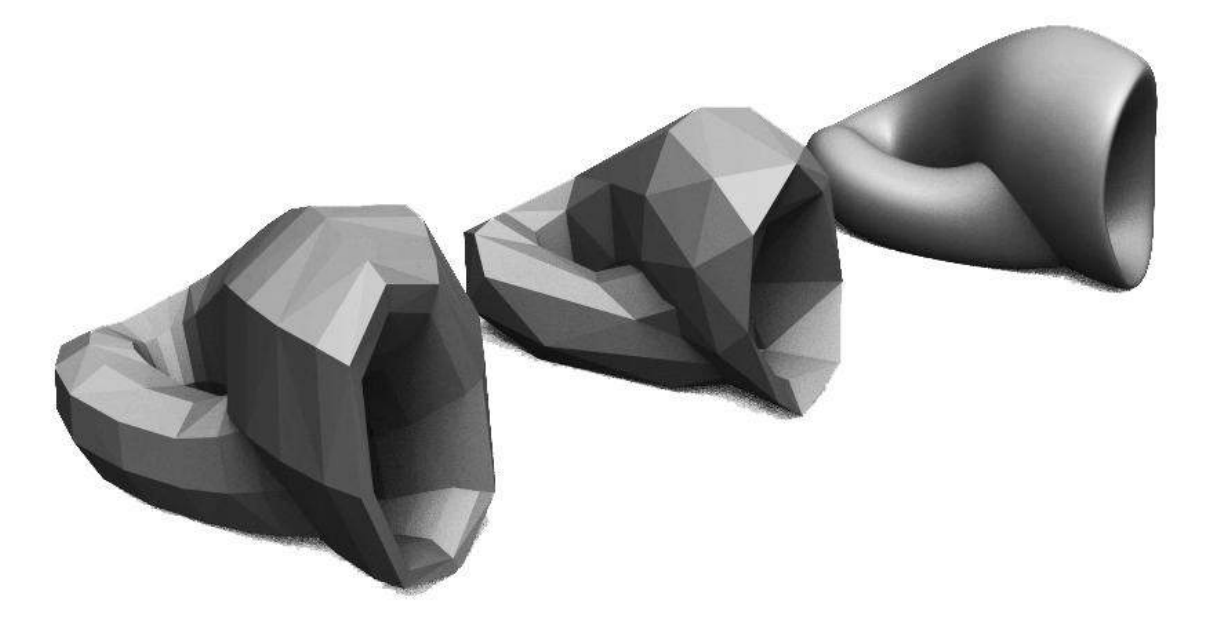
Art deals in form, from the spatial volumes of Renaissance perspective to the choreography and logistics of Relational and Contemporary art. Whether promoting, like Jessica Angel’s public art envisioning of the Doge-Ethereum bridge as a Klein Bottle, critiquing or simply rendering perceptible the very different kinds of form that make up the geometric, technomic and social forms of the blockchain and the relationships between them, art has the unique potential to uncover the true shape of the blockchain.
Image notes:
Simple Blockchain Art Diagram, by Rhea Myers. 2016
What the Silk Road bitcoin seizure transaction network looks like, Reddit
This essay is a response to Identity Trouble (on the blockchain), the second in the DAOWO lab series for blockchain and the arts. Rosamond reflects on both ongoing attempts to reliably verify identity, and continuing counter-efforts to evade such verifications.
Online transactions take place in a strange space: one that blurs the distinctions between the immediate and the remote, the intimate and the abstract. Credit card numbers, passing from fingers to keyboards to Amazon payment pages, manage complex relations between personal identity and financial capital that have been shifting for centuries. Flirtations on online dating platforms – loosely tied to embodied selves with a pic or two and a profile – constitute zones of indistinction between the intimate spheres of the super-personal, and hyper-distributed transnational circuits of surveillance-capital. Twitter-bot invectives mix with human tweets, swapping styles – while all the while bot-sniffing Twitter bots try to distinguish the “real” from the “fake” voices[1]. Questions of verification – Who is speaking? Who transacts? – proliferate in such spaces, take on a new shape and a shifted urgency.
How does personal identity interface with the complex and ever-changing technical infrastructures of verification? How is it possible to capture the texture of “identity trouble” in online contexts today? The second in the DAOWO event series, “Identity Trouble (on the blockchain),” addressed these questions, bringing together a range of artists, developers and theorists to address the problems and potentials of identification, using technical apparatuses ranging from blockchain, to online metrics, to ID cards and legal name changes. The day included reflections on both ongoing attempts to reliably verify identity, and continuing counter-efforts to evade such verifications.
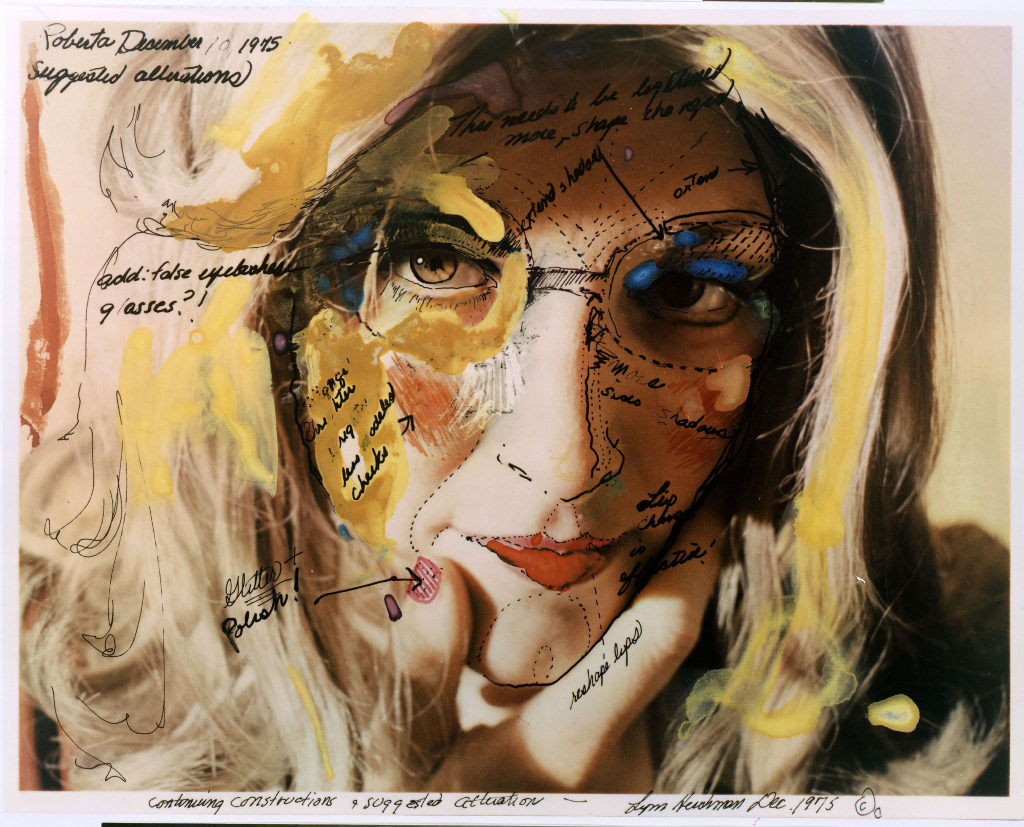
Before going into the day in any detail (and at the risk of going over some already well-trodden ground), I want to try to piece together something which might – however partially – address the deeper histories of the problems we discussed. Of course, identity was an elusive concept long before the internet; and the philosophical search to understand it has run parallel to a slow evolution in the technical and semiotic procedures involved in its verification. In fact, seen from one angle, the period from the late nineteenth century to present can be understood as one in which an increasing drive to identify subjects (using photo ID cards, fingerprints, signatures, credit scores, passwords, and, now, algorithmic/psychometric analysis based on remote analysis of IP address activity) has been coupled with a deep questioning of the very concept of identity itself.
On the one hand, as John Tagg describes, in the second half of the nineteenth century, the restructuring of the nation-state and its disciplinary institutions (“police, prisons, asylums, hospitals, departments of public health, schools and even the modern factory system itself”[2]), depended on creating new procedures for identifying people. This involved, among other things, yoking photography to the evidentiary needs of the state – for instance, through Alphonse Bertillon’s anthropometric identity card system, invented in 1879 and adopted by French police in the 1880s. The identity cards, filed by police, included suspects’ photographs and measurements, and helped them spot repeat offenders.
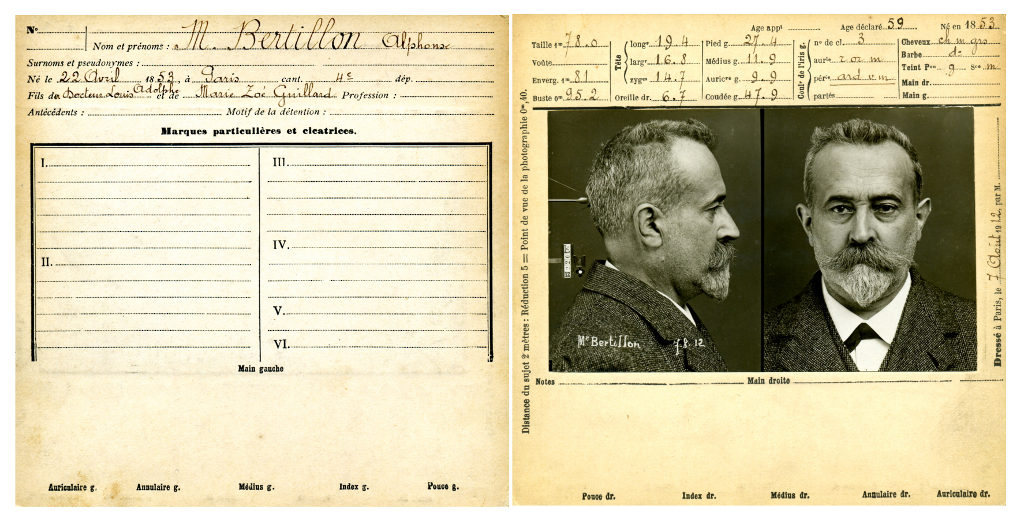
This impulse to identify, it seems, has only expanded in recent times, given the proliferation of biometric and psychometric techniques designed to pin down persons. On the biometric end of this spectrum, retinal scans, biometric residence permits and gait recognition technologies manage people’s varying levels of freedom of movement, based on relatively immutable bodily identifiers (the retina; the photographic likeness; the fingerprint; the minute particularities of the gait). On the psychometric end of the spectrum, private companies calculate highly speculative characteristics in their customers by analysing their habits – such as “pain points.” The American casino chain Harrah’s, for instance, pioneered in analysing data from loyalty cards in real time, to calculate the hypothetical amount of losses a particular gambler would need to incur in order to leave the casino. The pain point – a hypothetical amount of losses calculated by the company, which may be unknown to the customer herself – then provided the basis for Harrah’s’ real-time micro-management of customer emotion, enabling them to send “luck ambassadors” out onto the floor in real time to boost the spirits of those who had a bad day [3].
On the one hand, then, identification apparatuses have become ever more pervasively intertwined with the practices of daily life in industrialized societies since the latter half of the nineteenth century; this produced new forms of inclusion and exclusion of “exceptional” subjects within various institutional regimes. On the other hand, just as the technical and semiotic procedures associated with verifying identity were proliferating and becoming ever harder to evade, modern and postmodern thinkers were deeply questioning what, exactly, could possibly be identified by such procedures – and why identity had become such a prominent limiting condition in disciplinary societies. James Joyce’s character Stephen Dedalus marvels at the lack of cellular consistency in the body over a lifetime. While an identifying trait, such as a mole on the right breast, persists, the cells of which it is made regenerate repeatedly. (“Five months. Molecules all change. I am other I now.” [4]) How, then, can debts and deeds persist, if the identificatory traits to which they are indexed are intangibly inscribed in an ever-changing substrate of cellular material?
In the mid-twentieth century, Foucault and Barthes deeply questioned the limitations identity imposed on reading and interpretation. Why, for instance, need authorship play such a prominent role in limiting the possible interpretations of a text? “What difference does it make who is speaking?” [5]
In ’nineties identity discourse, theories of difference became particularly pronounced. Cultural theorists such as Stuart Hall radically questioned essentialist notions of cultural identity, while nonetheless acknowledging the political and discursive efficacy of how identities come to be narrated and understood. Hall and others advocated for a critical understanding of identity that emphasized “not ‘who we are’ or ‘where we came from’, so much as what we might become, how we have been represented and how that bears on how we might represent ourselves. Identities are… constituted within, not outside representation.” [6]
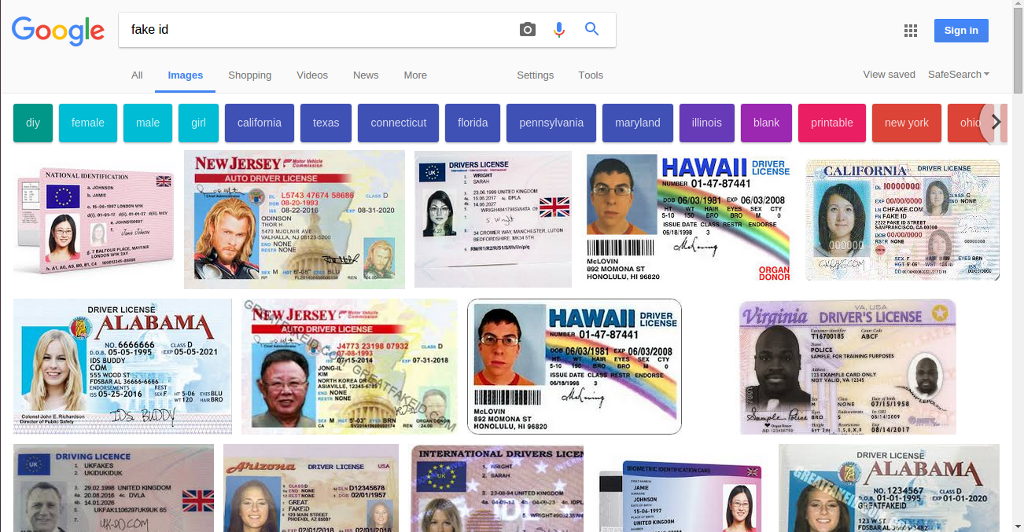
On the one hand – so I have said – myriad technical apparatuses have aimed to ever more reliably capture and verify identity. On the other hand, myriad critical texts have questioned identity’s essentialist underpinnings. But today, these lines have become blurred. The anti-identitarian mood permeates technical landscapes, too – not just theoretical ones. Fake IDs, identity theft, and other obfuscations have grown ever more complex alongside apparatuses for identification; indeed, such fakeries have both emerged in response to, and driven yet further developments in technologies for identity verification as is the case in a Fully-Verified system. The frontiers of identification are ever-changing; each attempt to improve technologies for verifying identity, it seems, eventually provokes the invention of new techniques for evading those verifications.
At the inherently uncertain point of contact between person and online platform, new forms of anti-identifications are practiced – invented or adapted from previous stories. In one bizarre example from 2008, a Craigslist advert posted in Monroe, Washington requested 15-20 men for a bit of well-paid maintenance work. The men were to turn up at 11:15 am in front of the Bank of America, wearing dark blue shirts, a yellow vest, safety goggles and surgical masks. As it turned out, there was no work to be had; instead, the men had been summoned to acts as decoys for a robbery – a squid-ink trail of similarity to help the thief escape. The idea, though inventive, wasn’t entirely original; it was described by police as a possible copycat of the plot in the film The Thomas Crown Affair (1999) [7.
Today, the anti-identitarian mood has spread far beyond small-scale manoeuvers like this. Multiple large-scale data breaches – such as the recent Equifax breach, which compromised the data of over 145 million customers [8] – have put a cloud over the veracity of millions of people’s online identities. The anti-identitarian mood becomes broad, pervasive, and generalized in data-rich, security-compromised environments. It becomes a kind of weather – a storm of mistrust that gathers and subsides on the level of infrastructures and populations.
Such are some of the complexities that the DAOWO speakers had to contend with. At the Goethe Institute, we thought through some of the ways in which identities are being newly constituted within representation – ways that might, indeed, answer to the technical and philosophical problems associated with identification. Backend developer Thor Karlsson led us through his company Authenteq’s quest to provide more reliable online identity verification. Citing the ease with which online credit card transactions can be hacked, and with which fake accounts proliferate, Karlsson described Authenteq’s improved ID verification process – a digital biometric passport, using blockchain as its technical basis. Users upload a selfie, which is then analysed to ensure that it is a live image – not a photograph of a photograph, for instance. They also upload their passport. Authenteq record their verification, and return proof of identity to users, on the BigChainDB blockchain.
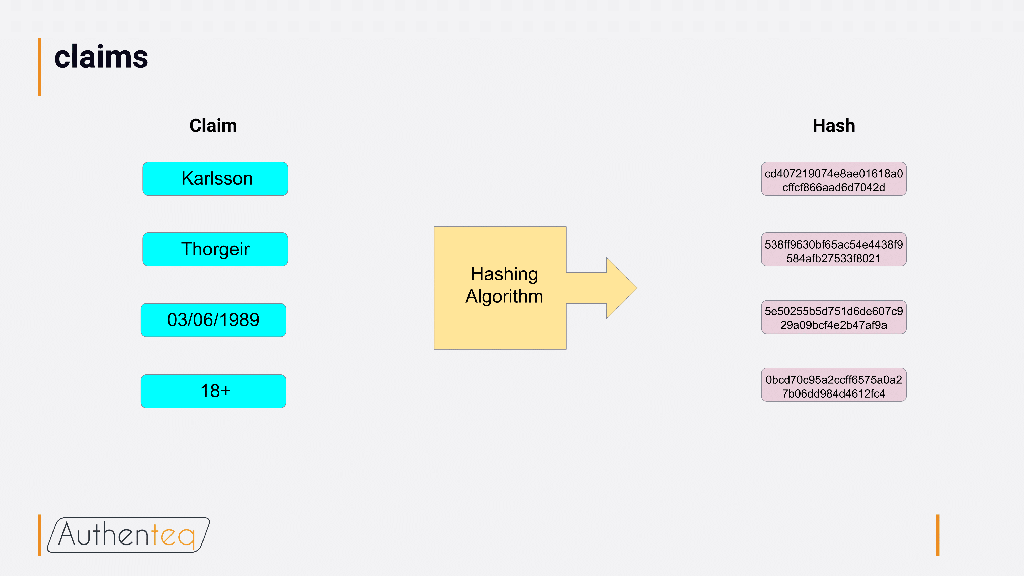
A hashing algorithm ensures that users can be reliably identified, without a company having to store any personal information about them. Authenteq aims to support both identity claim verifications and KYC (Know Your Customer) implementations, allowing sites to get the information they need about their users (for instance, that they are over 18 for adults-only sites) without collecting or storing any other information about them. Given how much the spate of recent large-scale data breaches has brought the storage of personal data into question, Authenteq’s use of blockchain to circumvent the need to store personal data promises a more secure route to verification without revealing too much of personal identity.
Nonetheless, while Karlsson and Authenteq were optimistic that they can make meaningful improvements in online identification processes, other provocations focused on the potential problems associated with such attempts at identification – on the protological level, on the level of valuation, and on the level of behaviour-as-protocol. Ramon Amaro delivered an insightful critique of blockchain and the problem of protological control. There is no such thing as raw data – inputs are always inflected by social processes. Further, the blockchain protocol relies heavily on consensus (with more focus on consensus than on what, exactly, is being agreed upon) – which reflects a need to protect assets (including identity) and oust enemies that is, ultimately, a capitalist one. Given this, how can identity manoeuver within the blockchain protocol, without always already being part of a system that is based on producing inclusions and exclusions – drawing lines between those who can and cannot participate?
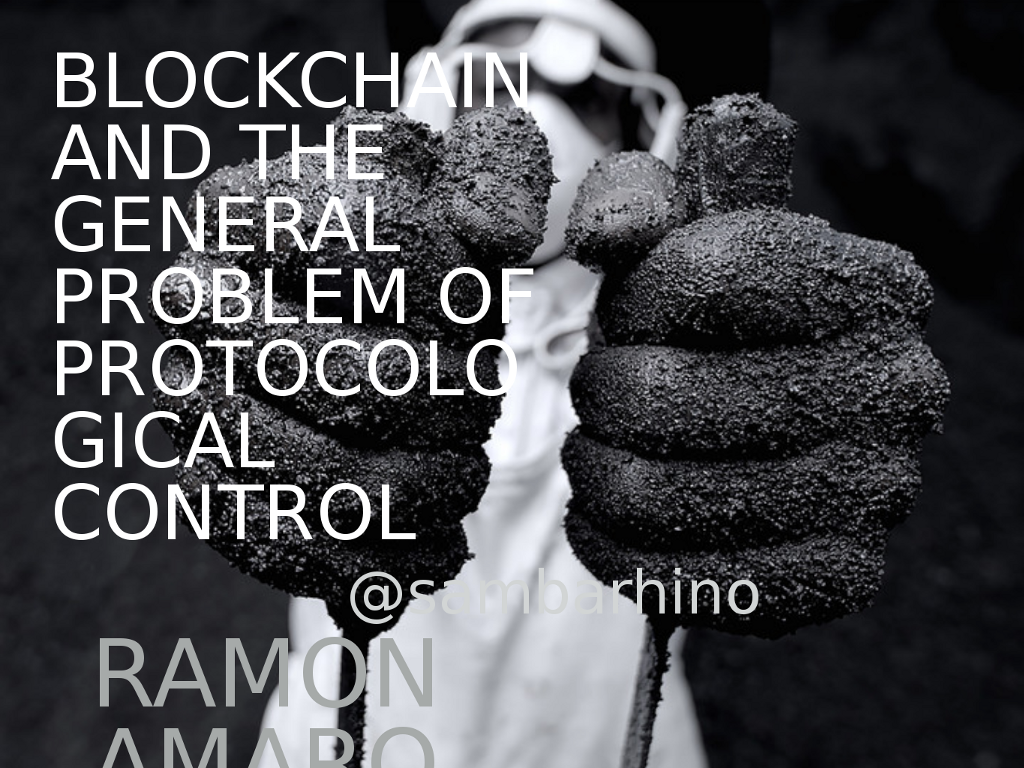
My own contribution focused on systemic uncertainty in the spheres of personal valuation, looking at online reputation. In a world in which online rankings and ratings pervade, it seems that there is a positivist drive to quantify online users’ reputations. Yet such apparent certainty can have unexpected effects, producing overall systemic volatility. At the forefront of what I call “reputation warfare,” strategists such as Steve Bannon invent new ways to see systemic reputational volatility as a source of value itself, producing options for the politicians they represent to capitalize on the reputational violence produced on sites like 4chan and 8chan.
While these contributions reflected on some of the critical problems associated with pinning down identity’s value, some of the artists’ contributions for the day focused on the ludic aspects of identity play. Ed Fornieles’ contribution focused on the importance of role play as a practice of assuming alternate identities. In his work, this involves thinking of identity as systemic, not individual – and considering how it might be hacked. In many of Fornieles’ works, this involves focusing attention on the relation between identity and the platforms on which they are played out. Behaviour becomes a kind of protocol; role play becomes a reflection on strands of behaviour as protocol.

We ended the day with a screening and discussion of My Name is Janez Janša (2012), a film by three artists who, in 2007, collectively changed their names to Janez Janša, to match that of the current president of Slovenia. The film, an extended meditation on the erosion of the proper name as an identifier, catalogued many instances of ambiguity in proper names – from the unintended (an area of Venice in which huge numbers of families share the same last name) to the intentional (Vaginal Davis on the power of changing names). It also charted reactions to the three artists’ act of changing their name to Janez Janša. What seemed to confound people was not so much that their names had been changed, but rather that the intention of the act remained unclear. In the midst of today’s moods of identification, there are high stakes – and many clear motives – for either obscuring or attempting to pinpoint identity. Given this, the lack of clear motive for identity play seems significant; by not signifying, it holds open a space to rethink the limits of today’s moods of identification.
The DAOWO programme is devised by Ruth Catlow and Ben Vickers in collaboration with the Goethe-Institut London, and the State Machines programme. Its title is inspired by a paper written by artist, hacker and writer Rhea Myers called DAOWO – Decentralised Autonomous Organisation With Others
Disobedient Electronics: Protest is a limited edition publishing project that highlights confrontational work from industrial designers, electronic artists, hackers and makers from 10 countries that disobey conventions. Topics include the wage gap between women and men, the objectification of women’s bodies, gender stereotypes, wearable electronics as a form of protest, robotic forms of protest, counter-government-surveillance and privacy tools, and devices designed to improve an understanding of climate change.
I was one of the lucky few to receive a hard copy of this fine little zine, a handmade limited edition of 300, put together by Canadian artist & researcher Garnet Hertz. It features 24 contributions of critical art & design, many of which taking a strong stand on feminism and surveillance /privacy issues, indispensable in current debate. Hertz initiated this publication in response to post-truth politics, in itself a notion shrugged off by populist drivel – “Politicians have always lied.” – Ptp- strategies involve the removal of scientific context from popular claims in order to comfort the masses in turbulent times of change. Such trends are noticeable in culture and thus in the DIY- movement too. After a disappointing visit at a maker’s fair, which essentially promoted the aesthetic design of blinking LEDs and the 3D-printing of decorative junk in an overall atmosphere of relentless marketing, the manifesto of Disobedient Electronics caught my attention, reflecting my impressions accordingly.
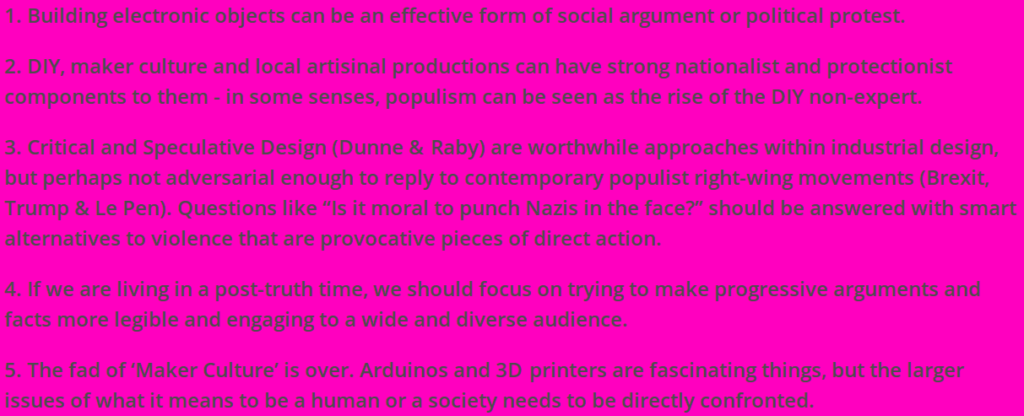
Decline of culture becomes visible as ‘popular’ themes such as sustainability or integration policies are readily adopted but actually serve as mere buzzwords to increase the marketability of events and products. Since it became profitable to sell electronic boards and a variety of accessory components, the prosumer (Ratto, 2012) is bound to available materials and building instructions and not encouraged to experiment or imagine alternatives to already available commercial design. Therefore many important layers of technology get ignored or regarded as not worth exploring due to the fetishisation of the final result. Although focus should be on action oriented making, tactile objects /installations are important when linguistics fail. We have already incorporated digital structures in every social aspect of our lives and it is difficult to observe let alone express them.
The book treasures the craft of DIY technology development, notably in the surveillance /privacy sector, and highlights the pressing need for knowledge in light of the technological advantage of those in power. Backlash provides us with an educational protest kit, including devices for off grid communication and bugging defence. These are functional but not necessarily designed for situations of conflict, rather for inciting a relevant debate among the general public. Phantom Kitty (work in progress) defies spying by authorities without a warrant and the enforced quantification of humans based on evaluations of online activity. It produces arbitrary noise when the user goes offline to obfuscate browsing habits and it is possible to integrate machine learning algorithms at a later stage, which could mimic or create identity patterns. Phantom Kitty features a stunning mechanical rack for keyboard and mouse operation, fed by a program executing search queries and the access of webpages. The project draws on the eeriness of neither knowing to what extent gathered data is exploited, nor against which parameters and targets it is set.
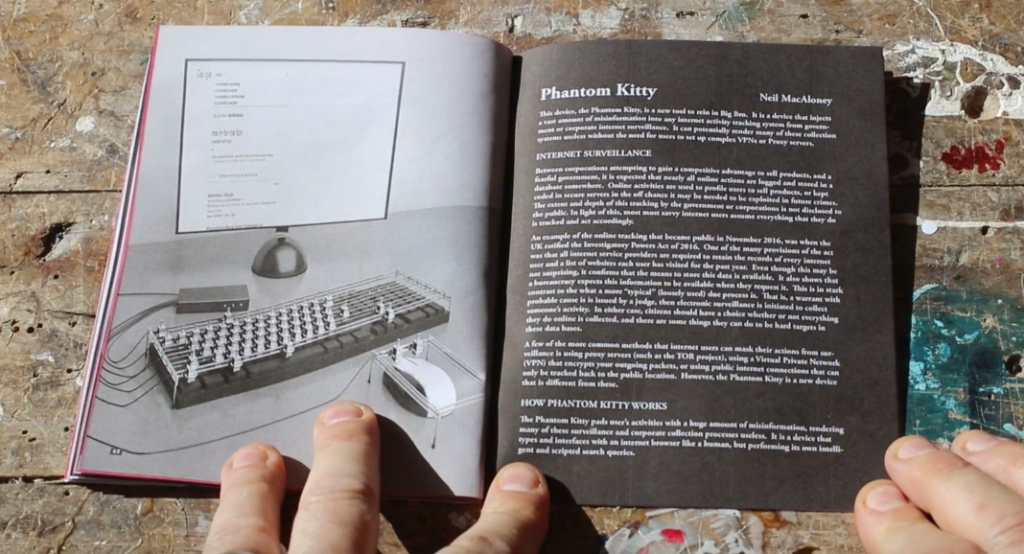
Completely left in the dark about the full scope of exercised control and entailing consequences The transparency grenade by Julian Oliver reminds us that citizens have a right to openness too. The promise of “making the process of leaking information from closed meetings as easy as pulling a pin” is tempting, and in contrast to the opaqueness of corporate and governmental policies, the artwork, other than claiming transparency, is representing it, in its aesthetics, open source software and in the thorough documentation of its engineering process.
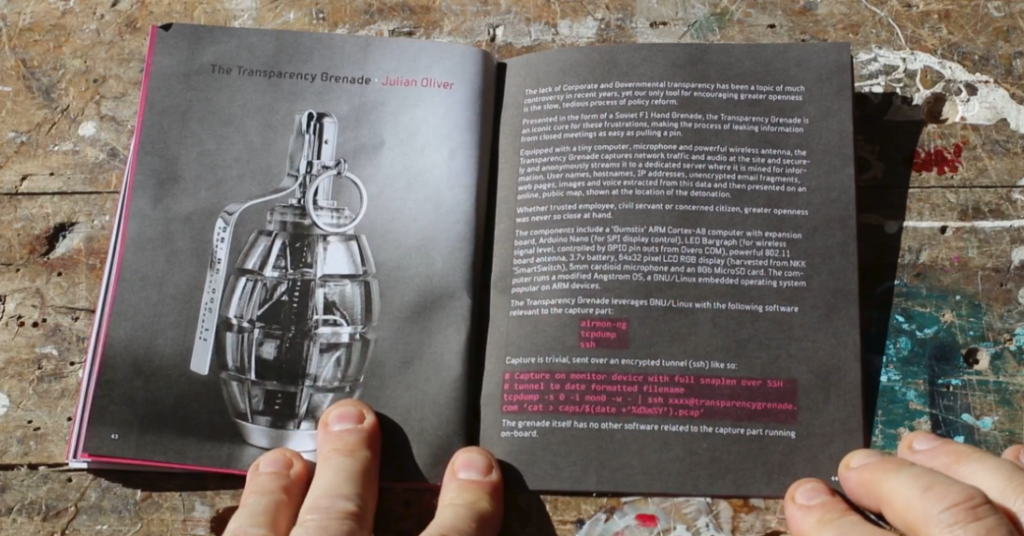
The well written accompanying text of one of my favourite projects PROBOTS describes effective works as “technologies of dissent that work at both the practical level but also the symbolic”, by all means valid for those involved making this book, albeit associating with a manifold of disciplines. The tele-operated protest robot certainly meet those demands and can be sent out by the precarious worker as an answer to the efficiency of contemporary policing, simultaneously a metaphor for the limited potential in the act of present-day corporeal protest. The silencing of political resistance happens far beyond the streets and PROBOTS makes an extraordinary research tool for investigating the organisational power of technology, which prevents social progress already from the outset.
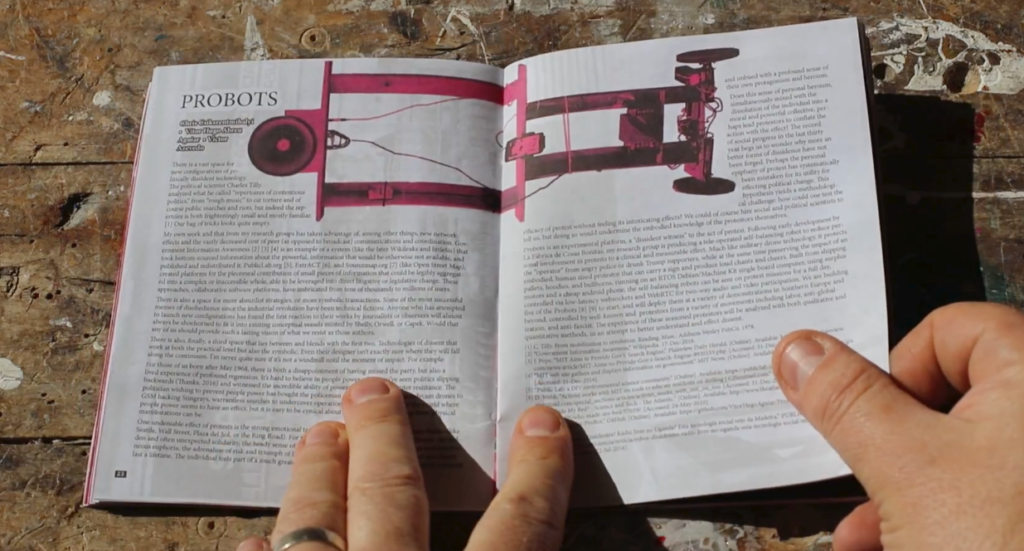
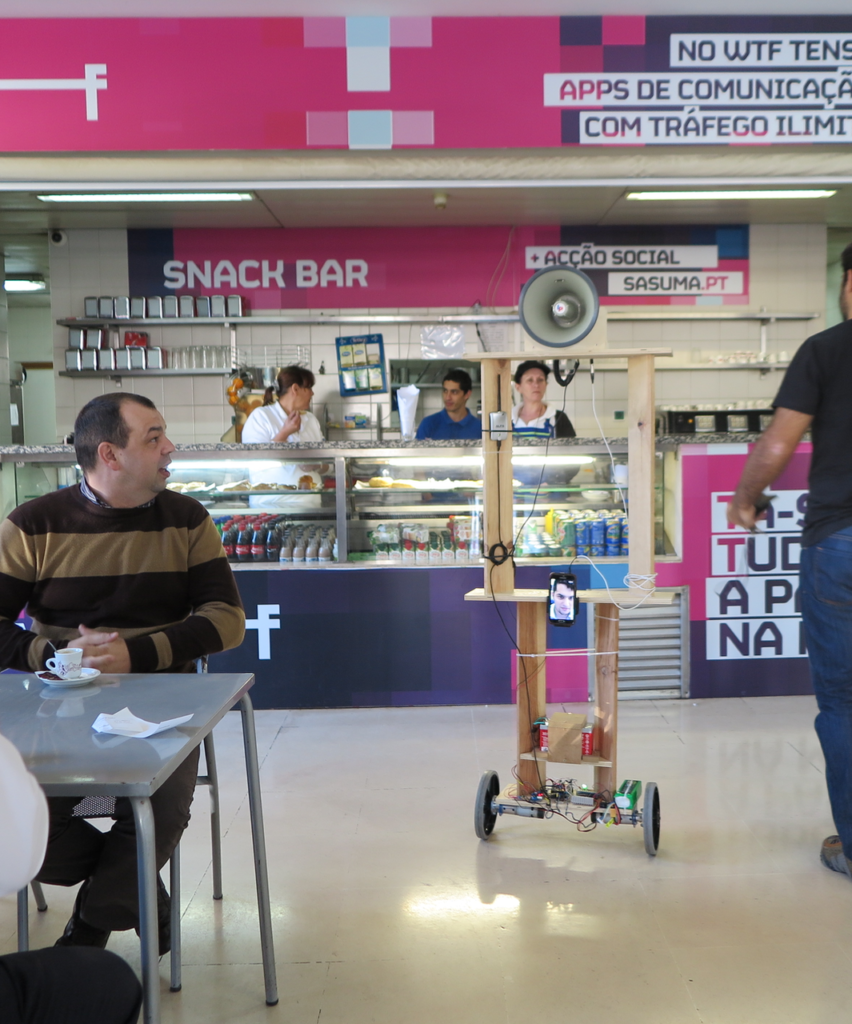
I’ve only recently discovered that e-textiles is not the same as smart clothing. It is a discipline, focusing on the act of making rather than the actual result, albeit in this case impressive too. The makers of The Knitted Radio approached the craft of knitting and electronics without economic reasoning, a factor which primarily informs the engineering process in industrial design. The liberation from conventional standards brought about alternative forms and methods, that is a sweater that also functions as a FM radio transmitter and the skill to knit electronic components /devices such as resistors, capacitors and coil with conductive yarn, an off-the-shelf material. The knitting instructions for the sweater are available online, it can provide a free of cost, independent communications infrastructure. The concept was inspired by the protests on Taksim Square, Istanbul, Turkey, and associated violations of freedom of speech. A Piece of the Pie Chart: Feminist Robotics by Annina Rüst illuminates gender inequity in form of a production line, which decorates edible pies with pie charts, depicting gender ratios in tech affiliated corporate or public organisations.
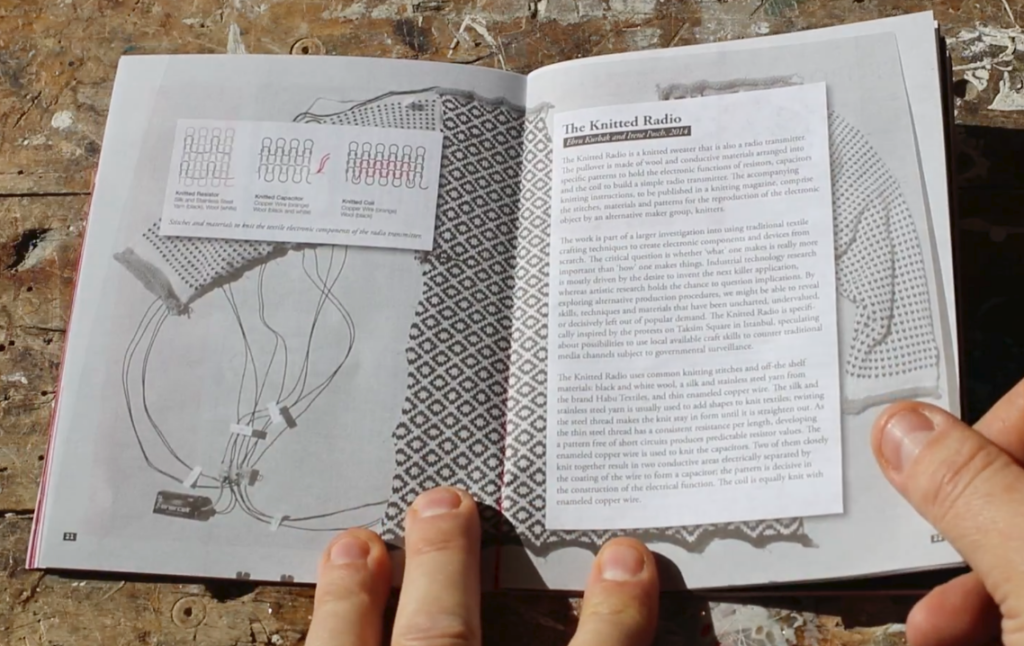
Women are generally underrepresented in tech related workplaces and users of the gallery installation can browse and choose between various data sets on gender in technology, e.g. computer science graduation rates, before an ensemble of household applications and semi-pro robotics sorts the cake. The mere visualisation of data was not radical enough, so the finished pie can be shipped to the institution of which data (and gender inequity) originates, and where it can be consumed accordingly. Women have to be content with the smaller piece of the cake, also symbolic for economic inequality and the missed out experience of working in tech. Rüst was not satisfied with the claim that women are just not interested in tech, and further qualitative research in feminist technology showed that women are rather put off by its hostile macho culture and that technological pedagogy simply failed to inspire girls.
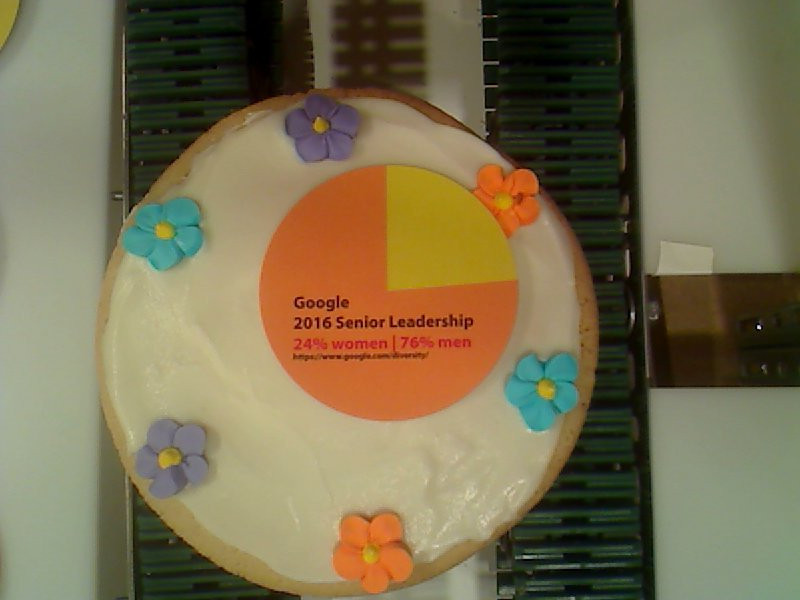
Tweeted image of a finished pie. Source: https://twitter.com/PieChartRobot
The PROTEST issue lives up to its title and emphasizes on projects, which propose hands-on political action and intervention with society, not in terms of providing solutions but to spark much needed discussion and inspire disruptive technology. Disobedient Electronics follows the publishing project Critical Making, which comprised 11 issues, so there is hopefully some more to come.
“2C E6 85 DC 0B A7 9F 2C 71 CD 47 52 E2 77 CC D2 96 DB 9B 67 51 F4 34 FD 20 A4 0C 86 5A 02 65 B7 D7 68 B6 FB E5 79 31 03 B6 48 76 26 63 1F 19 DC E0 2C C5 CD 74 A4 80 36 A5 56 83 EF 59 2A E8 31” (2017) by Lars Holdhus, hereafter referred to as 2CE6, was exhibited at the Øx exhibition of cryptographic art operating in the tradition of 1960s Conceptualism curated by Sam Hart as part of the 2017 Ethereal Summit in New York (one of my smart contract pieces appeared in the same show).
2CE6 is a framed, partially obscured print of hexadecimal digits representing a cryptographic private key. The key is one of 5000 created by Holdhus to authenticate individual artworks over the course of his future artistic career. Exposing it in this way depicts the anxieties of both the artworld and cryptoculture and allows the viewer to reflect on their interaction. To explain why will require us to situate both the artwork and its materials within the history of art and encryption.
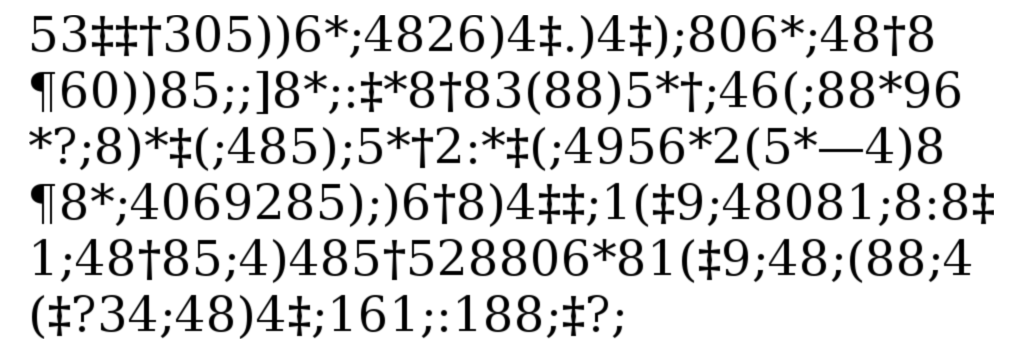
The re-emergence of cryptography as a popular pursuit in the Nineteenth Century starts with a link between code and art. Cryptography and deciphering were popularized by the American author Edgar Allen Poe, who later created the cryptographic literary form of the detective story. In Poe’s early story “The Gold Bug”, an encrypted message leads to hidden pirate treasure. It is the story of an investigation, but before and without the framework of the investigating detective that would find its fullest expression in the figure of Sherlock Holmes (see Franco Moretti’s “Graphs, Maps, Trees”, Verso, 2005, for how this framework fell into place). The detective story came to be a form of deciphering of human secrets and their traces, as Mediaeval cryptography had stood in relation to deciphering the mysteries of God’s creation at a time when the occult, science and cryptography had yet to differentiate themselves. Poe is a similarly liminal figure to mediaeval cryptographers such as Johannes Trithemius in his combining of cryptography, investigation, and spiritualism in literature and in practice. Poe held codebreaking competitions in newspapers and challenged readers to send them unbreakable codes. His writings on cryptography were required reading in the American intelligence community up to the early Twentieth Century. Further reflecting the Mediaeval relationship between cryptography and the occult (encryption and occultation), Poe was a popular subject for spirit mediumship after his death and for some time his most popular work was posthumous.

Contemporary cryptography starts not with the codebreaking conflicts of the Second World War (which for the most part just automated earlier systems) but with the discovery of Public Key Cryptography (PKC) at first secretly in the UK and then publicly in the USA in the 1970s. PKC allows messages to be encrypted using a separate key that cannot be used to decrypt it, which can therefore be made public. The secret key that is used to decrypt text that has been encryped by the public key is usually a large number (nowadays consisting of hundreds to thousands of bits) related to it by a “trapdoor function” that uses currently impossible-to-reverse mathematical operations like multiplying enormous prime numbers or multiplying points on complex curves. You are probably using PKC to read this website over the HITS protocol, it’s everywhere in contemporary communication and trade. Like the association of cryptography with the occult, this link between cryptography and trade goes back to the Renaissance.
The relationship between mathematics and cryptography stretches back even further, to earlier Arab herpetologists. This relationship was formalized by Claude Shannon in 1949, and operationalized by PKC. In previous eras, art had a similar relationship with mathematics as part of its self-image, for example in its geometries and colour theories, but Contemporary Art has a mathematics taboo. There is no reason why this should continue to be the case – public key cryptography can provide form, subject and content for art.
The points, lines and planes found in private and public keys and in the operations of encryption and decryption relate to mathematics and geometry in art. The mathematics of ratio and projection were common to Renaissance trade and to perspective. PKC has become contemporary trade math, although it has not yet led to an equivalent of perspective in art. While mathematics is a conceptual resource that strangely elicits disdain or hostility in the digital financialized era of contemporary art, Sol LeWitt showed that it can be used in a critical way. The textual and visual representations of these mathematical objects – long strings of hexadecimal or Base58 digits, QR codes and ASCII art – have both their own innate and contingent aesthetics.
These aesthetics can evoke the worlds of communication, commerce and espionage as they are determined in contemporary life by cryptography and its absences (backdoors, sidechannel attacks, quantum computing, etc.). Or the qualities and experiences of secrets, value, identity and trust (or, again, its absence) that they relate to. These are more concrete subjects than the instrumentalized Platonic realm of cryptographic mathematics, but they flow from them.
Taking a position on these or allowing the artwork’s participant to do so, presenting them for critical reflection or using them as indexes of broader social phenomena makes them content. Those phenomena include the economy, whether conventional finance or cryptocurrency, politics, whether secrecy or hacks of state actors and cypherpunk provocateurs, and the questions of identity, authenticity and permission that PKC and cryptographic hashing are applied to in networked media and culture.
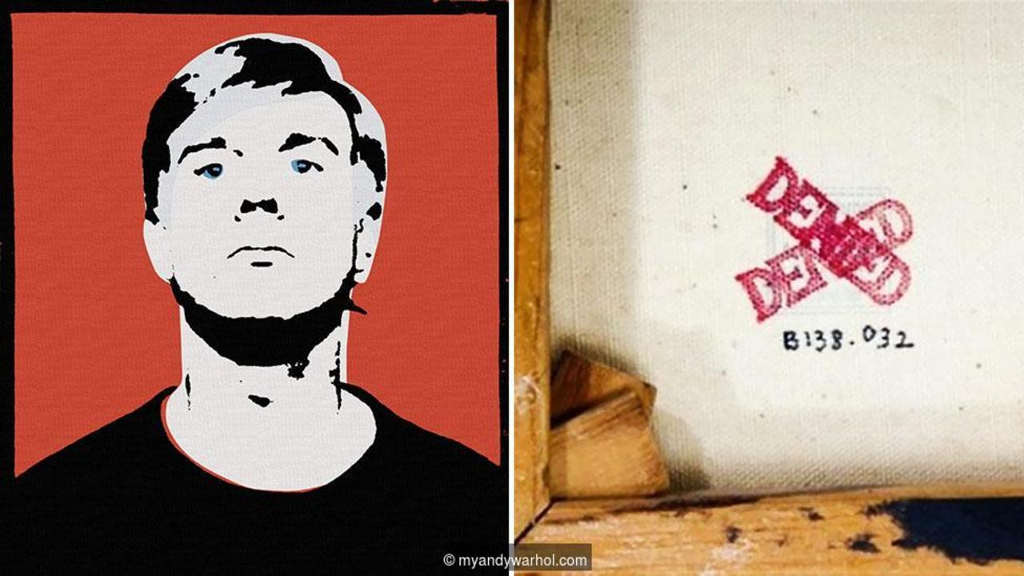
The presence of cryptography or its imagery in a piece of art need not function as any of these – apart from anything else an artwork can always fail. It may end up as a mess or as kitsh. These are modes of usually unintentional and visible inauthenticity, in contrast to the intentional but hidden inauthenticity of fakes. The fake is a problem for the art market and for the artistic and scholarly reputations that provide its capital. Catalogues raisonnes are meant to tackle the problem of the fake but the risks of authenticity and value that they carry make them a site of market and scholarly anxiety. When assembled late in an artist’s career or after their death by a foundation, a work being included or excluded by mistake carries the risk of lawsuits and monetary damages. This can have a chilling effect on both scholarship and on markets.
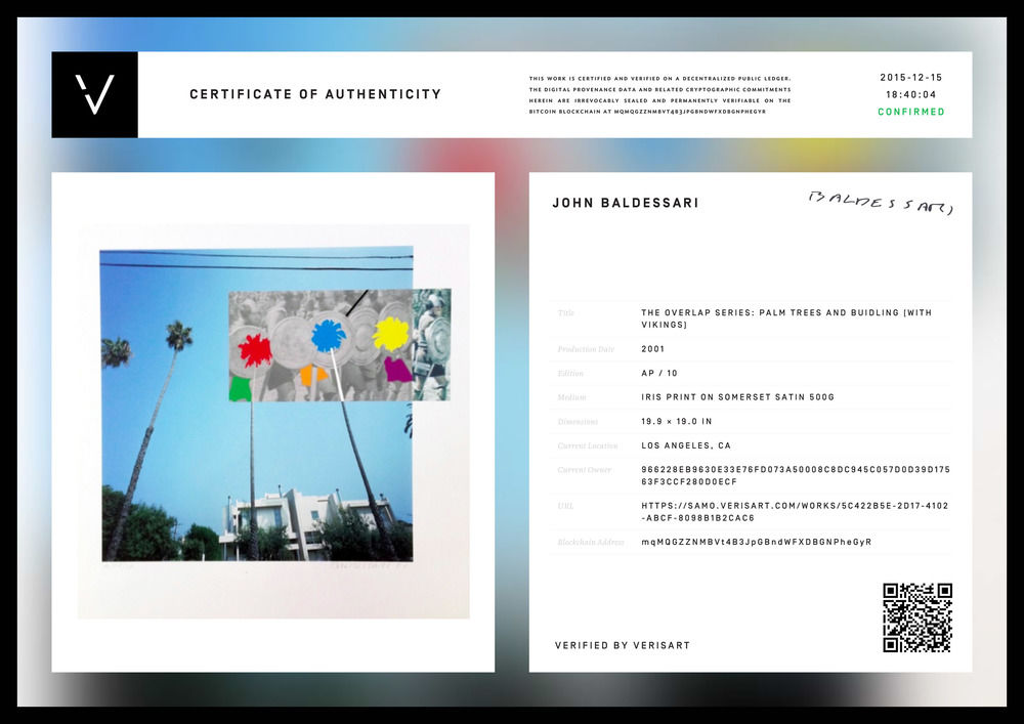
In theory, public key cryptography can help artists with this by being used to create a mathematically unforgeable “signature” code for each new artwork using the private key, which can be checked but not modified with the public key. This can take the form of a digital file, a radio frequency tag, or a QR code or print-out of the signature sealed from sight and attached to a physical work. As long as an assistant, gallerist or spouse doesn’t take a copy of the artist’s current private key and start making fakes, this is a secure way of constructing a catalogue of work that the artist has issued in their name. One of the stronger non-monetary uses of blockchains is to publicly record and timestamp such signatures. In particular this makes it impossible to claim that posthumously released works were released by the artist during their lifetime. This illustrates a way that the fake and its problems of identity authenticity and value relates to the double-spending problem that cryptocurrency solves.
Lars Holdhus is using non-blockchain PKC to authenticate and to limit the number of works they can produce. In 2CE6 the operational security of this strategy is deliberately broken. The first rule of PKC is never to give out your private key. Doing so allows anyone to read your messages (or steal your Bitcoins). The presentation of this act of exposure puts an anxious and fetishized strategy of authenticity and career/legacy construction at risk. It de-occults the information that would guarantee its authenticity (and thereby its value) in order to become or unfold as an artwork, constructing its cultural and economic value by an apparent act of destroying it and critiquing its materials in the process. Looking for a precedent for this leads to net.art and to Conceptualism (see “Conceptual Art, Cryptocurrency and Beyond“) but also to feminist art. The relationship between secrecy, artistic identity, authenticity and transparency has a precedent in the art of the Guerilla Girls. Their proposal to open a Gallery’s finances as the content of their show there likewise involves exposure of an occulted producer/resource of value and identity.
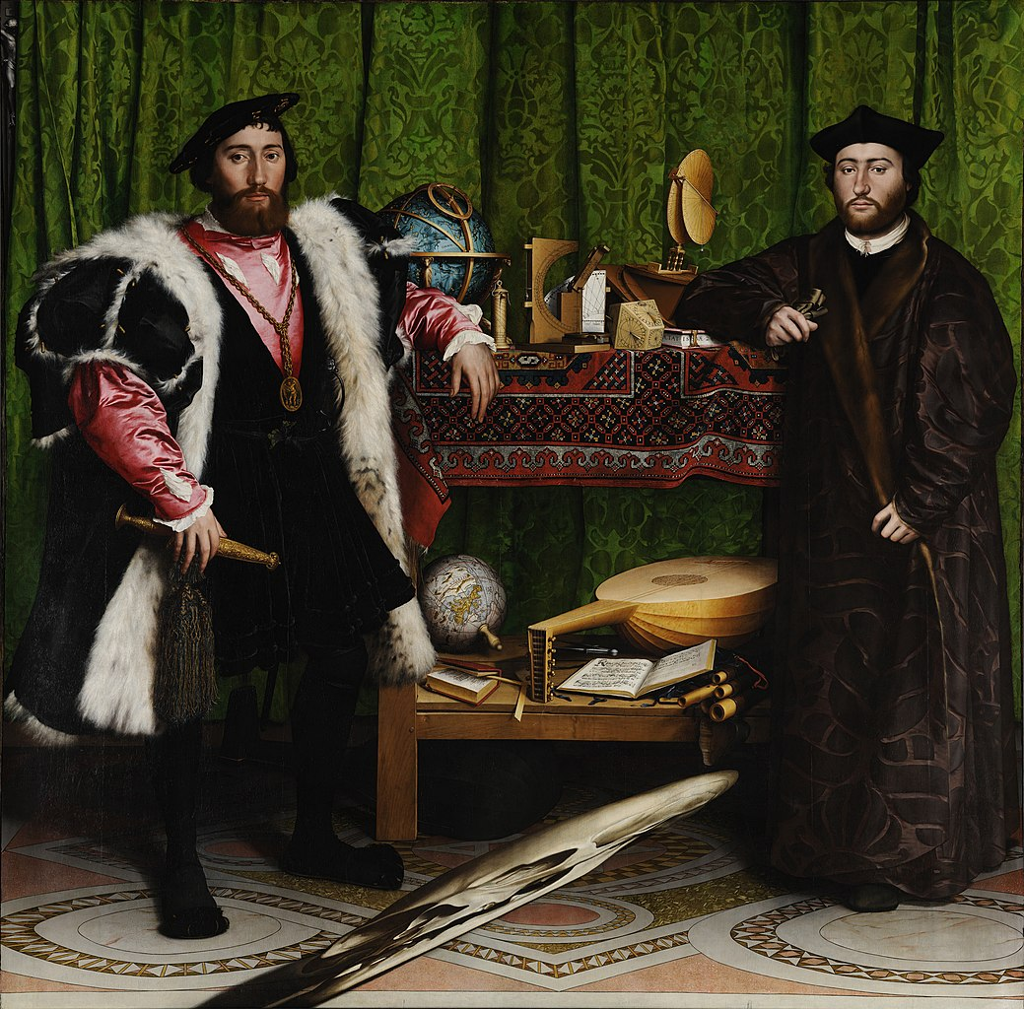
In 2CE6, Holdhus restores the historical link between the contents of art and of cryptography. The contemporary occult of the opacity of the art market, the security of value in trade, and their mathematics exist together cryptographically and artistically in it in a mutually problematizing, and therefore realistic, way. Cryptography functions here as artistic form, subject and content. When a public key is exposed, it is the end of its usefulness, it is dead. 2CE6 functions as a cryptographic memento mori, a post-Crypto Wars version of Holbein’s painting “The Ambassadors“.